A complete travel guide to Split, Croatia
Split, Croatia is the largest town in Dalmatia and the second-largest in Croatia. Split is a coastal city, with a small-town vibe, noisy streets, and easy-going locals.
Once a stopover place for tourists catching a ferry to nearby islands, or a bus to other more exciting tourist destinations, Split is today among the most popular places to visit in Croatia.
Located in the middle of the Dalmatia, Split makes a great base for your tour of Croatia. It is also an important transport hub and a port city.
In this Split Travel Guide, you’ll learn where Split is, the best time to visit Split, and the reasons to visit. We also share the best things to see and do in Split, places to stay, eat, and drink as well as provide all necessary travel information to help you plan your stay in Split, Croatia.
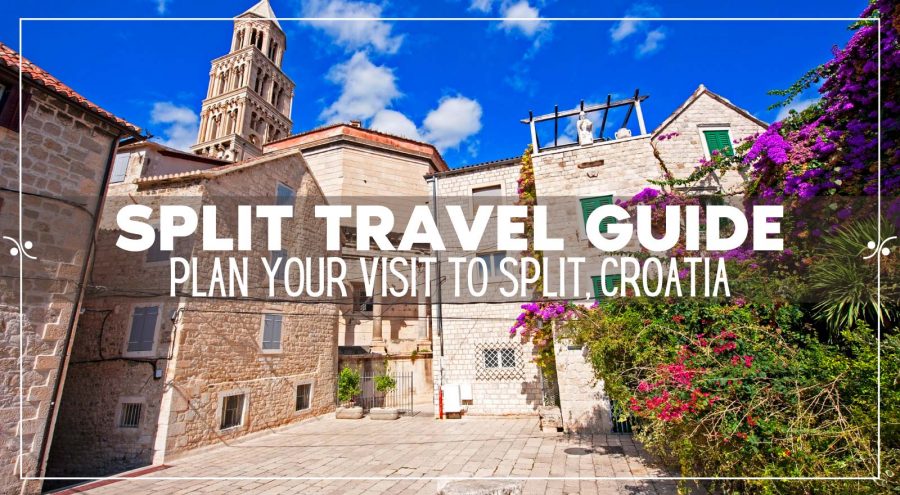
Split is a wonderful town to visit from June to October. Its old town offers a variety of attractions, including lively cafes, a scenic seafront promenade called Riva, charming restaurants serving delicious dishes, beautiful beaches, historic boutique hotels, and cozy wine bars that attract many visitors each year.
The town also has beautiful beaches and accommodation options for all budgets and styles, from historic boutique hotels to hip hostels and vacation rentals.
You can find some late-night bars and nightclubs in various areas of the town. With convenient public transport and car rental options, getting around Split is easy, and we explain it all below.
Let us help you plan your visit to Split, Croatia with this comprehensive Split Travel Guide.
Table of Contents

Where is Split, Croatia?
Split is situated in central Dalmatia, a region in southern Croatia, along the Adriatic Sea coast.
It is located on a small peninsula which is bounded by Marjan Hill on the western side, while Mounts Kozjak and Mosor rise to the north and northwest of the city.
The old town of Split is compact and walkable. Visitors can easily access the city’s primary attractions, including Diocletian’s Palace and the Riva promenade.
Below is the map of Split.
Below, you will find the distances between Split and some major Croatian and European towns.
Croatian Towns
- Dubrovnik: 230 km
- Plitvice Lakes: 240 km
- Pula: 520 km
- Zagreb: 410 km
- Zadar: 160 km
European Cities
- Budapest: 750 km
- Milano: 900 km
- Munich: 870 km
- Sarajevo: 240 km
- Vienna: 760 km
Best time to visit Split Croatia
Although Split is a great destination all year round, the ideal time to visit is from June to October. However, June and September offer better conditions compared to July and August due to the scorching heat and the huge crowds of tourists in July and August. In comparison, June and September offer pleasant weather, but September has a slight edge over June because the sea is warmer.
The best time to visit Split is during the second half of September. This is when the weather is still warm, dry and sunny, but not too hot. Moreover, the sea temperatures are still high enough for swimming. By mid-September, school holidays are over, so there are fewer tourists in Split and Croatia in general.
Therefore, the second half of September is the perfect time to visit Split if you want to enjoy the weather, the sea, and the attractions without the crowds.
How many days do you need in Split?
Although Split is the second-largest town in Croatia, the old town is compact and small enough that you can easily visit Split in one day .
But if you want to experience more of Split, including the town’s beaches, nearby islands, and surroundings, consider visiting Split for at least three days .
You can also use Split as your base in Croatia and explore from there many must-visit places in Croatia and beyond. If you decide to base yourself in Split during your trip to Croatia, consider staying there for up to seven days.
weather in Split Croatia
Split has a Mediterranean climate with dry and warm summers and wet and mild winters. Weather in Split in winter is mild, with average winter temperatures in the range from 8°C to 12°C and it is uncommon for it to snow. However, Split gets a strong northwest wind, called Bura, in winter. When this wind blows, it gets really cold in Split.
On the other hand, the summers in Split are very dry and hot. Rainfall is scarce during summer, and on the rare occasion when it does rain, it doesn’t last long. The average temperature in July and August is around 25°C, but this is an average for the month and includes both daytime and nighttime temperatures. This means that during the day, temperatures rise well above 30°C.

Below is a graph that displays the average monthly sea temperatures in Split. Keep in mind that these are just average values and don’t always reflect the actual temperature. For instance, the sea temperature at the start of June is always lower than at the end of June when it is warm enough for comfortable swimming.
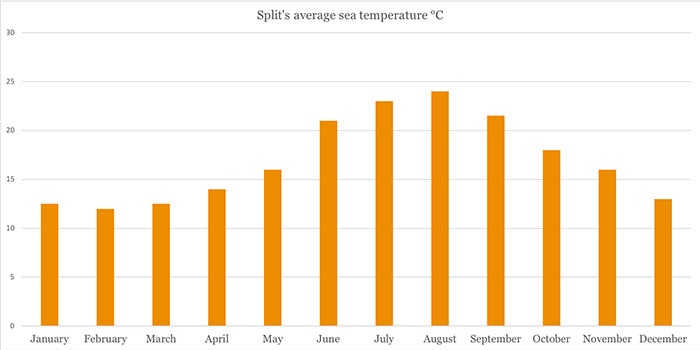
Why should you visit Split?
Reasons attracting thousands of visitors to Split every year include Split’s rich history, vibrant urban vibes, and stunning coastal beauty. From the ancient ruins of Diocletian Palace to the bustling cafes and charming restaurants, Split is a place in Croatia that you can’t miss.
Moreover, Split is more affordable than other popular spots in Croatia, and it has a central location, breezy beaches, historic boutique hotels, and cozy wine bars.
If you are not sure if you should visit Split during your time in Croatia, here are the reasons to add Split to your Croatia itinerary.
- The vibe! We absolutely love the vibe in Split! It has an incredible urban atmosphere, yet it feels slow-paced and relaxing. The 1,700-year-old Diocletian Palace, the heart of the town, is full of cafés, cool bars, and lovely restaurants. The seafront promenade, Riva, is a source of pride for all the locals and is always bustling with people. You’ll even find locals playing a ball game in the shallow sea of the Bacvice beach, even during winter.
- Split is still affordable! Split isn’t the most budget-friendly place to visit, but it is still relatively cheaper compared to other popular destinations in Croatia, such as Dubrovnik and Hvar. You can enjoy a good quality meal for as low as €13 ($14.30, £11.20), coffee at some bars in Split’s old town for only €1.30 ($1.40, £1.10) and a 0.5L of local draft beer for €3.5 ($3.90, £3). Accommodation is also affordable, with the exception of the Ultra Festival period when prices get crazy expensive. Therefore, if you’re planning to visit Split, it’s better to do it sooner rather than later as prices are continually increasing, making it hard to keep track.
- Split is a perfect base to explore Dalmatia! Split’s central location makes it an ideal starting point for exploring the surrounding area of Dalmatia. From here, you can effortlessly reach the islands of Hvar , Brac , Vis, and Solta; spend a day exploring Trogir and the Roman ruins of Salona; get active in Omis; or visit Krka and Plitvice National Park .
- Great food! Dalmatian food is yummy, and many restaurants in Split offer these traditional dishes : a baby beef stew with gnocchi, called pasticada; stuffed bell peppers with mashed potatoes; meatballs in a tomato sauce; grilled oily fish with Swiss chard; and like.
- History! You don’t have to wait in long queues in front of museums to experience the history of Split. The old town is a 1,700-year-old living museum where people live and breathe every day.
What to do in Split Croatia?
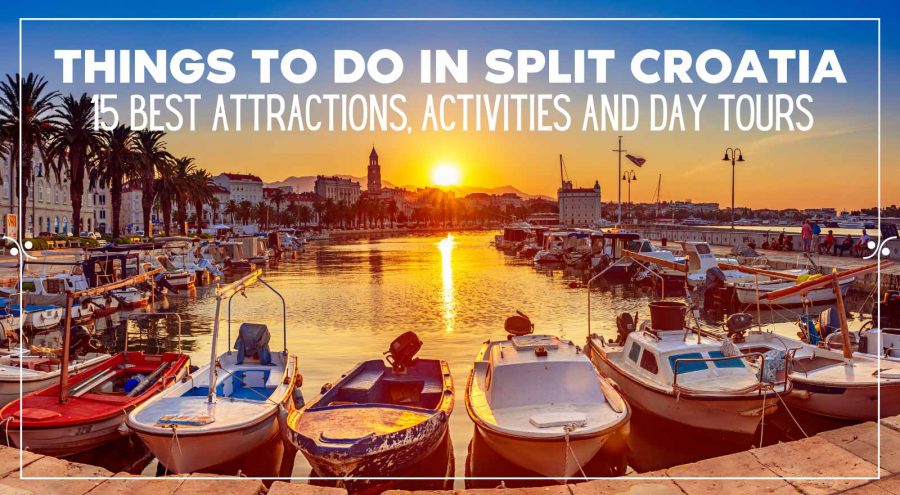
Whether you travel solo, as a family, or as a couple, you won’t find yourself short of activities, attractions, and things to do in Split .
Below we shortlist some of the things to do in Split to give you a feel of what to expect.
- Relax on Riva! Split’s famed seafront promenade, Riva, is always abuzz with people; it’s lined with cafés and bars where locals spend hours over a coffee or a beer. Simply do like locals do, sip a coffee, and watch the world go by … for hours.
- Explore the old town! Just get lost in a maze of allies, cobbled streets, and passages in Split’s old town, and explore 1.700 years of history.
- Eat local! The food and restaurants here are awesome! We’ve written a post on the best restaurants in Split, along with reviews on restaurants we’ve visited recently. Our fave restaurants are Villa Spiza , Uje Oil Bar , and tavern Nikola in nearby Stobrec.
- Have a coffee at Zbirac! Zbirac is the coolest day bar in Split. Located just above Bacvice beach, Zbirac is the locals’ favorite place to grab a drink. The bar is small, but it has a great terrace overlooking the beach and the sea. It’s protected from the north Bura wind, so the outdoor terrace is open all year.
- Play picigin at the Bacvice beach! A sandy beach located a 10-minute walk from the old town, the Bacvice is, along with a seafront promenade, the most popular place in town. Picingin, a beach ball game invented here, is played in shallow water with players keeping a ball from touching the water.
- Go on a day trip! Among many day trips from Split , a day trip to Hvar stands out as the most popular.
What to see in Split?
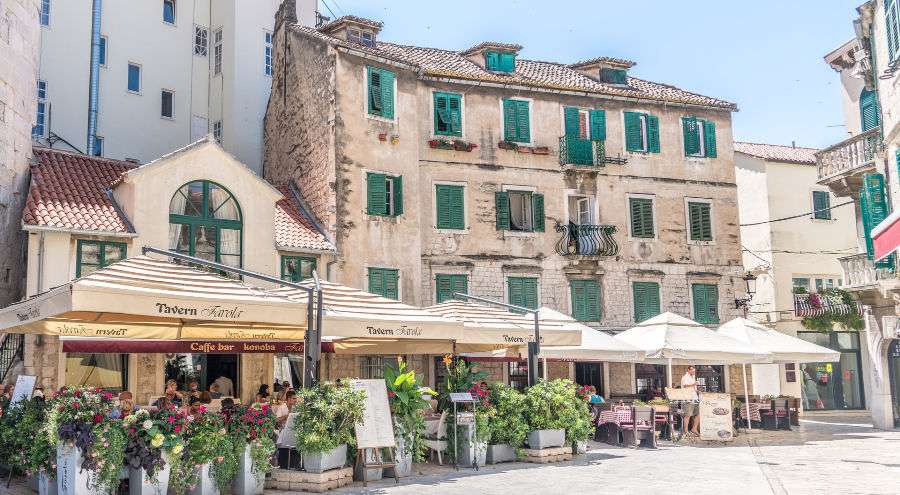
You’ll never need to walk far to see Split’s top sights! The majority of them are located within the Split old town.
- Town gates! Split old town is located within a 1.700-year-old Diocletian Palace. The Palace measures approximately 160 m by 190 m. Each of the four town’s walls has a gate (Golden Gate, Silver Gate, Bras Gate, and Iron Gate) located at the center of the wall, dividing the Palace into four quarters.
- A bell tower! The bell tower of the church of St. Dominus is one of the symbols of Split. First built in the period from the 13th to the 16th century, the bell tower went under complete renovation in the 19th century. The views from the top are fantastic and worth a climb via a narrow staircase.
- Peristyle! A narrow public square near the Cathedral, the Peristyle is the heart of the Palace and the place where all guided tours of Split begin or end. Ancient Roman columns made of red granite, an Egyptian sphinx, an entrance to the Palace’s basements, a Cathedral, and the Temple of Jupiter, can all be found on the Peristyle. It’s one of the main landmarks of Split, and it gets crowded at times.
- Varos! One of the oldest neighborhoods in Split, Varos is a charming place consisting mainly of traditional stone houses with wooden green shutters. It’s located on the south side of Marjan Hill, just northwest of Diocletian’s Palace. This neighborhood was established in the 17th century by peasants and fishermen. Today, it’s full of cozy apartments and room rentals.
- Peskerija and Pazar! Fish market (Peskarija) and Split’s green market (Pazar) are the two best places to feel the pulse of the city and observe locals as they go about their daily business.
Restaurants in Split
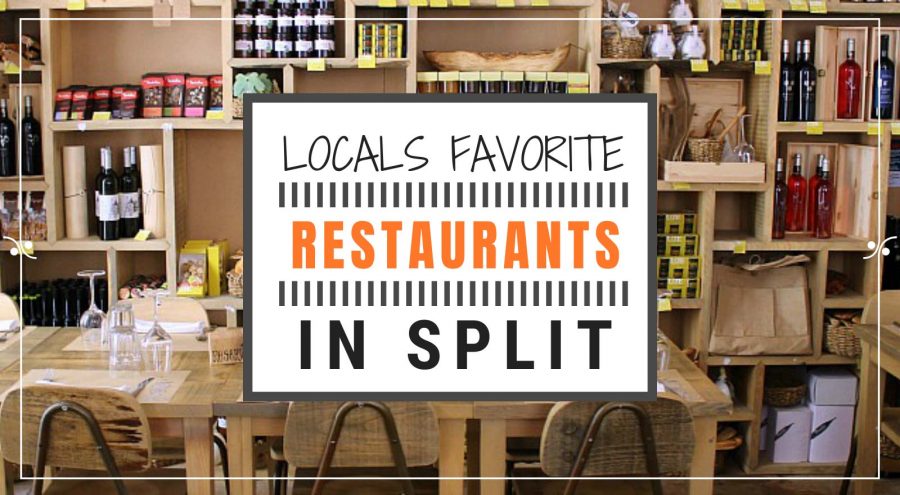
You can’t go hungry in Split with so many great places to eat. It is a foodie’s dream destination. From small, family-run taverns showcasing delicious Dalmatian cuisine, and yummy street-food joints serving a quick fix like hearty burek, or cevapi for late-night food cravings, to harbor-side elaborate fine dining restaurants, Split restaurants offer something for everyone’s budget and style.
What is a typical food in Split?
Typical meals in Split include grilled meat, fish, or seafood with sides like Swiss chard, french fries, or grilled veggies, various stews like cuttlefish or beef stew, pasta dishes, and risottos, especially black risotto with squids and squid ink.
Cheap local fast food includes savory phyllo-dough pies (burek or pita) with various fillings like cheese, spinach, potatoes, or minced meat, as well as cevapi, finger-shaped minced meat grilled and served with pepper spread (ajvar), onions, and pita bread.
How much does it cost to eat out in Split Croatia?
Eating out in Split is still affordable, although the prices are on the constant rise. You can eat for as cheap as €3 to €6 ($3.30 – $6.60, £2.60-£5.20) in local fast food joints.
A handful of local taverns offer a choice of fresh, tasty, and well-cooked daily dishes for as little as €8 to €20 ($8.80 – $22, £6.90 – £23.20) per dish. Dishes can include grilled tuna, tuna stew, pork, beef or veal chops with Swiss chard, calamari stew, pasta with zucchini and prawns, and like. A meal in an upscale restaurant will set you at around €70 ($77, £60) per person.
Restaurants In Split
Below we list our three favorite Split restaurants, all three of them showcase delicious Dalmatian cuisine. For more info, check out our full post on the best restaurants in Split .
Villa Spiza! Villa Spiza is a tiny little place serving traditional, fresh, and unpretentious food, using only locally sourced produce. There are just a couple of tables. The menu is simple, and it changes daily. Expect to pay €8 to €30 ($8.80 – $33, £6.90 – £26) per dish.
Contacts | Kružićeva 3 | t: +385 91 152 1249
Fetivi! Fetivi is a small, family-run tavern with a friendly atmosphere and excellent food. Located close to the Matejuska, a small fishing harbor west of Split’s seafront promenade, Fetivi serves traditional Dalmatian food, like fried small oily fish, octopus, chickpeas stew, black risotto, various grilled dishes, etc. Expect to pay around €15 to €40 ($16.50 – $44, £13 – £34) per dish.
Contacts | a: Tomica Stine 4, Split | t: +385 21 355 152
Kadena! Locals’ favorite restaurant in Split, Kadena is an elegant place with a nice terrace, shaded, and fantastic views over the sea. The place is rather large, and it often accommodates large groups that can be noisy at times. However, the food is sublime, and the service is excellent. A bit pricey; expect to pay around €70 ($77, £60) per person for a 3-course meal with drinks.
Contacts | a: Ivana pl. Zajca 4, Split | m: +385 91 522 6685 | t: +385 21 389 400 | e: [email protected]
Accommodation in Split

If you plan to stay in Split for more than a day, you’ll find plenty of accommodation options to suit your needs. From historic boutique hotels and charming vacation rentals to trendy hostels and villas, the town caters to every traveler’s preferences. However, it’s worth noting that large full-service hotels and international chains are uncommon in this area, apart from Lav Meridien Split and Radisson Blu.
Regarding pricing, the average cost of a double room with breakfast in Split during the low season (April, May, November) is around €120 ($132, £103) per day. In the shoulder season (June, September, October), the price increases to approximately €180 ($198, £155), while in the high season (July, August), you can expect to pay an average of €250 ($275, £215) per day.
Of course, you may find lower prices if you’re willing to venture further from the city center or opt for a guest house instead of a hotel. Additionally, special deals due to low occupancy can sometimes offer even better rates. On the other hand, if you’re looking for an upscale boutique hotel in the old town of Split, the prices of a double room with breakfast can go up to €350 ($385, £300) or more per day during the high season.
If you’re looking for a more affordable option, vacation rentals are a bit cheaper than hotels but range from €120 to €250 ($132 – $275, £103 – £215) per day for an apartment that accommodates 2 to 4 people during high season.
For the best experience in Split, we recommend staying in the lively neighborhoods of Diocletian’s Palace and Varos. Both areas provide convenient access to historical sites and immerse you in the city’s vibrant atmosphere. The only drawback is parking, as these neighborhoods are mostly car-free.
Within the Diocletian Palace area, some of our favorite hotels include the Palace Judita Heritage Hotel , Piazza Heritage Hotel, and Cornaro Hotel . For a more local experience, Divota Apartments in the Veli Varos neighborhood are a great option.
Hostels Downtown and Dvor provide budget-friendly accommodation options in the town’s center.
Booking.com and Airbnb are the best websites for searching for accommodation in Split.
Check our list of recommended accommodations in Split! Or, if you are ready to book, check out Booking.com for the best rates!
Split Beaches

Split, the largest town on the Adriatic Sea, is a vibrant beach destination with diverse beaches. From the sandy shores of Bacvice to the rocky beauty of Kasjuni and Bene Beach, Split offers a range of options for beach enthusiasts. The most popular beaches in Split are Bacvice, Kasjuni, Bene, and Znjan.
Bacvice is a sandy beach within a 10-minute walk from the old town. Trstenik and Znjan beaches offer excellent facilities for families with children. Kasjuni Beach awaits visitors at the base of Marjan Hill with its pebbly shores, trendy beach bar, and chill music. Bene Beach offers direct access to the crystal-clear waters of the Adriatic Sea, complemented by the shade provided by numerous pine trees.
For further information, check out our comprehensive post on the best beaches in Split .
Bars, Clubs & Nightlife in Split

Split offers a lively nightlife scene, with bars and nightclubs scattered throughout the old town and various neighborhoods. A bar crawl usually starts in the old town, across bars in Dosut Street and Pjaca.
Popular spots include Ghetto Club , known for its art gallery and bohemian atmosphere, Shotgun Shooters Bar for cheap shots and drinks, and Charlie’s Backpackers Bar for a chance to meet fellow travelers.
Leopold’s Delicatessen Bar is a must-visit for craft beer lovers, while Marvlvs Library Jazz Bar and Bar Sistema offer a more relaxed ambiance. For a good drink with finger food, visit The Daltonist Craft Bar .
Fabrique Pub offers food, more than 50 local and international beer labels, and late-night DJ or live band parties. The Central and the Adriatic Social Club are great choices for clubbing, while Bacvice Club provides a low-key option.
Read more about Split’s bars, clubs, and nightlife here.
Popular events
Split, Croatia hosts a variety of fascinating events and festivals throughout the year. While some are more geared towards locals, there are several noteworthy ones that are worth attending if you happen to be in town.
The largest music festival in Croatia, Ultra Europe , takes place in Split every July, featuring renowned artists and a week of entertainment.
The Split Summer Festival , held from mid-July to mid-August, offers dance, music performances, and open-air theater at different venues.
Lastly, the Days of Diocletian in mid-August celebrates Split’s Roman heritage with costumed performers, exhibitions, and traditional food.
- Find here a wide selection of affordable accommodation!
- Get familiar with the city, learn about history, architecture, culture, food and people with this Split walking tour.
- With limited time in Split, this half-day speedboat tour from Split offers a great way to visit three islands and the famous Blue Lagoon.
- Experience an adrenaline-rush speedboat ride and visit Bisevo, Vis, Budikovac, Hvar, and Pakliniski islands on this full-day speedboat tour from Split.
- Spend an active morning or afternoon with this Cetina River Rafting with Cliff Jumping Tour.
- Explore nearby must-see sites such as Dubrovnik, Mostar, Peljesac Peninsula, and Makarska or venture off the beaten path by renting a car.
- Have a peace of mind with Safety Wing Travel Insurance.
- Surf worry-free with Airalo eSIM card!
Practical info on Split Croatia
Finally, if you need some practical info on public transport, parking in Split, or traveling to Split, you’ll find it in this post!
Split, the second-largest travel hub in Croatia after Zagreb, is easily accessible by various modes of transportation. You can reach Split by plane, car, train, bus, or ferry. The airport is located 20 km northwest of downtown Split, with a shuttle service available. It is well connected to major European cities, making it easily accessible by air. Split is also well-connected by train and bus, with frequent services from Zagreb and other coastal towns. Additionally, Split serves as a major ferry port, offering connections to local islands and even Ancona in Italy. Traveling by car is convenient, with a motorway option available.
Split, the second-largest travel hub in Croatia after Zagreb, is easily accessible by various modes of transportation. You can reach Split by plane, car, train, bus, or ferry.
The airport is located 20 km northwest of downtown Split, with a shuttle service available. It is well connected to major European cities, making it easily accessible by air. Split is also well-connected by train and bus, with frequent services from Zagreb and other coastal towns. Additionally, Split serves as a major ferry port, offering connections to local islands and even Ancona in Italy. Traveling by car is convenient, with a motorway option available.
Split is a small and walkable town, with major sights within 30-40 minutes from any location. Split public transport is well-organized. The bus network is extensive.
The historical part of Split, the Diocletian Palace, a seafront promenade, and most of the Varos are all car-free zones . Parking is possible on streets, parking lots, and garages.
Traveling to Split
Getting to Split is easy as it is the second-largest travel hub in Croatia, after Zagreb. You can reach Split by plane, car, train, bus, or ferry. The bus, train station, and ferry port in Split are located next to each other and are within a short walking distance from the Split old town. On the other hand, Split Airport (SPU) is situated 20 km northwest of downtown Split, near Trogir.
If you decide to travel by plane, a shuttle service operates between Split Airport and the city center. Shuttle buses depart 20 minutes after landing and take around 30 minutes to reach Split downtown, costing €8 ($8.80, £6.90) per person.
Alternatively, you can take a taxi which will cost you between €30 to €45 ($33 – $50, £26 – £39).
The cheapest option is to take a local bus no. 37 or no. 38, which both have a scheduled stop near the airport. A one-way ticket costs €4 ($4.40, £3.50).
Zadar Airport, located 150 km northwest of Split, is also a viable option for reaching Split, with some pretty cheap Ryanair flights available.
You can also reach Split by train from Zagreb, with one-way tickets costing approximately €15.10 ($16.60, £13) and return tickets €26.50 ($29, £23).
Trains run three times a day from June 15th until September 15th, while during the rest of the year, they run once a day. The train journey takes six hours.
Intercity buses connect Split with Zagreb and many coastal towns, running frequently throughout the day and year-round. It takes around five hours to reach Split from Zagreb, with one-way tickets costing around €20 to €25 ($22 – $27.50, £17 – £21.50), depending on a bus company and time of traveling. The best place to check bus timetables and book your ticket online is the Bookaway website.
Split is also a major ferry port for the central Dalmatian islands, and also with ferries connecting Split with Ancona in Italy. You can book ferry tickets online. Jadrolinija operates the line year-round, with prices starting from €50 ($55, £43) per adult and €64 ($70, £54) for a car.
Helpful tip on local ferries: In high season, ferries get crowded. Arrive at least two hours prior to departure (if you travel by car).
If you’re traveling by car, getting to Split is easy as it is centrally located and easy to reach from many places in Croatia. If you’re coming from the direction of Rijeka or Zagreb, you can take motorway A6/A1, which takes around four hours to reach Split from either city. This motorway has tolls, and a trip from Zagreb to Split will cost you around €24 ($26, £21). If you’re looking to save on tolls, you can take an old D1 road, but keep in mind that it’s a single-carriageway road that goes through villages.
Budget tip: If you try to save on tolls but don’t mind driving through villages on a single-carriageway road, you can take an old E65 / D1 road.
Split public transportation
Public transportation in Split is highly organized, with an extensive bus network. City buses operate within Split, connecting various neighborhoods and nearby towns like Trogir and Omis.

The Split Metropolitan area is divided into four zones, with Zone 1 covering the wider city center and other zones encompassing nearby towns such as Solin and Kastela.
Within Zone 1, buses run every half an hour from 5 am to midnight. Night lines are no longer operating, so taxis are the way to go if you require transportation after midnight.
Zone 2 and 3 buses have less frequent schedules, with some lines departing every hour or even less frequently. If you stay outside the town center, check the bus schedule and plan accordingly.
Tickets can be purchased directly from the bus driver, with varying prices based on the zone. A one-ride ticket costs €2 for Zone I, €2.50 for Zone II, €3 for Zone III (Airport), and €4 for Zone IV (Trogir, Omis). Alternatively, tickets can be bought at any kiosk for a 50% discount (Zone I: €1, Zone II: €1.25, Zone III: €1.5, Zone IV: €2).
Check the detailed Split bus network .
Taxis in Split
Taxis in Split are quite expensive, but they are a convenient option if you’re traveling with a group and willing to split the cost.
The starting fares for Cammeo and UberX are €1.05 ($1.10, £0.90) and €1.40 ($1.60, £1.20), respectively, while Radio Taxi Split charges €3 ($3.30, £2.60). Additionally, the cost per kilometer ranges from €0.80 / $0.90 / £0.70) (UberX), €1.05 / $1.10 / £0.90 (Cammeo), to €1.80 / $2 / £1.60 (Radio Taxi Split). Cammeo has a minimum fare of €2.40 ($2.60, £2.10), whereas UberX’s is €3.80 ($4.20, £3.30), and for Radio Taxi is €8 ($8.80, £6.90).
Alternatively, you can conveniently explore Split on foot. Split is actually a perfectly walkable town due to its car-free, compact old town, and relatively small size. No matter where you’re staying, you’ll never be more than 30-40 minutes walk away from the old town. This way, you can enjoy the charm of Split while saving money on transportation.
Parking in Split
When visiting Split by car, it’s important to note that the historical areas, including the Diocletian Palace, the seafront promenade, and most of Varos, are car-free zones. If you plan to visit Split by car, remember that parking within the old town is unavailable.
Parking is available on the streets, lots, and garages, but fees apply. For reference, check out the Split Parking Map below.
The closest parking lot to the old town is at the eastern end of the Riva promenade. This is the busiest and most expensive parking lot in Split, costing €4 ($4.40, £3.40) per hour in summer and €2 ($2.20, £1.70) per hour in winter. This parking option is still the most convenient for visiting the old town despite the cost.
Another convenient parking lot is located behind the main train/bus station. The rates here are €1.50 ($1.70, £1.30) per hour for the first hour and €2 ($2.20, £1.70) for each subsequent hour, or €23 ($25.30, £19.80) per day.
For a more budget-friendly option, street parking is the best option. For example, parking on Plinarska Street costs only €1 ($1.10, £0.9) per hour. Street parking is available in designated areas throughout the city, with four different zones and varying fees. The Split Parking app provides real-time information about parking in Split. Payment can be made through SMS or at self-operated parking machines.
Street parking is divided into different zones, and a parking app provides real-time information. Payment can be made through SMS or at self-operated parking machines.
There are additional parking lots in residential parts of Split .
Car rental in Split
Those who plan to rent a car while in Split will be happy to know that all major national and international car rental companies have their branch offices in Split. You’ll find them all at Split airport, but also many keep a second office in Split downtown. Whatever works better for you!
In Croatia, the car rental business is very seasonal, and rates increase dramatically from June through September.
We always use Rentalcars.com for car hire. They have good prices, work as consolidators with all major car rental companies, and generally are reliable.
On their site, you can easily compare the prices and availability of many car rental companies. Their filter options give you a chance to narrow your search down in accordance with your preferences: automatic or manual transmission, supplier, number of seats, etc.
If you prefer to rent a car directly with a local car rental company, below you’ll find info and contacts.
1 | Nova
Nova is a national car rental company with offices across Croatia.
Contacts (Main office) | a: Obala Kneza Domagaoja 1, Split | t: + 385 21 775 388 | e: [email protected]
Working hours | Mon-Sun: 8 am-8 pm
Contacts (Airport Office) | t: + 385 21 203 308 | e: [email protected]
Working hours | Mon-Sun: 7 am-9 pm
2 | Oryx
Oryx is the largest Croatian car rental company with offices all around Croatia.
Contacts (Town office) | a: Sv. Petra Starog 1, Split | t: +385 21 318 800 | e: [email protected]
Working hours | Mon-Fri: 8 am-3 pm | Sat:, Sun 9 am-2 pm | Sun: upon request
Contacts (Airport office) | t: +385 21 895 164 | e: [email protected]
Working hours | Mon-Fri: 8 am-8 pm | Sat:, Sun 9 am-5 pm
3 | Enterprise
Enterprise is a global rent-a-car company with offices in all major Croatian towns.
Contacts (Town office) | a: Poljicka Cesta 26, Split | t: +385 99 382 4783 | e: [email protected]
Working hours | Mon-Sat: 8 am-8 pm | Sun: 9 am-12 pm
Contacts (Airport office) | t: +385 99 392 0362
Working hours | Mon-Sun: 7 am-11 pm
Shopping in Split
In Split, one will immediately notice the locals’ impeccable fashion sense and attractive appearance. Historically, Split has been a shopping haven for people from all corners of Dalmatia. In recent years, this reputation has only grown stronger with the opening of numerous shopping malls in and around the downtown area.
For a comprehensive shopping experience, two prominent shopping malls stand out: City Center One Split and the Mall of Split. City Center One Split, located at the eastern end of town on Vukovarska Street, is a mere 15-minute drive from the center. With over 150 shops, cafes, and restaurants, including popular brands like H&M, Lacoste, C&A, and Swarovski, City Center One Split offers something for everyone.
The old town of Split also boasts many shops, designer boutiques, and artisan stores. Marmontova Street, the main shopping street in Split, is a must-visit for any avid shopper.
For those seeking fresh produce, we highly recommend visiting Split’s green market (Pazar) and the fish market (Peskarija), both in the old town. Additionally, several supermarket chains, such as Lidl, Konzum, Spar, and Tommy, cater to general grocery shopping needs. While all are reliable options, Konzum stands out with slightly lower prices and faster checkout service. Spar Supermarket is in the old town, occupying the ground floor of the 13th-century Palace Papalic. The shopping experience here feels more like a visit to a museum than a typical supermarket.
Visiting a few concept stores in Split’s old town is a must for those interested in unique, locally-made designs. Break Time on Trogirska Street 8 offers exquisite handmade nautical bracelets. Jaman Art serves as both a gallery and a shop, showcasing and selling paintings, cellphone cases, sculptures, and prints by the talented academic painter Danijel Jaman. If you have a penchant for exceptional design, Nered Shop is the place to go for lovely, handmade souvenirs designed in Croatia. Designer store Krug is a treasure trove of authentic clothing and jewelry, all handcrafted in Croatia in limited series.
Immerse yourself in the vibrant shopping scene of Split and discover the true essence of Croatian craftsmanship.
Money and ATM
As of January 1, 2023, the Croatian currency is the euro. The exchange rate is around US$1.10 for 1 euro, £0.86, AUD1.64, and CAD1.47. You can exchange money at many places in Split, including exchange offices, banks, and hotels.
ATM machines are also everywhere; near every bank, at prominent places in town, and at many hotels. ATM machines have an option for different languages, so they are easy to operate. Beware that some ATM machines have higher fees than others. We find that generally, ATM machines that belong to banks are cheaper than independent ones.
If you decide to pay with a credit card, you might be offered the possibility to be charged either in your own currency or in euros (local currency). You might intuitively opt to pay in your own currency. However, don’t do this! The banks use something called a dynamic currency exchange rate, and most of the time (read always) it’s less favorable than if you decide to pay in local currency.
I always hear people complain that the internet in Croatia is slow. I generally don’t need super-fast internet, 4 Mbps is fast enough for me.
Anyway, during the high season, with so many tourists around, the number of users increases so much that our infrastructure can’t really take it. So, at times, the internet gets really slow in summer. This doesn’t happen everywhere, and not on all networks, but there aren’t really rules. You just learn to live with it.
However, the closer you stay downtown, the better the internet you should get. Almost all accommodation comes with free WiFi internet, and you should expect a speed of at least 20 Mbps. Mobile now mostly runs on 5G, although 4G is still standard in some areas.
Many bars and restaurants offer free WiFi for their guests, but you need to ask for a pass. Towns also offer free WiFi hot spots, but this connection, unfortunately, doesn’t work most of the time.
More Info about Visiting Split, Croatia
- Learn all Split essentials with our Split Travel Guide .
- Plan your activities in Split with our detailed guide to things to do in Split .
- Looking for the unusual things to do in Split, Croatia ? Check our in-depth guide!
- If you plan to stay in Split, check a list of recommended accommodation in Split Croatia .
- Find out where to eat in Split with our post on best restaurants in Split .
- Detailed info on Split beaches you’ll find here.
- A list of Split bars and clubs .
- If you are staying in Split only for a day, here is our One Day in Split Itinerary . Staying for 3 days? No problem, we’ve written also on how to spend three days in Split, Croatia !
- Planing a day trip from Split? Here is our list of the best day trips from Split, Croatia !
- Arriving to Split by plane? Here is our Split airport guide, including tips on how to get to Split center from the Split Airport .
- Want to visit Hvar from Split? Check out our ultimate guide on visiting Hvar from Split !
- Planing your Croatia trip, but not sure where to go first? Our Split or Hvar? and Split or Dubrovnik ? posts will help you decide!
- Visiting Dubrovnik from Split? Find here all details on how to get from Split to Dubrovnik !
- Interested in other Split restaurants? Read our reviews on Villa Spiza , Uje Oil Bar , Buffet Fife , and Zinfandel Food & Wine Bar .
Frankaboutcroatia.com is a participant in the Amazon Services LLC Associates Program, an affiliate advertising program designed to provide a means for sites to earn advertising fees by advertising and linking to Amazon.com and affiliated sites. This post might also contain affiliate links to other sites, like accommodation or activities. And if you purchase anything using these links, we earn a little commission with no extra costs for you. Thank you for supporting our blog! Read full disclaimer here.
Home / Destinations In Croatia / Split, Croatia / A complete travel guide to Split, Croatia
38 thoughts on “A complete travel guide to Split, Croatia”
Hello. My husband and I are traveling to Split next week. Do you recommend we purchase one of the Split City Cards on offer for 3 day passes to various places? If so, which one?
You can get from Hvar to Stari Grad by bus. As for direct Dubrovnik – Stari Grad ferry – I am not aware of any, they all go directly to Hvar Town.
Hi Frank – If we arrive from Split via ferry into Hvar town and wanted to spend some additional nights in StariGrad – what’s the easiest way to get to Stari Grad for Hvar town (without a car)? And also, are their direct Ferries from StariGrad to Dubrovnik?
Split is OK to stay for a week if you don’t mind staying in a big town. It has lots of things to do, good restaurants, beaches within walking distance, and it is a good base to do day trips to many nearby places. You can visit Hvar, Brac, Vis or Solta island. You can go to Krka National Park, or visit Trogir. You can also go wine tasting in the vicinity, or check some of the beautiful beaches along Omis and Makarska Riviera.
You can hire a private transfer, or simply board the shuttle bus. Both is simple!
How do you suggest 9 people get to downtown split from the airport on July 3? Thanks in advance!
First of all, thank you for all the information on your site. We first had the idea of visiting Croatia listening to an NPR report of about Dubrovnik. While we initially hoped to go there, we were slow to book and missed out on the chance. We do have the opportunity to go to fly into Split in July (I know, not the best time). Do you think that 7 days is too much time to stay there? We have beach lovers in our group as well as history buffs. With the different tours and close locations will we run into too much idle time? Thanks again for the information.
Hi Charanjeet, thanks for reading! 1) Yes, you can visit Plitvice from Split for a day (it will be a long day, but it is doable) 2) Hm, hard to say. Plitvice is more concentrated. All the sites are one next to another, while Krka is more spread out (if you want to see all the sites you will use the car between some of them). Plitvice has bigger falls. But both sites are nice. Krka will be less stress also because is much closer, and then you can have a more relaxed visit. Food is also better around Krka Waterfalls (Konoba Vinko in Konjevrate is highly recommended as well as a visit to Bibich or Sladic winery). Hope these few comments help you choose. 3) The most famed oyester and shellfish place in Croatia is Ston on Peljesac peninsula. Particularly restaurants in Mali Ston, but we like even more Ficovic in Hodilje. Wineries around Split include Putalj (the closest), but if you want to see the best ones, you need to go more south, like WInery Rizman and Terra Madre in Komarna (views are top), Saints Hills, Korta Katarina, Bura, or Milos on Peljesac (don’t miss a visit to Postup and Dingac wine growing hills). Some of the nicest sites you will see! And also previosuly mentioned Bibich and Sladic near Skradin.
Great blog Frank! I have learned so much about Croatia from your website, and it has been absolutely useful in planning my trip. Would you be so to guide me a bit further? (1) I’m thinking of a day trip from Split to Plitvice Lake. Do you think that’s unreasonable? We will have a rental car, so I’m thinking if we leave early AM, do they allow entry at a certain time. (2) Also, between Krka and Plitvice, if you were to choose, which would you? We just have one day and we can’t make up our mind. (3) Would you recommend any particular oyster restaurants (small town or fancy), any mature olive orchards and wineries? Thank you much
Usually, you can get by bus, and you should be able to check it on Getbybus. The problem is that this year is specific with Covid, and there are fewer buses at the moment, some lines are even completely ceased. However, by summer this should stabilize. Already now if you check dates in June, the Getbybus shows availability.
Hello, how to get to split from Plitvice? where to check the routes. can’t find on GetByBus.
Hi Frank, any thoughts on staying in Trogir vs Split? Niceness of Old Towns, cost of accommodations, parking? we figure we can do a day trip to whichever one we don’t stay in. We’re not that interested in the nightlife .
Thanks. Love your blog
Thanks, Rachel, so glad to hear that :)
Your site is SO useful. It’s our go-to and we are very grateful. Sadly we saw your villa too late but promise this will be our choice for Istria when we’re back in a few years. Rachel
Planning to do it this winter. Do you have any tips?
I am afraid that there isn’t any easy solution. You can either plan an overnight in Hvar, take a private boat transfer to Hvar, book a group tour to Hvar from Split, or take a car ferry from Split to Stari Grad (for this you will need a car as you need to travel from Stari Grad to Hvar).
Frank can you help we are going to Split in October and the only ferry we can find to Hvar is at 10 am from split and we only get 2 hours there is there a ferry service that gives us more time time. Thanks. Susan
Hi Frank, what is the best way to get from Split airport into town? Uber? Taxi? Something else? Thank you!
Your travel guides have been great for Porec & Split, I am going to Pula in September 2018 you wouldn’t happen to have anything on this region. We are also going to Zadar next May
Hi! I am visiting Split & Hvar in June. Everything is planned out except where to stay our last night.
On Saturday morning we have a 6:15 AM flight out of Split. Where would you recommend staying that is easy to get to the airport for probably 4AM?
Thanks in advance for your help!
Hello Frank, I have a question regarding non agency hotels, apartments, private apartments. I am planning our trip from July 15 to July 29th. Most of the agencies are 80% booked. Is it possible to find accommodations by simply inquiring at smaller places, like we do when we travel in the states? Thanks
My boyfriend, our little dog and I are going to Split in July. So far we’ve only booked out flights and are currently looking around for places to stay. We’d like to stay in central Split a couple nights and for the rest of the week we’re are looking for a place that has nice food and beaches. We’re not into partying, so someplace a bit more mellow would be preferred. We’ve looked at Makarska and Brac. Do you have any suggestions?
Many thanks :) Emily
Hi Gordon, beside writing this blog, and providing some info, we don’t offer other services. Have a nice time in Croatia with your gran daughter.
Hello Frank, I am a 84 year old retired male in good health. I will be traveling with my gran daughter in October for two weeks. We do not drink, except during dinner or lunch. Please explain what services you provide.
Dear Frank, I am a 71 year old Canadian widow in good health living in London, Canada. My income is limited to my gov’t pension of $1900CA per month and I have no savings. I am tired of our cold winters and am starting to contemplate a move to an affordable, warmer location. I came across Split, Croatia online as a place recommended for expats to retire to. I do not speak Croatian, but my mother tongue is Hungarian and I have studied Italian, French, and German. Since you have personal experience living there, can you please give me your honest opinion on whether this could be a good move for me? What do I need to be aware of in order to make this life-changing decision? Could I survive (or even live comfortably) on my frugal resources? Any advice or precautions you can offer would be greatly appreciated!
Hi Frank Me and my sisters will by fly to Croatia from London fir about 7 days. 3 days in Zagrenb, 1 day in Split and 3 dsys in Dubrovnik. We would like to visit Montenegro too.
We have searched lots of reviews and do not know where to start from. Any recommendations?
Hi Frank , Your website is so useful . Huge thanks . We are here in Split for a few days before hiring a boat on Saturday for a week & returning it to Split. We are then hiring a car for a few days , again returning to Split & wonder if you can offer any hints for further travel . We don’t necessarily need to stick to the coast, but it is is so beautiful are happy to . Travelling with husband & 2 kids 19 & 21 . All fairly fit . Happy to cycle, walk etc . As yet no accomadtion boooked & we’d favour getting away from the crowds & eating hood local food . Many thanks , Cheryl
Very useful guide thank you.
We will be visiting Split in early October for 7 days and plan to travel to Hvar and Brac possibly spending a night on each. We like nice restaurants and bars and generally exploring the sights. We would not have ny interest in spending time on the beach or in the water.
With regard to the islands particularly can we expect that most restaurants will still be open or might it be out of season for some?
If you prefer beach over the city, then definitely Brac.
We wish to enjoy beach more than city, is it better to stay in one of the islands like Brac or should I stick to Split city? We have 4-5 days. Thanks.
Frank – my wife and I are visiting Split in late June and want to visit Rovinj from Split. Can you recommend the best way to get to Rovinj from Split. Any recommendations re: car hire with driver? Are there ferries from Split to Venice? Any recommendations on boat/yacht rental companies for island hopping while we are in Split? Thanks.
Hi Annette, thanks for your comment. We recommend Viator. Let us know if we can help with anything else.
My husband and I will be in Split in September 2017. We would like to take a boat tour to visit a couple islands; maybe Vis, Hvar, Brac. Can you recommend a good company and a good itinerary please. Thank you.
Hi Marie-Claire, Sibenik is wonderful! It’s less known than Split, Zadar, or Dubrovnik, but in the last years its tourist offer and infrastructure is really developing. I think you’ll be happy in Sibenik. It’s less hectic than Split. You can visit Split easily from Sibenik for a day.
Hi Frank, I have been reading about an International Children’s Festival at Sibenik. Do you know anything about it or about the town of Sibenik itself? It is not very far from Split. Would Split be a nicer place to stay? I love all your advice and pictures on your website btw! M-C
Frank, my wife and I will be cruising from Dubrovnik to Split in early October. Once we get to Split we were thinking of staying a couple of days there and then driving up to Plitivice for a couple of days and then to Zagreb to fly home, could you recommend some stops along the way from Split to Zagreb?
We spent 2 months in Split and absolutely loved it. Our time there was the highlight of the last year of travelling. As you say, it is centrally located – we used it as a base to explore Dubrovnik, Mostar, even as far as Kotor. Lots of highlights in the immediate vicinity too (my personal favorite was the little town of Omiš). By the way, I took your recommendation of Konoba Matejuska and it is fabulous. We became regulars. I have to say that Buffet Fife was absolutely horrible the one time we went. Terrible. Maybe they had a bad day or something has changed. Excellent guide to Split. Frank (bbqboy)
I’ve always loved Split and prefer it to Dubrovnik, mainly because it isn’t as touristy and crazy. We spent 5 days in Split towards the end of June. We’d take the kids for a walk after dinner every evening, get an ice-cream and sit around the Peristyle (I had no idea it was called that!) listening to the accoustic musician playing every evening outside the Luxor. We used Split as our base to get to Brac- we did 2 day trips to Brac. Im glad tourists are starting to notice Split.
Leave a Comment
- Travel Advisories |
- Contact Us |
- MyTravelGov |
Find U.S. Embassies & Consulates
Travel.state.gov, congressional liaison, special issuance agency, u.s. passports, international travel, intercountry adoption, international parental child abduction, records and authentications, popular links, travel advisories, mytravelgov, stay connected, legal resources, legal information, info for u.s. law enforcement, replace or certify documents.
Share this page:
Croatia Travel Advisory
Travel advisory august 15, 2024, croatia - level 1: exercise normal precautions.
Reissued after periodic review without changes.
Exercise normal precautions in Croatia.
Read the country information page for additional information on travel to Croatia.
If you decide to travel to Croatia:
- Enroll in the Smart Traveler Enrollment Program ( STEP ) to receive Alerts and make it easier to locate you in an emergency.
- Follow the Department of State on Facebook and X/Twitter .
- Review the Country Security Report for Croatia.
- Visit the CDC page for the latest Travel Health Information related to your travel.
- Prepare a contingency plan for emergency situations. Review the Traveler’s Checklist .
Travel Advisory Levels
Assistance for u.s. citizens, croatia map, search for travel advisories, external link.
You are about to leave travel.state.gov for an external website that is not maintained by the U.S. Department of State.
Links to external websites are provided as a convenience and should not be construed as an endorsement by the U.S. Department of State of the views or products contained therein. If you wish to remain on travel.state.gov, click the "cancel" message.
You are about to visit:

Split Travel Guide
Last Updated: September 5, 2024
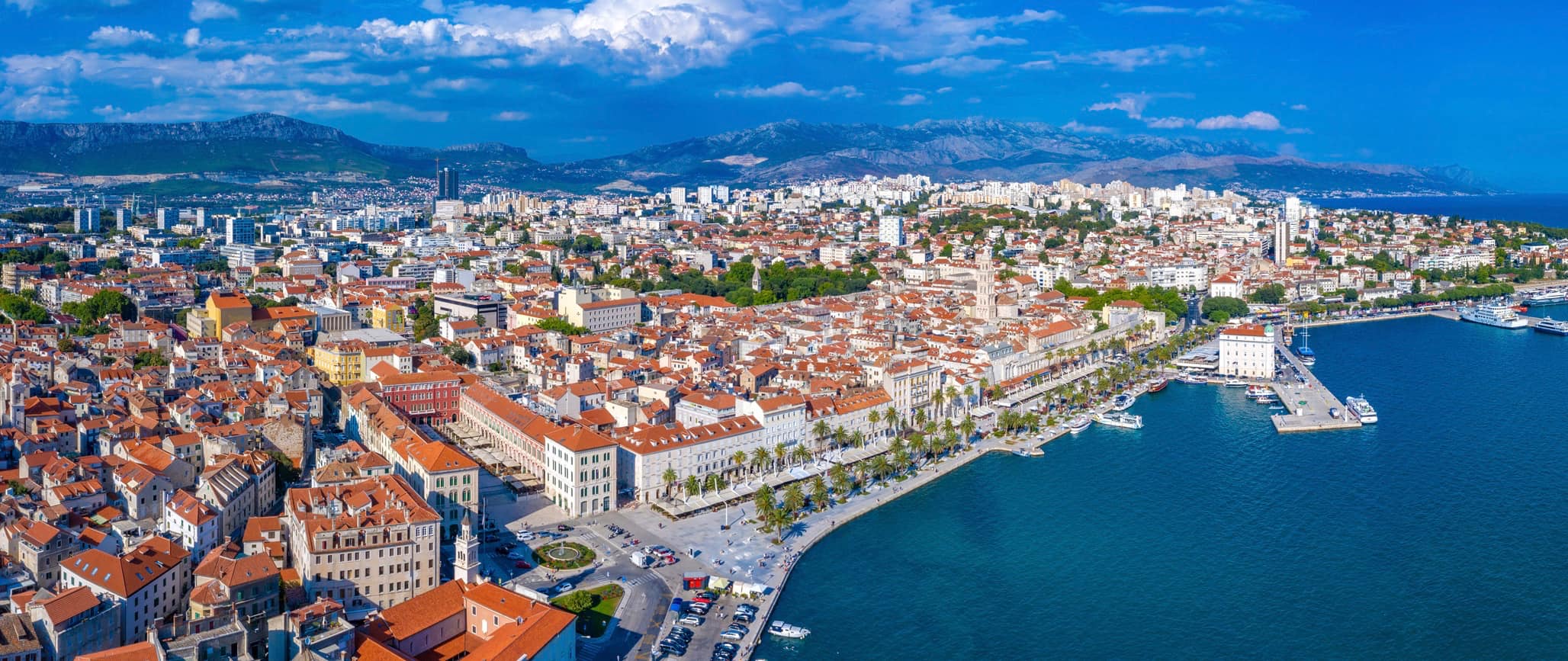
Everyone who visits Croatia seems to gravitate to Split. This stunning UNESCO World Heritage Site is a major launching pad for boat tours off the coast and a ferry hub for island-hopping. It’s also home to the gigantic Diocletian’s Palace. In short, it’s the cultural and economic heart of the Dalmatian coast.
For all these reasons, Split is a perfect place to plant yourself for a while. Explore the fascinating 1,600-year-old Roman palace; amble along the Riva, or seaside promenade; and take as many day trips as time will allow, since this city of 180,000 people is well situated to reach various islands, as well as underrated but dazzling towns such as Trogir, just north of town.
While the Dalmatian coast is the busiest (and most expensive) part of Croatia, it’s definitely worth exploring for a few days. While you might have to jostle some crowds, Split has a ton to offer travelers of all stripes and budgets, regardless of your interests.
This travel guide to Split can help you to make the most out of your visit.
Table of Contents
- Things to See and Do
- How to Stay Safe
- Where to Stay
- Typical Costs
- Suggested Budget
- Money-Saving Tips
- How to Get Around
- Best Places to Book Your Trip
- Related Blogs on Split
Click Here for City Guides
Top 5 things to see and do in split.
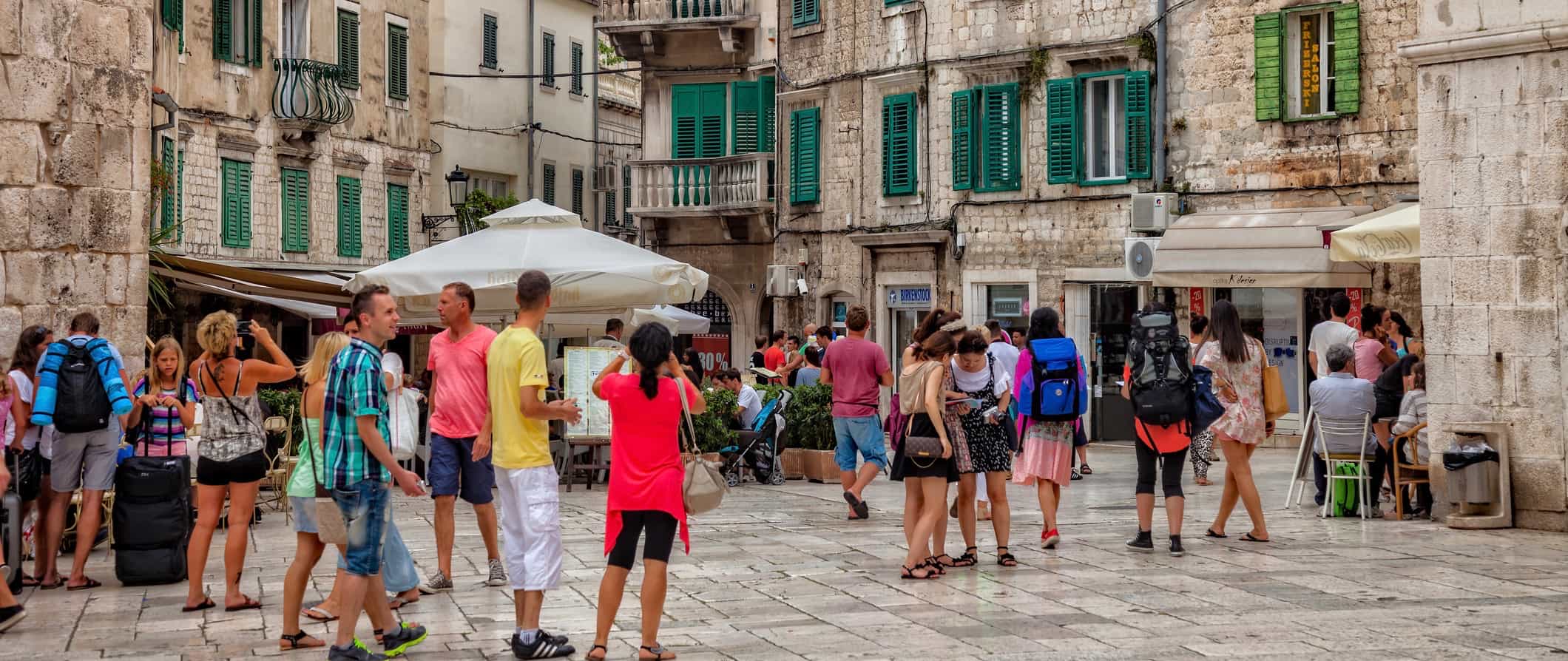
1. Explore Diocletian’s Palace
While this palace complex was built in the fourth century for Roman emperor Diocletian, he died just a few years after he moved in, causing it to fall into decline (as did the Roman Empire). The entire complex occupies seven acres and is one of the earliest designated UNESCO World Heritage Sites in the world. Today, it’s still (sort of) with us, but the city has moved in. The massive palace ruins form a large part of Split’s historic center, which is filled with a maze of shops, restaurants, and hotels, as well as many of the major sites in town.
2. Trek up Marjan Hill
Pronounced “mar-yahn,” the hill dominating Split can be a fun trek, especially if you’re looking to burn off all that Dalmatian wine. Nicknamed “the lungs of the city” because it’s blanketed in forest, Marjan juts out into the Adriatic. The base of the path can be reached by heading to the end of the Riva promenade along the waterfront. While it’s a paved path intermixed with staircases, be aware that some sections are quite steep, though you’ll be awarded amazing views from the top!
3. Climb the campanile of St. Domnius Cathedral
Famous for its towering spire that dominates the skyline, the Cathedral of St. Domnius was built in the seventh century around the mausoleum of Diocletian. It’s considered the oldest Catholic cathedral still in use in its original structure. The interior is a fascinating study in early medieval architecture, and the 57-meter (187-foot) 12th-century bell tower offers Insta-worthy views. For 11 EUR you can get a combined ticket that includes entry to the cathedral, crypt, baptistery, treasury, and bell tower.
4. Learn local history at the Split City Museum
City museums are an interesting way for first-time visitors to get a primer on a locale. The 75-year-old Split City Museum is located in Diocletian’s Palace. One of the highlights is ambling around the 15th-century Gothic building, which includes rooms furnished as they were when the nobility lived in the townhouse. There are three floors of displays and artifacts showcasing Split’s history from the Roman period through Yugoslavia (which dissolved in 1992); the main exhibits include Renaissance-era weaponry, medieval sculpture, and documents and drawings detailing the city’s history. Entry is3 EUR.
5. Ramble along the Riva
This wide seaside promenade lined with palm trees is the place to be in Split. It’s officially known as Obala hrvatskog narodnog preporoda , but everyone knows it simply as “the Riva.” Locals come here to nurse coffees for hours at cafés, people-watch, and gossip about friends. It’s also an excellent place to catch the sunset, watch some street musicians, or take in all the boats coming and going in the harbor. Once the sun goes down, the bars liven up along this strip as well.
Other Things to See and Do in Split
1. take a free walking tour.
The first thing I do in a new city is take a free walking tour. It’s the best way to see the highlights while connecting with a local guide who can answer all my questions. Free Split Walking Tour organizes a regular free tour that covers all the main sights around town. You’ll take a walk by Saint Dominus Cathedral, Diocletian’s Palace, and other important places in the city’s history. I loved learning about the influences of other cultures like the Ottomans, Greeks, and Venetians, which you can see reflected in the architecture and food. Just be sure to tip your guide at the end!
2. Try to feel fjaka
Split is the capital of fjaka (pronounced “fe-yahka”), an untranslatable word that only exists on the Dalmatian coast. It’s a feeling of relaxation, not working too hard, and enjoying a balanced life. Some call it “Dalmatian Buddhism.” Try relaxing on the beach with a book or enjoying a gelato as you stroll down the promenade and take in the city’s energy. Asking for tips on achieving maximum fjaka is a fun conversation starter with locals.
3. Chill out on Kašjuni Beach
This beach is made up of small pebbles, typical of the seashore along the Dalmatian coast. It’s for families but also a local favorite, thanks in part to the fact that its idyllic, tranquil vibe feels like you’re miles and miles away from town (when you’re only a couple of miles away). The water is crystal clear and a gorgeous turquoise, making it the perfect spot for swimming or sunbathing. You’ll have to walk down from the main road to access the beach. Bring a towel because there aren’t any chairs to rent here. Trees along the edge of the beach provide some shade, but otherwise it’s very exposed. From the city center, take bus number 12, which goes right by the beach.
4. Take a day trip to Trogir
Located 32 kilometers (20 miles) north of Split, Trogir is the most beautiful town you’ve probably never heard of — and one of the easiest day trips from Split. This town of 10,000 people is small but packs a punch. It’s surrounded by medieval walls and handsomely clad in white limestone. Medieval churches are sprinkled about. And fortunately, you won’t find an army of cruise-ship tourists invading the place. Don’t miss the towering Cathedral of St. Lawrence (whose construction began in the late 12th century), and if the tall, 15th-century bell tower is open (and you’re not afraid of heights), trudge up to the top for incredible views. Catch one of the frequent buses to Trogir from Split’s main station, Sukoišanska.
5. Wander around the Meštrovic Gallery
Croatia’s most famous sculptor, Ivan Meštrovic, was an artist and writer who lived an interesting 20th-century life: he traveled Europe in exile during World War I, showcasing his art, and spent months in prison during World War II. A visit to his main gallery and museum is a study of what it was like to live in early Yugoslavia. You also get to gawk at many of the legendary sculptor’s works in a neoclassical building that he designed himself. There are more than 130 of his works on display, including his masterpieces in bronze, wood, marble, and plaster. The grounds are gorgeous too. Meštrovic had a variety of plants native to the Mediterranean cultivated and you’ll see sculptures scattered through the park. Plus, there’s an incredible view of the sea from top of the entrance stairway. Admission is 12 EUR.
6. Get medieval at Klis Fortress
Game of Thrones fans (or people who just like medieval fortresses) should put Klis on their priority list. Because this imposing citadel sits at an important passageway between the coast and inland, it was fought over and invaded many times during the past ten centuries. The Mongols, Ottomans, Venetians, and eventually Croatians all controlled it (or died trying). Today it is a fun trip just 13 kilometers (8 miles) north of Split. Game of Thrones aficionados will recognize the fortress from the show (which filmed many of the scenes in Meereen here). Take bus #22 from central Split to reach Klis. Admission is about10 EUR.
7. Visit the Ethnographic Museum
You needn’t be an anthropologist to love a well-done ethnographic museum. And the one in Split is excellent, particularly if you’re interested in broadening your knowledge of the people of the central Dalmatian coast and their history. The museum boasts displays of local crafts that have been done here for centuries, including embroidery and pottery. I particularly enjoyed the exhibitions on traditional instruments and dress throughout the city’s history. The museum provides interesting information that really gives you a sense of how these different elements were influenced by the land and culture. Admission is 3 EUR.
8. Cheer on the home team at a Hajduk Split soccer match
The most popular and beloved team on the Dalmatian coast, Hajduk Split is a powerhouse of a football (soccer) team. If you’re in town during the season — which is almost year-round — then you’re in luck. You’re even luckier if Hajduk is playing its arch-rivals, Dinamo Zagreb. Poljud Stadium holds about 35,000 people and is the second-largest in Croatia.
9. Day-trip it to Salona
Set in the sleepy suburb of Solin, just a few miles from the center of town, these ancient ruins were part of a Roman colony some 2,200 years ago. In its time it was one of the largest cities in the Roman Empire. The city was abandoned during an invasion by Avars and later Slavs. There’s plenty to see here, including a necropolis, early Christian chapels, city walls, 1,800-year-old towers, public baths, and an amphitheater. It’s all enough to warrant the common nickname “the Pompeii of Croatia.” Take bus #1 from central Split for the short journey to Salona. Admission is 8 EUR.
10. Visit the Archaeological Museum
You can visit the ancient Roman site of Salona — and you most definitely should — but it’s a helpful to pair it with a stop at this fascinating museum. That’s because it houses a plethora of historic objects found in Salona, plus some Greek, medieval, and even pagan and pre-Christian ones. The museum is just a short walk from the city center and is a must for history buffs. Admission is 8 EUR.
11. Explore the fish market
Split’s fish market is a wonder to behold. Tsukiji in Tokyo it is not, but Dalmatia’s largest fish market has all the bustle you’d expect from a seaside city that traffics in super fresh seafood. This market building is 120 years old and is central to local life in Split because much of the local cuisine comes from the sea. The variety of seafood available is incredible. You’ll find sardines, mackerel, sea bass, and rarer items like lobster and red porgy. The market is open from 6am-1pm every day.
12. Tour a local winery
Croatia is one of the world’s top wine producers, mainly focusing on white wines due to the area’s climate. Visit Putalj Winery just outside of Split to learn more about this Croatian tradition and to sample the wines right at the vineyard. Paired with the tastings are local specialties like cheeses, prosciutto, bread, and olive oil made at the vineyard. The tour is hosted by Anton, the winemaker himself, whose family has a long history (hundreds of years!) of winemaking. Tours cost 130 EUR and occur daily.
13. Visit the Game of Thrones Museum
Although small, this museum dedicated to the famed HBO series is a must for fans. Learn about the various filming locations around Split, and see select detailed costumes and props from the series up close. Split was used to film scenes in the fictional city of Mereen and Slavers Bay. There are replicas of cities from the show, costumes, dragons, sets, weapons, and more. You’ll even get to see life-size replicas of main characters. Admission is 14 EUR.
14. Experience Froggyland
For a truly weird and offbeat experience, step into Froggyland. This small museum features 507 taxidermied frogs arranged in everyday human situations, such as having dinner, chopping wood, going camping, and playing musical instruments. The work of Hungarian taxidermist Ferenc Mere, the unique collection is over a hundred years old. Admission is 13 EUR if you pay with cash.
15. Visit the Gallery of Fine Arts
This art museum features the work of many major Croatian artists, from the 14th century to the present day, with modern art forming the largest portion of the collection. The building was originally a hospital in one of the bastions that defended the city. Founded in 1931, there are over 3,500 works in the collection, including a large selection of icons (religious works of art). One of the most valuable works on display is an altar piece by Paolo Veneziano that dates back to the 1300s. Admission to both the permanent and temporary collections is 5 EUR.
16. Take a food tour
Delve into the Croatian culinary landscape on a food tour guided by a local. Eat in Split Food Tours offers a variety. Walk around the historic center while sampling traditional foods like prosciutto and cheese, handmade pasta, truffles, and local seafood, all paired with south Croatian red and white wines. One of their tours highlights a traditional Croatian marenda , the late morning meal and another pairs an evening stroll through the city with soparnik , a delicious kale pie. Tours start at 80 EUR.
17. Go boating
Split is right on the coast, making it the perfect jumping-off point for some maritime excursions to one of the many nearby islands. Many boat tours combine a visit to a historic port town (such as Trogir or Hvar) with a stop for snorkeling in the crystal-clear Blue Lagoon. In Trogir, you’ll get time to wander and take photos before snorkeling and swimming at the Blue Lagoon. Some excursions also stop at Labadusa Beach for more snorkeling and swimming before returning to the city. Half-day tours last 4-5 hours and start at 64 EUR per person.
18. Enjoy a sunset cruise
Split is a city with gorgeous architecture from the shore. Check out the sunset cruises that leave frequently from the harbor for a wonderful way to appreciate the coast while having a drink and marveling at the beautiful colors of the water as the sun goes down. You’ll cruise along the Split Riviera, the gorgeous string of beaches along the coast. There are likely to be views of the Marjan Park Forest and ?iovo Island. The Old Town of Split is stunning in the golden light of sunset. This was one of my absolute favorite ways to see the city and surrounding area. Cruises start at around 25 EUR and usually last 1.5 hours and typically include one drink.
For more information on specific cities in Croatia, check out these guides:
- Dubrovnik Travel Guide
- Zagreb Travel Guide
How to Stay Safe in Split
Croatia is a very safe place to backpack — even if you’re traveling solo, and even if you’re a solo female traveler. Compared to the rest of Europe, crime is much lower in Croatia in general, and Split in particular.
That said, there’s always the issue of petty theft, such as pickpockets, especially around popular tourist landmarks. Always keep your valuables out of sight while on public transportation and in crowds, and never leave your things unattended when at the beach.
Solo female travelers should feel safe here. However, as in any city, if you go out, always keep an eye on your drink as spiking can occur here due to the city’s lively party scene. Be sure to follow standard safety precautions (never leave your drink unattended at the bar, never walk home alone intoxicated, etc.). If you want more specific information about Split, check out one of the many helpful solo female travel blogs around the web. They can give you tips and advice that I can’t.
While scams here are rare, you can read about common travel scams to avoid here .
If you experience an emergency and require assistance, dial 112.
Always trust your gut instinct. Make copies of your personal documents, including your passport and ID. The most important piece of advice I can offer is to purchase reliable travel insurance. It protects you against illness, injury, theft, and cancelations. It’s comprehensive protection in case anything goes wrong. I never go on a trip without it, as I’ve had to use it many times in the past.
Where to Stay in Split
Split has tons of fun, social, and affordable hostels and budget hotels. Here are my favorite places to stay in the city:
- Hotel Kastel
- Kamena Lodge
- Beach Hostel
- Old Town Hostel
- CroParadise Green Hostel
- Samstag Split
- Hotel Mondo
Split Travel Costs
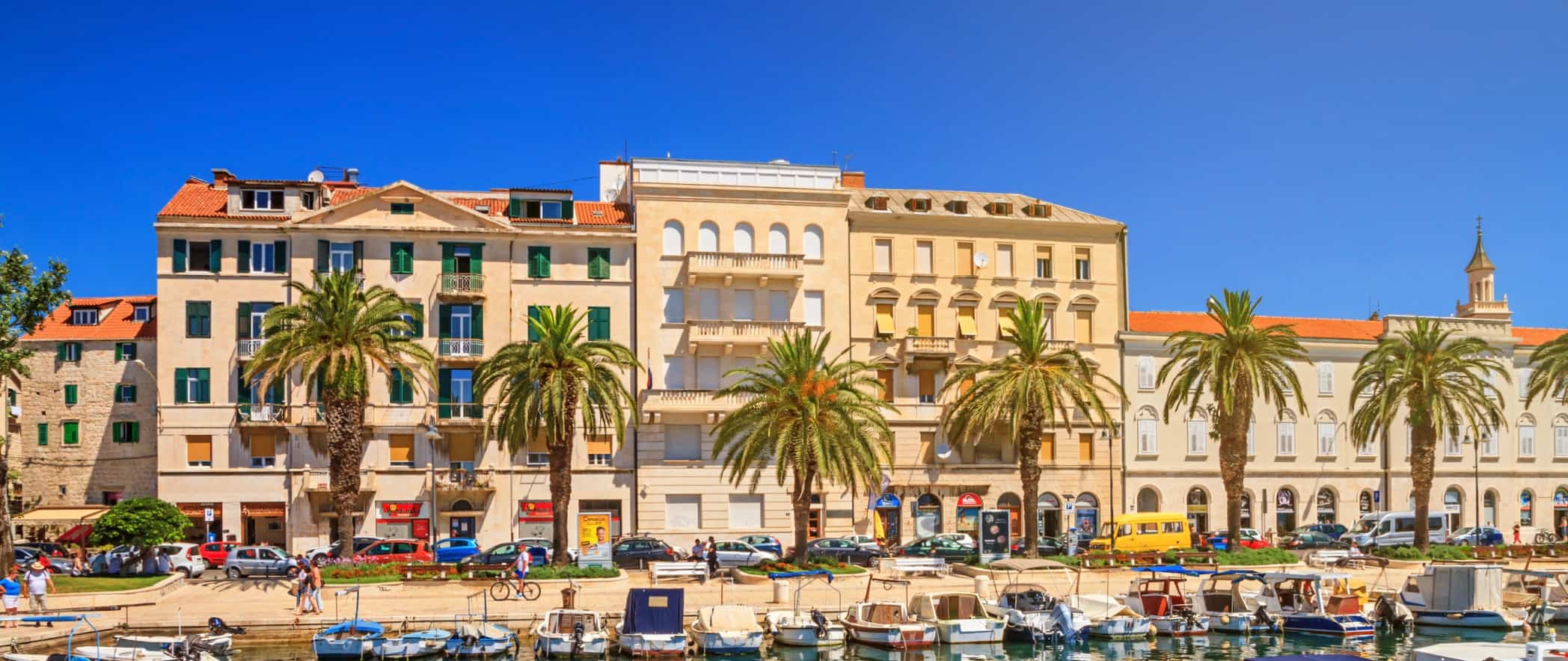
Accommodation
- Hostel dorms – 17 EUR per night
- Hostel private rooms – 45-80 EUR per night
- Budget hotels – 45-75 EUR per night
- Airbnb apartments – 40-50 EUR per night
- Sit-down restaurants – 18-35 EUR
- Casual take-out places – 8-15 EUR
- Fast food (think McDonald’s) – 7 EUR
- Beer – 4 EUR
- Cappuccino/latte – 2 EUR
- Bottled water – 1.75 EUR
- Groceries for a week – 30-45 EUR
Split Suggested Budgets
Backpacker – 40 eur per day.
If you are backpacking, this budget covers staying in a hostel dorm, cooking all of your meals, limiting your drinking, doing free activities like hiking and walking tours, and using public transportation to get around. You’ll need to budget more if you’re visiting in the summer or if you plan on drinking.
Midrange – 110 EUR Per Day
On a mid-range budget, you can stay in a private Airbnb or private hostel room. You’ll be able to eat out for most of your meals, enjoy a few drinks, visit some islands, take the occasional taxi, and visit more museums and attractions.
Upscale – 210 EUR Per Day
On a “luxury” budget, you can stay in a hotel, rent a car to get around, do private guided tours, eat and drink as much as you’d like, and visit as many museums and attractions as you want. This is just the ground floor for luxury, though.
Split Travel Guide: Money-Saving Tips
Split is one of the most expensive cities in Croatia, especially during the peak summer months. I won’t sugarcoat it: it’s going to be really hard to save money here then. If you’re on a tight budget, it’s best to come during the shoulder season when accommodation costs come back into the realm of reality. Here are some ways to save money regardless of when you visit though:
Take a free walking tour – A free walking tour is the best budget-friendly way to see the main highlights and get a feel for the city on arrival. Just be sure to tip your guide at the end!
Get a SplitCard – Get free entry to museums (or a serious discount) when you present your SplitCard. Free entry includes the Split City Museum, the Ethnographic Museum, and the Natural History Museum, among many other places. Plus, it includes free use of public transportation. Best of all, the SplitCard is free. You just have to pick one up at any Tourist Information Center in town.
Walk everywhere – Split may be Croatia’s second-largest city, but don’t be fooled by superlatives. It’s not that big. You can save some money by walking to most sites. Skip the public transportation if you’re on a tight budget.
Redeem hotel points – When you sign up for hotel credit cards, you can use those points to pay for accommodation when you travel. Most cards come with at least 1-2 nights free, which can dramatically lower your costs. Here’s a post that will help you understand the basics . You can start earning points today and have plenty for your trip.
Bring a reusable water bottle The tap water in Split is safe to drink, so bring a reusable water bottle to save money and reduce your reliance on single-use plastic. LifeStraw makes a portable filter that will keep your water clean and safe.
Get a transit pass – If you’re planning to spend time traveling outside the main city, a transit pass can help you save over individual rides. A 24-hour pass starts at 4 EUR and a 72-hour pass starts at 10 EUR.
Travel during shoulder season – Split really calms down during the low season, also known as winter. Prices drop too. If you want slightly warm weather and cheap prices, aim to visit during shoulder season (April-May; September-October). If you’re looking for a more affordable trip, plan according to the season.
Cook your own food – If you’re on a tight budget, stay in a hostel or Airbnb that has a kitchen. That way you can buy groceries and cook your own meals. It won’t be glamorous, but it will be significantly cheaper than eating out all the time.
Stay with a local – The best way to cut accommodation costs in Split is to stay with a local via Couchsurfing . You’ll not only get a free place to stay but also connect with a local who can share their insider tips and advice with you.
How to Get Around in Split
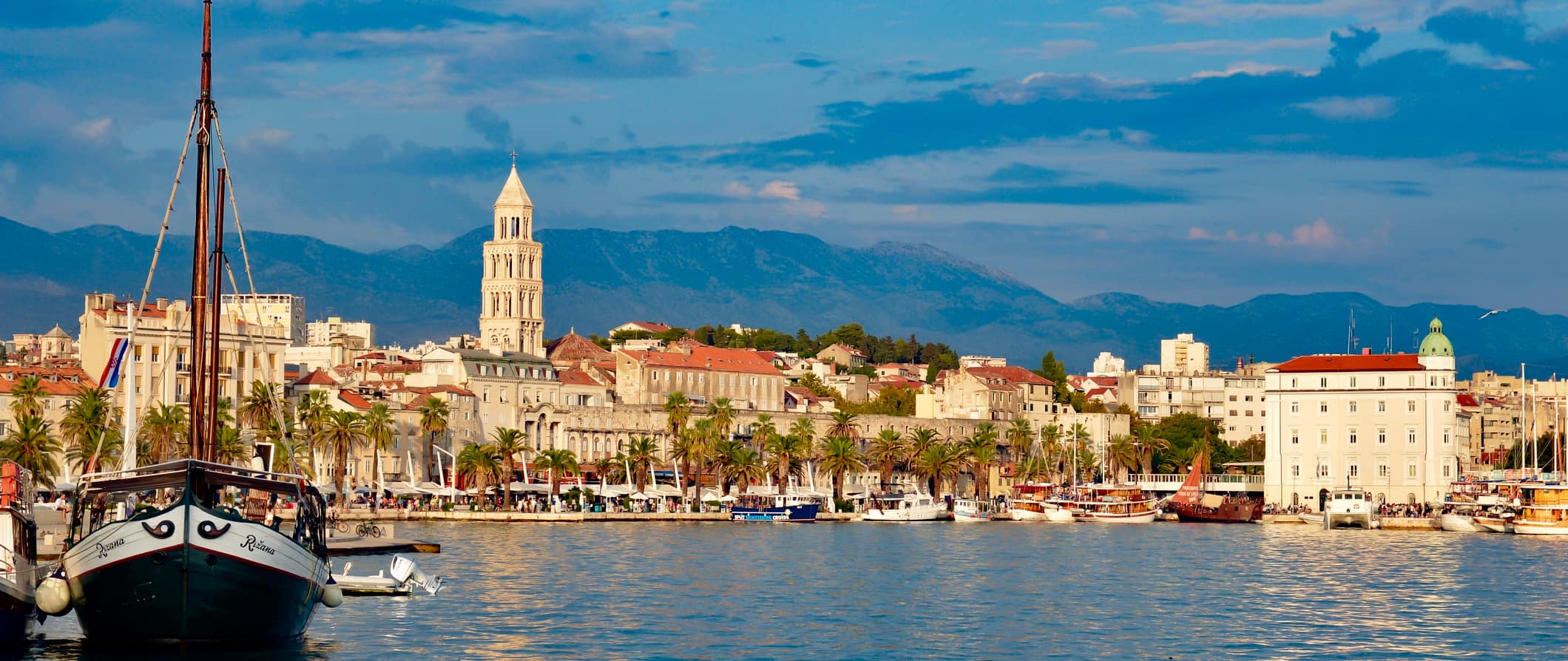
Public transportation – Strolling around Split is easy. But if you need to go further than your feet will allow, there are a lot of bus lines. Numbers 1 to 18 and 21 and 22 run from 5am-11 pm, and then three different night buses take over. Prices start at 1.50 EUR for a ride.
Taxis – Taxis start at 2 EUR and go up by 1.05 EUR per kilometer. This can add up fast, so skip them if you can!
Bicycle – Split has a bike-sharing program called NextBike. Download the NextBike app and get pedaling. Prices start at 0.66 EUR for a 30-minute ride and 1.33 EUR for an ebike.
Car rental – Car rentals can be found for around 15 EUR per day for a multi-day rental. However, unless you’re leaving the city to do some day trips, you won’t need a car. An international driving permit (IDP) is required before you can rent a car (it’s usually not enforced, but it’s better to be safe than sorry). For the best car rental prices, use Discover Cars .
When to Go to Split
Split doesn’t attract the army of tourists that march through Dubrovnik, but summertime can still experience a miasma of tourists here. The city is more lively during this time, with average daily highs around 31°C (88°F). This is the driest time of year, but the city still gets rain during a few days, so bring an umbrella.
Personally, I think September and October offer the best compromise: there are fewer tourists and the weather is still warm, usually hovering between 20-25°C (68-77°F). Most places are still operating at their usual capacity, but you won’t have to deal with the bigger crowds that come with summer. There is more rain during these months and temperatures also cool off at night, dropping down to 13-17°C (55-62°F). You’ll want to pack layers to keep you warm and dry.
Temperatures drop a lot in winter, dipping below 11°C (52°F) for the high, until they go back up again starting in April. Crowds are virtually gone, and prices drop a little too. Some places have reduced hours during the winter, so be sure to plan ahead if you visit during this time. It’s also the wettest time of year with 7-9 days of rain every month. If you plan to visit during this time, make sure to bring warm clothes and rain gear.
Split Travel Guide: The Best Booking Resources
These are my favorite companies to use when I travel. They consistently have the best deals, offer world-class customer service and great value, and overall, are better than their competitors. They are the companies I use the most and are always the starting point in my search for travel deals.
- Skyscanner – Skyscanner is my favorite flight search engine. They search small websites and budget airlines that larger search sites tend to miss. They are hands down the number one place to start.
- Hostelworld – This is the best hostel accommodation site out there with the largest inventory, best search interface, and widest availability.
- Booking.com – The best all around booking site that constantly provides the cheapest and lowest rates. They have the widest selection of budget accommodation. In all my tests, they’ve always had the cheapest rates out of all the booking websites.
- Get Your Guide – Get Your Guide is a huge online marketplace for tours and excursions. They have tons of tour options available in cities all around the world, including everything from cooking classes, walking tours, street art lessons, and more!
- SafetyWing – Safety Wing offers convenient and affordable plans tailored to digital nomads and long-term travelers. They have cheap monthly plans, great customer service, and an easy-to-use claims process that makes it perfect for those on the road.
- LifeStraw – My go-to company for reusable water bottles with built-in filters so you can ensure your drinking water is always clean and safe.
- Unbound Merino – They make lightweight, durable, easy-to-clean travel clothing.
- Top Travel Credit Cards – Points are the best way to cut down travel expenses. Here’s my favorite point earning credit cards so you can get free travel!
- BlaBlaCar – BlaBlaCar is a ridesharing website that lets you share rides with vetted local drivers by pitching in for gas. You simply request a seat, they approve, and off you go! It’s a cheaper and more interesting way to travel than by bus or train!
GO DEEPER: Nomadic Matt’s In-Depth Budget Guide to Europe!

There’s a lot of free information online but do you want to spend days searching for information? Prob not! That’s why guidebooks exist.
While I have a lot of free tips on Europe, I also wrote an entire book that goes into great detail on everything you need to plan a trip here on a budget! You’ll get suggested itineraries, budgets, even more ways to save money, my favorite restaurants, prices, practical information (i.e. phone numbers, websites, prices, safety advice, etc etc), and cultural tips.
I’ll give the insider view of Europe that I got from years of traveling and living here! The downloadable guide can be used on your Kindle, iPad, phone, or computer so you can have it with you when you go. Click here to learn more about my book on Europe!
Split Travel Guide: Related Articles
Want more tips for your trip? Check out all the articles I’ve written on Split travel and continue planning your trip:
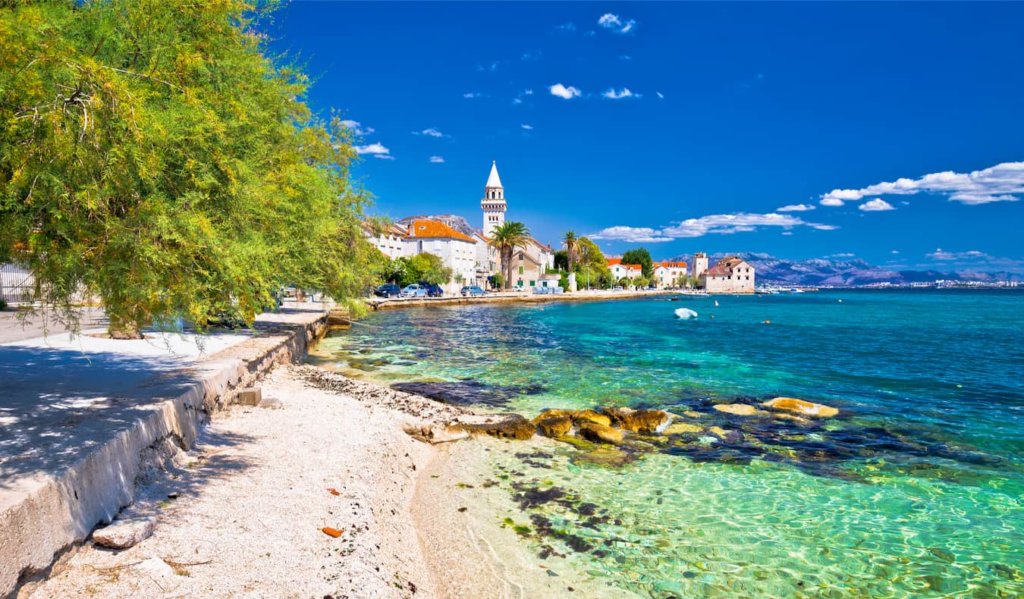
The 4 Best Hostels in Split, Croatia
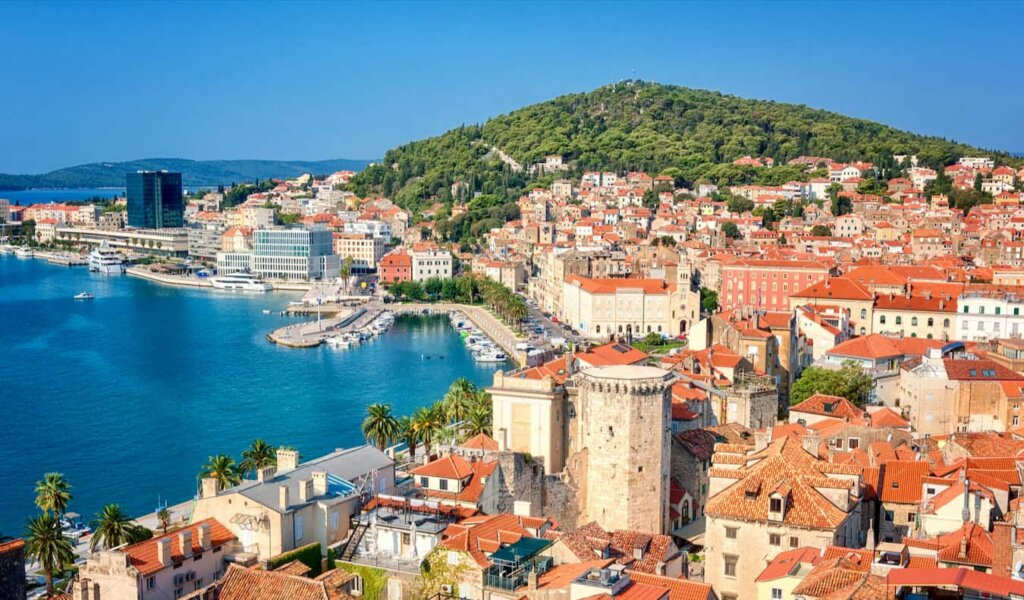
The Perfect 7-Day Croatia Itinerary
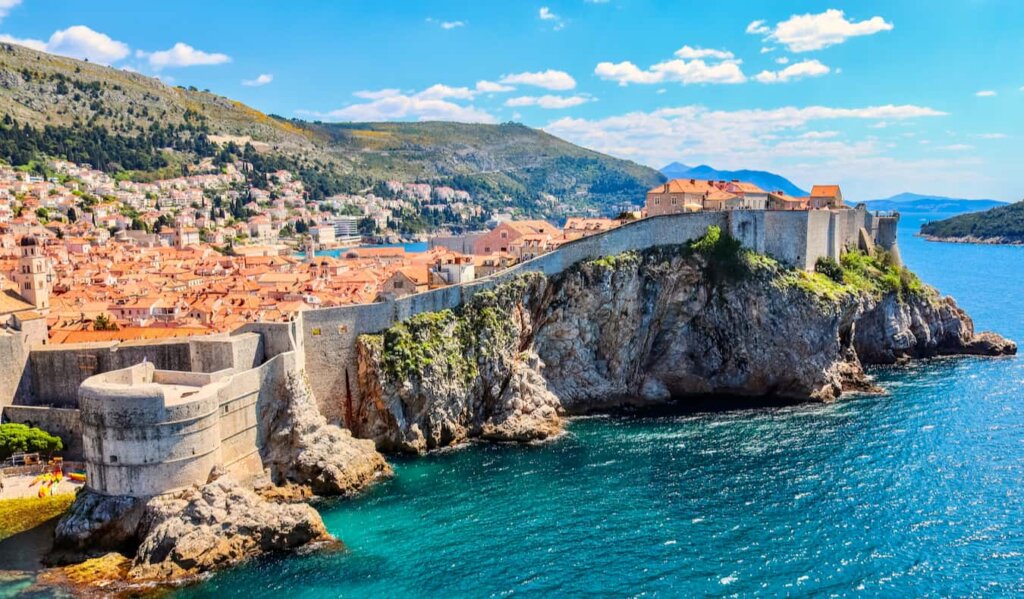
The 17 Best Things To Do in Croatia
Get your free travel starter kit.
Enter your email and get planning cheatsheets including a step by step checklist, packing list, tips cheat sheet, and more so you can plan like a pro!

- Where To Stay
- Transportation
- Booking Resources
- Related Blogs

Split Travel Guide – 55 Top Tips for First Time Visitors

Split is the second largest city in Croatia and a hub for exploring the beautiful Dalmatian Coast and islands. There’s plenty of amazing national parks, beaches and coves nearby, but a trip wouldn’t be complete without checking out everything the city has to offer, and our Split travel guide will help you do just that! The pretty coastal city makes a great weekend city break destination or an essential stop-off point to any Croatia road trip.
After visiting Split many times and exploring everything it has to offer, we’ve assembled a list of top Split visitors’ tips to help first timers plan the best holiday ever. We’ve included a Split travel guide, featuring eating out tips, nightlife suggestions, getting around and much more!
Things to know before you arrive in Split
1. Book an apartment over a hotel. Split city centre is compact and there are very few hotels, meaning that the hotels that do exist can be quite expensive. An apartment will be in a more central location and you’ll have a larger living space. They’re surprisingly good value!
2. Decide whether you want to stay in the old town centre, or slightly out of town along the coastline. There’s more going on in the centre, but you don’t have the relaxing beaches and tranquillity of nearby resorts. View Split old town on a map for reference to the centre.

3. We recommend staying in Split for around 3 or 4 days and combining your trip with the island of Brac, Hvar or Vis if you want a longer holiday.
4. Many nationalities don’t need a visa for visiting Croatia and you can stay up to 90 days without one. These countries include but aren’t limited to all EU countries, UK, USA, Australia, Canada, and New Zealand. Check your local government website before departure to see if you need a visa to enter Croatia.
5. Pre-book tours and island ferries in advance of arrival. It’s usually cheaper and you’ll save time when you’re there. Check out tours on Viator here and book ferries with Jadrolinija, the official ferry company here .

6. The best times to visit Split are in June and September. July and August are very hot but often bring crowds of tourists and higher prices. April and May are also good, however expect lower temperatures. Travelling outside of these months, temperatures can be cool, however it’s still a nice place to visit whatever the weather!
Getting to/from Split Airport
7. Split Airport is roughly 24km away from the city centre, or a half an hour drive. One of the cheapest and easiest ways to get from the airport terminal to the city is using the official airport shuttle service. Tickets cost 30 Kuna (around 4 Euros) per person for the one-way trip and it’ll drop you off at the marina bus station in the city centre. The journey takes around 35 minutes and buses leave roughly 30 minutes after a flight has landed.
8. If you’re travelling in a group or have lots of luggage, taking an Uber directly to your hotel or apartment can be both cost effective and quick. A one-way trip will cost you around 240 Kuna (30 euros).
9. Avoid the on-airport official taxi’s in favour of Uber. They’re more expensive!
Split sightseeing tips
10. Start your first day with a short walking tour of Split old town centre. It’s a great way to introduce yourself to the city and learn about its past and present.
11. Make Diocletian’s Palace a must-see on your itinerary. This ancient palace was a film set in multiple Game of Thrones scenes and is a work of art! Combine your trip to the palace with a climb to the cathedral bell-tower for some amazing views of the city.

12. Exploring the marina and coastline is best done by bike. Rent a cycle from a tourist agent by the marina or at a bike stand positioned throughout Split. Cycle all the way to the secluded Kasjuni Beach to the south-west of the old town.
13. Book tours in advance of arrival. You can compare the options that you like the most and it’s likely you’re visiting for a short time so you don’t want to miss out. We recommend trips to the Blue Caves of Vis, Krka National Park and the enchanting town of Mostar in Bosnia. View bookable in advance Split tours and excursions on Viator here .
14. Challenge yourself to hike to the top of Marjana Park viewpoint for the best views of the whole city!

15. Split old town is one of the oldest architectural gems in Europe. Wandering the narrow streets, getting lost and marvelling at buildings is an attraction it itself. Even better with an ice cream in hand!
16. The long promenade by the marina is the perfect place to wander on an evening before dinner. The sun sets on the horizon as the boats come in and it’s a beautiful sight to see. Check it out for yourself one evening.

17. If you’re interested in fine arts and the history of Split or just fancy a cool afternoon indoors out of the hot sun, there are some excellent galleries and museums. We recommend Split Archaeological Museum, Split Live Museum and Meštrović Gallery.
18. Consider renting a boat at Split marina and exploring the coastline with your friends. It was one of the most fun and adventurous things we did! For a small motor boat you don’t need a licence.

19. Split is a great city for shopping, you’ll find high street stores such as Zara and Mango, perfect for last minute holiday clothes, and market stalls throughout the old town. If you want a full afternoon shopping trip, check out “Mall of Split”, which is located just outside of the town centre.
20. One activity that many people overlook is a guided tour of the mighty Poljud Football Stadium, or even attending a football match if you’re visiting during a home game. A great day out for football fans and groups of friends.
Split Transport/getting around tips
21. If you’re staying near the old town, you can reach most attractions within a short walk, however if you want to explore nearby beaches or your apartment is located outside of Split, the local bus network is a great way to get around. We recommend using Google Maps’ Directions to determine which bus you should use. When boarding, simply tell the driver your destination and he’ll charge you appropriately.
22. Taxi’s can be a little expensive, so use the newly introduced Uber service instead. A 15-minute journey costs around 5 euros.
23. If you want freedom to get around and explore lots of nearby places, renting a car can be an affordable option. Check out our Croatia car hire guide here for tips on the best companies to use in Split.

24. If you’re looking to combine your trip to split with another Croatian city such as Zadar, Dubrovnik or Trogir, we recommend getting between cities using local coach companies. You can compare and book tickets through GetByBus here . Buses are air conditioned, comfortable and a much better way of getting around compared to the poor local train system.
25. If you have a departure flight or bus ride later on in the day, consider leaving your luggage at the bus station luggage facilities or a travel agent that offers the service. It’ll save you the hassle of carrying around bags all day!
Saving money in Split / spending tips
26. Choose a central apartment over a hotel and cook some of your own meals. The supermarkets are cheap and most apartments we’ve stayed in have always been well equipped. We recommend visiting a ‘Spar’ or ‘Tommy Maximart’ supermarket to stock up on your first day.

27. Croatia is a cash heavy country and many places don’t accept card payment, even the accommodation! Make sure you always have cash on hand and withdraw money at an ATM with a no fee card (such as Revolut or Monzo) for the best exchange rate.
28. The local currency is Croatian Kuna. Even though a lot of attractions, restaurants and bars sometimes advertise in Euros, they very rarely accept Euros and you’re best withdrawing Kuna only.
29. Always decline the conversion rate that the ATM offers you in favour of letting your bank work it out. You’ll get a much better rate this way. Simply select ‘no/decline’ when you get the option on the ATM.
30. Take advantage of free Split attractions. The city walls, marina, beach, museums and historic sites are all free (with the exception of a few).

31. Although everything is within walking distance in the city centre, Uber can be a cheap way of getting around. Journeys of 15-minutes cost as little as 5 euros.
32. Eat-out on a budget by stopping at pizza-by-the-slice corner cafes and bakeries. They’re super cheap! TripAdvisor’s ‘Cheap Eats in Split’ list is a good place to find affordable restaurants.
33. Avoid restaurants in the heart of Split old town centre (within the four walls) and marina promenade. Whilst there are some nice places, they’re generally more expensive. The streets leading to Bacvice Beach are a good place for cheaper but excellent quality meals.
Split accommodation/hotels tips
34. Are you visiting Split on a solo trip or want to stay somewhere cheap and fun? Check out Croparadise hostel group . They have various hostels in the centre of town that are affordable and have a great social atmosphere.
35. Private apartment rentals are much cheaper than hotels, plus you have a lot more space and they’re usually better-located! We recommend browsing for your apartment on Booking.com here . They have the largest collection of private rental listings for the city.
36. Want to book your holiday now but don’t have the cash just yet? Use Booking.com’s ‘Buy now pay later: Free cancellation’ feature.
37. Always check the reviews for hotels and apartments on TripAdvisor before booking. Aim for a 4+ TripAdvisor rating.

38. Stay in or around Split’s old town centre ( view on map ) to be well-located for all the major attractions, nightlife and restaurants. You’re also a short walk from Bacvice Beach.
39. If you want nice beaches and a more relaxing resort to base yourself, stay near Trstenik Beach ( view on map ). It’s a 10-minute drive from Split city centre.
Split eating out tips
40. Always check the TripAdvisor reviews of a restaurant before eating there. Either research a cool place to eat in advance or go for a walk and if you like the look of a restaurant, do a quick Google search for reviews before asking for a table. It’ll greatly increase your chances of having a great dining experience over a poor one!
41. Reservations aren’t usually needed but if you have a particular restaurant in mind that you really want to visit, we recommend reserving a table just in case.

42. Don’t forget to check out the local bakeries. They’re on almost every corner in the old town and some are open 24 hours. They’re a great place for breakfast or lunch on the go!
43. Being a coastal city, the seafood in Split is excellent and freshly prepared. Sample delicious fillets of sea bass, meaty lobster or big juicy prawns. Seafood platters to share can be quite good value.
44. There’s a distinct Italian influence in Split’s cuisine options and you’ll find authentic pasta’s, pizza’s and breads in many restaurants.

45. Stop by Split Old Town City Market ( view on map ) for cheap and fresh ingredients to cook your own meals or some tasty fruits and snacks.
46. Tap water is safe to drink in restaurants and at your apartment/hotel. Fill up your water bottle and save money.
47. Croatian wine is world renowned, tasty and cheap! Order a local variety from bars and restaurants to judge it yourself, or enjoy a full afternoon wine tasting tour in one of the local nearby vineyards. We recommend Putalj Winery .
Split nightlife tips
48. Our Split travel guide wouldn’t be complete without some nightlife recommendations! Being one of the nightlife capital of Croatia, summer nights are filled with busy bars, drinking in open-air clubs and partying by the beach. Visit Split during the months of July and August for the best nightlife.
49. Consider joining a bar crawl. They operate every night, are a great way to meet people and are good value. We recommend Tower Pub Crawl Split . The tour will take you to a few bars, include an ‘all you can drink hour’ and ends in a club.
50. Visit the old-town for relaxed wine bars, cocktail bars and trendy places to drink with an atmosphere. It’s a relaxed place to start your evening.
51. Visit the Bacvice Beach area for a loud and electric nightlife with plenty of late-night bars and a beach club called Tropic, which has great views of the ocean as you dance the night away.

52. Check out Inbox open-air club ( view on map ) for a vibrant atmosphere and the latest EDM music. Open during the summer months.
53. Fancy a more chilled evening out? Visit the cosy Kino Mediteran outdoor cinema on Bacvice Beach, which hosts movies every night throughout the summer.
54. Enjoy the vibrant atmosphere of the old town and promenade by sitting by one of the numerous pop-up cocktail bars. They’re cheap and a fun way to spend your evening on those warm summer nights.
Visiting Ultra Europe
55. Ultra Europe is a world-famous EDM music festival that takes places in Split in July every year. Party-goers rave the event location in Mladezi Park for a full weekend, before continuing the party on the Dalmatian Islands.
Visiting Split during Ultra or like the sound of it? Check out our complete guide to Ultra Europe here .

That concludes our Split travel guide and giant list of Split travel tips for first timers to the city! Even if you’ve been to Split before, there may be some handy pointers in our list so be sure to try out our suggestions and let us know your thoughts!
If you’re also planning on visiting other parts of Croatia, browse our other travel guides and articles below to get holiday-ready with us.
Our ultimate guide to Ultra Europe – Split
Which part of Croatia should I visit?
The best family holiday resorts in Croatia
Dubrovnik – 3-day itinerary
THANKS FOR READING! IF YOU LIKED OUR ARTICLE, SHARE WITH YOUR FRIENDS OR PRINT IT OUT FOR YOUR TRIP. FEEL FREE TO CONTACT US WITH ANY QUESTIONS YOU HAVE…
Leave a comment cancel reply.
Cookies on GOV.UK
We use some essential cookies to make this website work.
We’d like to set additional cookies to understand how you use GOV.UK, remember your settings and improve government services.
We also use cookies set by other sites to help us deliver content from their services.
You have accepted additional cookies. You can change your cookie settings at any time.
You have rejected additional cookies. You can change your cookie settings at any time.
Entry requirements
This information is for people travelling on a full ‘British citizen’ passport from the UK. It is based on the UK government’s understanding of the current rules for the most common types of travel.
The authorities in Croatia set and enforce entry rules. If you’re not sure how these requirements apply to you, contact the Croatian Embassy in the UK .
COVID-19 rules
There are no COVID-19 testing or vaccination requirements for travellers entering Croatia.
Passport validity requirements
Croatia follows Schengen area rules . Your passport must:
- have a ‘date of issue’ less than 10 years before the date you arrive – if you renewed your passport before 1 October 2018, it may have a date of issue that is more than 10 years ago
- have an ‘expiry date’ at least 3 months after the day you plan to leave the Schengen area
Check with your travel provider that your passport and other travel documents meet requirements. Renew your passport if you need to.
You will be denied entry if you do not have a valid travel document or try to use a passport that has been lost or stolen.
Visa requirements
You can travel without a visa to the Schengen area , which includes Croatia, for up to 90 days in any 180-day period. This applies if you travel:
- as a tourist
- to visit family or friends
- to attend business meetings, cultural or sports events
- for short-term studies or training
The requirements for working in Croatia are different.
If you’re travelling to other Schengen countries make sure your whole visit is within the 90-day visa-free limit. Visits to Schengen countries in the 180 days before you travel count towards your 90 days. If you overstay the 90-day visa-free limit, you may be banned from entering Schengen countries for up to 3 years.
Make sure you get your passport stamped on entry and exit (until November 2024).
If you’re a visitor, border guards will look at your entry and exit stamps to check you have not overstayed the 90-day visa-free limit for the Schengen area.
If your passport is missing a stamp, show evidence of when and where you entered or left the Schengen area (for example, boarding passes or tickets) and ask the border guards to add the date and location in your passport.
At Croatian border control, you may also need to:
- show proof of your accommodation, for example, a hotel booking confirmation or proof of address for a second home
- show proof of your travel insurance
- show a return or onward ticket
- prove that you have enough money for your stay – the amount varies depending on your accommodation
Staying longer than 90 days in a 180-day period
To stay longer, you must meet the Croatian government’s entry requirements. Check which type of visa or work permit you need with the Croatian Embassy in the UK . See the Croatian Ministry of the Interior’s guidance on work permits .
If you’re in Croatia with a residence permit or long-stay visa, this does not count towards your 90-day visa-free limit.
Read about passport stamping if you live in Croatia .
New Schengen entry requirements (planned for November 2024 onwards)
From November 2024, the new EU Entry/Exit System (EES) will start for all non-EU nationals, including British nationals, travelling in or out of the Schengen area. The Schengen area is made up of 29 European countries, 25 of which are EU Member States. The EES is a digital border system which registers non-EU visitors travelling into the Schengen area instead of stamping their passports.
You will need to have your fingerprints and your photo taken when entering the Schengen area. If you enter the Schengen area through Dover, Eurotunnel at Folkestone or St Pancras International, your fingerprints and photo will be taken before you leave the UK. You will also need to provide either your fingerprint or photo on exit.
You may experience longer queues at borders when the new system starts.
Read more information on the EU Entry/Exit System .
Croatia-Slovenia border crossings
There are checks at Slovenia’s borders with Croatia. If you are travelling from Croatia to Slovenia, check travel advice for Slovenia .
Vaccine requirements
For details about medical entry requirements and recommended vaccinations, see TravelHealthPro’s Croatia guide .
Registering with the police
Your accommodation provider must register your arrival in Croatia with the police within 48 hours. Your hotel will normally register you. If your accommodation provider is unable to do this for you, fill in and print form obrazac 16a (PDF) . You must hand in the completed form at a police station. Alternatively, you should go to the nearest police station with the owner of the accommodation to register your address in Croatia.
Customs rules
There are strict rules about goods that can be brought into and taken out of Croatia . You must declare anything that may be prohibited or subject to tax or duty.
Taking food into Croatia
You cannot take meat, milk or products containing them into EU countries . There are some exceptions such as powdered baby milk, baby food and special foods or pet feed required for medical reasons.
Taking money into Croatia
Declare cash or travellers cheques if the value is 10,000 euros or more . You will get a certified declaration to show you brought it in with you. If you do not, your money could be seized when you leave.
Related content
Is this page useful.
- Yes this page is useful
- No this page is not useful
Help us improve GOV.UK
Don’t include personal or financial information like your National Insurance number or credit card details.
To help us improve GOV.UK, we’d like to know more about your visit today. Please fill in this survey (opens in a new tab) .
Split Travel Guide (Croatia): Best Sights, Beaches & Tips
Love at first sight! The sparks were flying between Split and us – so much so that we have been there three times now. What makes Split so special? The city is unlike any other in Croatia. A modern coastal metropolis surrounded by ancient walls – this is how Split can be described.
During the day you encounter centuries old Roman masterpieces and never cease to be amazed. Then in the evenings you sip cocktails in the city’s coolest bars. Split is pulsing, lively, young, and dynamic. And at the same time Split enchants you with its historical charm.
Are you planning a trip to Split? Wonderful, then let us tell you this: You will love it! In this travel guide we let you in on our personal travel tips for the most beautiful sights in Split. On top of this we provide you our hotel tip because we have discovered a real gem of a hotel in Split.
1. Split in Croatia: Overview of Info & Initial Travel Tips
2. hotel tip for split: a gem of a hotel , 3. split travel guide: top sights and best things to do, 4. viewpoints in split, 5. beaches in split: out tips, 6. eating and drinking in split: our culinary tips , 7. day trips around split , 8. map: overview of all sights and tips .
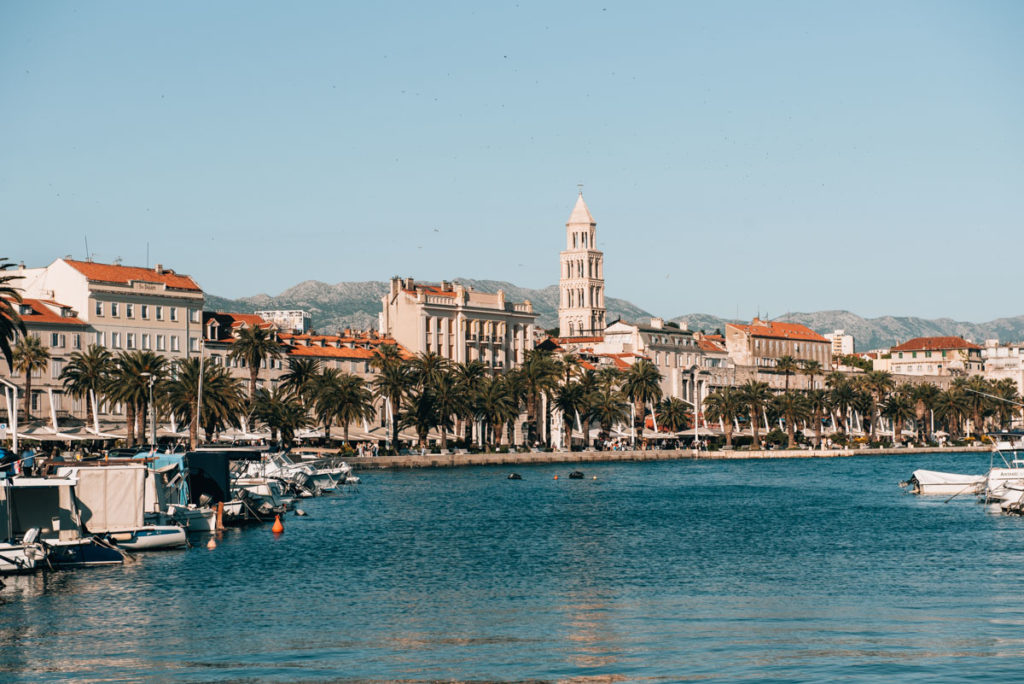
What can I expect on holiday in Split?
Taking a wander through Split is like travelling back in time. You can feel the eventful, century old history of the city on every corner. The inner city of Split is a labyrinth of alleyways that is second to none. Getting lost in it (and getting lost) is simply part of a trip to the city.
Split is an absolutely beautiful town in our eyes. We have tried to capture the special flair and the lifestyle of Split for you in a few words:
- Split’s heart = Diocletian’s Palace: As soon as you set foot in Split, you will notice: Split is different! You can find the historical centre inside the walls of ancient palace grounds, Diocletian’s Palace. Sightseeing amid Roman monuments, magnificent house facades and picturesque squares – all that and much more awaits you in Split.
- Great gastro-scene: You hardly want to believe how many young, modern restaurants, cafés and bars have opened in Split in the past years. Split is really a paradise for foodies in Dalmatia!
- Beach-hopping & day trips: There are some great beaches to be found around Split. Split is also an idea destination when you want to combine city and beaches. Also, there are great day trip destinations such as the UNESCO town of Trogir or the Krka National Park.
How many days should I plan for Split?
All the sights in the centre of Split are within walking distance. So, if you are on your feet for the whole day, then you could theoretically rush by the main highlights – emphasis on ‘theoretically’ and ‘rush’. To be honest: Split is so beautiful that it’s no fun to rush through it.
We recommend you plan to stay two to three nights in Split. Then you still have enough room to take a relaxing stroll alongside visiting the classic sights, and maybe even for a trip to the beach.
If some day trips (such as to Trogir or Krka National Park) are also on your radar, then we would plan to stay a little longer. Four to five nights would be ideal then. It’s guaranteed that you will not get bored in Split – there is so much to see and experience, we promise.
The best time to travel to Split
Our number one tip: Avoid – if somehow possible – the high season! An unbelievable amount of people travel to Split during July and August. We ourselves have also been to Split in August and found that the beaches around Split were particularly uncomfortably full. Also, the day trip destinations, such as Krka National Park, are often completely overcrowded in summer. It can also be difficult to find a place in popular restaurants in the evening.
The far better option for taking a trip to Split is to go during spring or autumn. We have been to Split twice in May and find this month to be ideal. The temperatures are pleasantly spring-like (and with a bit of luck even summery). Also, it is far less busy than in summer and the prices are more moderate.
However: the sea is still quite fresh in spring. (This in no way prevented us from plunging into the waters anyway.) If you enjoy swimming in warm water though, then it’s better to aim to take a trip to Split during September.
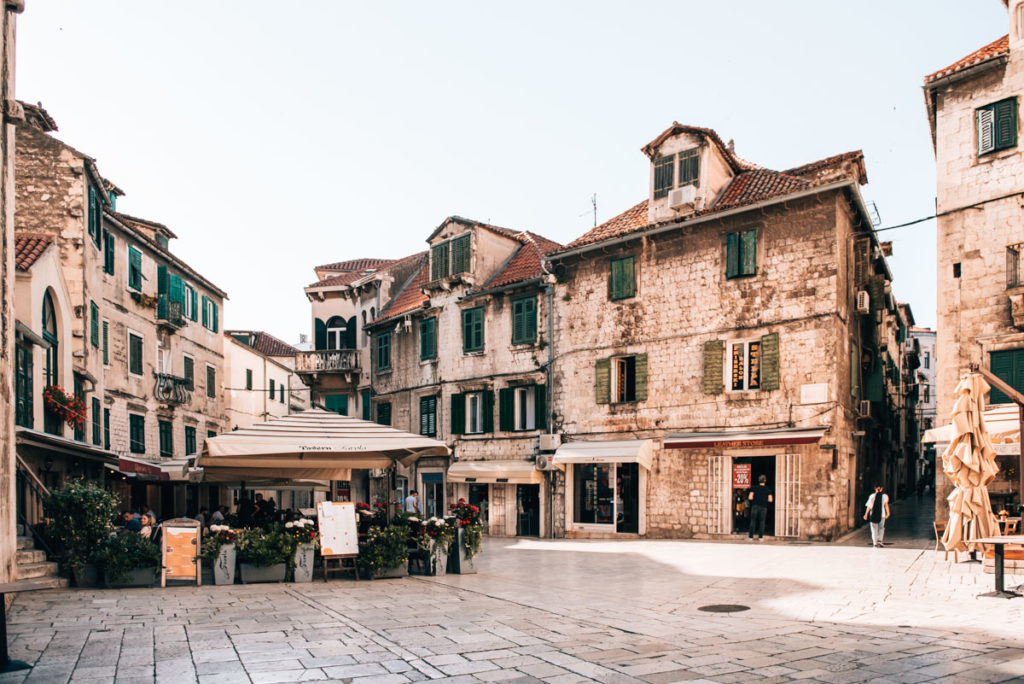
We searched long and hard to find the perfect place to stay in Split, and we dare to say: We have found it! The Heritage Hotel Fermai is a dream of a hotel. It is a historic art nouveau building, which has been revitalised and renovated with an incredible amount of feel and love for detail. The result: A boutique-hotel, that you never want to leave.
Our room on the third floor provided us not only with a great view in the direction of the cathedral, but on top of that it was so stylishly designed that we felt like we were in 7 th hotel-heaven. The design is elegant, pure, and extremely well put together. You can tell that every piece of furniture and accessory has been carefully selected. In short: An absolute feel-good atmosphere.
The last part runs like a red thread through our entire stay. Particularly noteworthy is the excellent breakfast. It was served to us (due to the pandemic) and was exquisite. Not to mention, the service staff are incredibly courteous.
The hotel location is very central. You can walk right to the centre of Diocletian’s Palace in just a few minutes. If you want to find a small negative, then okay: The hotel is located on a street. However, we didn’t notice the traffic at all and instead we were happy that we could drive right up to the hotel and park there comfortably.
Our conclusion: We aren’t lying when we say that we haven’t felt so good in a hotel for a very long time as in the Hergitage Hotel Fermai. Everything is just right here. Very clearly recommended!
You can book the hotel here: Heritage Hotel Fermai .

Diocletian’s Palace
Diocletian’s Palace is mentioned in the same breath as Split. You shouldn’t imagine one enclosed building. Rather, Diocletian’s Palace refers to the remains of a gigantic ancient building complex, which stretches through the old town of Split and now the two melt in with one another.
Diocletian’s Palace dates back to the 3 rd century. The Roman Emperor Diocletian built the palace at this time as a retirement home. The architecture of the palace has been modified and added to throughout the centuries, however the Roman influence is still unmistakable.
Dioceletian’s Palace (which is a UNESCO World Heritage Site, by the way) comprises of numerous structures. Each one is a special attraction. Therefore, we will also tell you about some of these separately:
- Cathedral of Saint Domnius: The highlight in Split with its distinctive bell tower.
- Peristyl: The central square in Diocletian’s Palace
- Vestibule: The striking foyer of the old imperial chambers
- Podrumi: The cellar vault
- Various gates such as the golden gate or the silver gate
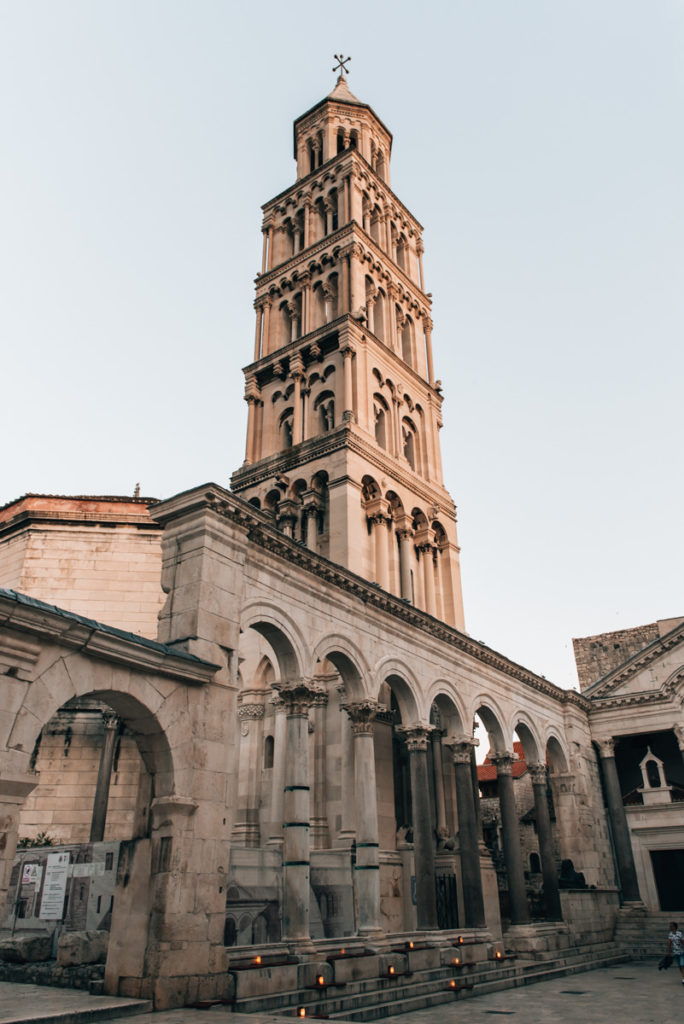
Cathedral of Saint Dominius (=THE Cathedral in Split)
The landmark of Split is the Cathedral of Saint Dominius, often just called the Split Cathedral. With its five-story tall, distinctive bell tower, the cathedral catches you eye from afar and characterises the silhouette of the city. The cathedral was once the Diocletian’s Mausoleum.
Good to know: You can visit different areas of the cathedral, which is why we find purchasing the various combo tickets can be a little confusing. There are five areas in total: The actual cathedral, the temple of Jupiter, the crypt, the treasury, and the bell tower.
In our opinion, you definitely should not leave out the bell tower. You can climb up top and enjoy the breathtaking 360-degree panorama view over Split. We reveal more information and tips about this for you in the chapter on the most beautiful viewpoints.
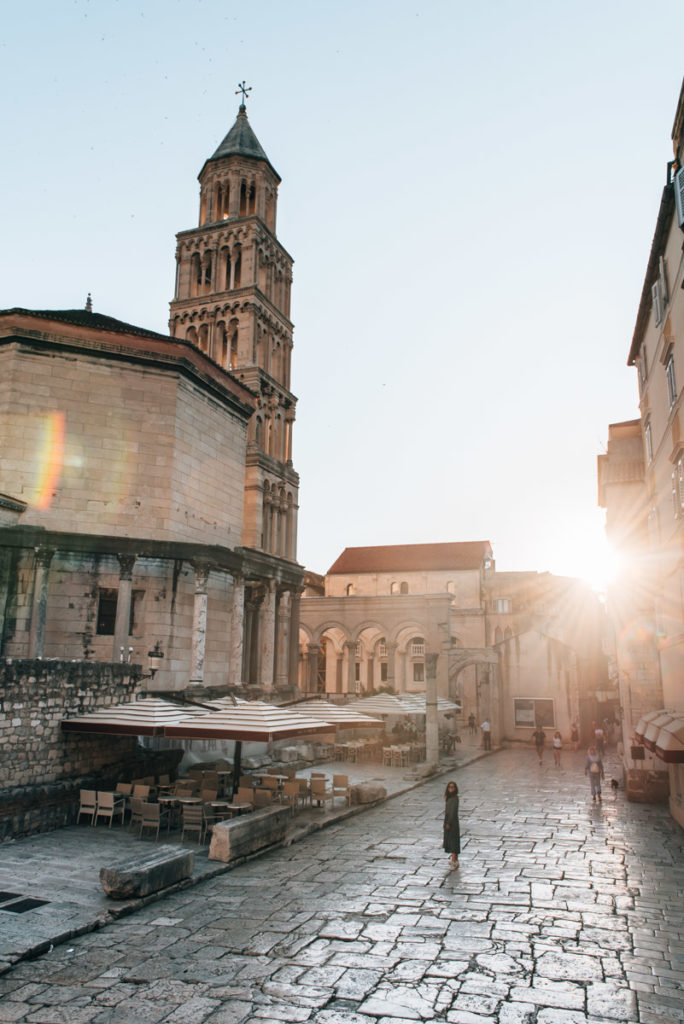
Peristyl = The central square in Diocletian’s Palace
Directly next to the cathedral, you come to the Peristyl – the most impressive and beautiful square in all of Split. With its Roman elements, this place really exudes a magical and very special flair.
We promise that you will come by here a few times during your holiday in Split. Just like the saying, all roads lead to Rome, all roads in Split lead to Peristyl. The atmosphere is also very special depending on the time of day: Very quiet in the morning, full of people during the day, and in the evening a lounge atmosphere sets in thanks to the adjoining bar.
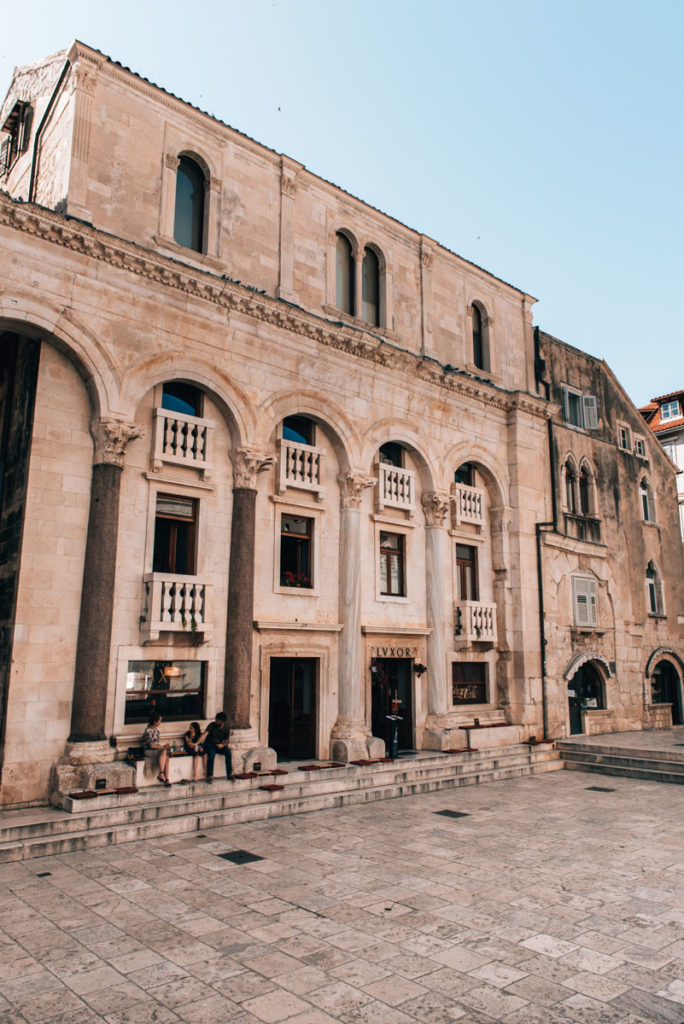
A great photo opportunity, and absolutely worth a stop off, is the vestibule. It is located just a stone’s throw away from Peristyle. This was once the foyer of the imperial chambers. With a bit of imagination, you momentarily feel transported back in time. You can just walk through here – there is no entrance fee.
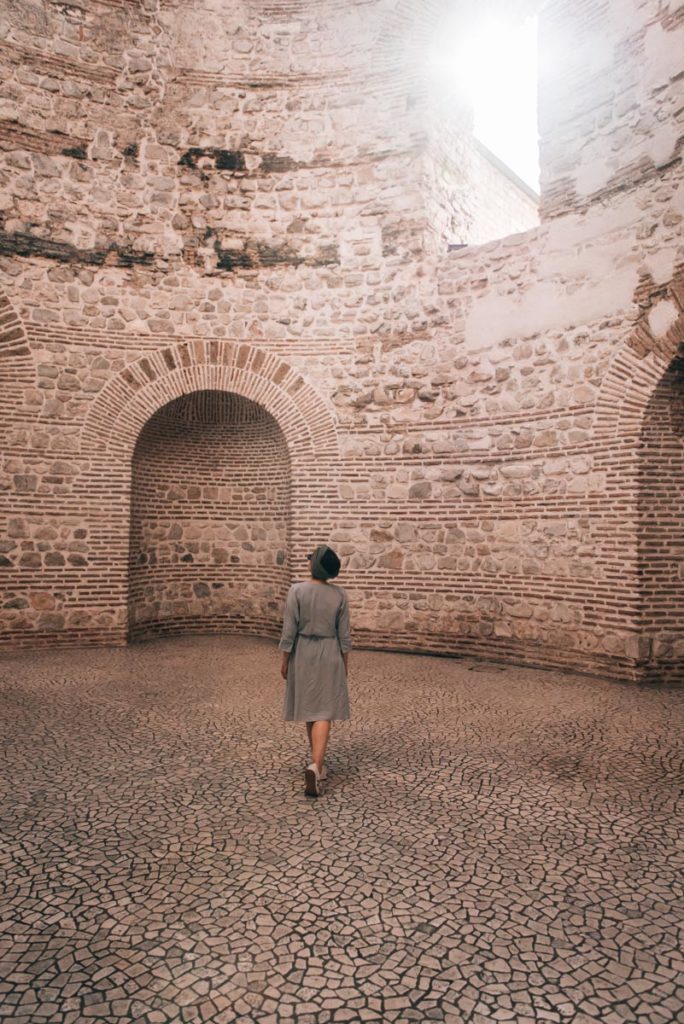
Riva waterfront
Not your typical type of sight, but the palm-lined waterfront in Split, called Riva, is still worth seeing. The life is pumping here particularly in the evening in the many bars and restaurants along the promenade. (Athough, there are guaranteed cheaper and more recommendable places for dinner in Split, but we will come to our culinary tips later).
Out on the street musicians perform their works, locals and tourists enjoy the last rays of sun with an aperol spritz and a view out over the sea. In short: Anyone wanting to soak up the relaxed Mediterranean lifestyle is in the right place at the Riva waterfront.
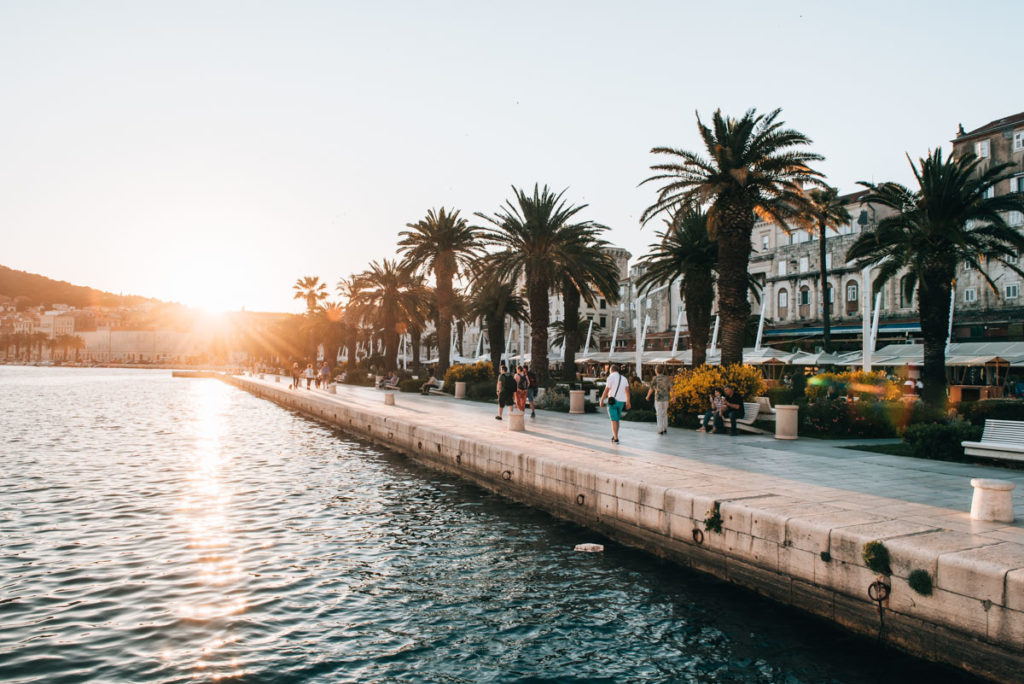
Squares worth seeing in Split
Apart from the impressive Peristyl (you can find tips about this above), there are many more squares in Split that are also well worth seeing. The most well-known (and also our favourites) are:
- Pjaca: Very atmospheric, comparatively spacious square in the middle of the old town. Officially called the ‘People’s Square’ or ‘Narodni trg’ in Croatian. There are numerous historical structures nestled here. In the evening people meet in the cafés and restaurants for an aperitif or for dinner. Our tip: Around the corner from here you can find Ela’s Ice Cream.
- Voćni trg: This picturesque square is characterised by the striking Venetian tower, which immediately catches the eye. It has its name (‘Voćni’ = fruit, so fruit square) because a fruit market once took place here.
- Republic Square: You wouldn’t expect to find such a spacious square on the edge of the labyrinth of alleyways in Split. You can find this square in the west corner of the old town right on the Riva waterfront. The Republic Square was designed based on St. Mark’s Square in Venice and is lined with arcades and neo-renaissance style facades on three sides.
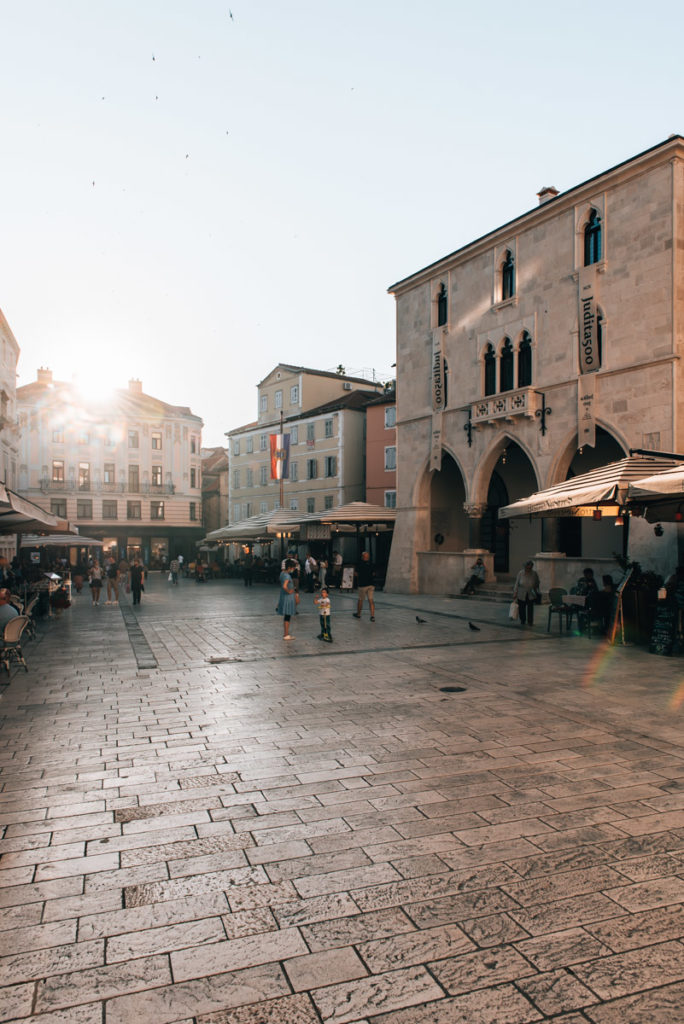
Viewing terrace on the Marjan Peninsula
If you ask the locals what their favourite place for the sunset in Split, then the answer is usually the same: Marjan Park! Marjan is a green, little developed, hilly peninsula, which is practically adjacent to the historic centre of Split. Here also happen to find some of Split’s stalls, but more about that later.
There are numerous viewpoints to be found on the Marjan Peninsula from which you can enjoy a lovely view of Split. The most well-known viewing terrace (and closest to the old town) is located just about a 15-minute walk away from the centre of Split (or cathedral).
There are a few steps, and therefore also some vertical metres, to conquer. However, the effort is definitely worth it. We have marked the exact spot on the map at the end of the travel guide. There are (in our opinion) two disadvantages: One is that you are comparatively far away from the historic old town. And the other is that you are not facing in the direction of the sunset.
If that bothers you, you can walk further up to the summit of the Marjan Peninsula. This doesn’t solve the first problem (because you are even further away from the historic centre up here), however you have a fantastic view all around.
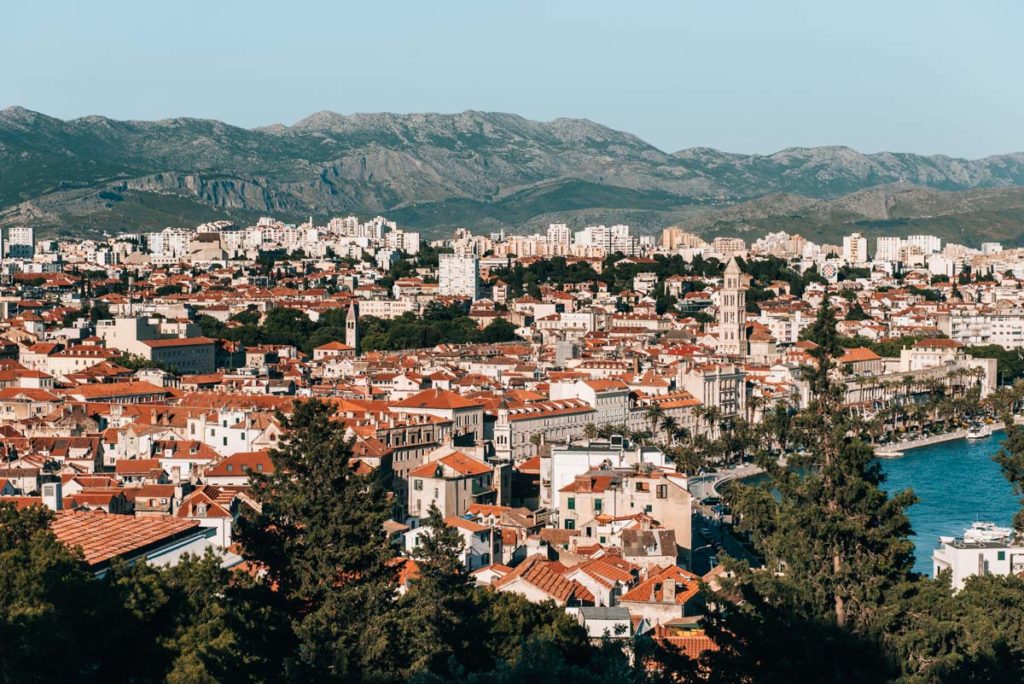
Cathedral bell tower
Probably the most impressive viewpoint in the centre of Split is found in the bell tower of the cathedral. You will usually see the striking, six-story structure several times during your holiday in Split. When you look carefully, you will spot people up there because it is possible to climb the tower.
There are around 200 steps to conquer before you are rewarded with a panoramic view in all directions. It is most beautiful before sundown when the sinking sun bathes Split in a beautiful light. (Tip: Check the opening times shortly before your visit because these vary depending on the time of year).
Entry to the bell tower is 7 euros. There are also special combo tickets which you can visit several areas of the cathedral with. You should be reasonably good on your feet because the stone steps at the beginning are rather steep. But don’t worry – the ascent is nothing that a half sporty person can’t manage.
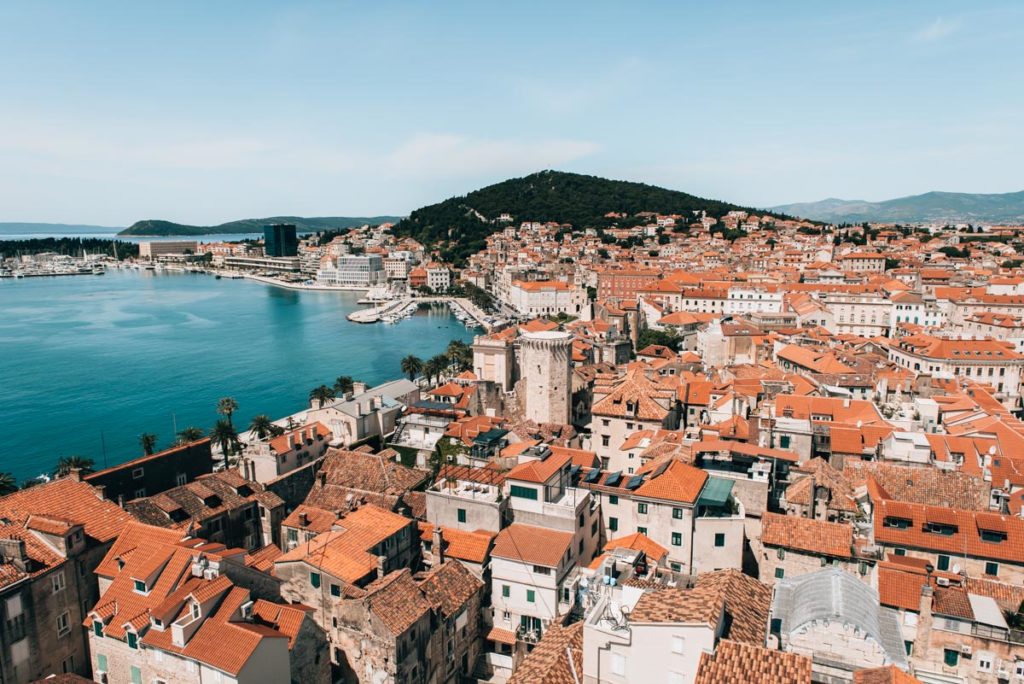
Split is no classic beach destination, but rather more of a city trip destination, thanks to its rich history. Nevertheless, those who would like to jump (or rather walk, due to the rocks) into the sea will not miss out.
There are several beaches to be found around the old town. Many of these (including the two that we show you) are located on the green, forested Marjan Peninsula. Having a car, or better yet a bicycle, is recommended because it is quite a bit of a walk.
Kasjuni Beach
Maldivian feeling in Croatia! This pebble beach immediately stands out with its snow-white stones and the azure-turquoise blue water. The setting is really breathtakingly beautiful.
According to the friendly staff at our hotel, Kasjuni Beach is a favourite amongst locals. And what should we say: We understand why! Mainly young people, but also families with children, are drawn to this beach.
Outside of the high season, you can enjoy a great afternoon at the beach here. In July and August, we would personally advise you to come in the morning because Kasjuni Beach is very popular and also referred to as ‘overcrowded’ in many reviews.
There are a few beach bars and dixi toilets, but you shouldn’t expect perfect infrastructure here. However, it is possible to rent deck chairs and beach umbrellas. The sun is pretty ruthless without the latter, especially in the afternoon.
Tips for getting there
You can reach Kasjuni Beach directly with the car. The carpark (free) can however get full fast. If you want to save the hassle of parking, then you can also get there directly on the bus. The station is located about 150 metres (uphill) away from the beach on the main road.
Alternatively, you can also walk to Kasjuni Beach from the centre of Split. You need to allow around 45 minutes for the route.

Section of beach at Bene Beach
The rocky beach called Bene is one of the most well-known beaches on the Marjan Peninsula. It’s hard to find a free place here in summer because the beach is so popular. The rock is partially artificially concreted to provide spots to lie on. All in all, we weren’t overly impressed with this beach.
Our tip: Around 100 metres east of Bene Beach are several bathing spots that are a hundred times more relaxing and less touristy. You can also find shady spots under the pine trees here and there are even showers.
Due to the rocky nature of the coast, beach footwear is recommended. A sea urchin could easily be hiding here, and you don’t want to step on it.
Bene Beach (just like the neighbouring sections of beach) is located in a car-free area on the Marjan Peninsula. It is around a 20-minute walk to Bene Beach from the closest parking area (see the map at the end of the travel guide to find the Ulica Antuna Gustava Matoša).
Therefore, many people come here by bicycle. (It is sometimes even possible to rent a bicycle at the entrance to the forest park.) Alternatively, you could also walk from the historic centre of Split. Plan around 45 minutes for this.
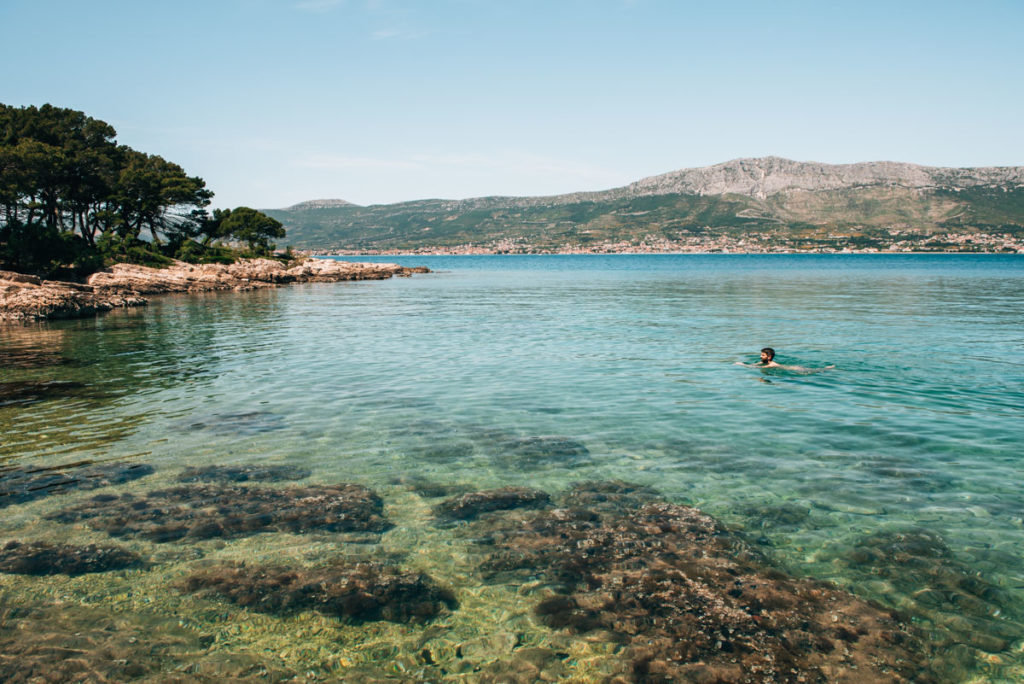
Favourite cafés in Split
D16 Coffee: This café serves superb self-roasted coffee, which can be found in the middle of a small alleyway in Diocletian’s Palace. Highly recommended for a short pit stop! KaKantun: This jewel of a café can be found in a small hidden square in Diocletian’s Palace. The ambience is very nice, especially on the tables outside. As well as the coffee, KaKantun also specialises in gin, curiously enough. 4coffee soul food: They have absolutely fantastic coffee at this tiny coffee stand on the edge of the old town – even with oat milk! Perfect for a takeaway coffee.
Restaurant tips for Split
Pandora Greenbox: Are you vegan? Then this restaurant, situated in the middle Split’s old town, is not one to miss. The menu has exclusively vegetarian dishes, most of which are even vegan. Bokeria Kitchen & Wine Bar: You will recognise this hip, popular restaurant right away from its good Buena Vista Social Club style music. They serve Mediterranean cuisine here – everything from fish to meat to (some) vegetarian dishes. Make a reservation! Kat’s Kitchen Deli: If you are ever on the Marjan Peninsula and get hungry, then we can recommend this small, lovely run deli. Here you can have breakfast and lunch including salads, bowls, tacos or changing lunch dishes. There are plenty of options for both meat lovers and vegans.
The best ice cream in Split
Ela’s Icecream: They serve great ice cream in this modern ice cream parlour. The pistachio flavour was a stunner and one of the best that we have ever had. There are also a few vegan options on offer. Gelateria Emiliana: You will know you are in the right place right away from the irresistible scent: Their waffle cones are actually made on site! You can even watch through a window. The ice cream is also very good. Highly recommend!

The most well-known coastal town close to Split is Trogir, which you can drive to from Split in a good half an hour. Trogir is a real tourist magnet, especially in summer. Nevertheless, we warmly recommend a trip to this pretty UNESCO World Heritage town.
Trogir is small and manageable. We recommend you plan around 3 to 4 hours for a visit to the old town. Of course, we want to share our personal highlights with you.
Our tips for a trip to Trogir
The best view in Trogir: You can get a beautiful view over the old town from the bell tower of the Cathedral of St. Lawrence. For a few euros entrance fee, you can climb the 47-metre-high bell tower. Once up top you have views in all directions – wonderful!
The best ice cream in Trogir: Without knowing the alternatives, let’s throw caution to the wind and claim that the best ice cream in Trogir is in the gelato bar Bella. Simply delicious!
Waterfront: A stroll along Trogir’s palm-lined waterfront is an absolute must-do. Here they have cafés lined up one after the other. At the end of the promenade, you come to a historical fortress, Kamerlengo. You can climb the walls and watch towers to observe the promenade from a bird’s eye view.
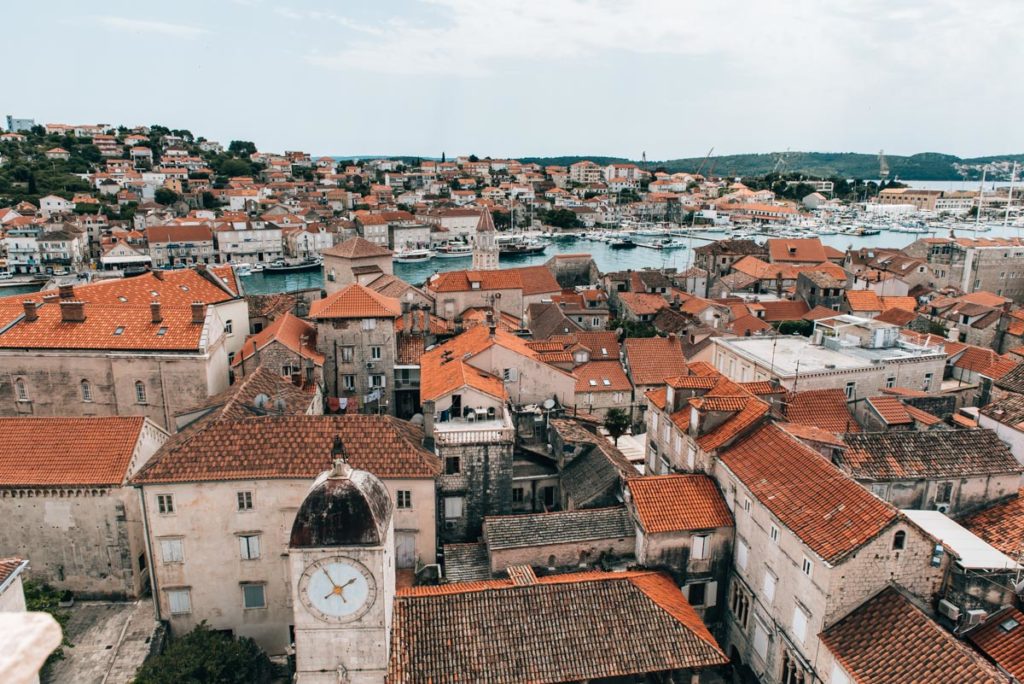
Less well-known as Trogir, but also very worth a visit, is the small town of Omiš. It is located about 25 kilometres south of Split on the coast on the way towards Makarska Riviera.
Omiš is spectacularly situated on the mouth of the Cetina River, which has carved a gorge through the massive rocks here. The mountains rise up directly behind the town. We recommend a stay of around two to three hours in Omiš.
Our tips for a day trip to Omiš
Coffee & cake: Probably the best espresso in Omiš is available at the friendly café bar, I Gemelli, which you can find right in the old town. The cakes look like small works of art – and taste delicious. It is really nice to sit outside in the small courtyard.
The best view: You definitely should not miss a visit to the Mirabella fortress (= Tvrđava Mirabela). This historical castle grounds practically border on Omiš’ old town. The ascent is rewarded by a lovely view over the town, the river, and the surrounding mountains. The stairs are particularly steep near the end. Therefore, you should be reasonably good on your feet.
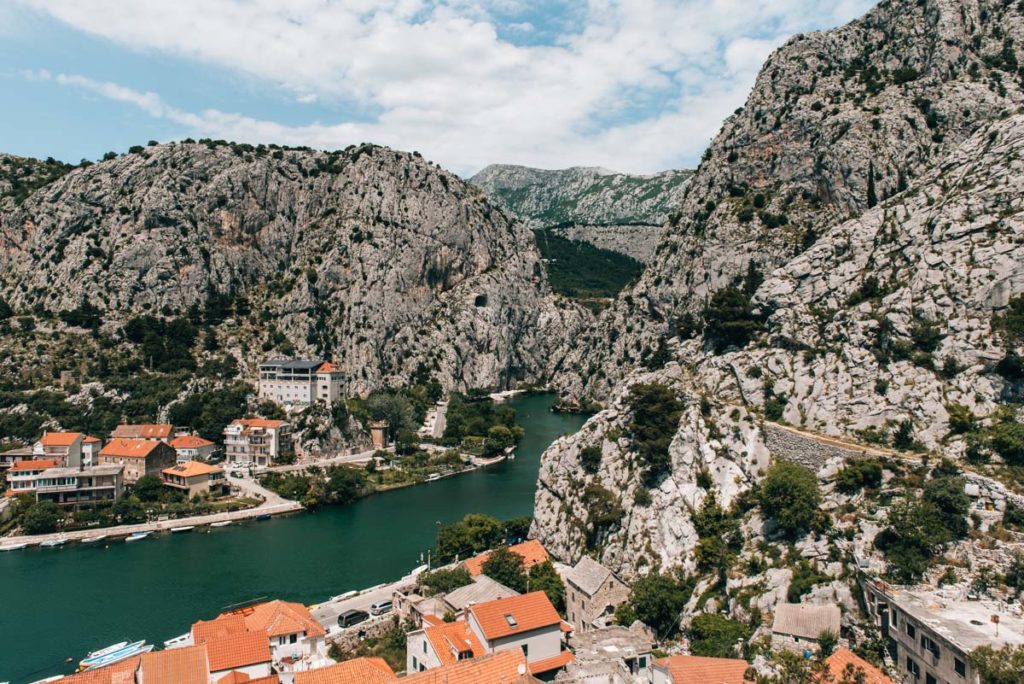
Krka National Park & Šibenik
One of the most well-known day trip destinations near Split is the world-famous Krka National Park. With its impressive waterfalls, the national park is a real natural gem. You can get to Krka from Split in around an hour by car.
If you are driving this route, then in our opinion it is absolutely worth it to take a stop off in the pretty town of Šibenik. We would plan a whole day for this trip. You can find all of our recommendations for your visit in this travel guide: Šibenik Tips (incl. Krka National Park).
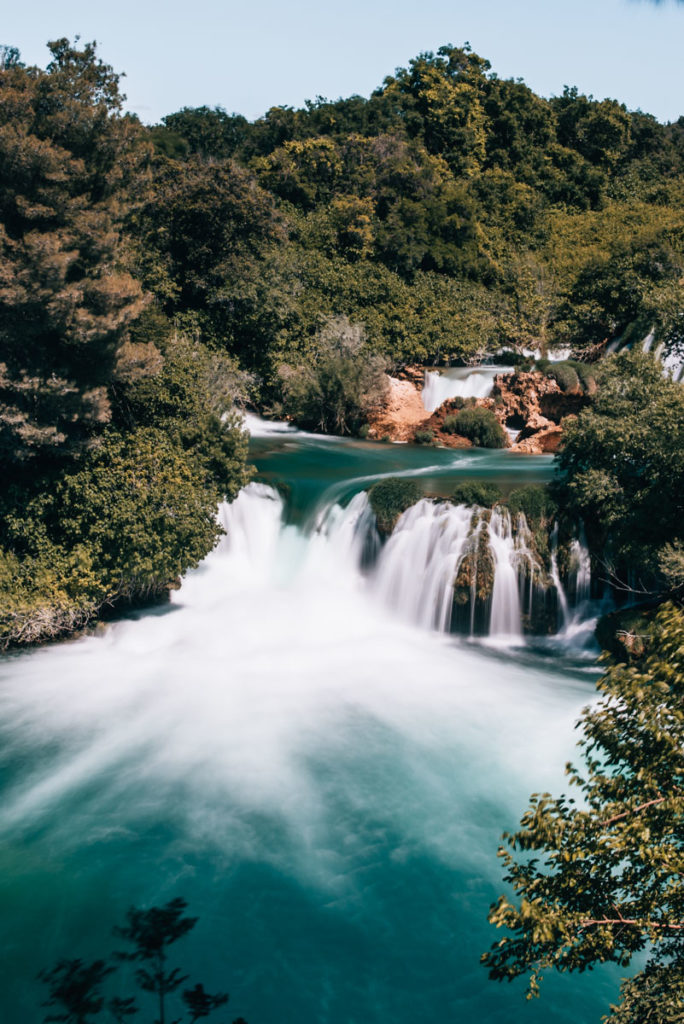
You can find all of our highlights marked on this map so that you can better navigate your way to all of the sights in Split when you are there. Small tip: simply click on the top right corner to open the map with the Google Maps App on your phone.
Disclaimer: Affiliate Links
This travel guide contains our personal recommendations in the form of affiliate links. If you book or buy something through the links, we receive a small commission. This does not change the price for you at all. A million thanks from the both of us!
We are curious: Have you ever been to Split? Did you enjoy this dreamy coastal town just as much as we did? We are excited to hear about your experiences. Also let us know your additional tips and recommendations – we look forward to it!
You might also be interested in this
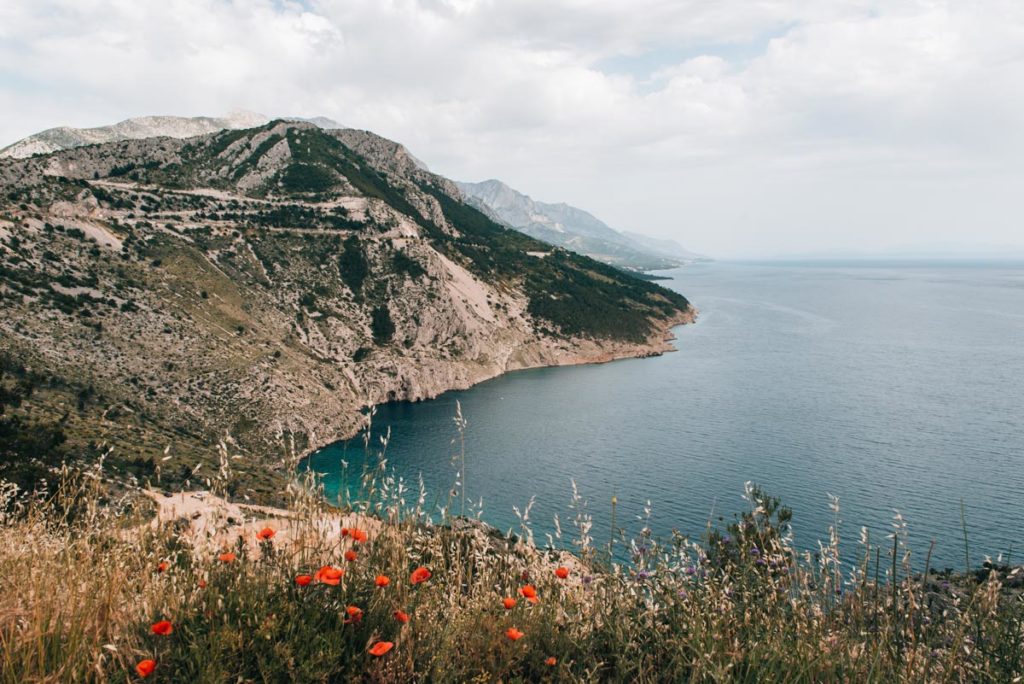
Croatia Itinerary: The Most Beautiful Travel Destinations for your Road Trip
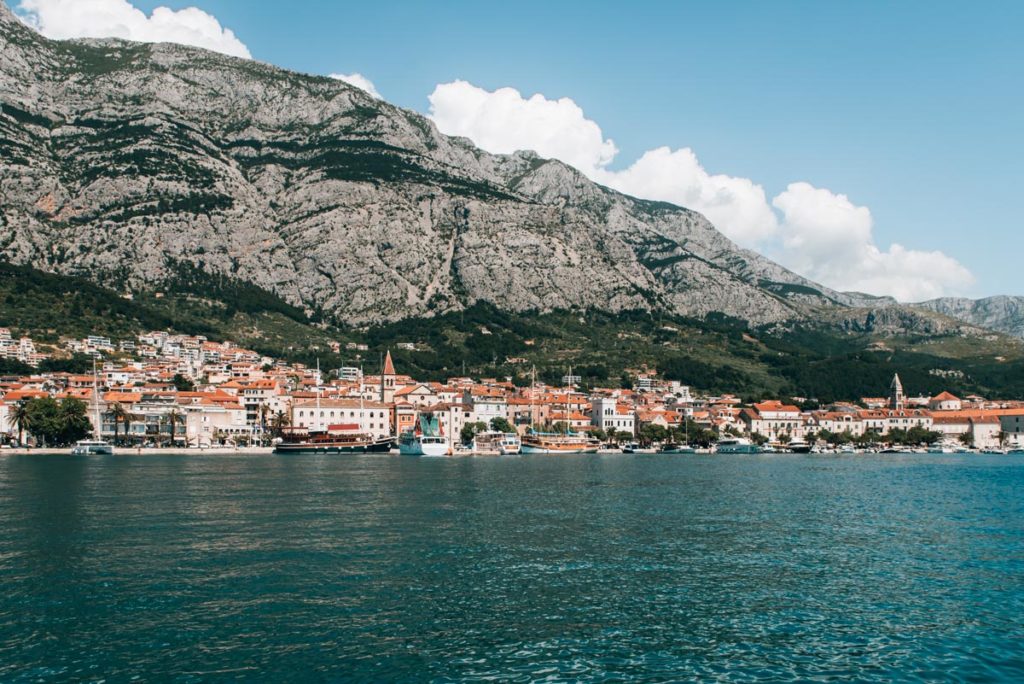
The Makarska Riviera in Croatia: Best Beaches & Travel Tips
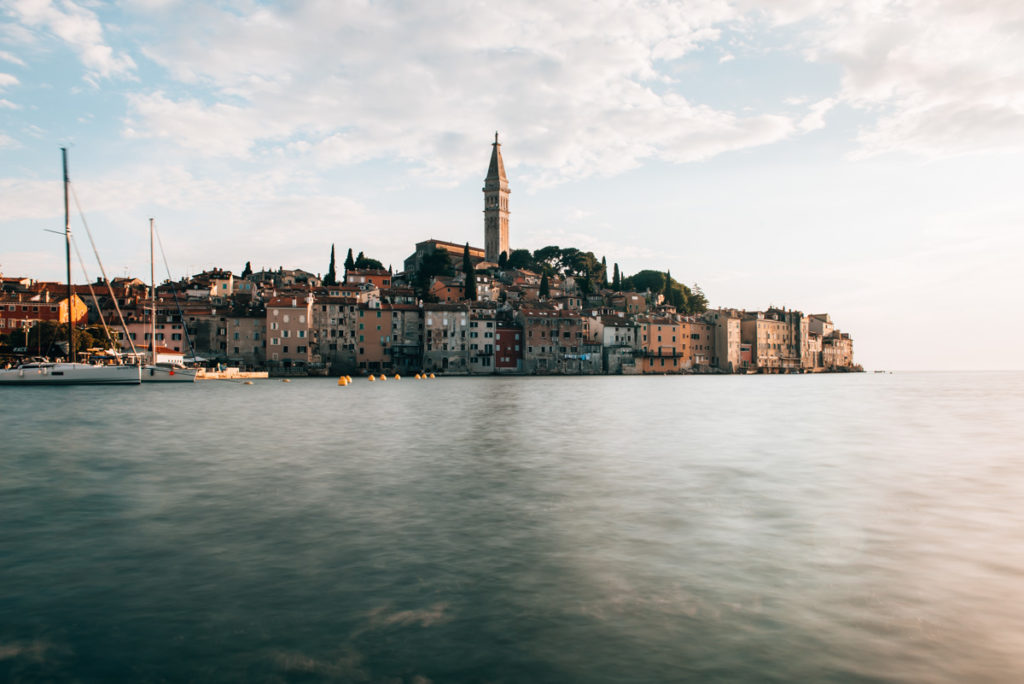
Rovinj Travel Guide: Best Sights, Beaches & Tips
Leave a reply cancel reply.
Your email address will not be published. Required fields are marked *
- Privacy Policy

- Nov 14, 2022
Split in Croatia: The Only Travel Guide You'll Need
Updated: Dec 6, 2022
Split is located in western Croatia along the Dalmatian coast. As Croatia’s second largest city, it’s always buzzing with life and has been for thousands of years. Split was put on the map by the emperor Diocletian, who had his palace built here between 295 and 305. After his death, the palace was continuously used throughout history by different civilizations, like the Romans, Byzantines, and Venetians. Today, life continues between the old city walls and it’s one of the reasons why travelers visit. But Split’s unique setting between the dramatic coastal mountains and the turquoise waters of the Adriatic Sea also makes it an ideal vacation hub. In this article, we’ll highlight the most important things to know before going, where to eat and sleep, and 10 amazing things to do in and around Split in Croatia.

Check out our video on Split in Croatia to get a sense of what it's like there!
Table Of Contents
Important things to know, where to stay in split, where to eat and drink.
Best Things To Do In Split + map
Tips to save money and other resources
Best time to travel to Split
The best time to visit Split in Croatia is from May to June and September to October . In this period there are fewer tourists and better weather to visit the city. It will still be sunny and warm, but not as extreme as in the summer months. In these periods, accommodation will also be cheaper than in July and August.
Cost & currency in Split
Split is pretty affordable , from food and drinks to accommodation. In the summer months the prices go up for a lot of things. As of January 2023, they use the Euro (€) in Croatia. Credit cards are widely accepted, but you definitely need cash for smaller cafés and stores.
Safety in Split
Split is a safe place. For every popular city, you have to watch out for pickpockets but overall there is not much to worry about.
Apartment Joe Light : this is where we stayed, it's a 20 mins drive from the city center of Split in Podstrana. The apartment was cozy and had a fully-equipped kitched which saved us some money cooking instead of eating out!
Heritage Apartments Trumbić : if you prefer having the privacy and independence of an apartment and being in the city centre this is perfect for you
Apartmani Dotur : a great budget option
Plaza Marchi Old Town - MAG Quaint & Elegant Boutique Hotels : sometimes you want to live like a god in Croatia, this place will make this dream come true. It had everything you need while also having a great location.
Šug Restaurant : modern Dalmatian cuisine
Chops Grill - Steak & Seafood : best seafood in Split
Zinfandel Food & Wine bar : seasonal food
ShotGun Shooters Bar : the most differentiation of shots we've ever seen in a bar
Best Things To Do In Split
Split is such a vibrant city with a lot of things to do. We had an amazing time there! We will highlight our top 10 favorite things to do in this lively city.
If you're traveling to Split and want to save time searching for directions to all of the places we mention in this article, then look no further than our custom map. Simply click on a point in the map below to get directions there for yourself!
10. Stroll along the Riva Promenade
The lively waterfront promenade, known as the Riva , is the best central reference point in Split. Lined with cafés and restaurants, it’s a great place to eat and drink, or just stroll around and breathe in the atmosphere. It can get busy sometimes because of the immense cruise ships that dock here almost on a daily basis. It’s a great spot to grab a coffee and soak in the atmosphere of the city.

9. Explore Diocletian’s Palace
Diocletian’s Palace is one of the most impressive ancient Roman monuments in existence today and you’ll likely spend most of your time in Split here. Located in front of the harbor, it’s the beating heart of the city, and you’ll find plenty of bars, restaurants, and shops inside its walls. In fact, there are over 200 buildings within the palace boundaries! And even though the original structure has been added to and altered continuously over the millenia, it’s absolutely fascinating to walk through its narrow streets! Access this imposing structure from one of its four historic gates ( Golden , Bronze, Silver , and Iron Gate ).

8. Visit St. Domnius Cathedral, the Bell Tower & Temple of Jupiter
Located inside the palace, Split’s cathedral is one of the best-preserved ancient Roman buildings still standing. It was originally built as a mausoleum for Diocletian. However, in the 5th century, the Christians destroyed the emperor’s sarcophagus and converted his tomb into a church dedicated to one of his victims. You can buy a ticket that combines a visit to the cathedral with the Bell Tower which offers a panoramic view of the city. It also includes the treasury where you can find preserved sculptures and paintings that relate to the Cathedral's history, and the Temple of Jupiter which is an ancient Roman temple that has been converted into the cathedral’s baptistery.
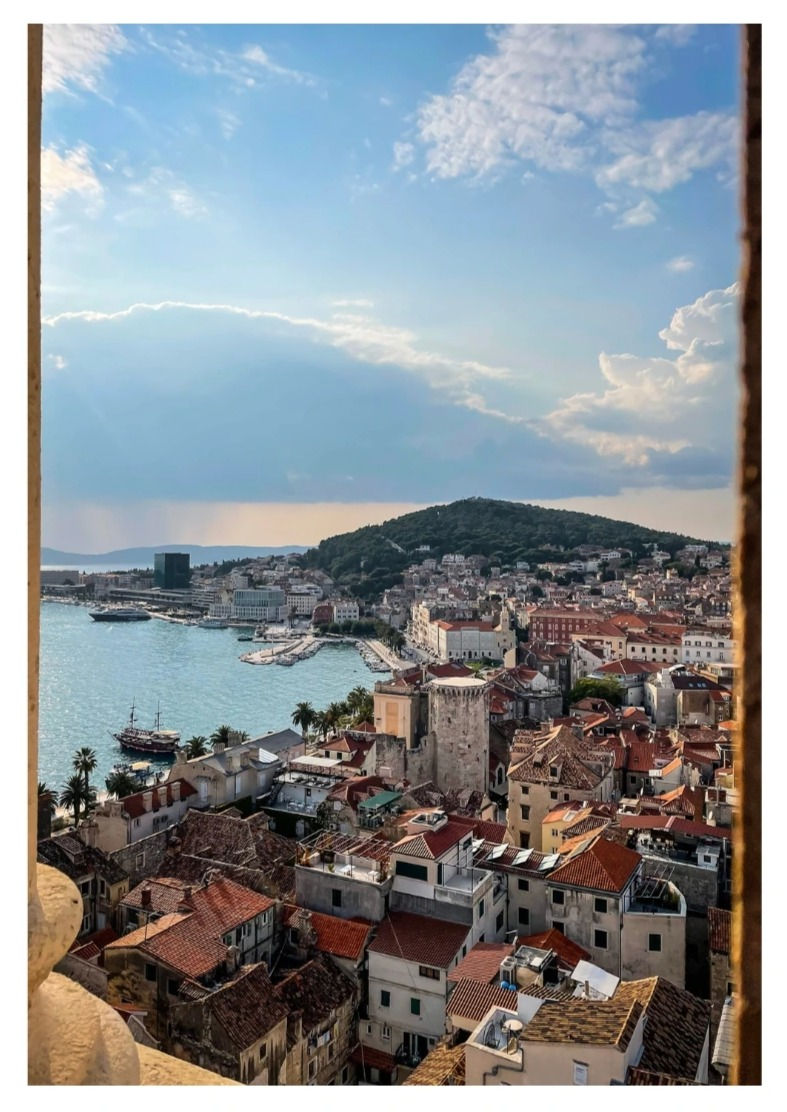
7. Catch a view from Marjan Hill
To the west of Split looms Marjan Forest Park , a nature reserve with a wealth of walking trails. The most popular one passes shortly through a pine forest before reaching a scenic lookout of Split and the surrounding islands ( Prva Vidilica lookout ) . It’s a great place to watch the sunset from! But if you need a true escape from the city, you can also continue through the park to other viewpoints and even a beach ( Kašjuni ) . The park is big enough that you can spend an entire afternoon here.

6. Walk around downtown Split
Split is more than just the palace and you’ll find fascinating buildings and monuments all around its downtown area ( Republic Square , Grgur Ninski statue , Church and Monastery of St. Francis , Sulphur Baths ) . Get lost in its narrow streets, go shopping, or try some of the local cuisine (shot of pašticada). But the best way to learn about this fascinating city is to go on a guided walking tour. Not only will you visit Split’s main highlights, but also become familiar with the culture and way of life.

5. Day trip to Krka National Park
One of Croatia’s absolute highlights is only an hour drive from Split. Krka National Park extends along the 73 kilometers or 54 miles Krka River, which runs through a karstic canyon. It’s a breathtaking area filled with waterfalls and gorges that you can explore on foot via boardwalks and trails. The park actually has 5 main entrances, which are all accessible by car, but located far from one another ( Skradin , Lozovac , Roški Slap , Krka Monastery and Burnum ) . Skradinski Buk is the highlight of the park, where you can take a beautiful walk along the emerald green river and end at the park’s most impressive waterfall. But Roški Slap, Burnum, and Manojlovac are also worth a visit. If you don’t have a car, you can also book a day tour here to make it easier for yourself.

4. Go to the Klis Fortress
Located 12 kilometers or 7.4 miles to the northeast of downtown Split you can find the impressive Klis Fortress . This fort offers beautiful views of the surrounding valley and the Adriatic Sea. Inside, you can explore the various fortifications and visit a small museum with details on the castle’s past. If you’re a Game of Thrones fan, you’ll also recognize the Klis Fortress as Meereen, which appeared in season four and five. There’s a room inside the fort with pictures to freshen up your memory. Alternatively, you can also visit the Game of Thrones museum in the city center of Split!

3. Boat Tour To Blue Cave + 5 Islands
Croatia has hundreds of islands dotting its coastline and those near Split are some of the most pristine on the entire Dalmatian coast. Because of their close proximity to the mainland, some islands can be discovered on an island hopping tour from Split. We joined the 5 island tour, during which we snorkeled and swam in the pristine waters of the Blue Lagoon, visited charming villages on the islands of Vis and Hvar , and explored the dazzling Blue Cave . We cruised on a speedboat, allowing for a smaller group and more intimate experience.

2. Visit nearby Trogir’s old town
If you’re looking for a more relaxed atmosphere but equally-beautiful medieval walls, then you should add Trogir to your Split itinerary. Located only 30 kilometers from the city center of Split, the old town of Trogir is set on a tiny island linked by bridges to the mainland as well as the neighboring larger island ( čiovo Island ) . Within its walls, you can find many beautiful buildings that were built between the 12th and 15th century (e.g. St. Lawrence Cathedral ) . Walk its narrow alleyways and the beautiful boulevard that is lined with cafés, restaurants, and yachts.

1. Day trip to Plitvice Lakes National Park
Last but not least, we have the world-famous Plitvice Lakes . Known for its large network of karstic emerald lakes and stunning waterfalls, this park is a-must visit when in Croatia and is protected by UNESCO for a good reason. You can visit the park as a day trip from Split with a guided tour which you can book here . However, it’s definitely easier to visit this magical place from the closer city of Zadar , which is where we did it from.

Use These Websites To Save Money On Your Trip To Split in Croatia
Booking.com for places to stay
Skyscanner for cheap flights
GetYourGuide for local tours
Rentalcars.com for affordable car rentals
Free Giveaway
Did you enjoy our article on the best things to do in Split, Croatia? Download our free giveaway and spark your wanderlust with our top 100 travel destinations around the world!

Other Top Split resources:
If you're looking for some other suggestions and tips on Split, here are some great articles that will help you:
Top Ten Things To Do In Split, Croatia by Earth Trekkers
21 Delightful Things to Do in Split, Croatia by Sand In My Suitcase
21 AWESOME Things To Do In Split, Croatia by Jonny Melon
Need more travel inspiration? Check out our other destinations

Related Posts
Paphos, Cyprus: A Short Travel Guide
Cyprus Travel: 15 Beautiful Places To Visit
Gibraltar: A Short Travel Guide

Hi! We are Ine & Zac. An international travel couple from Belgium and the US. We created World Wild Hearts to inspire new adventures and help you plan your next trip. Use these tips, stories, and guides to inspire your next adventure of a lifetime!
SAVE MONEY ON YOUR TRIPS

DOWNLOAD FREE TRAVEL RESOURCES

WATCH OUR TRAVEL VIDEOS

This post contains a few affiliate links. That means we may earn a small commission when you click on the links at no additional cost to you. You can read our full disclaimer here . Thanks for supporting our travel blog!

COMPREHENSIVE TRAVEL PLANNER


©Nataliia Budianska/Shutterstock
Always buzzing and exuberant, Split (Croatia’s second-largest city) has just the right balance of tradition and modernity – the perfect place to see Dalmatian life as it’s really lived.
Attractions
Must-see attractions.

Diocletian’s Palace
Taking up a prime harborside position, the extraordinary complex of Diocletian's Palace is one of the most imposing ancient Roman structures in existence…

Klis Fortress
Controlling the valley leading into Split, the imposing Klis Fortress spreads along a limestone bluff, reaching 1260ft (385m) at its highest point. Its…

Cathedral of St Domnius
Split’s octagonal cathedral is one of the best-preserved ancient Roman buildings still standing. It was built as a mausoleum for Diocletian, the last…

The ruins of the ancient city of Salona, situated at the foot of the mountains just northeast of Split, are the most archaeologically important in Croatia…

Temple of Jupiter
Although it's now the cathedral's baptistery, this wonderfully intact building was originally an ancient Roman temple dedicated to the king of the gods…

Archaeological Museum
A treasure trove of classical sculpture and mosaics is displayed at this excellent museum, a short walk north of the town centre. Most of the vast…

Meštrović Gallery
At this stellar art museum you’ll see a comprehensive, well-arranged collection of works by Ivan Meštrović, Croatia’s premier modern sculptor, who built…

Marjan Forest Park
Looming up to 178m over Split's western fringes, this nature reserve occupies a big space in Split's psyche. The views over the city and surrounding…
Plan with a local
Experience the real Croatia
Let a local expert craft your dream trip.
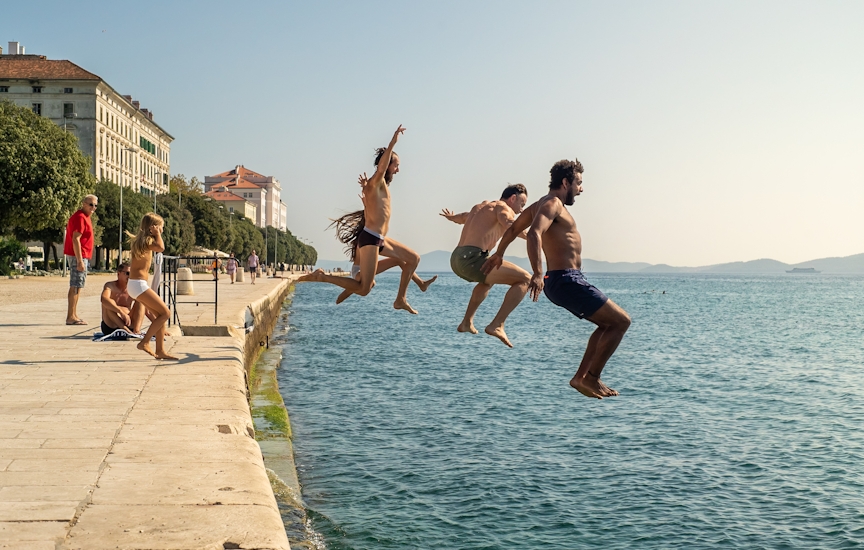
Latest stories from Split

National Parks
Apr 26, 2022 • 10 min read
Split is one of Croatia's most charming cities, and there's more to see beyond the city limits. Try these day trips to castles, medieval towns and islands.

May 4, 2020 • 10 min read

May 17, 2019 • 3 min read

Jan 8, 2018 • 5 min read
in partnership with getyourguide
Book popular activities in Split

23 Incredible Things to do in Split, Croatia in 2024
Written By: Sara Oprasic
Published On: January 22, 2024
Are you planning a trip to Croatia? Make sure to add Split to your itinerary. Split is the second-largest city in Croatia, right after its capital, Zagreb. Split has many things to do, making it a popular tourist destination, both for its countless historic attractions and beautiful beaches. If you’re planning a trip to Split, you’ll find plenty of ideas on the must-see attractions in the city in this guide. From the best spots for panoramic views of the sea to the best hiking trails in the nearby forest park – here are all the best things to do in Split, Croatia!
In this travel guide, I am covering all the most exciting attractions worth your time in this beautiful Croatian city. With a central location on the coast and ferry access to many Croatian islands , Split is an excellent base for discovering the Dalmatian coast. Whether you want to go on a road trip or a boat cruise, you’ll find many options for day trips to national parks and other nearby towns.
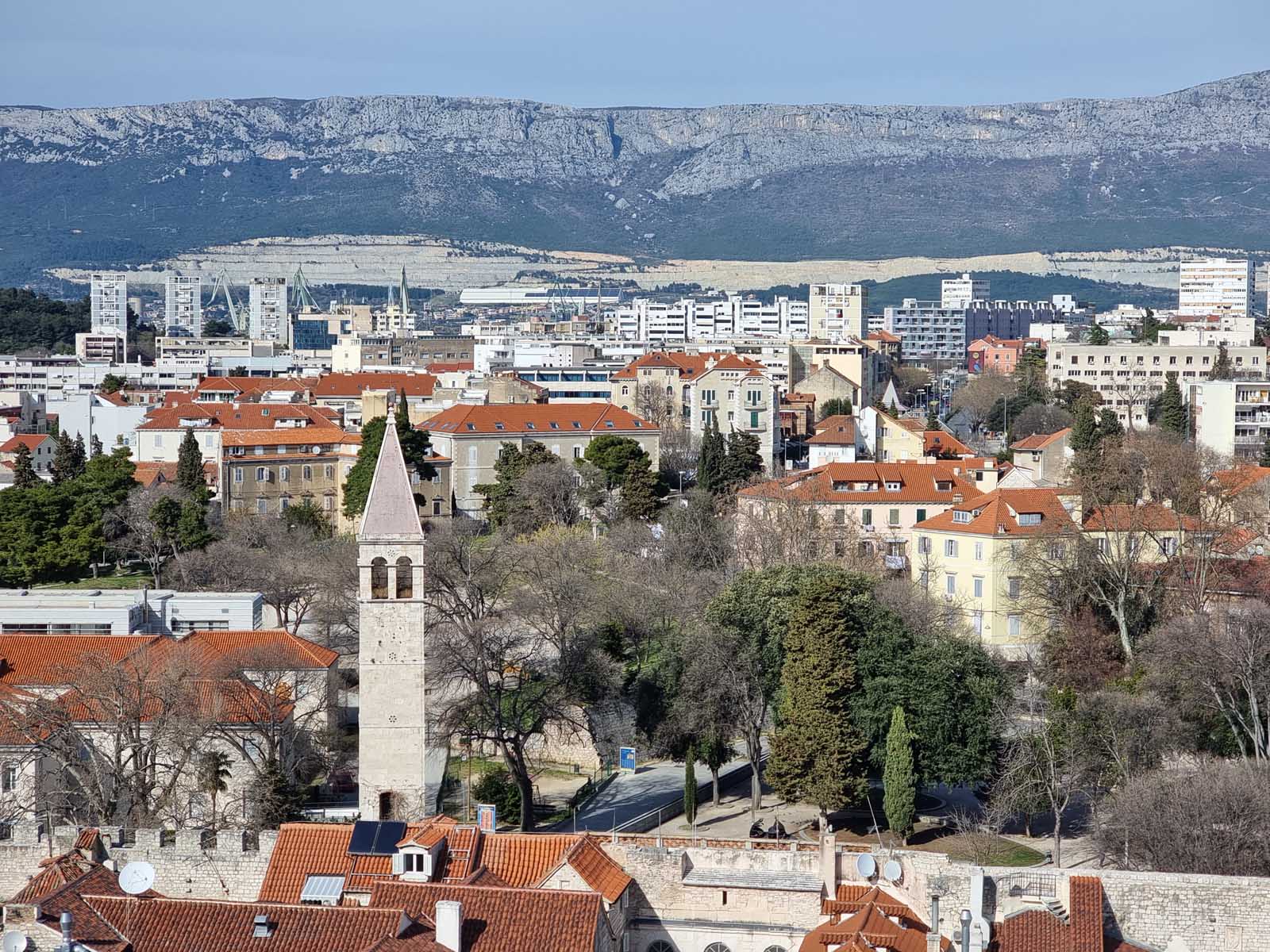
Ancient landmarks and narrow cobblestone alleys are staples of Split. Your time in this city can be filled with history, adventure, and delicious food if you wish.
And if you don’t, Split is still a great city thanks to its lovely beaches and easy access to secluded bays on the islands. Whether your idea of a fun vacation includes visiting as many landmarks as possible or swimming for hours, Split won’t disappoint.
Best of Split Quick Guide
- Must See: Diocletian’s Palace, St. Dominus Cathedral, Seaside Promenade, Diocletian Aqueduct
- Where To Stay: We Collect Umbrellas , Hotel Luxe , Hotel Park
- Fun To Do: St. Dominus Tower, Museum of Illusions, Forest Park Marjan, Skywalk Poljud
- Day Trips: Plitvice Lakes National Park, Krka National Park, Zadar, Trogir
- Must Try Foods: Istrian pasta, Black Risotto, Pasticada, Soparnik
Table of Contents
Best Things To Do In Split, Croatia
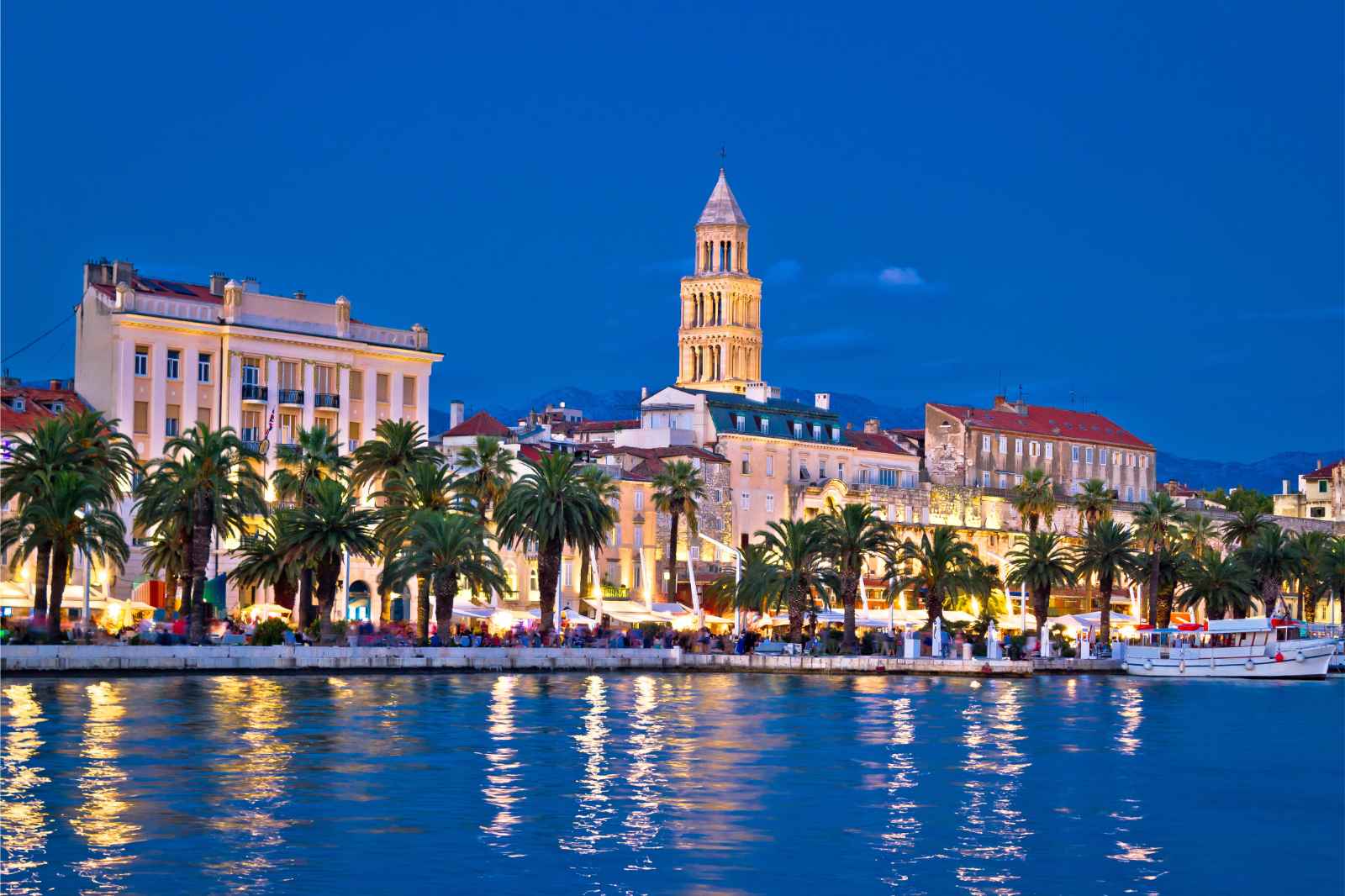
With a historic old town, a forest park in the middle of the city, and some of the best Game of Thrones tours in Croatia, Split has a lot to offer to anyone who visits. The city is a great destination for a holiday, whether you’re looking to spend most of your time exploring and touring museums or you just want to relax on a beach with a cocktail in hand.
It has some of the richest history of all the Croatian cities on the Dalmatian coast, and it’s the most fun. Split is also very close to other beautiful cities , allowing for fun and easy day trips.
1. Walk Around Old Town Split (Diocletian’s Palace)
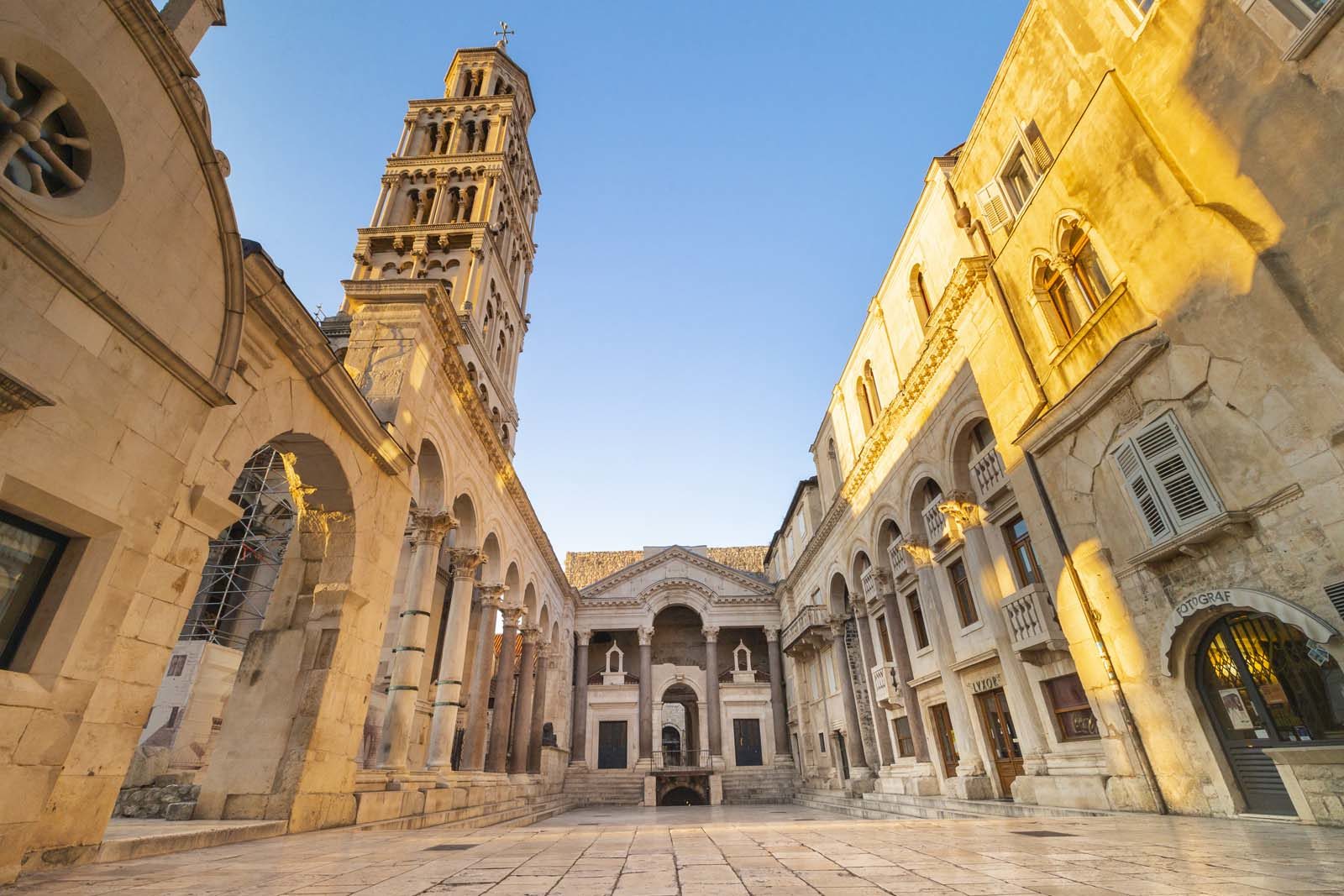
One thing that makes Split such a special destination is that its old town is designated a UNESCO World Heritage Site. That’s because the old town of Split is situated within the walls of the Diocletian’s Palace, which was famously constructed as a residence for the Roman emperor.
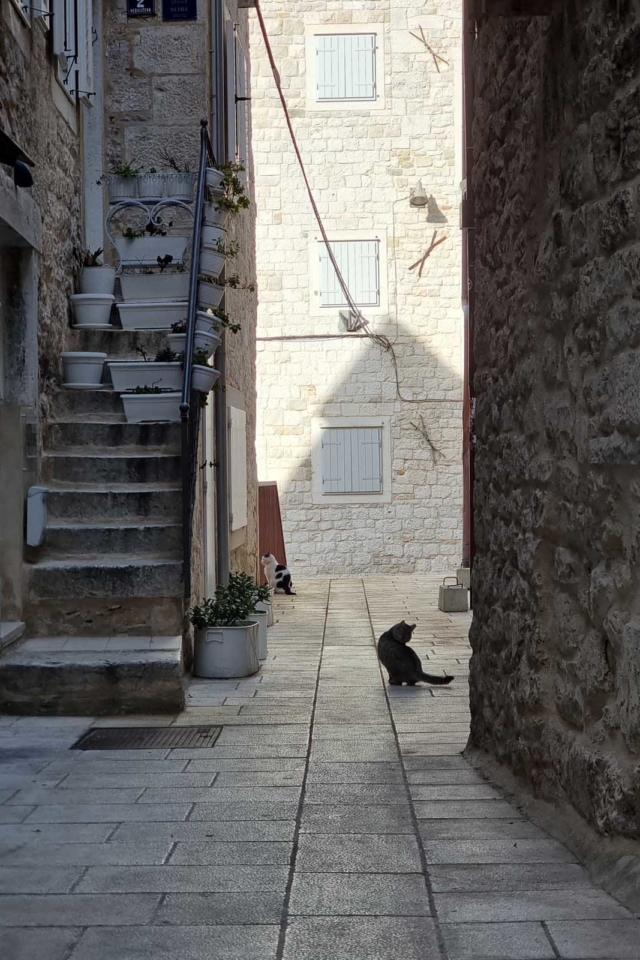
My favorite way of passing time in Split was roaming around the narrow cobblestone alleys. All the cobblestone alleys look alike, which was a nightmare for me because I have a poor sense of direction. But I enjoyed getting lost in the narrow passages, and I made it my mission to pet every stray cat that came across my path.
Explore Diocletian’s palace and pay attention to all the different city gates. Enter every alley you see because you never know what awaits on the other end. You’ll stumble upon graffiti, tiny shops selling local goods, and fat stray cats.
Practical Information : The Old Town of Split is accessible at any time of day or night, free of charge. But this walking tour is highly recommended.
2. See The View from St. Dominus Cathedral’s Bell Tower
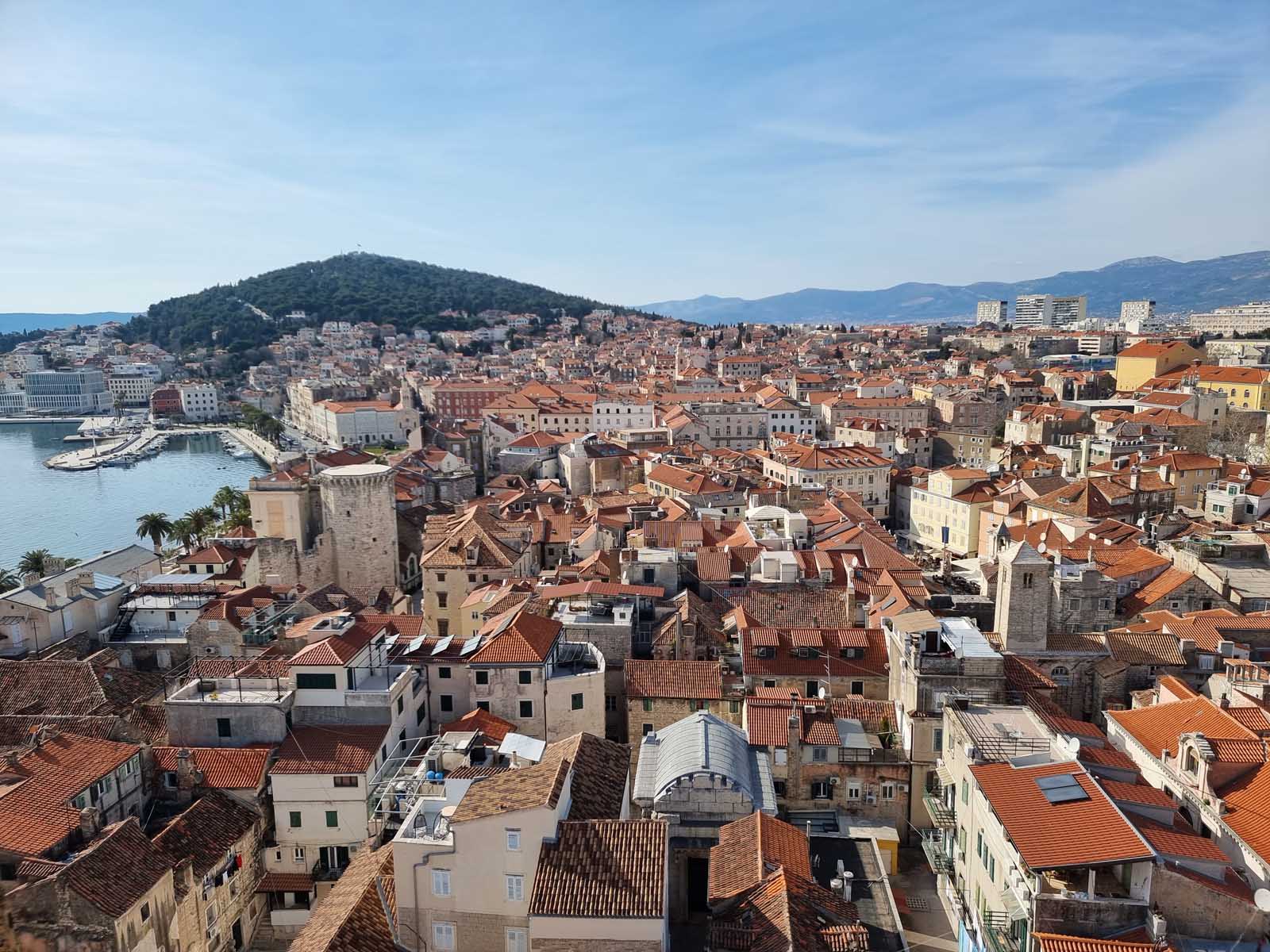
The bell tower of St. Dominus Cathedral is the most prominent landmark in Split. It’s visible from everywhere in town, so it’s constantly inviting you to climb it and see what the view is like from the top.
It’s the best view in Split, and you can stay at the top of the tower as much as you like. First, make sure you have a water bottle because the climb is long and tiring. Then go to the ticket office opposite the Cathedral, and buy tickets for the bell tower.
You can then head up the stairs towards the church entrance and turn left to enter the bottom of the tower. There are many steep steps to climb, and the stairway is very narrow, but the effort pays off once you reach the top.
Insider Tip: Purchase tickets just for the bell tower. They’re significantly cheaper than combo tickets for the tower and the church, and you’ll still be able to go inside the cathedral.
Practical Information: St. Dominus Cathedral and Bell Tower are open from 8 AM until 7 PM. Tickets are available for 3€ – 15€. We accessed the bell tower and the cathedral, but not the crypt, with the cheapest tickets.
3. Visit The Game of Thrones Museum
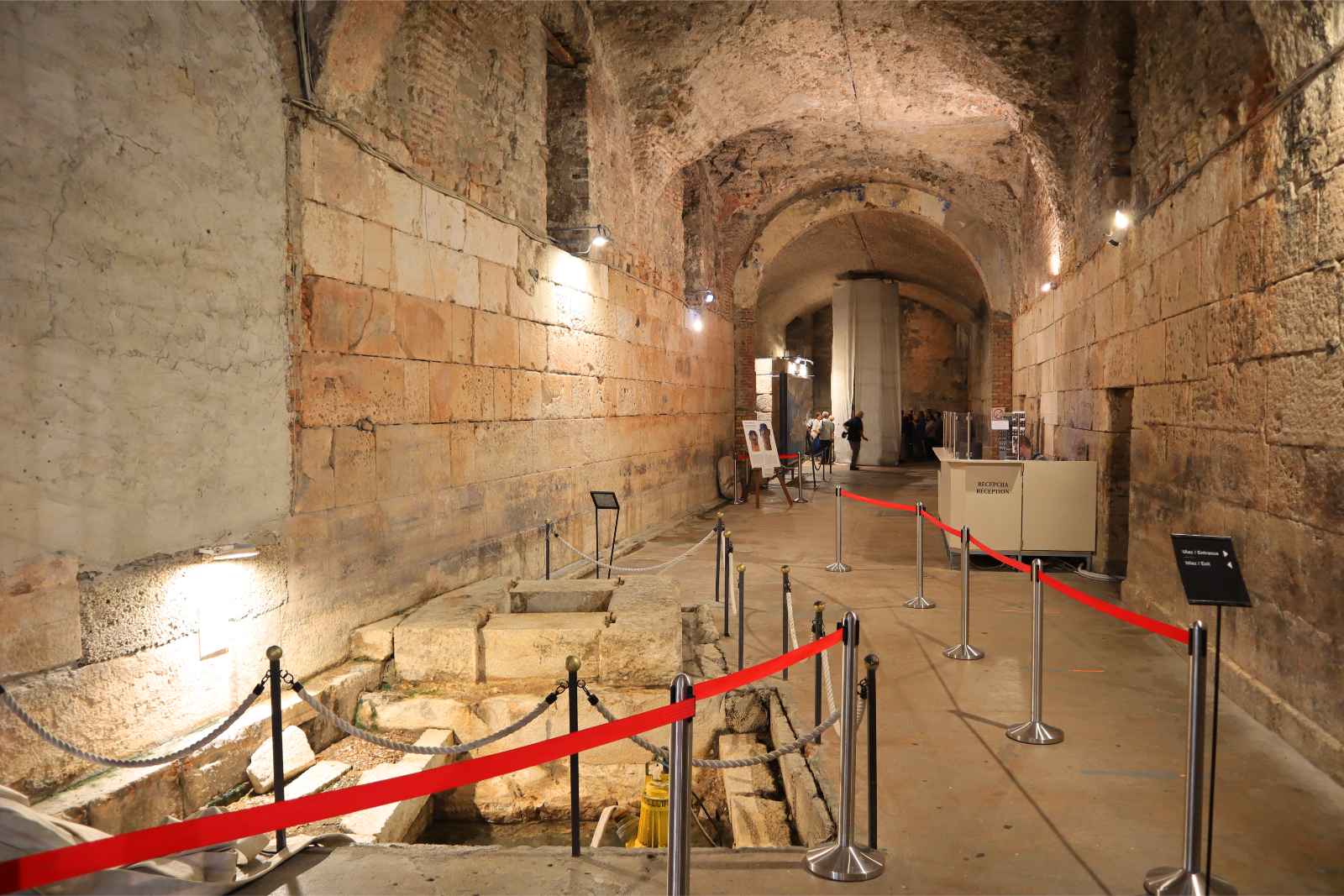
One of the reasons why Split has become internationally famous over the last few years is because it is prominently featured in Game of Thrones . Most scenes featured in the TV show were filmed inside the walls of Diocletian’s Palace, and you might recognize some places just from walking around the old town.
The museum exhibit features replicas of dragons and costumes, and it’s a must for any die-hard Game of Thrones fans. But if you’re not that interested in the series, feel free to skip this museum. Read more: Game of Thrones Filming Locations You Can Visit in Real Life
Practical Information: The Game of Thrones Museum is open from 10 AM until 5 PM. The tickets are 14.5€.
4. Day Trip to Krka National Park
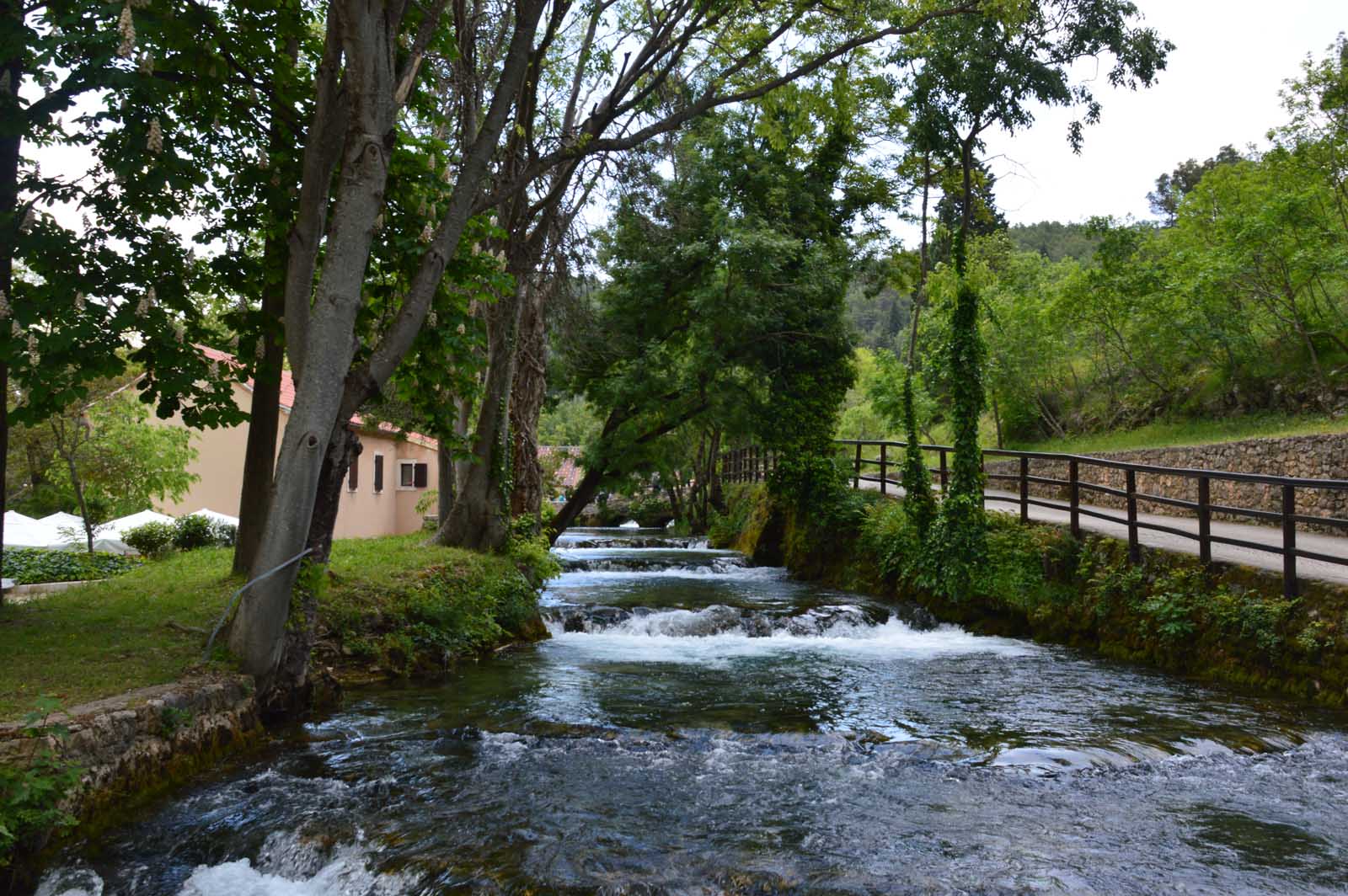
Krka National Park is only an hour outside Split, and it’s one of the best national parks in the country. I enjoyed Plitvice Lakes more, but that’s because I went to Krka during a national holiday, and the crowds were way too big for my liking.
Head to the Lozovac entrance to the park because it’s the closest one to Split. It’s a vast national park, and it will take you 5-6 hours to see everything. Bus rides in the park are included in the ticket price and can save you hours of walking down the roads.
Skradinski Buk Waterfall is closest to the southern entrance (Lozovac). Roski Waterfall is near the northern entrance to the park. The Franciscan Monastery on a tiny island in the central area of the park is another highlight, and boat excursions to the monastery are available for an additional fee.
Practical Information: Krka National Park is approximately an hour to 90 minutes away from Split by car and bus. Tickets for the park are 7-40€ depending on the season (most expensive from July to September). You can book a day tour including boat cruise that will pick you up from your hotel in Old Town Split.
5. Stroll Down The Seaside Promenade
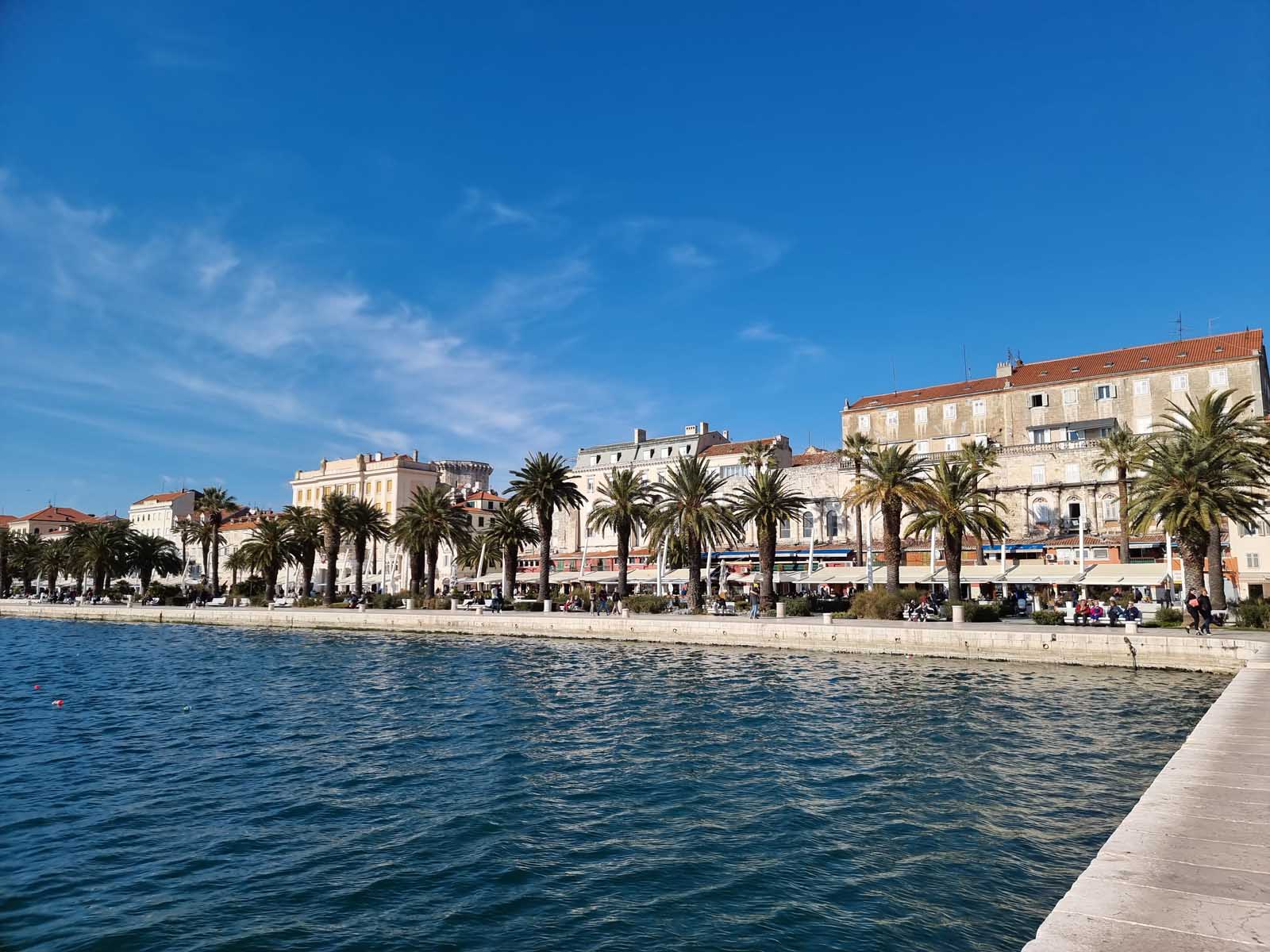
The seaside promenade in Split – or Splitska Riva as the locals call it – is an iconic part of the city. It is lined with cafes and restaurants on one side and a splendid view of the Adriatic Sea on the other. In the middle is a road and a pedestrian area with palm trees and benches inviting you to sit and take in the views.
Most of the cafes and restaurants here are tourist traps and have the highest prices of all the locales in Split. But I didn’t mind being trapped for half an hour because the views are just that good.
Practical Information: The seaside promenade is accessible 24/7 for free.
6. Relax At Forest Park Marjan
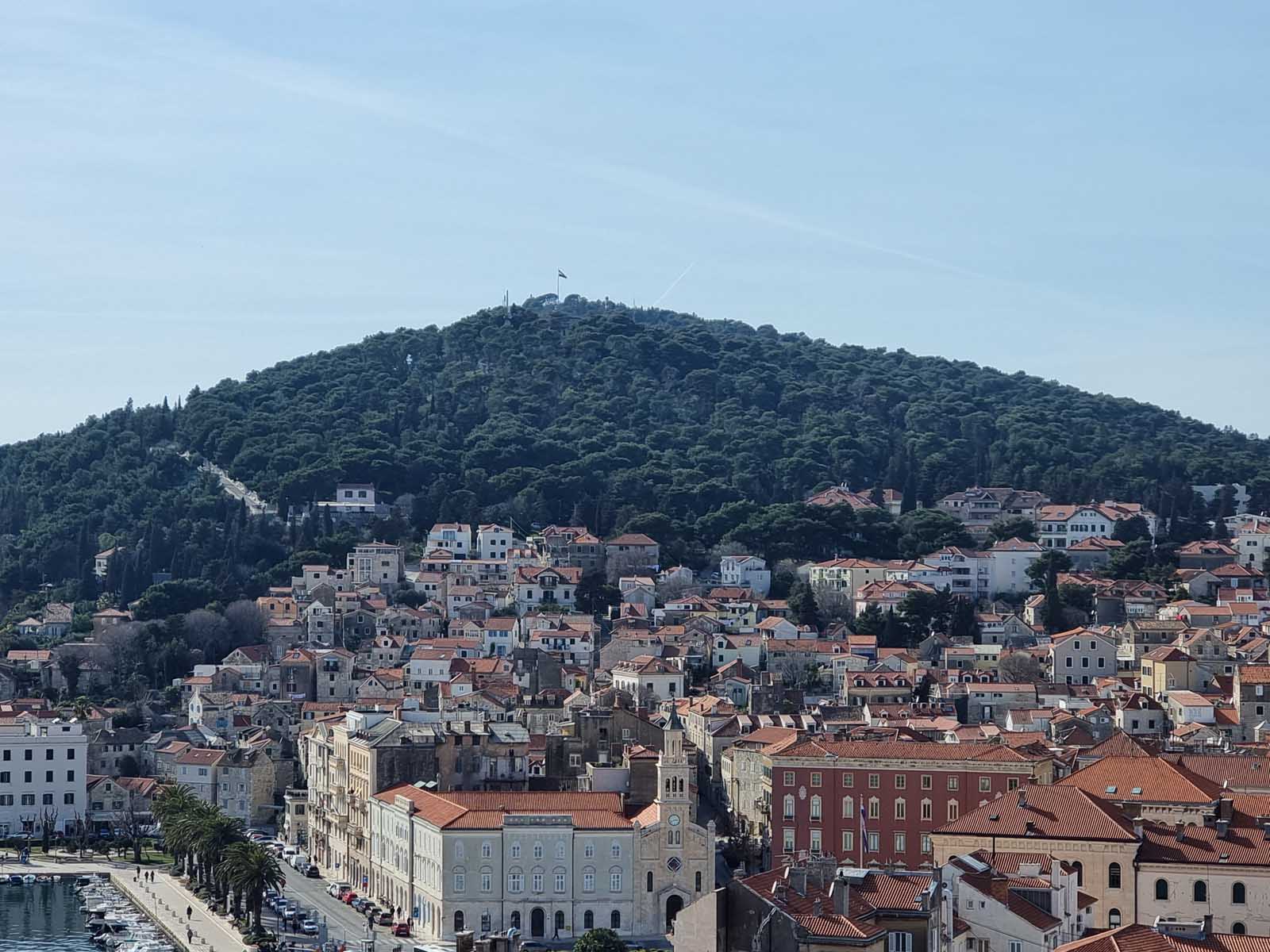
Marjan Forest Park is a proper oasis in Split, situated on a peninsula that juts out into the sea. A visit to the park could count as a day trip because it’s such a vast space with plenty of things to do. Hiking trails, observation decks, and beaches are all found at this park, which offers sweeping panoramic views of Split’s historic center.
An afternoon at the park is a great way to take a break from the relentless crowds inside Split’s old town. Hike to the Telegrin Peak observation deck at the top of the hill, for the best view of the rooftops in Diocletian’s Palace. And head downhill to the beaches at the foot of the hill to soak in the sun and swim in the Adriatic Sea.
Practical Information: Marjan Forest Park is accessible by walking trails and a local bus. It’s accessible 24/7 for free.
7. See The Exhibit at the Mestrovic Gallery
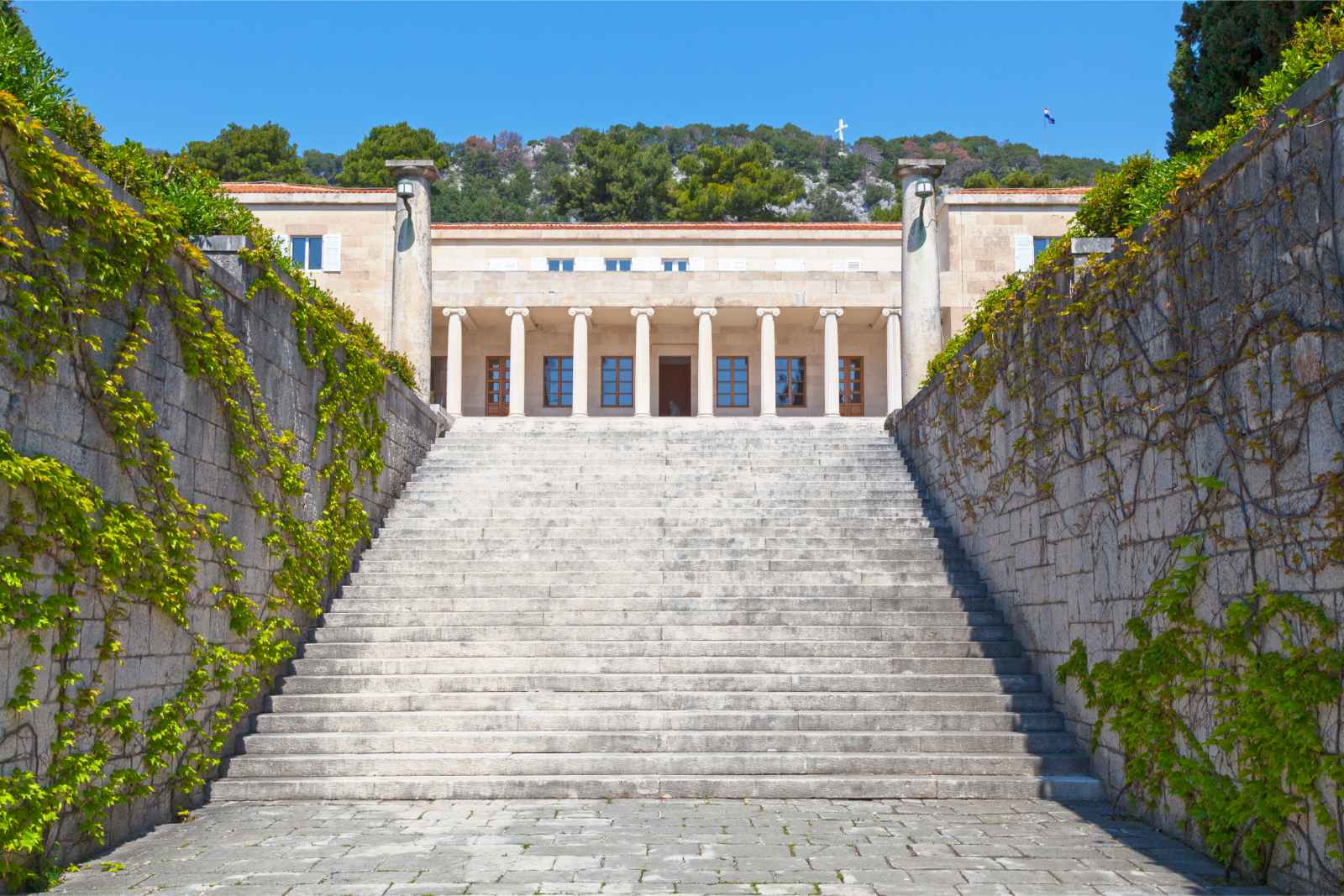
Ivan Mestrovic is the most famous sculptor and architect from Croatia and a local legend. His statues adorn the streets of Split, Zagreb, and Belgrade, but also those of Chicago, Baton Rouge, and Ontario.
Mestrovic Gallery is a museum dedicated to the late artist. It’s situated at the foothills of Marjan Park, and it’s easily accessible by buses and walking paths from Split Old Town.
The museum is on the grounds of the sculptor’s former residence, and even the house itself is a work of art. Inside it are countless thought-provoking statues, perfectly illustrating the famous artist’s immense talent.
Practical Information : Mestrovic Gallery is open every day except Monday from 9 AM until 5 PM. The entrance fee is 12€. Or you can book this private half day tour of Split that includes entrance to the Mestrovic Gallery.
8. Head to Trogir For A Day
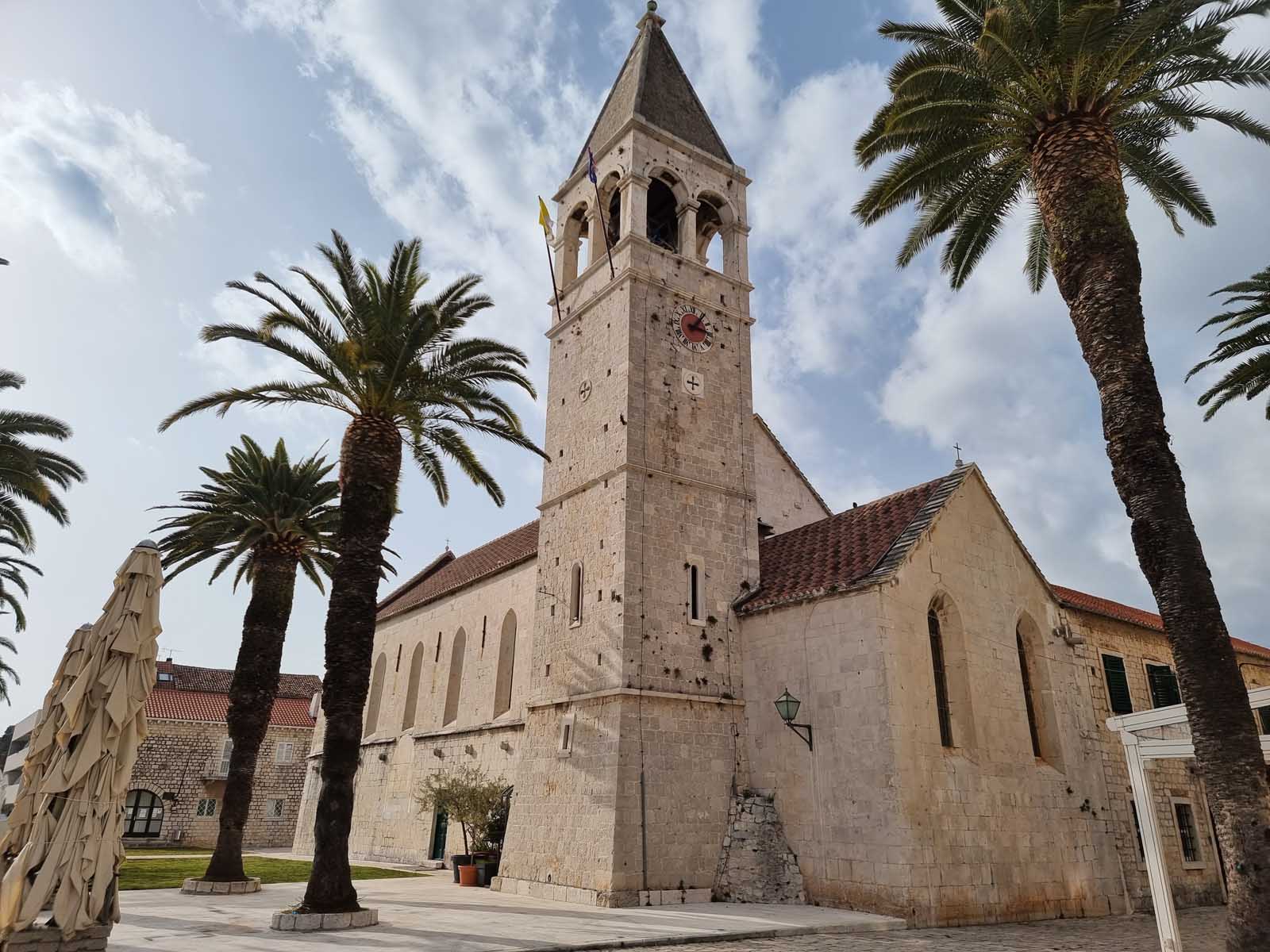
A half-day trip to Trogir is perfect for a morning or an afternoon in Split. It’s only a 20-minute drive between the two towns, and you can drive either on the highway or the local roads. I recommend the local road because it follows the coast of the Adriatic Sea, and it’s a much more scenic drive.
Trogir’s old town is situated entirely on a small island. It’s connected to mainland Croatia with a bridge, which you must cross to reach the old town. The historic old town is charming, with cobblestone alleys and countless ancient buildings.
The town of Trogir even has a castle on the southwestern edge of its old town. It’s right next to a small beach, where you can go for a swim if the weather allows. Also, see the St. Dominic Monastery and Church, the Trogir City Museum, and St. Peter’s Church.
Practical Information : Trogir is 20 minutes by car or 30 minutes by bus from Split. This speedboat trip is an excellent day tour that includes a stop at the Blue Lagoon and the UNESCO World Heritage Site of Trogir’s Old Town.
9. Day trip To Plitvice Lakes National Park
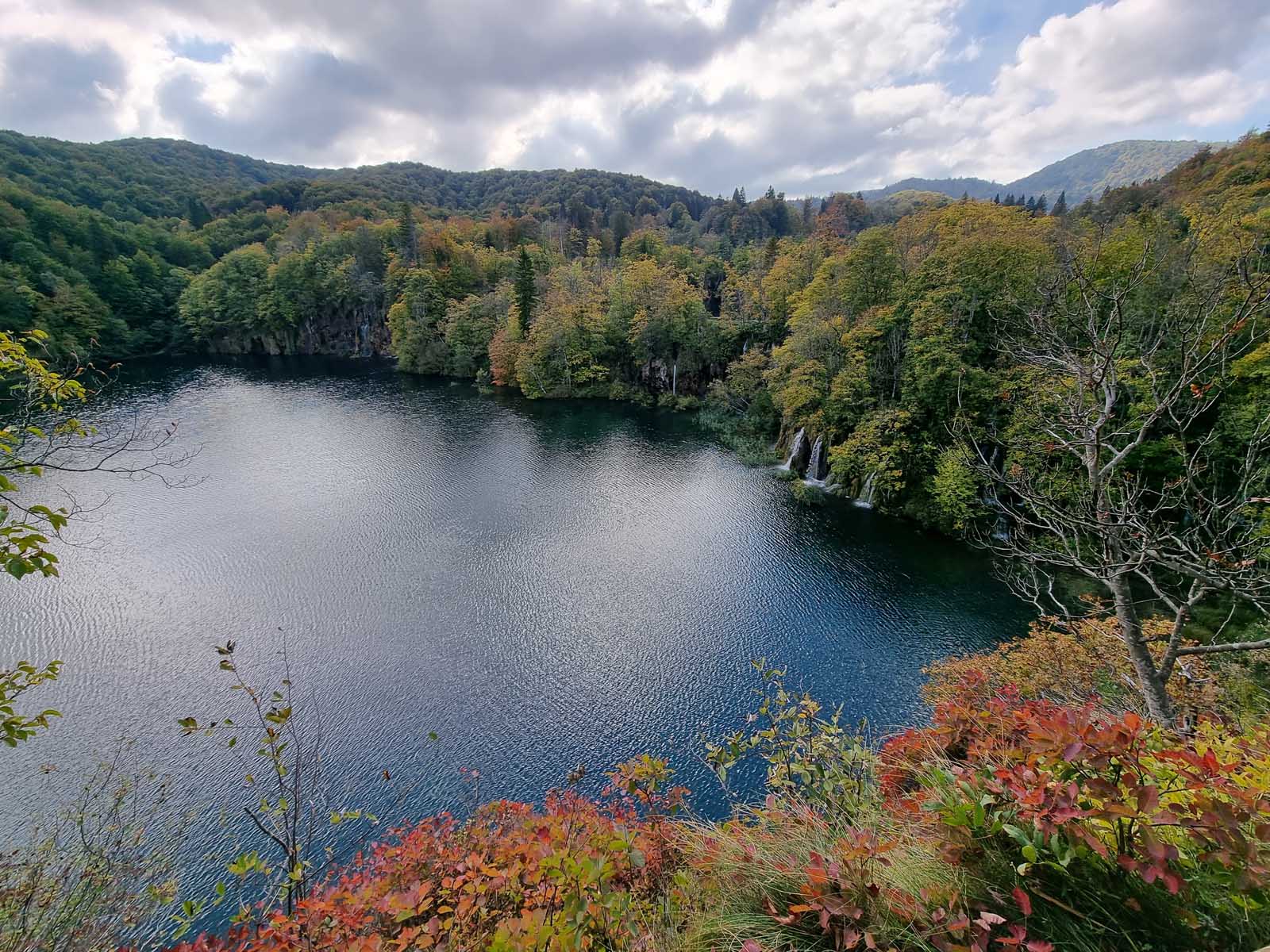
Plitvice Lakes is lauded as the best national park in Croatia, and I tend to agree with that statement. Situated approximately two and a half hours from Split by car, this national park is by far the best destination for a fun day trip from Split.
I visited Plitvice Lakes in autumn, and it was a wonderful experience. That’s the best time to visit to see the striking contrast between the red and orange treetops versus the turquoise lakes. And there aren’t too many people at the park, so you don’t have to buy tickets in advance or wait in long queues for the transport.
Loads of hiking trails in the national park will allow you to discover its beauty. All visitors can also ride the free buses and boats throughout the park, which allows for a much quicker exploration. The boat trip was my favorite experience, second only to the sight of the Great Fall.
Insider Tip: Tickets are cheaper if you buy them at the entrance.
Practical Information: Plitvice Lakes National Park is open year-round. Entrance to the park is from 8 AM until 1 PM, and the tickets cost 10-40€, depending on the season.
10. Visit The Museum of Illusions
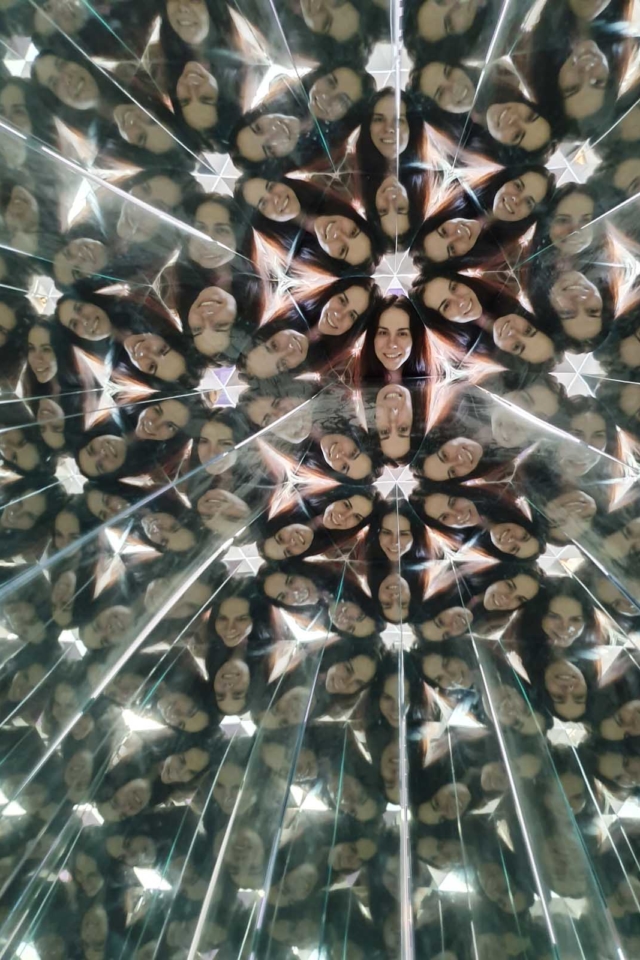
The Museum of Illusions was first opened in Zagreb, Croatia, and it didn’t take long for it to become a franchise with museums in Las Vegas and Singapore. It’s my favorite interactive museum, and I love visiting it in every city I travel to because there’s always something unique to that location.
Head to this museum in Split to spend an hour or two exploring the different exhibits and having the time of your life. Pose for unique photographs, try to spot all the different illusions, and touch as many exhibits as you like.
Whatever you do, don’t enter the anti-gravity room. It messes with your brain’s balance system and can quickly make you nauseous. That was my experience, at least, but my companions didn’t have as bad a time in that room.
Practical Information: The Museum of Illusions is open every day from 10 AM until 4 PM. Tickets are 12€ per person. Get your tickets in advance here.
11. Boat Trip to the Blue Cave
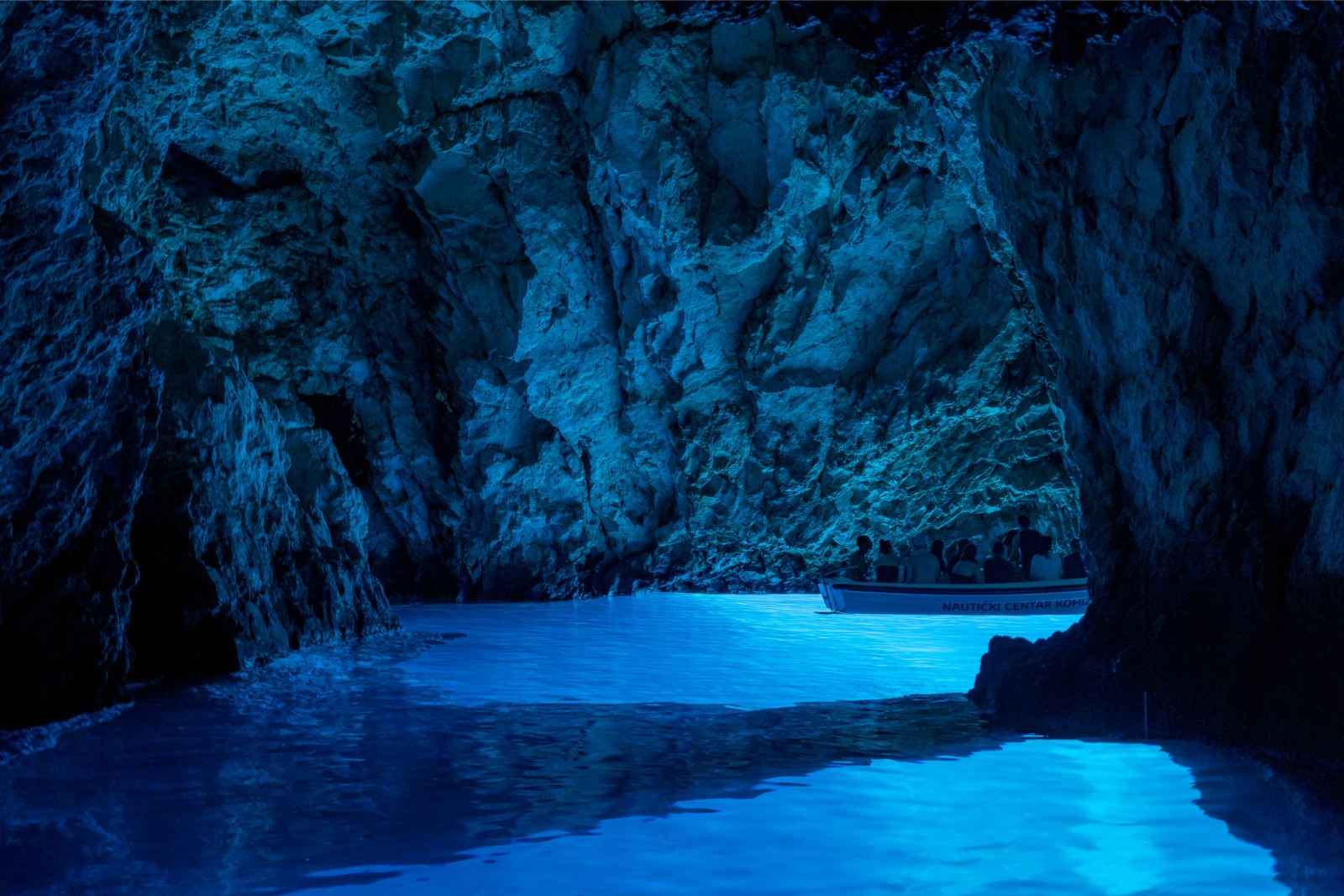
The Blue Cave is one of the most famous natural landmarks in Croatia, and a boat tour from Split is the perfect way to discover it. You’ll also see some of the nearby islands and discover a small slice of paradise known as the Adriatic Sea.
This stunning natural landmark is set in a small bay on the island of Bisevo. The cave gets its name from the blue light, which appears inside at certain times of day in sunny weather. This cave is accessible only by guided tours.
During the boat ride to the famous cave, you’ll also pass next to a few of the most famous islands in Croatia. Bra?, Hvar, and Vis are all along the way, and many guided tours even include a proper visit to the island of Vis.
- Insider Tip: Swimming is not allowed in the Blue Cave.
- Practical Information: Tours of the Blue Cave take place between April and October. The cost of tours from Split starts at 100€ and includes trips to nearby islands.
Another popular boat tour is a Blue Lagoon Cruise. Set sail along the Dalmatian Coast to three different Croatian Islands. Swim or snorkel in the Blue Lagoon and visit the white sand beaches and beach bars of Laganini Beach Club at the historic town and harbor of Trogir.
12. Take a Break at Bacvice Beach
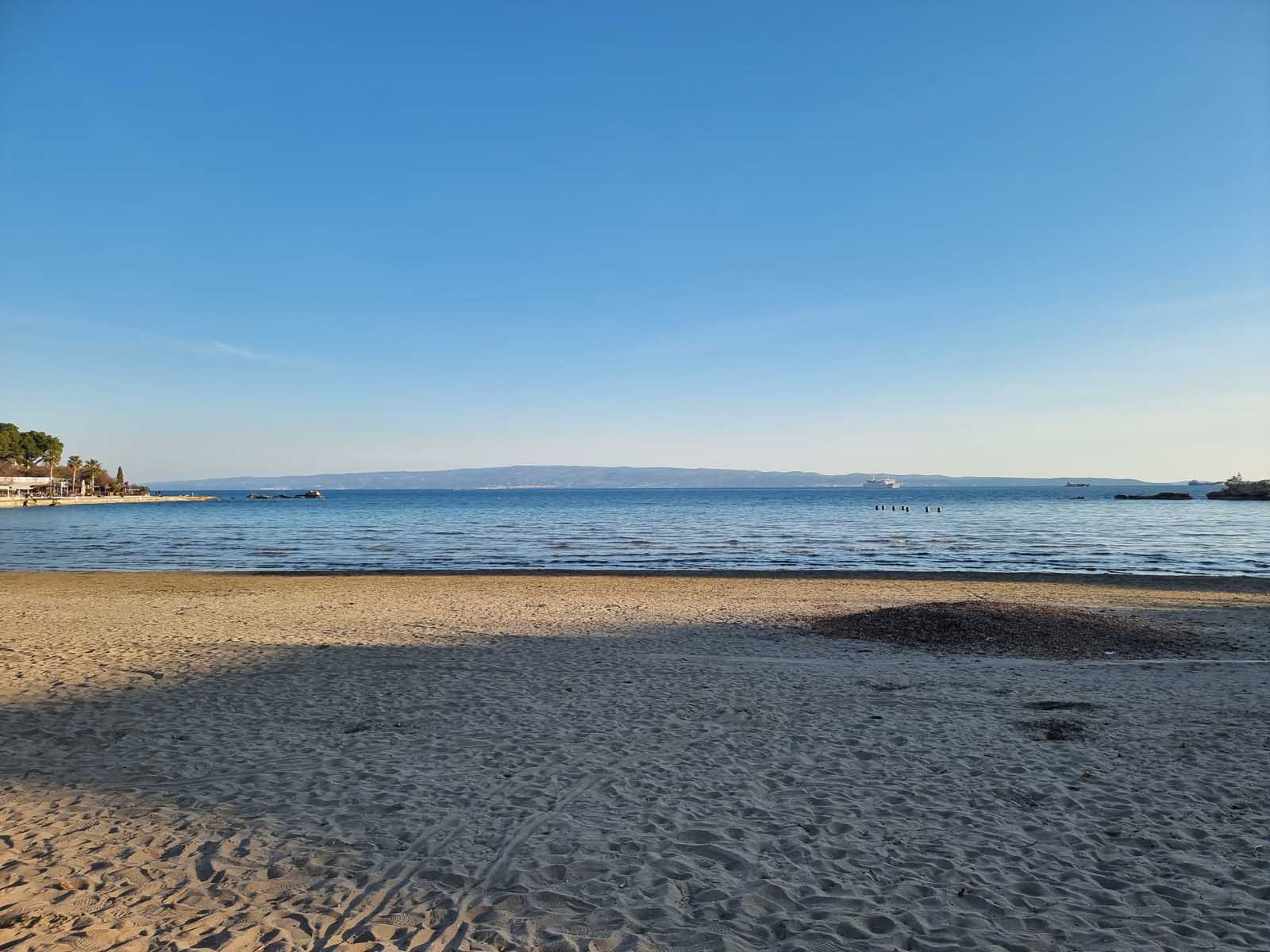
Bacvice Beach is just a 15-minute walk from the city center of Split. The sandy beach is known for its shallow waters, and it’s a perfect destination in Split for swimming and sunbathing. When I was there in March, some locals were swimming in the sea. I didn’t dare dip a toe in the water because it was icy cold, but apparently, it’s possible if you’re brave enough.
The beach is also popular for playing sports. Volleyball and even badminton are fun here, as long as it’s not too windy. Come here to relax, enjoy the views, and inhale that wonderful scent of salty seaside air.
Practical Information: Bacvice Beach is freely accessible 24/7. It’s a 15-minute walk from Diocletian’s Palace.
13. See The Diocletian Aqueduct
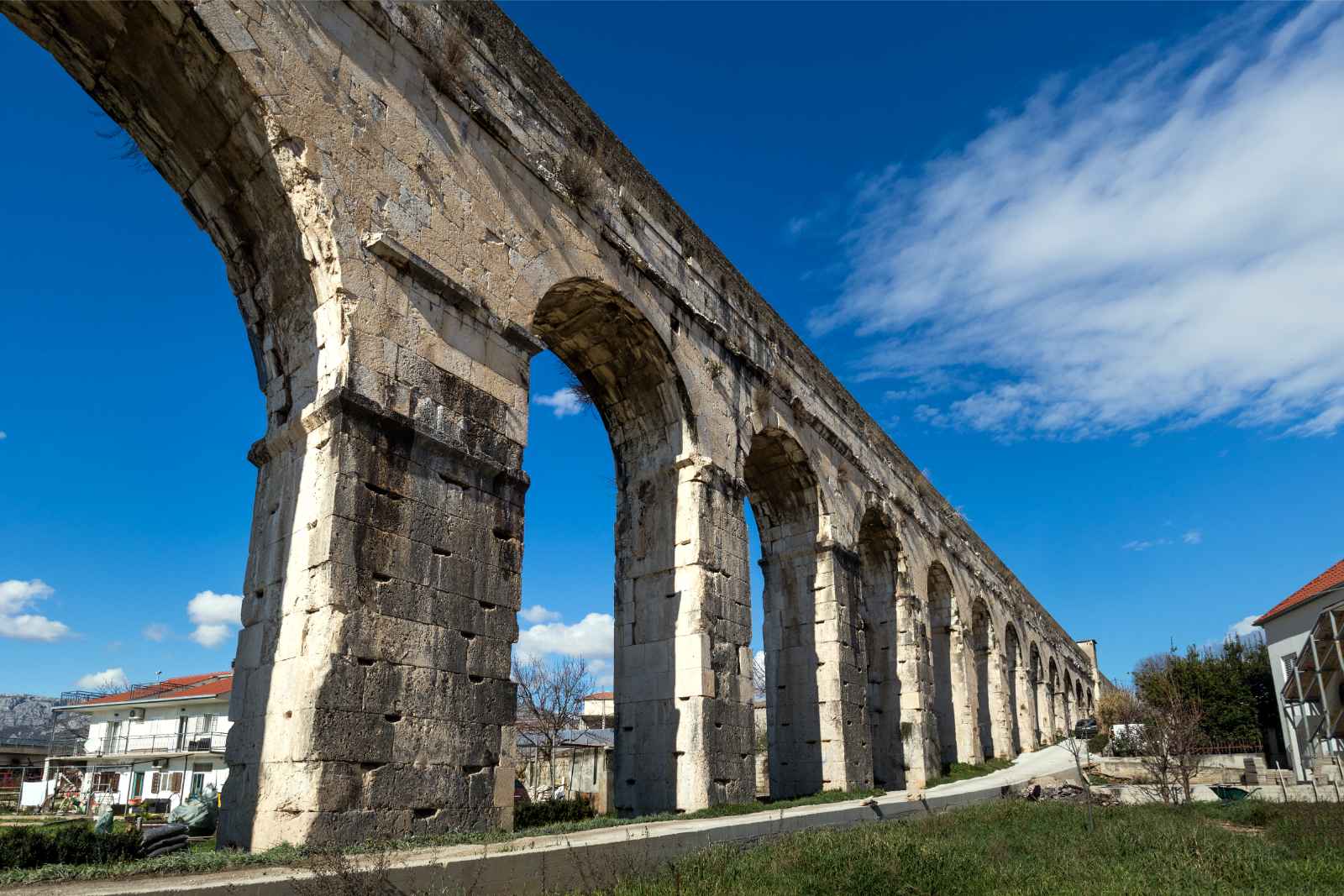
The Diocletian Aqueduct is another fascinating historic attraction in the city of Split. It was constructed at the same time as the palace, so between the 3rd and 4th centuries AD. The aqueduct is 9 kilometers wide and 16.5 meters tall, and it is impressively well-preserved for such an ancient landmark.
This is a proper Roman aqueduct. You’d expect to see something like this in Rome, Florence, or even Naples, but not in Split. And that’s what makes this such an impressive landmark and a must-see attraction while you’re in Split, especially for history buffs.
Practical Information: The Roman Aqueduct is situated 20 minutes from central Split by local buses. Access to the area is free of charge.
14. Discover The Local Cuisine
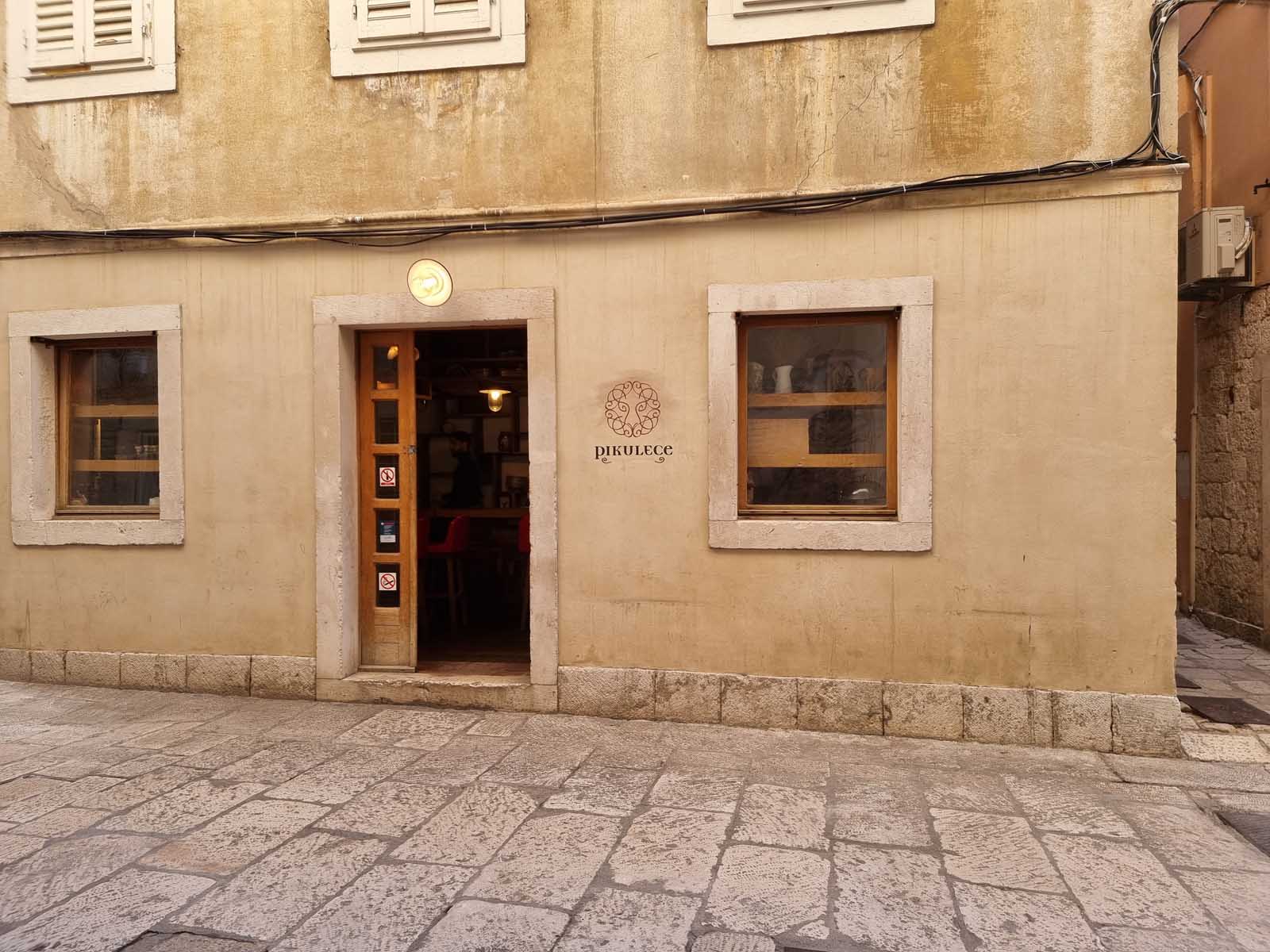
The food is one of my favorite things about trips to Split. It’s the best place in Croatia to discover Dalmatian cuisine, which is rich in seafood, olive oil, and pasta. If you enjoy Mediterranean cuisine, you will have the time of your life in Split.
And even if you don’t, this city won’t disappoint. Many restaurants have menus with dishes traditional in northern Croatia, which are hearty and heavy on meat.
The dishes I recommend you try in Split are the risotto at Corto Maltese, any grilled fish at Konoba Marjan, and Istrian pasta in black truffle sauce at Restaurant Bajamonti.
Practical Information: Many restaurants in Split are open all day, often from 8-10 AM until 12 AM. Reservations should be made in the peak season, but they’re not necessary in the off-season.
15. Go Inside Jupiter’s Temple
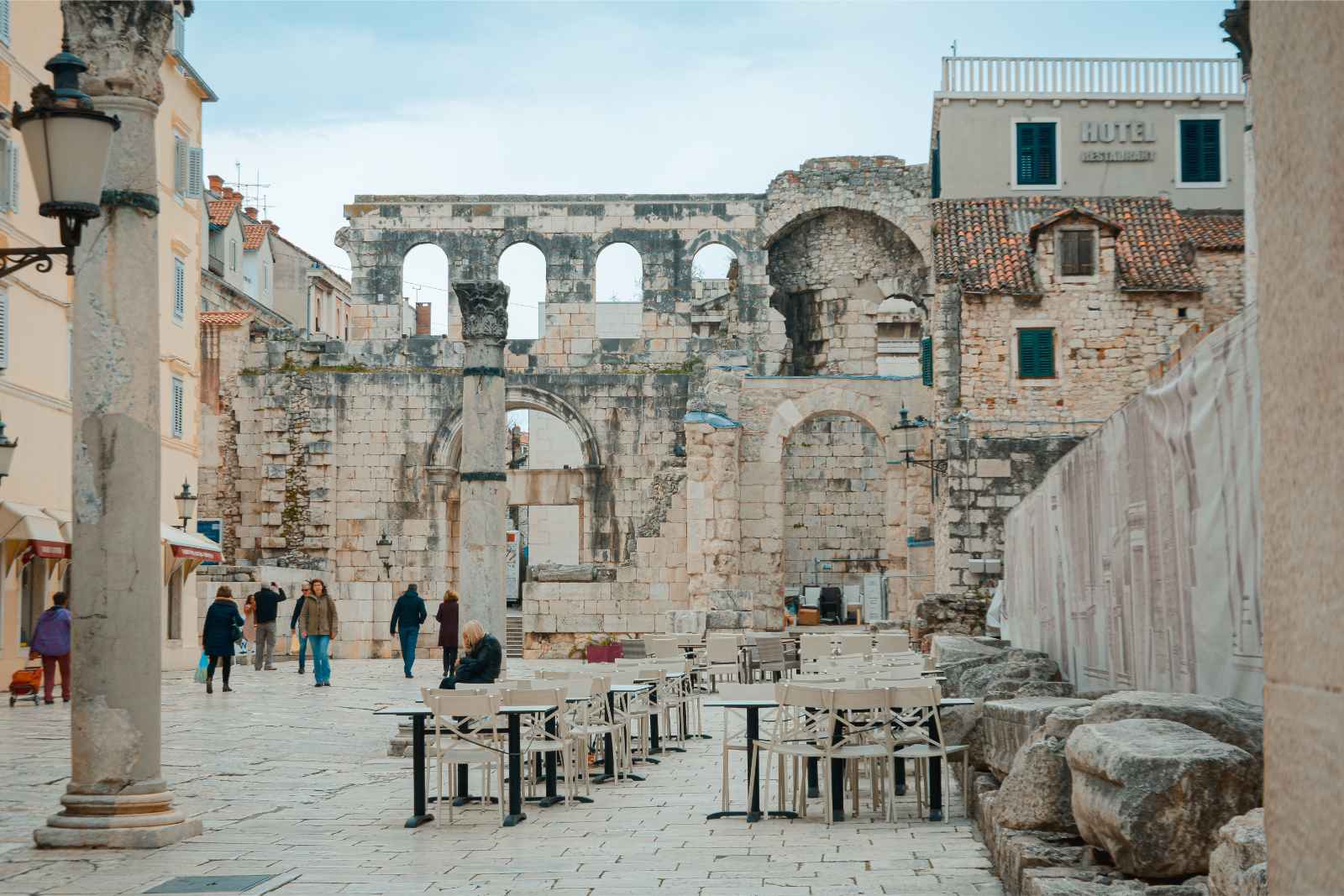
Jupiter’s temple is a small temple from the 3rd century with a modern statue of Jupiter inside. In front of the temple is a statue of the sphynx, similar to the one that stands guard at the entrance to St. Dominus. Cathedral.
The temple is small and hidden away in a narrow alley. It’s close to the narrowest alley in Split, named Let Me Pass, which is only 1.9 feet wide. Trying to pass through the alley is an adventure in its own right, even more so because it leads you to this historic landmark.
You’ll know you’re at the right place if you see a tall green double door. There’s not much to do inside except see the statue and admire the incredibly detailed carvings on the curved ceiling.
Practical Information: Jupiter’s Temple is accessible by anyone who purchases the purple ticket for the St. Dominus Cathedral and Bell Tower.
16. Visit Zadar
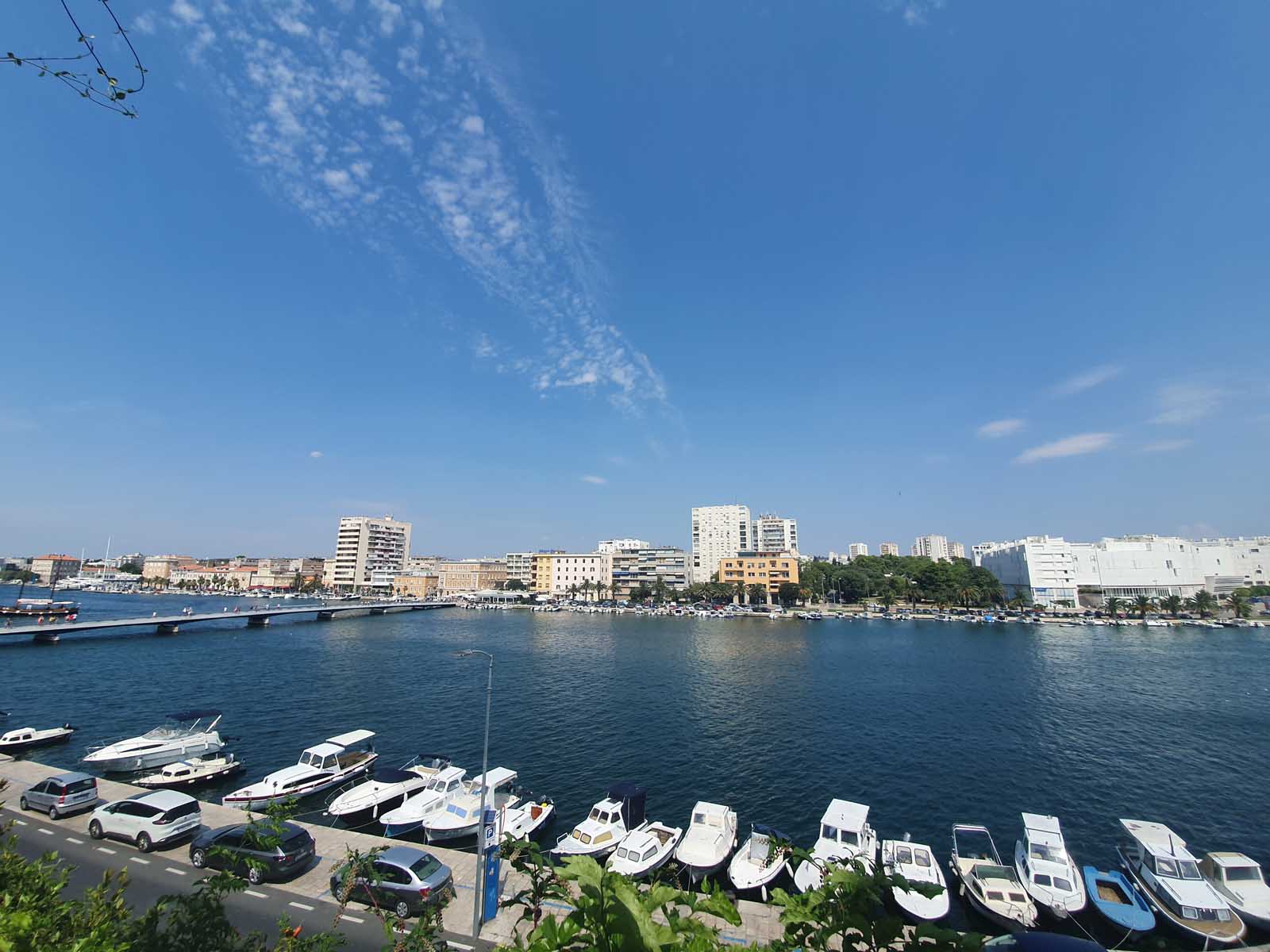
Known as the Pearl of the Adriatic, Zadar is one of the most beautiful cities on the coast of Croatia. With medieval buildings, a stunning old town, and some of the most famous landmarks in the country, Zadar is well worth the two-hour road trip from Split. This Zadar sunset tour takes you to all the highlights, including the Land Gate, Square of Five Wells, Church of St. Donatus, and Saint Anastasia Cathedral, and watch a fantastic sunset as you listen to the sea pipe organ.
The city has a gorgeous old town with countless historic buildings, but the star of the show is the Church of St. Donatus. Dating back to the 9th century, the imposing cathedral dominates the entire square in front of it. Just a couple of minutes from the cathedral are the Sea Organ and Greeting to the Sun, two of the most famous monuments in all of Croatia.
Zadar also has some excellent museums. The Museum of Ancient Glass offers exhibits on the history and archeological findings, while the Archaeological Museum of Zadar has a detailed exhibit on the finds excavated from the site of St. Donatus church.
Practical Information: Zadar is an hour and 45 minutes from Split by car, or two and a half hours by bus.
17. Visit The Froggyland Museum
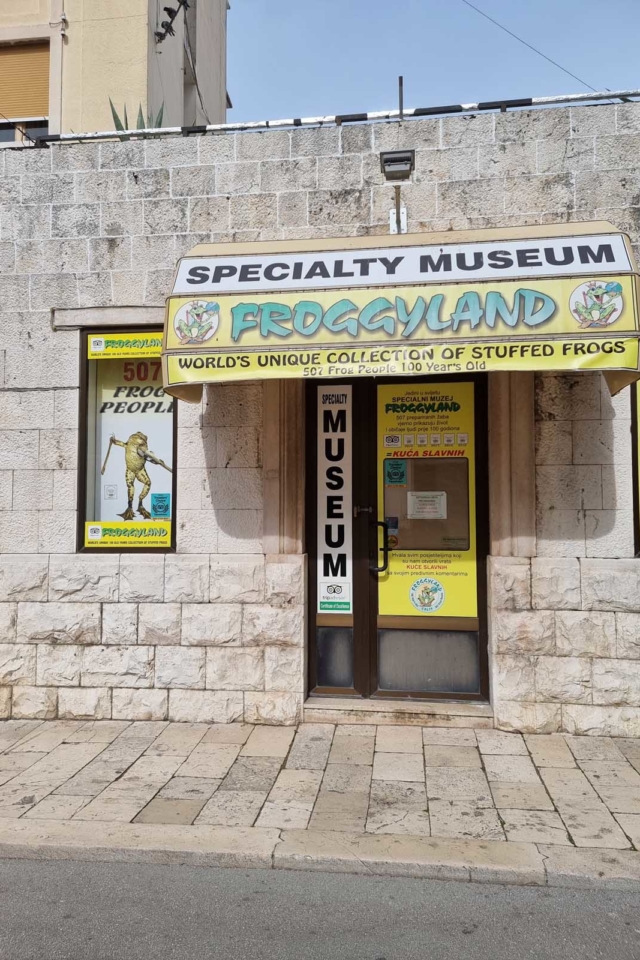
The Froggyland is the weirdest museum in Split, possibly even wider. To my huge disappointment, the museum was closed when I was last in Split, so I haven’t actually had the chance to see the exhibit live. But I’ve looked through all the photos, and it’s at the top of my list for my next trip to Split.
At this museum, you can see 20+ dioramas of miniature frogs in all sorts of scenarios. Frogs as politicians, poker players, and even warriors. It is incredibly bizarre and utterly fascinating at the same time, and I highly recommend this museum to anyone who enjoys things that are out of the ordinary.
Froggyland is particularly popular with children, and it’s one of the best things to do in Split if you’re traveling as a family.
Practical Information: Froggyland Museum is open from 10 AM until 10 PM between April and November.
18. Attend a Local Wine Tasting
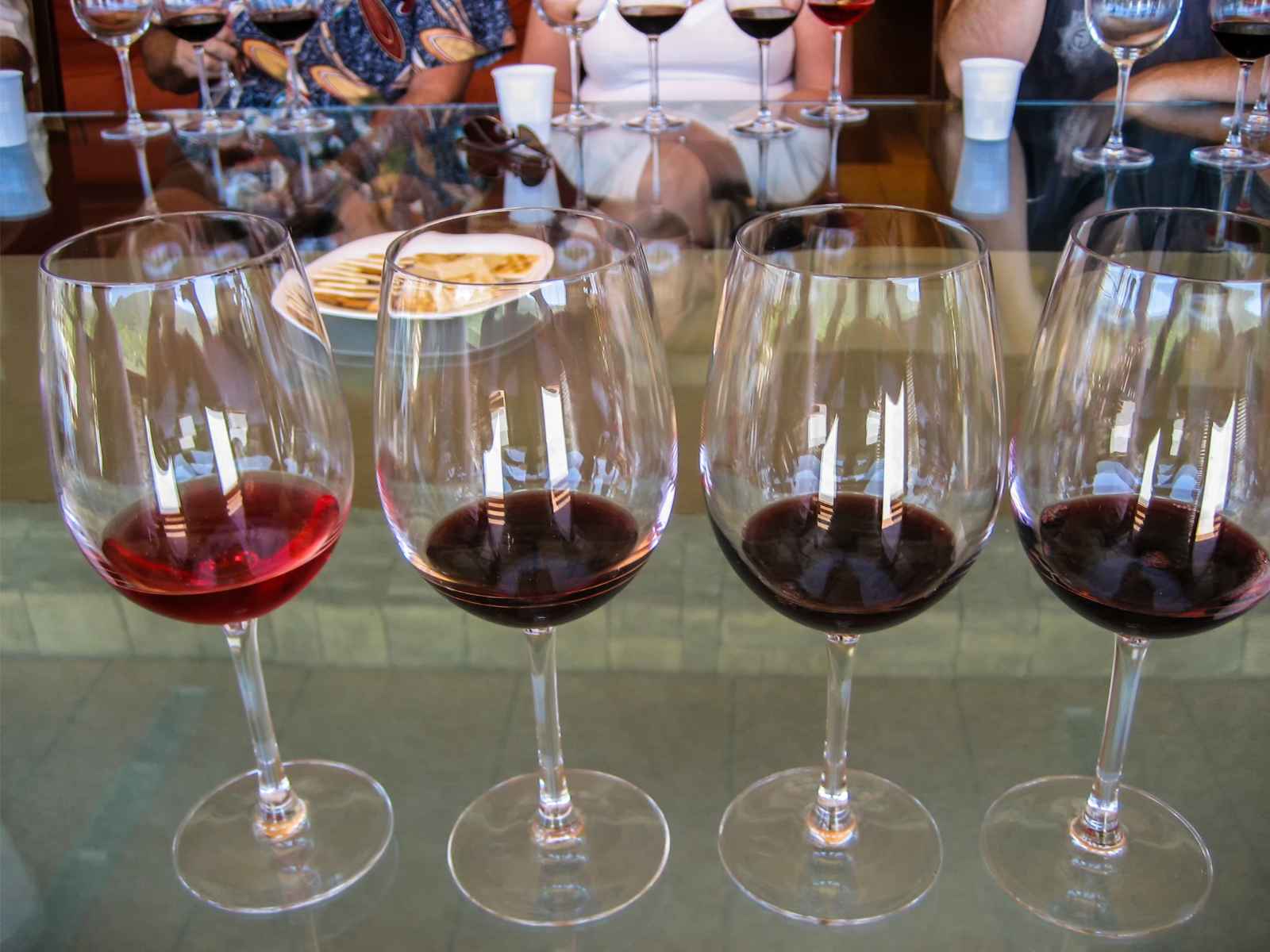
The mild Mediterranean climate of Croatia has proved perfect for the production of olive oil and wine. Most of the country’s best wineries are in the northwest region of Istria and in the south, particularly in the area of the Peljesac peninsula.
When you visit Split, attend a traditional wine tasting to sample fine Croatian wine in one of the countless restaurants and bars throughout the city. These often include 2-3 glasses of the most popular local wines and usually some snacks. You can also just walk into any store in Split and buy a bottle of delicious local wine.
But what I would recommend is a tour of the only winery in the city of Split. Divina Vina is a winery situated in a war bunker underneath an apartment building. Yes, you’ve read that correctly; it’s a weird location, but they offer tours and tastings, and you don’t even have to make a reservation.
Practical Information : Divina Vina Winery doesn’t have set working hours. It’s best to contact the owner, Ivan at +385 (0)97 7762 407 to inquire about tastings and tours.
19. Tour Diocletian’s Cellars
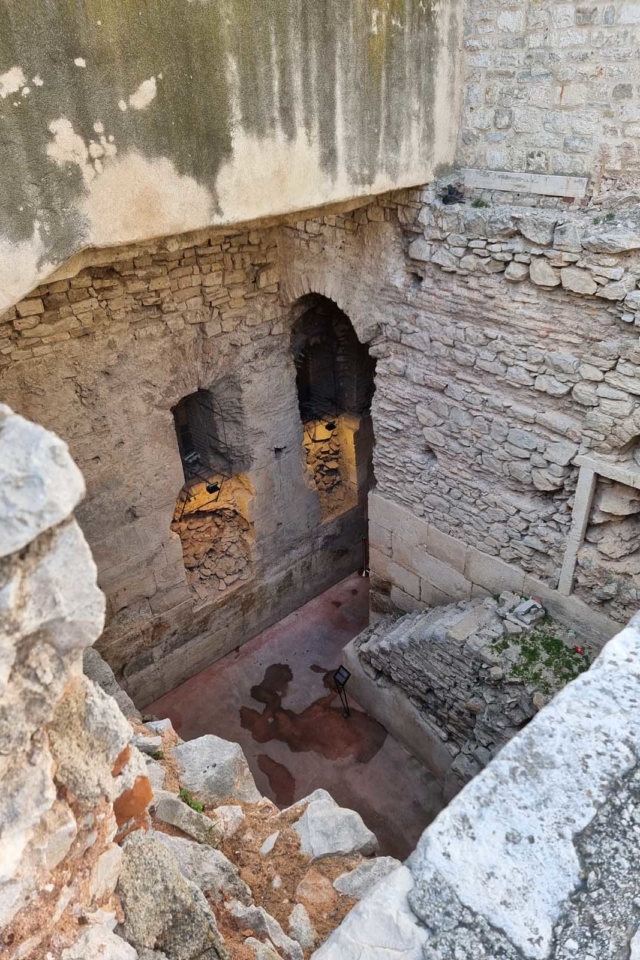
The underground of the Diocletian’s Palace is open for public tours, and it’s one of the top attractions in Split, especially on hot summer days. It’s much colder in the cellars than outside, making them a popular destination for people seeking shelter from the sun.
Enter the Diocletian’s Palace through the gate on the lower end of the seaside promenade, and the entrance to the cellars will be to your left. This is the one attraction in Split that I wanted to do but didn’t because of the museum’s short working hours. But I swear, the next time I’m in Split, this is my first stop, and it helps that they’ve adjusted their operating hours since my last visit.
The Palace Underground is incredibly well preserved and is partially responsible for the inscription of Split’s historic center on the UNESCO World Heritage Site list. Parts of the Cellars were inhabited during the Middle Ages, while other chambers housed tools for the production of olive oil and wine.
Practical Information: Dioceltian’s Cellers are open every day from 9 AM until at least 6 PM. Between May and October, they’re open until 8 PM. The entrance fee is 7€.
20. See the Fortresses in Šibenik

Situated just an hour outside Split, Šibenik is another splendid historic city on the Adriatic coast. It’s only 20 minutes from the Krka National Park, and you can easily visit both places during a day trip.
This stunning town is known for its historic old town with no less than 2.851 steps, four spectacular fortresses, and easy access to Kornati National Park. I recommend visiting the Barone Fortress. It has a cafe/bar, and you can sit down and sip on some delicious Croatian wine while admiring the panoramic views of the sea and St. Nicholas Fortress.
Don’t miss out on the Cathedral of St. James, either. The imposing church was completed in the early 16th century, and it is a UNESCO World Heritage Site.
Practical Information : Šibenik is an hour’s drive from Split or a 90-minute bus ride. Book this highly rated tour that includes Split & Trogir: Krka Waterfalls, Šibenik, and Primošten.
21. Skywalk Poljud
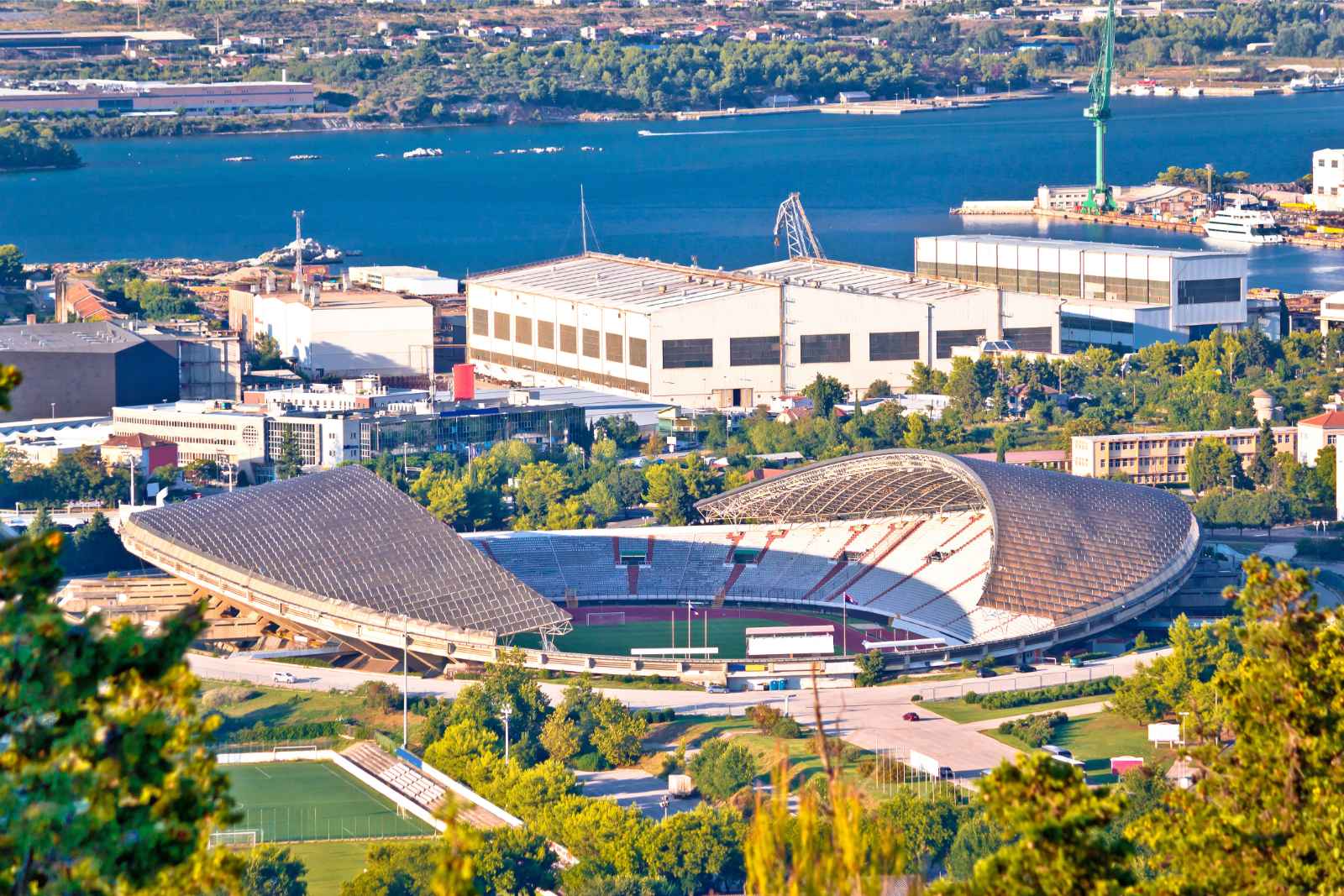
Head to the Poljud stadium in the northern area of Split. It’s far from the city center but easily accessible by local buses.
Skywalk Poljud is an adrenaline tour that includes walking on the roof of the stadium, followed by a rope swing. You jump from underneath the roof and swing on a 70-meter rope. It’s the most exciting thing to do in Split and an absolute must for all travelers who are always looking forward to the next adrenaline rush.
Practical Information: Skywalk Poljud tours last for 90 minutes and are priced at 70€. Inquire about available tours via email at [email protected] .
22. See The Old Town Hall
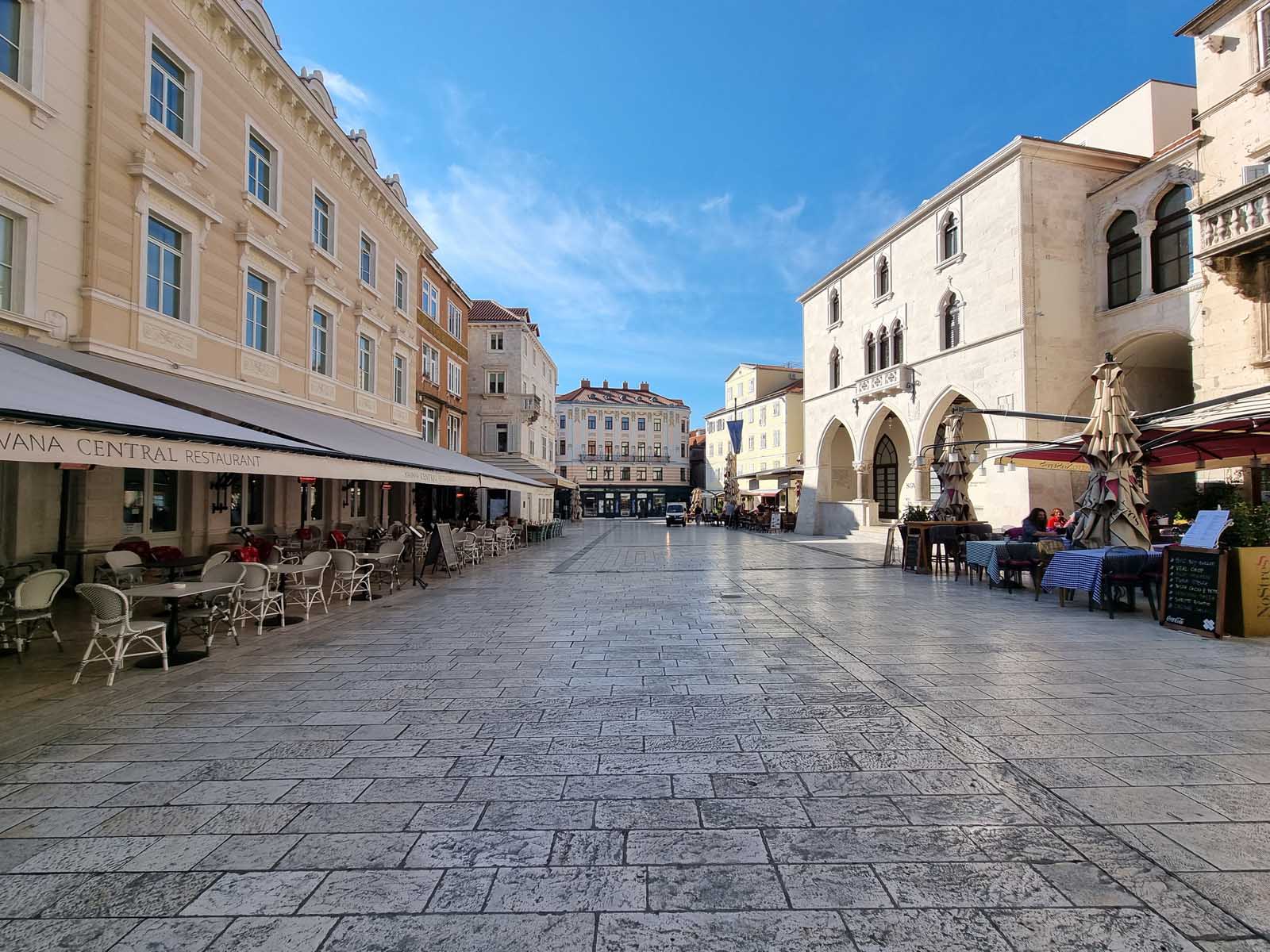
The Old Town Hall is situated in the heart of Diocletian’s Palace, recognizable by its Gothic-style windows. It was originally constructed in the 15th century, and in 2021 the building was renovated. It now looks immaculate and hosts temporary art and photography exhibitions.
Spot the building during a standard walking tour of Split and go inside if there’s an exhibition while you’re there. Local artists are often promoted at the Old City Hall, and it’s an opportunity to discover some unique and interesting Croatian art.
Practical Information: The Old City Hall is situated at the People’s Square in the heart of the old town. It’s open from 9 AM until 9 PM.
23. Croatian Maritime Museum
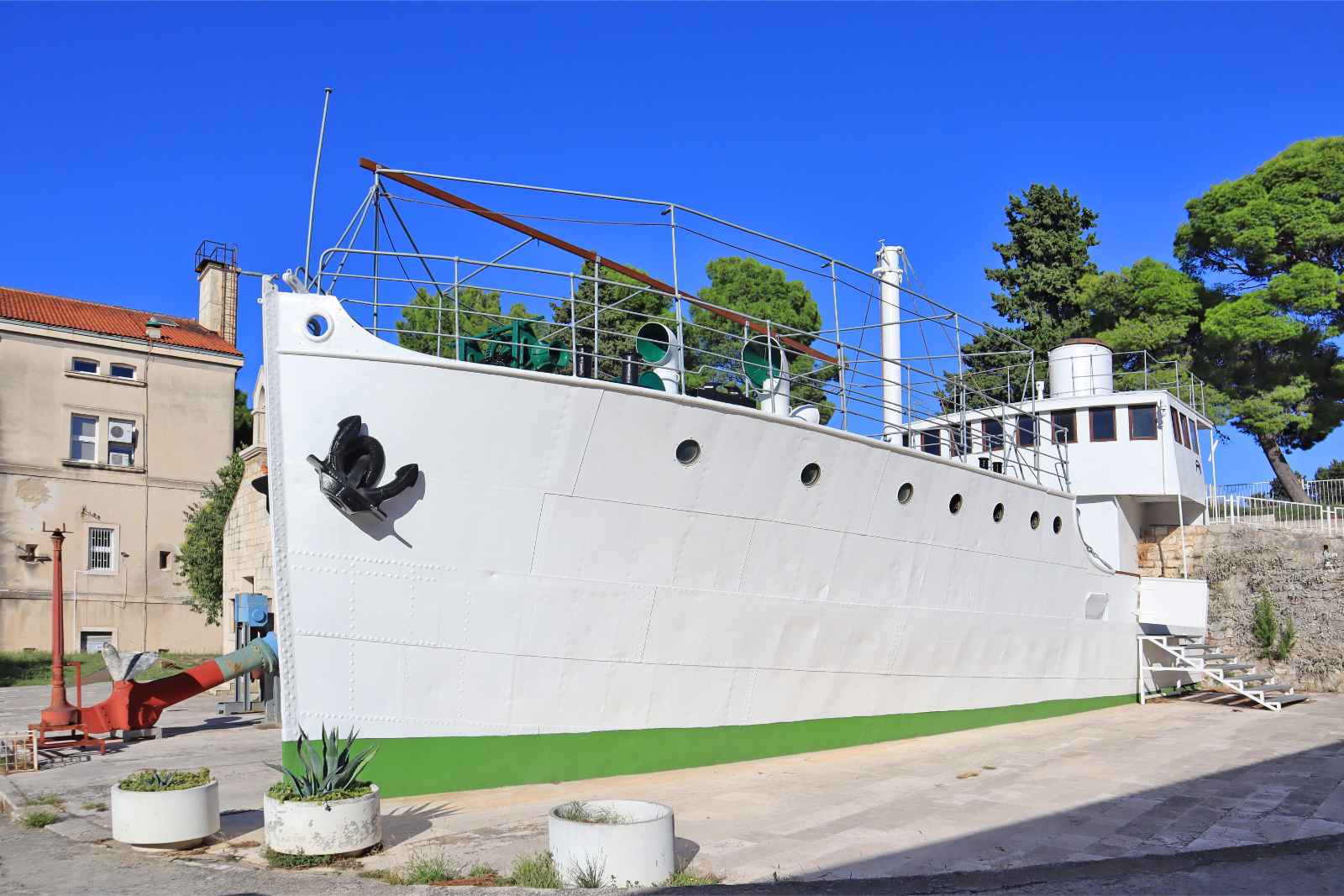
The Croatian Maritime Museum in Split was founded in 1925, and since then, it has housed an exhibit on various maritime art and relics. There’s also a life-sized ship inside the museum, making it a must-see attraction for anyone interested in this industry.
The museum exhibit includes replicas of famous ships from history, as well as tools used in shipbuilding. Weapon systems traditionally used on warships are also part of the museum collection.
Practical Information: The museum is open from 9 AM until 5-8 PM, depending on the season. Tickets are 3.50€.
Frequently Asked Questions
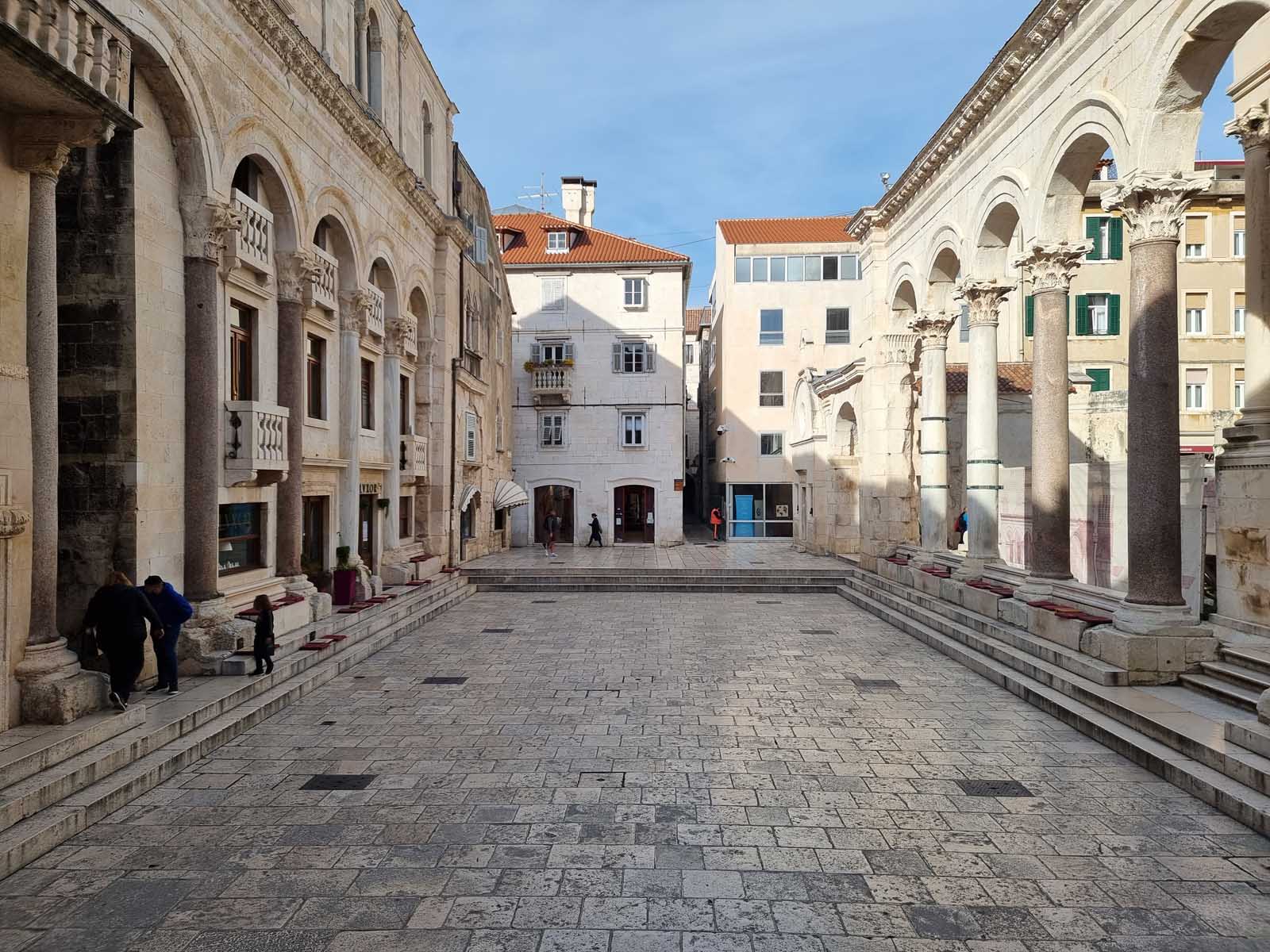
Is Split In Croatia Worth Visiting?
Yes, Split in Croatia is absolutely worth visiting. The historic town features many interesting attractions and landmarks, as well as easy beach access and beautiful nature.
What Is Split Croatia Best Known For?
Split in Croatia is best known for Diocletian’s Palace. Its old town is entirely situated within the palace walls, which was initially constructed as a summer residence for Roman emperor Diocletian.
Why Is Split Croatia So Popular?
Split is a popular destination because of its medieval historic attractions, excellent food, and beaches. The city’s popularity increased even more after it was prominently featured in the Game of Thrones TV show.
How Many Days Do I Need In Split?
You need at least 2-3 days in Split. That’s enough time to see the top landmarks in the city and do a half-day trip to a nearby town. Plan a stay of 5-7 days if you want to explore multiple national parks and towns on the Dalmatian coast.
Tips and Information For Visiting Split, Croatia
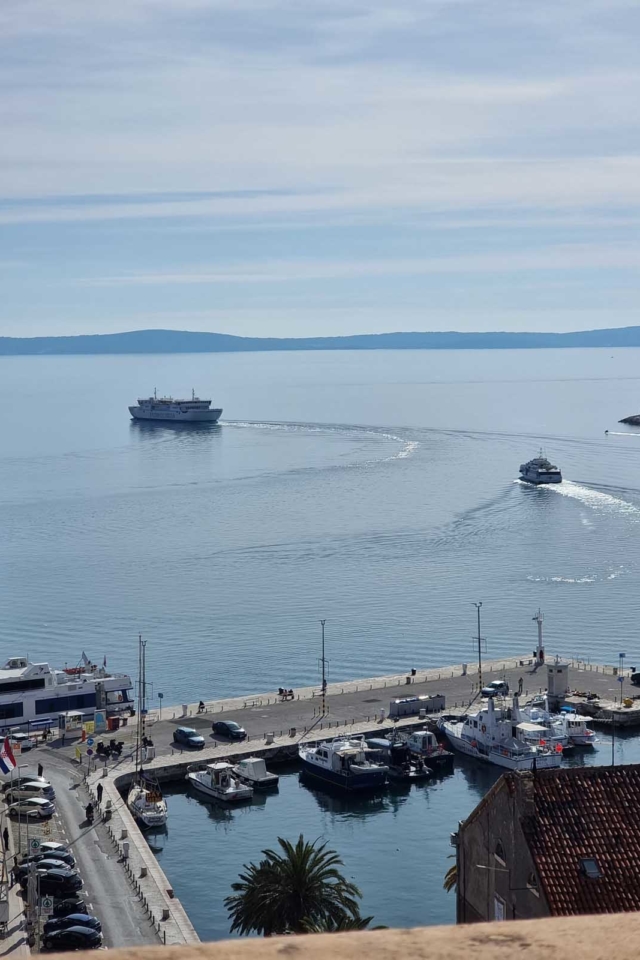
Best Time to Visit
The best time to visit Split is either spring or fall. The seaside town is very popular in the summer, which translates to huge crowds everywhere you go. Croatia is notoriously expensive in the summer season and the prices in restaurants and hotels triple in July and August. And don’t even get me started on the stench of sulfur on the promenade, which is only intensified in hot weather.
We went in March and had a great time. There were still tourists in the city, including a massive cruise ship, but the crowds were still manageable. There were no queues for popular attractions and museums, and we easily found available tables at restaurants without any reservations. Oh, and we paid around 30 Euros per night for a cute apartment five minutes from the old town.
Getting There
The airports in Split and Zadar have some of the best international connections in Croatia, so it’s likely you can land at one of them. Split Airport is just outside the city, and Zadar Airport is approximately three hours from central Split, with bus transfers.
Ideally, you would land at Split Airport. A local bus can take you from the airport to the main bus station in town, and from there, you can take a taxi or a different bus to your hotel.
Getting Around
Walking is the best way of getting around Split. All the famous landmarks and tourist attractions are located near the old town, so you can easily walk everywhere in no more than 15 minutes. Local buses can take you to parts of Split outside the city center, and rideshare scooters are available in multiple places throughout the city.
Car rental is your best option for day trips because it’s much quicker than the bus. You’ll save a lot of time if you drive, but buses to the nearby towns and national parks exist and are available to travelers who don’t have access to a car in Split.
How Much Time Do You Need For Split
We stayed in Split for three days, and it was just the right amount of time to see most of the things in town and do a quick day trip. I recommend a five-day stay if you want to see Plitvice and Krka national parks because those destinations take an entire day each.
For sightseeing around the Split old town and a half-day trip to Trogir, three days is plenty of time.
Where To Stay in Split, Croatia
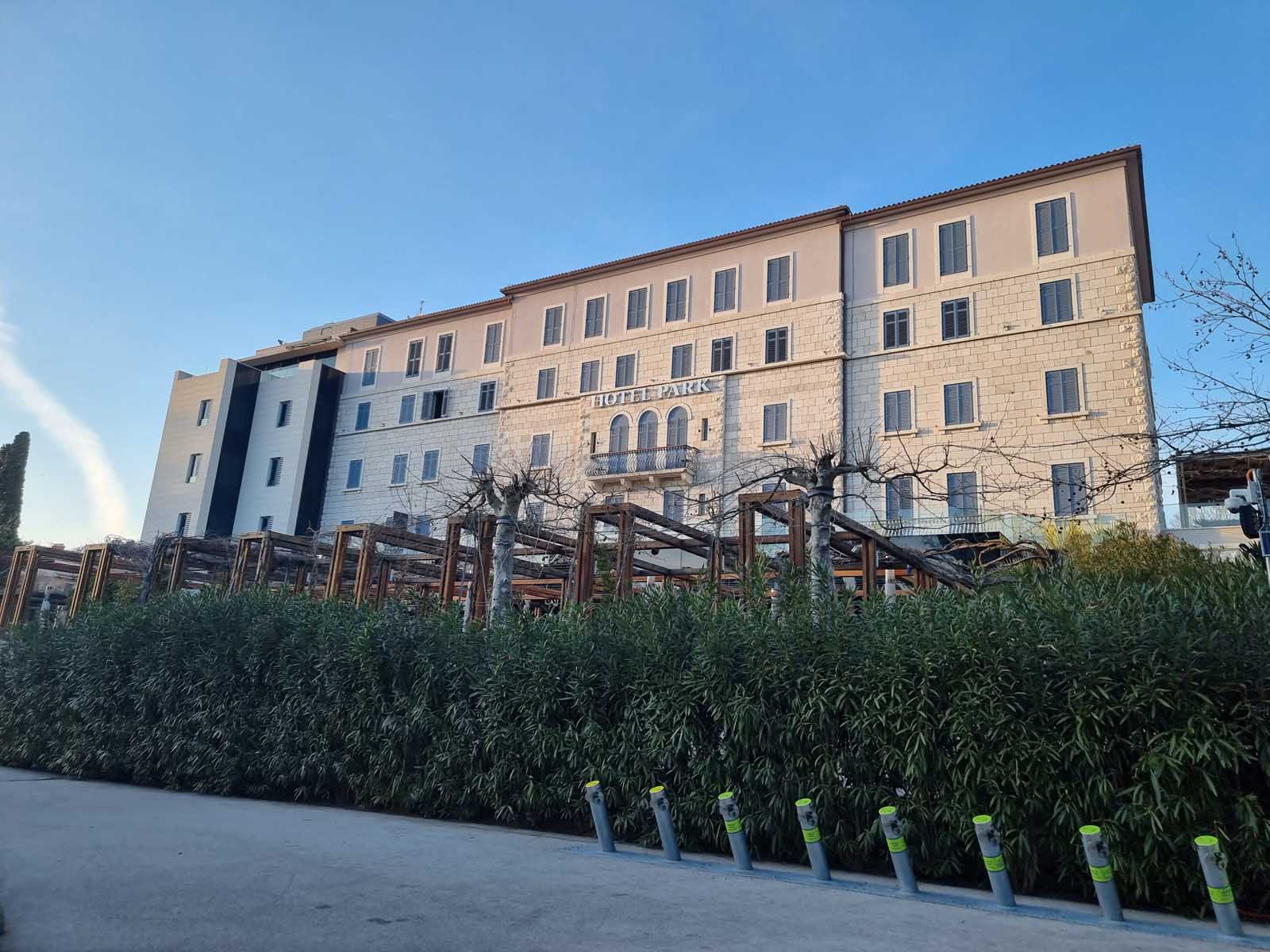
The tourist attractions in Split are all in the historic center, so it’s best to look for hotels that are within walking distance of the old town. Bacvice is a great neighborhood to stay in because it’s very close to the old town but still much more quiet than the hotels within the walls of Diocletian’s Palace.
Personally, I would avoid accommodation within the palace walls. The crowds and noise will keep you up at night, plus they’re much pricier than hotels just five minutes from the center. Here are some of the best hotels in Split for all budgets:
- We Collect Umbrellas is an affordable apartment. It’s where we stayed during our trip to Split, and we chose it for the excellent location just five minutes from the old town.
- Hotel Luxe is a good mid-range hotel close to the city center with comfortable beds in clean and spacious rooms.
- Hotel Park is a top-rated five-star hotel in Split. It’s close to the beach and a 15-minute walk from Diocletian’s Palace.
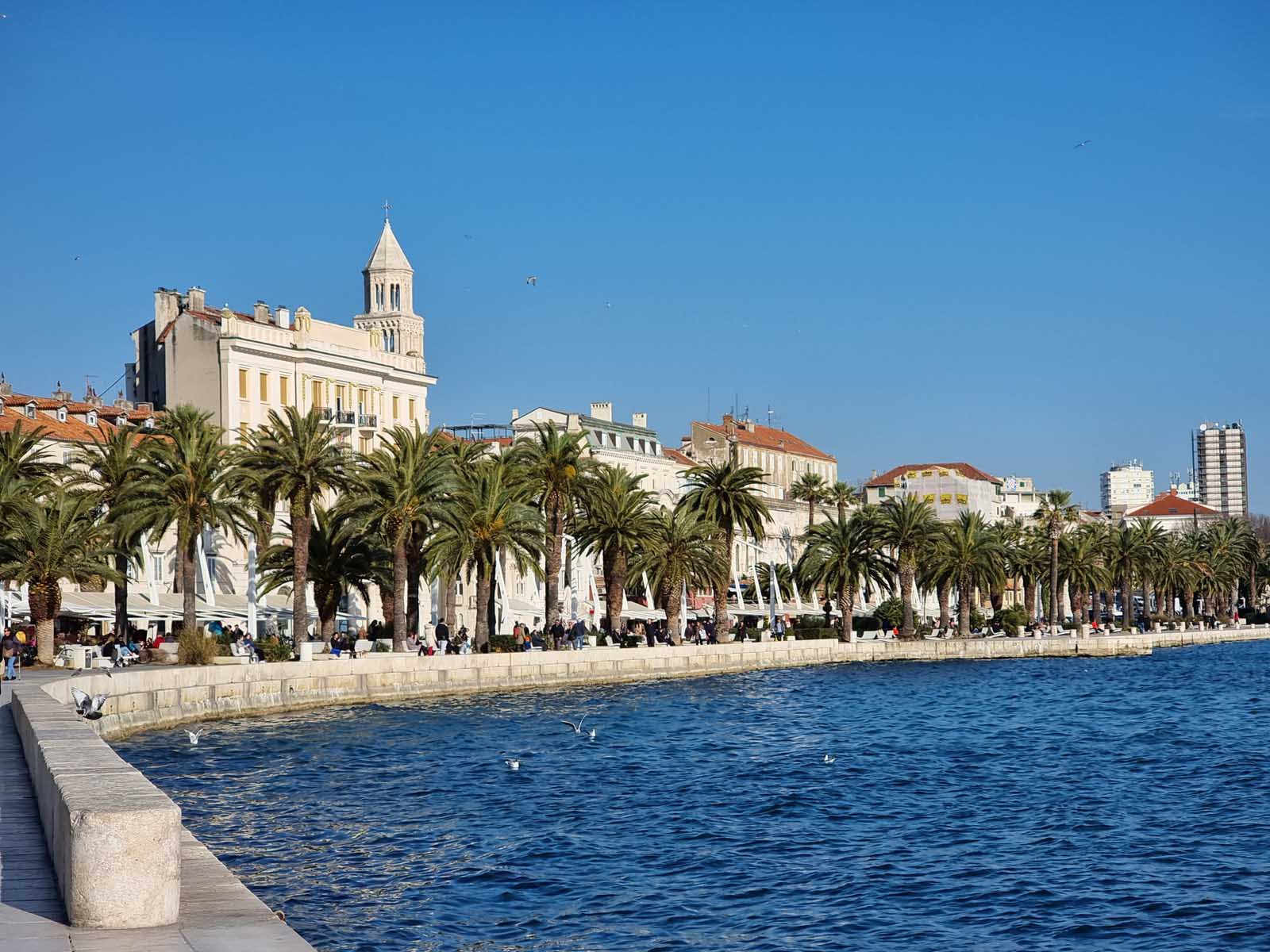
Whenever you travel to Split, you’ll have a good time. In the summer, you’ll be able to jump in the sea to cool down for the moment, but in the winter, you’ll get to experience the Christmas Market on the seaside promenade. Spring and fall offer the opportunity to discover all the landmarks and attractions without standing in queues and overpaying for accommodation.
So, the only thing left to do is to book your plane tickets and hotel. Hopefully, this guide to the best things to do in Split helped you figure out what you want to experience in this stunning seaside city.
Plan Your Next Vacation To Croatia With These Resources:
- 14 Best Luxury Hotels in Dubrovnik, Croatia
- 20 Best Islands in Croatia to Visit
- Beautiful Croatia – The 20 Best Things to See and Do
22 Best Things to do in Dubrovnik, Croatia
- Game of Thrones Filming Locations You Can Visit in Real Life
- Best Places to Visit in Europe
Travel Planning Resources
Looking to book your next trip? Why not use these resources that are tried and tested by yours truly.
Book Your Flights: Start planning your trip by finding the best flight deals on Skyscanner. We have used them for years and have found that they have the best flight deals.
Book your Hotel: Find the best prices on hotels with these two providers. If you are located in Europe use Booking.com and if you are anywhere else use TripAdvisor.
Find Apartment Rentals: You will find the cheapest prices on apartment rentals with VRBO .
Travel Insurance: Don't leave home without it. Here is what we recommend:
- Safety Wing - Occasional Travelers.
- Medjet - Global air medical transport and travel security.
Book Your Activities: Looking for walking tours, skip-the-line tickets, private guides, and more? Then we recommend Get Your Guide.
Need more help planning your trip? Make sure to check out our Resources Page where we highlight all the great companies that we trust when we are traveling.
You May Also Like
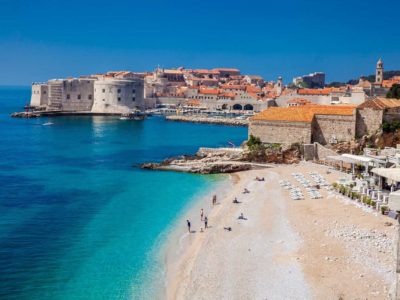
14 Best Luxury Hotels in Dubrovnik, Croatia In 2024
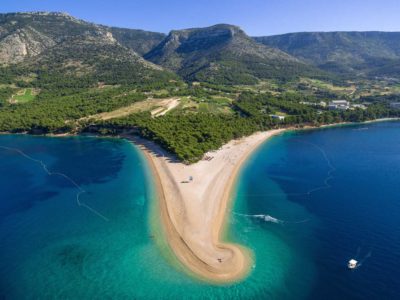
20 Best Islands in Croatia to Visit in 2024
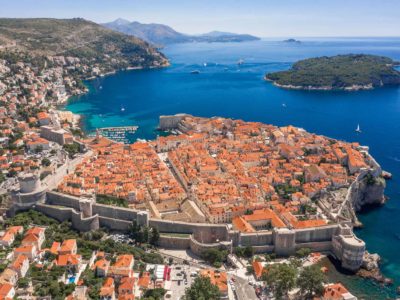
About Sara Oprasic
Sara loves writing about travel as much as she loves traveling. In her spare time, she enjoys reading, spending time with her cats, and crossing items off her bucket list. She’s yet to cross off Japan, Tromsø, and Hogsmeade. You can see what she’s up to on her Instagram Page
Join thousands of others who get our monthly updates!
Leave a comment cancel reply.
Save my name, email, and website in this browser for the next time I comment.

Amazing Things To Do In Split, Croatia (Travel Guide)
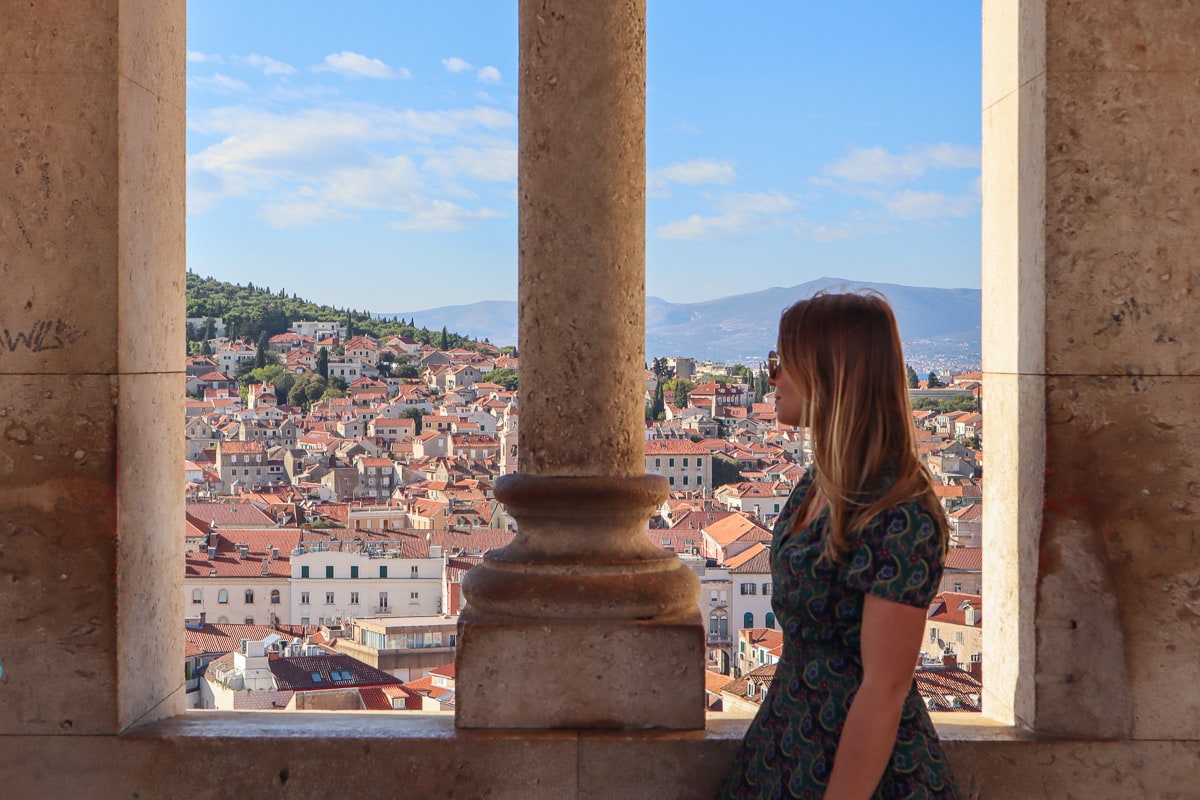
I’ve just got back from an incredible city break to Split in Croatia. Come and find out all the best things to do, including where to catch the best views, where to eat, day trips and more in my handy Split travel guide!
People often ask me what my favourite countries are, and Croatia is ALWAYS in my top 5. I just love it there. Why do I think it’s so special? For starters, the colour of the water, the incredible landscapes, the ancient cities, the islands… and so much more. It’s no wonder I’ve been every year for the past four years.
I’ve visited Split once before, but only had a day there. This time I visited for three nights and enjoyed a city break with the perfect balance of adventure and relaxation.
Check out my video, then scroll down to find out all about planning the perfect Split city break!
Why Visit Split, Croatia?
With its stunning old town AND a pretty coastline peppered with picturesque islands, Split makes the perfect holiday for those wanting a mix of city and beach. The city itself is one of the most historic in all of Croatia, with Diocletian’s Palace dating back to the 4 th Century. Plus, the food scene is great too, with fresh Mediterranean produce, and delicacies including Istrian truffles on menus across the city.
While tourists and cruisers flock to the city in the summer months, it’s worth considering visiting Split in September – October or spring. The weather is still warm and sunny, plus prices are considerably lower.
To help you plan your trip, it’s time for me to reveal a few of my favourite places and top things to do in Split.
Before you go: Don’t forget to take out travel insurance. It’s important to be covered in case of a medical emergency, or losing items during your trip.
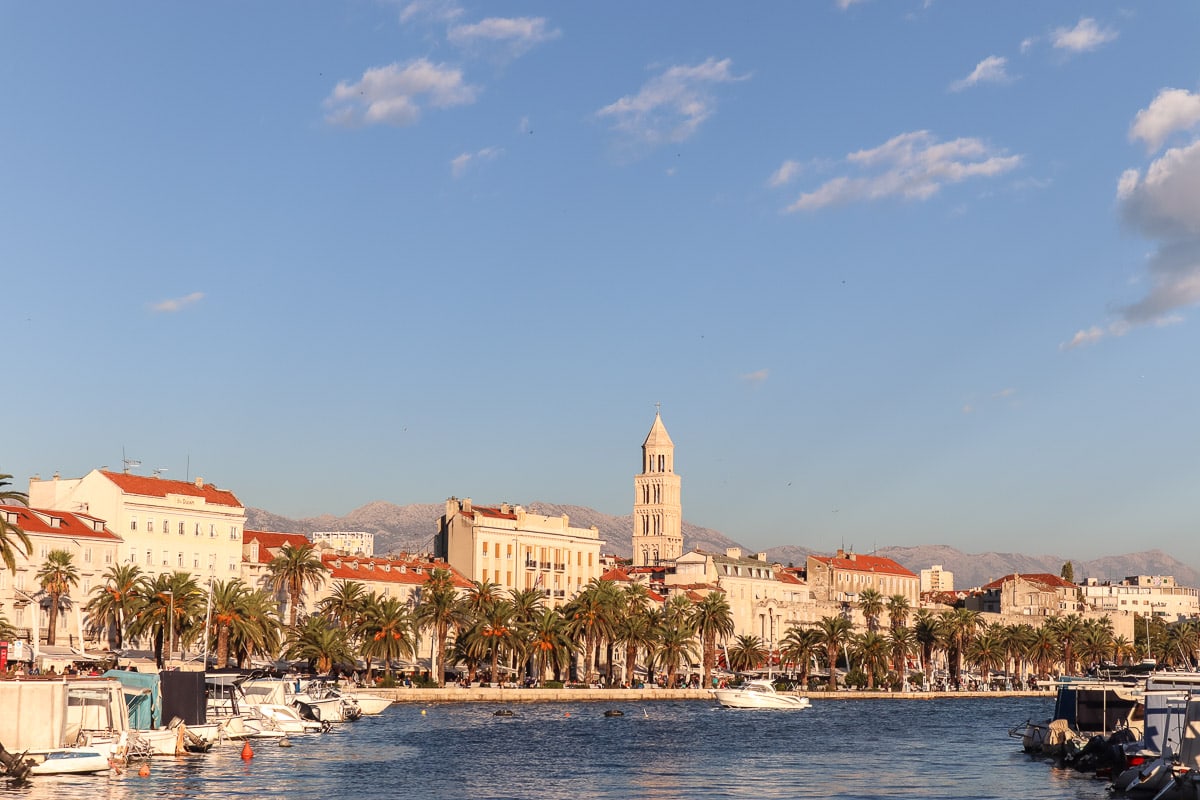
Split, Croatia: Top Things To Do In The City For The Best Holiday Ever!
Explore the city on foot.
Split is a very walkable city, so I’d recommend spending a morning exploring the beautiful old town. No doubt you’ll get lost in the skinny streets, but sometimes that’s when you discover something really special!
View this post on Instagram A post shared by Chloe Gunning ??? (@wanderlustchloe) on Oct 31, 2018 at 12:16pm PDT
Along with historic architecture, ancient ruins and pretty houses, there are cafes, restaurants and shops tucked away. Grab some sweets from pirate-themed Candy Treasures, shop for Croatian delicacies including olive oil, truffles and cheese, and don’t forget to buy a few souvenirs to take home too.
The Riva is Split’s waterfront promenade, and another stunning area to explore. With huge palm trees, smart restaurants with outdoor seating and boats bobbing on the water, it’s one of the prettiest places in Split.
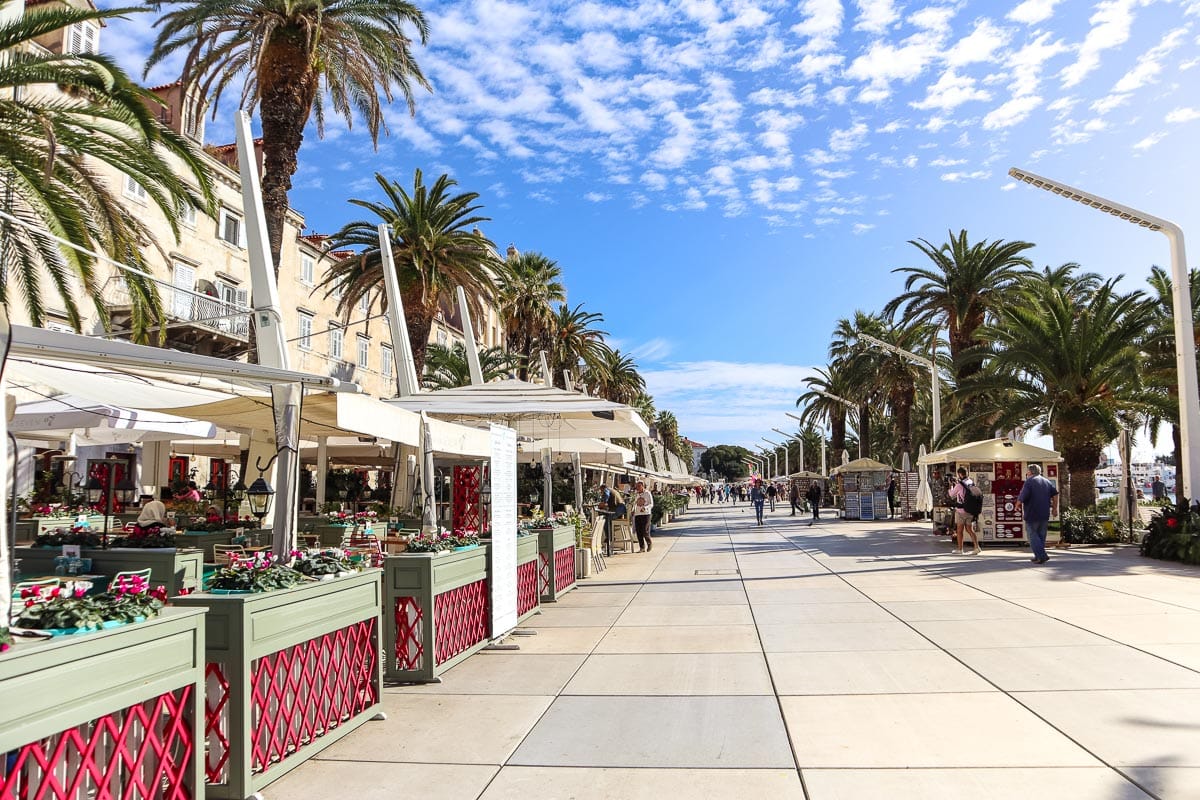
Climb Marjan Hill For The Best Views Of Split
Whooaaaa isn’t Split photogenic?! I could barely walk more than ten paces before reaching for my camera. For me though, the views from Marjan Hill are the best in the city.
It’s a steep, tiring climb up, but 900% worth the effort. Head towards the giant flag on top of the castle-like platform at the top. There’s a café on a terrace about half way up, but I’d save that as your reward on the way down!
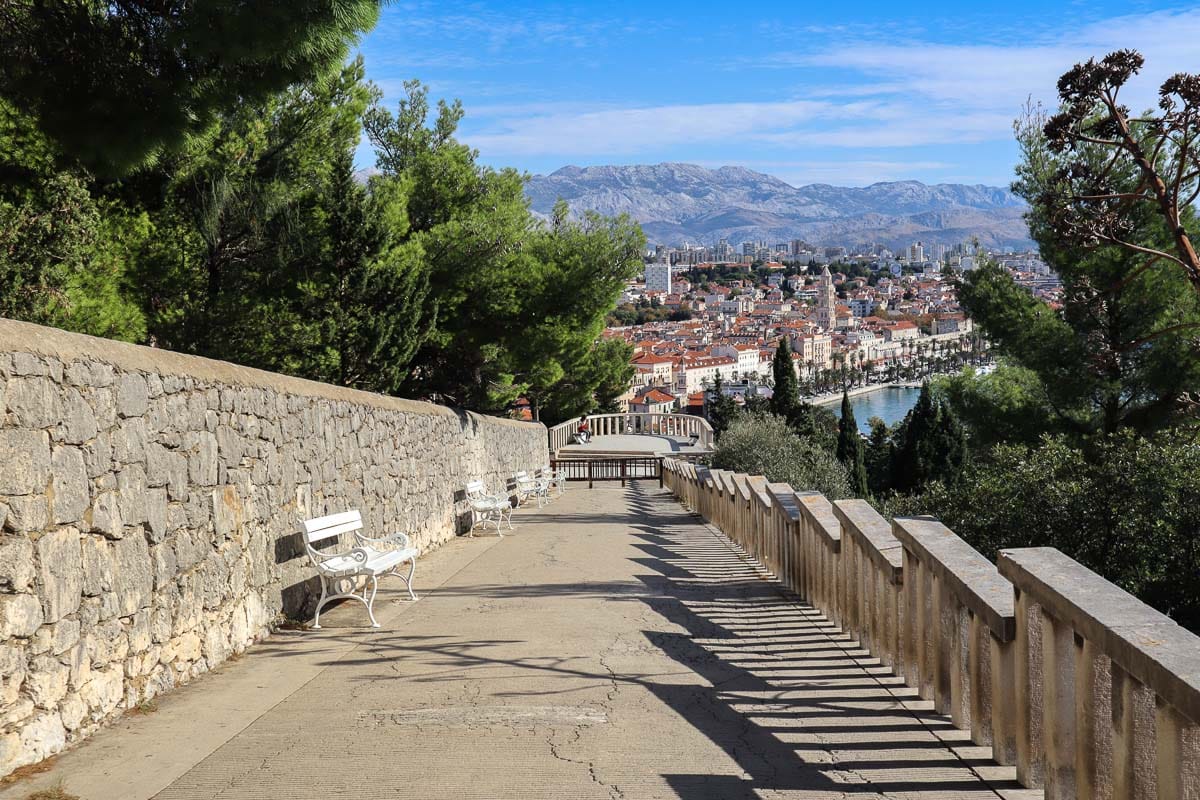
The climb to the top of Marjan Hill is without doubt one of the best free things to do in Split!
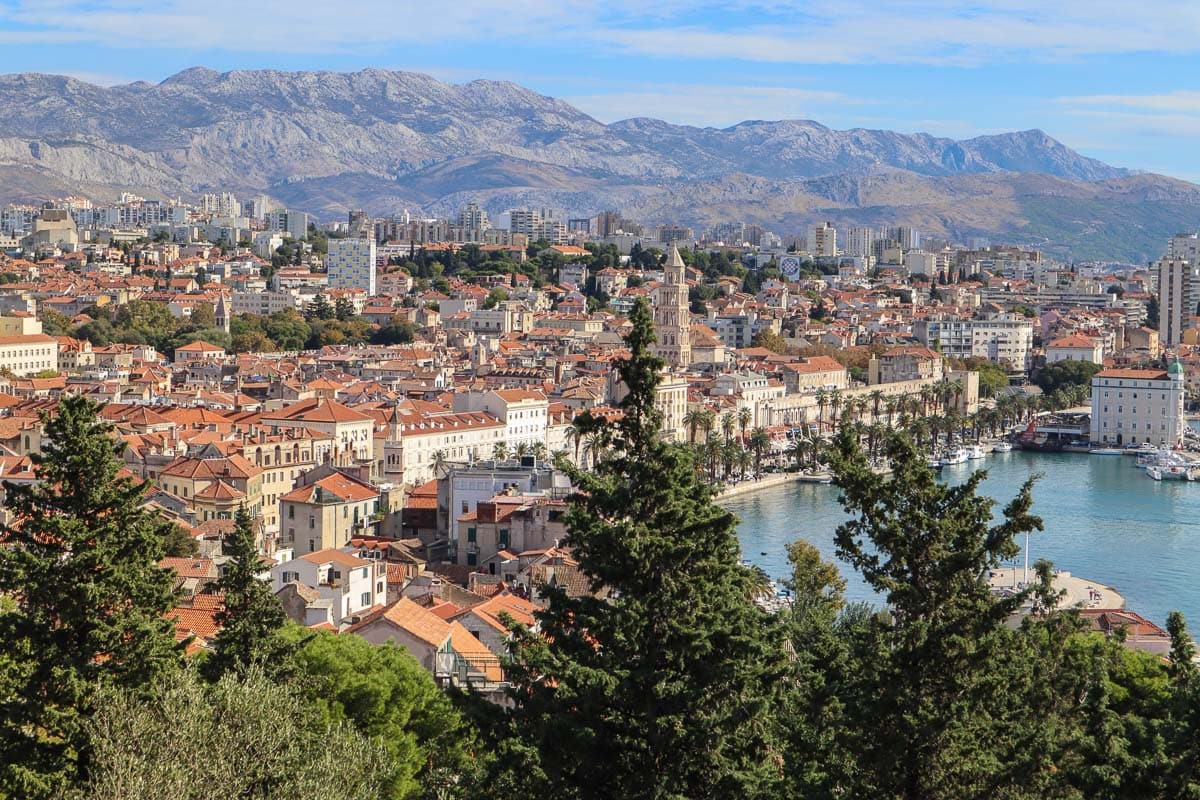
Top tip : I wouldn’t recommend climbing mid-morning (although that’s exactly when I went!) The sun was in a slightly awkward position, making photography trickier. I’m guessing late afternoon would be the best time, with the warm glow of the sun illuminating the city’s old town.
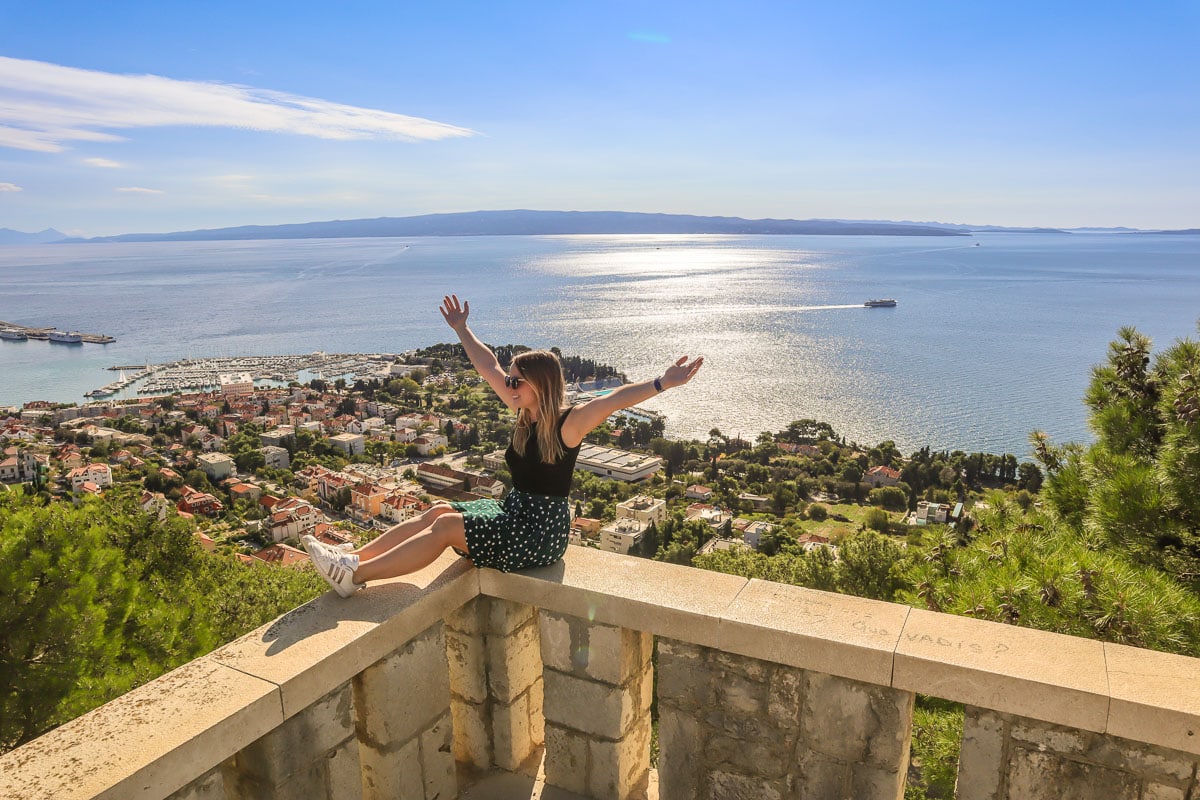
Visit Nearby Islands On A Boat Trip From Split
If you fancy a day trip from Split , then I’d recommend hopping on a boat tour and exploring some of the nearby islands. I booked a half-day boat trip from Split, which took us to the stunning island of Šolta, The Blue Lagoon and the medieval town of Trogir.
Šolta is SO charming, it felt like we’d turned back the clock. The island’s tranquil promenades and tiny beaches felt like a huge contrast to the buzz of Split. Where we docked there were a few cafes and restaurants, a small fishing harbour with a handful of boats, and the most turquoise water I’d seen in a long time!
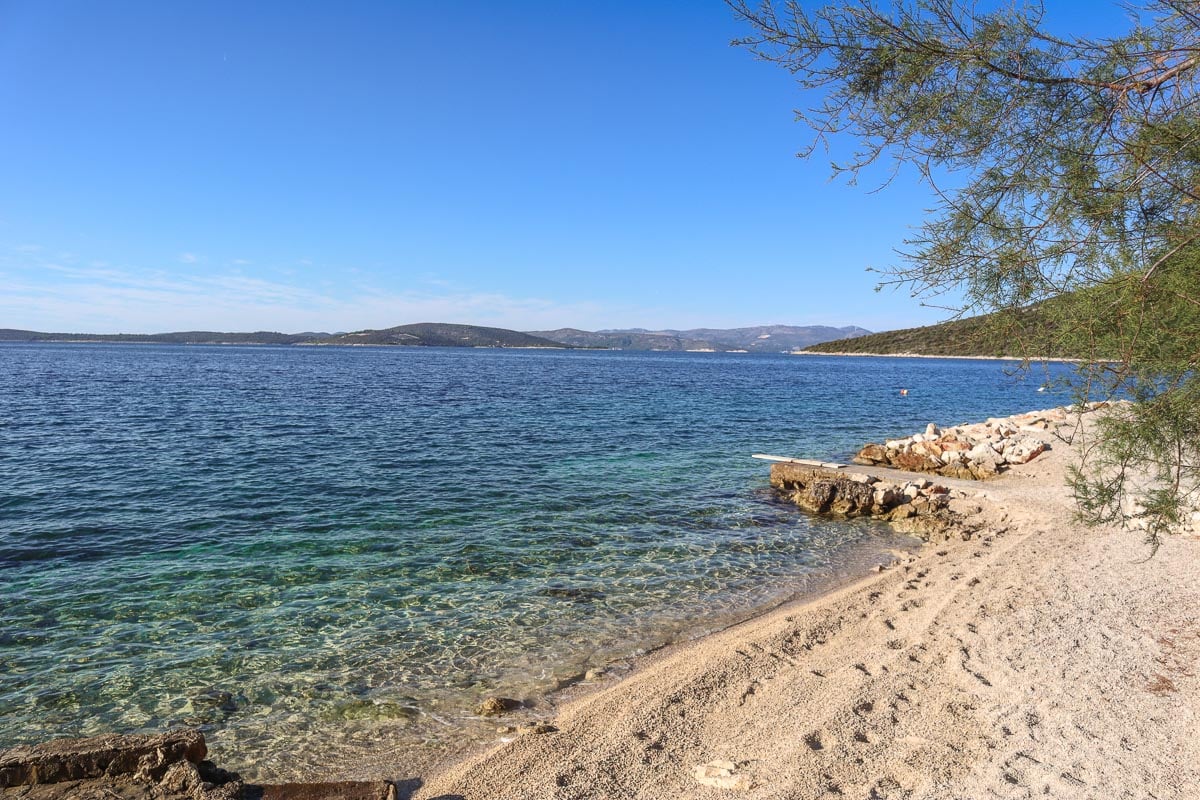
The Blue Lagoon is one of the most popular swimming spots in the region. In the summer, lots of boats stop there, giving passengers the chance to swim in the bright azure waters. It looked very inviting!
As we ventured through Trogir’s skinny streets, it felt a bit like a mini version of Split. We were lucky enough to arrive around sunset, enjoying gelato by the water with views of the medieval city walls and the 13th-century Cathedral of St. Lawrence.
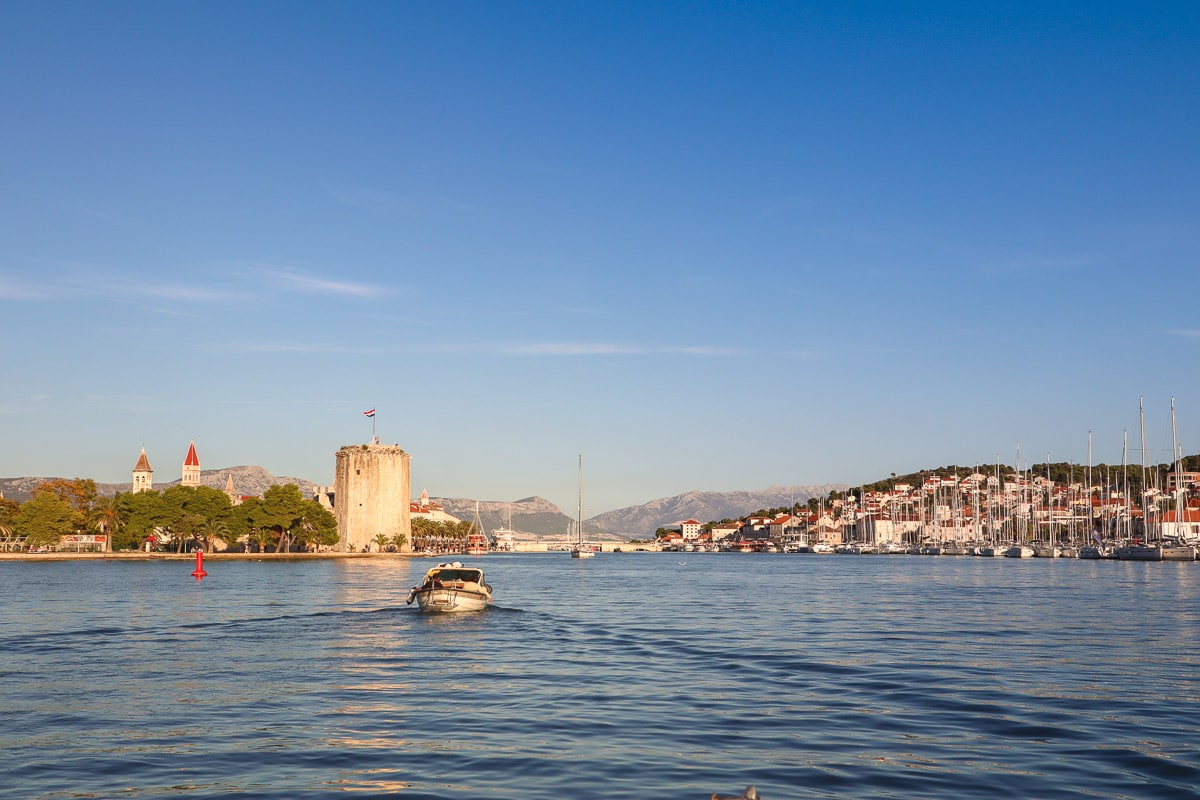
Read More: The Best Day Trips From Split
Enjoy split’s food scene.
With so many tourists visiting Split each year, you can find pretty much every cuisine imaginable. Definitely visit a konoba (small traditional restaurant) and enjoy some truffle pasta or peka (dish of baked meat and vegetables), washed down with Croatian vino.
Fancy something different? I’d recommend BEPA, a lovely restaurant in one of Split’s main squares, serving tasty and creative dishes, packed full of delicious ingredients. The sesame tuna salad was incredible!
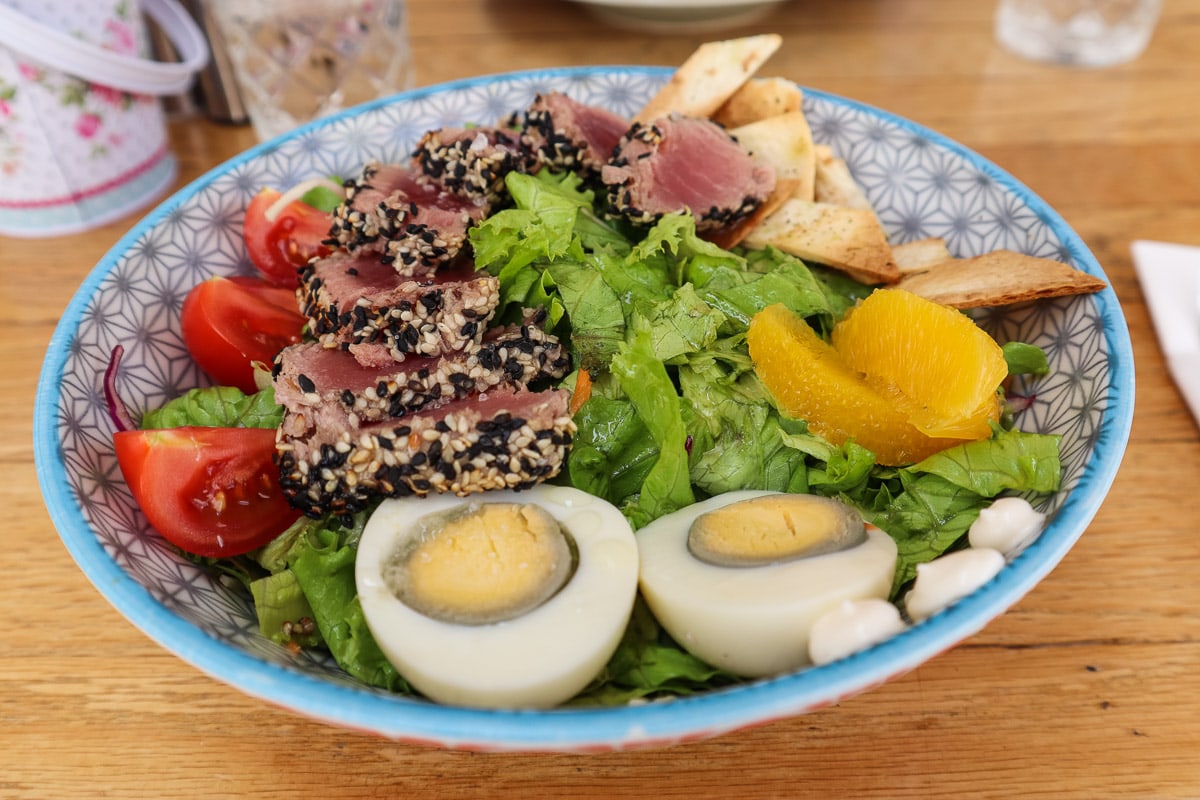
I also loved Maka Maka Split, a casual restaurant specialising in two items – acai bowls and poke bowls. How millennial?! The salmon and tuna poke bowl I had was SO yummy, perfect for a quick lunch! The smoothies and juices were also delicious.
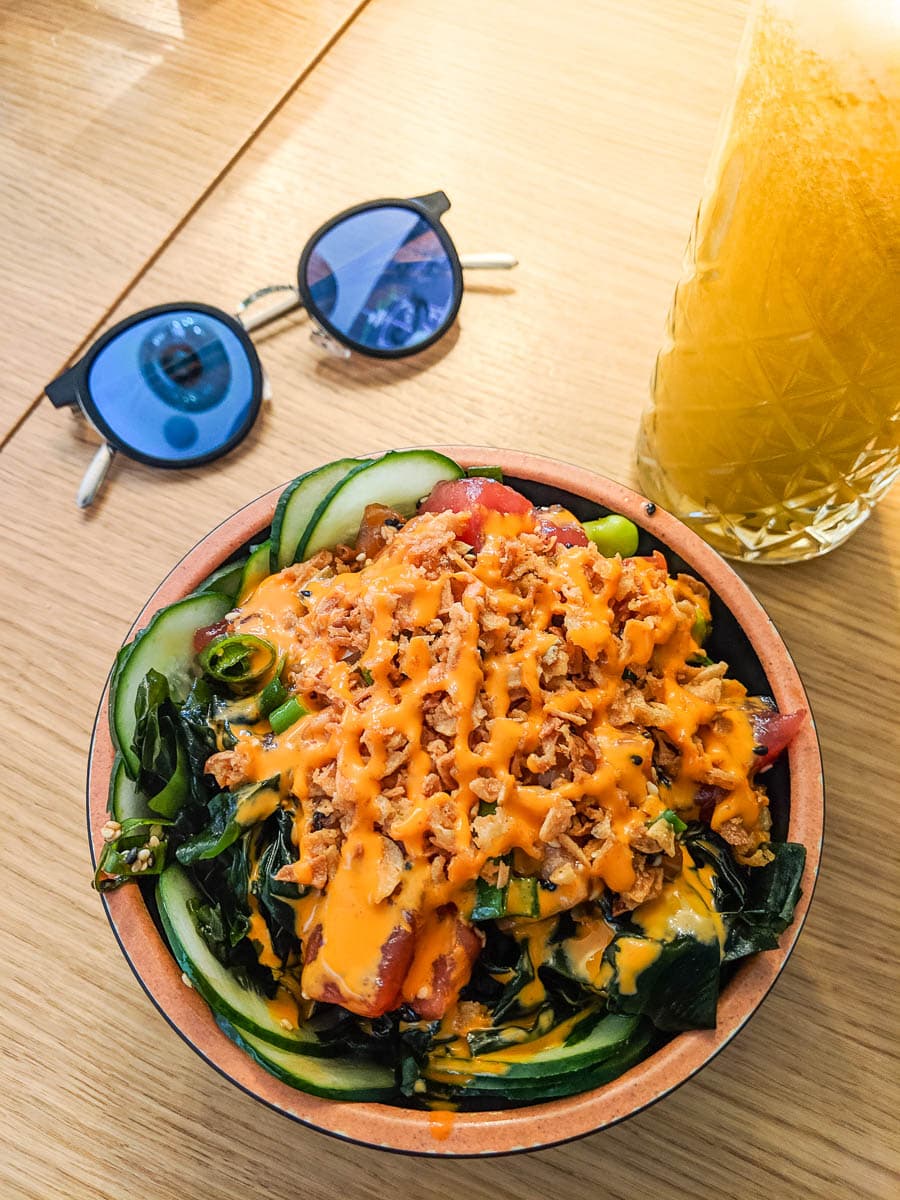
For a bit of naughtiness, head to Yummy and order a bubble waffle. I filled mine with Nutella, cream and topped it with Oreos. Mmmm I could eat one of those right now!
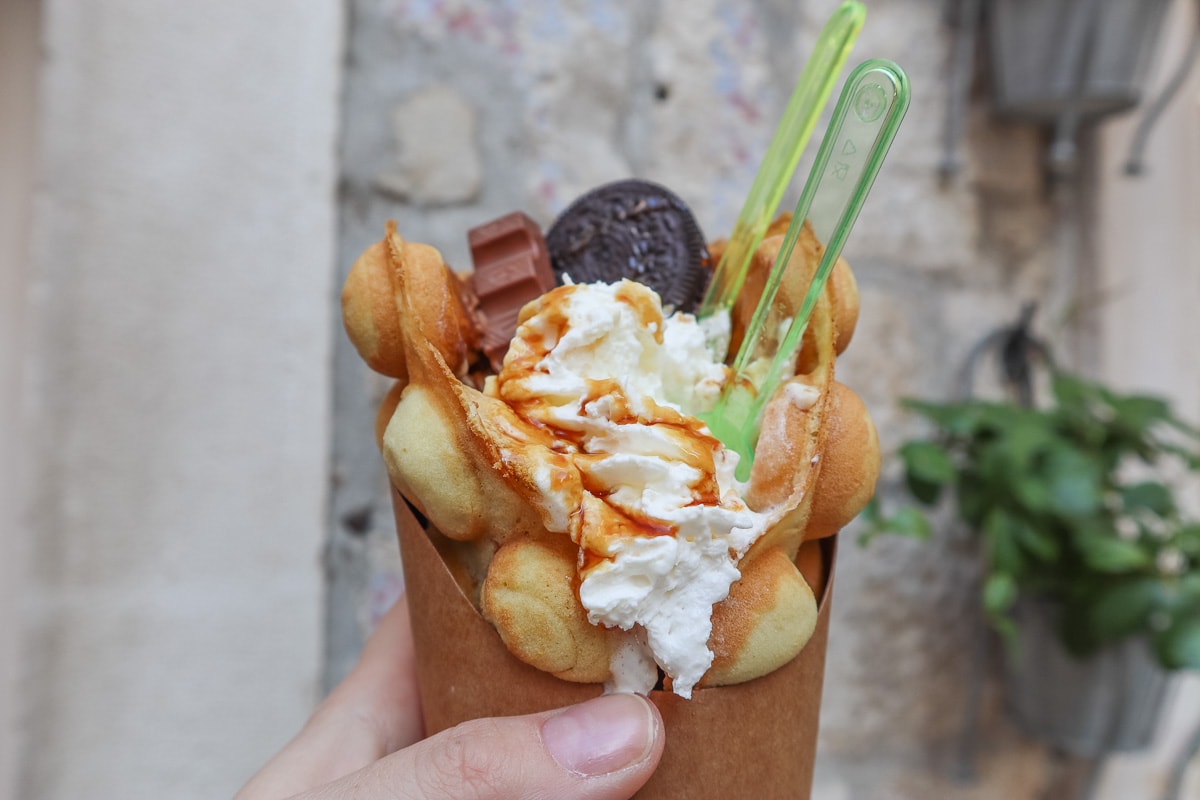
Top tip: While a lot of the restaurants on The Riva look lovely, they tend to be more expensive than the restaurants tucked away a few streets back. It’s definitely worth checking a few menus and reviews before you decide where to go. In high season, try to book one day in advance.
Climb Up Split’s Bell Tower For Stunning Views Of The City
So you’ve already climbed up Marjan Hill? Now it’s time to see the city in a totally new way! The bell tower of the Cathedral of Saint Domnius dates back to the 13 th Century, and is the icon of Split. In fact, you can see it from miles away.
After clambering up a few chunky stone steps, it’s a steep climb up several metal staircases to the top of the tower. Views from there are absolutely mesmerising, with rows of orange roofs, epic mountains and the azure of the Adriatic making up the epic panorama. For me, this is easily one of the best things to do in Split!

Top tips: You’ll need to pay in cash to climb the bell tower in Split, but it’s a total bargain at 20 kn (approx. £2.40) a ticket! Also, if you’re looking for the best view of the bell tower itself, head next door to the Ethnographic Museum where you’ll pay 5 kn to climb up to the vestibule terrace.
Enjoy Sunset Cocktails By The Water
The best way to unwind in Split? With a cocktail, watching the sunset. One of my favourite bars is F-Marine, around five minutes walk from the main promenade.
From there you’ll be able to watch as the sun turns the old town a beautiful shade of gold. And yes, it’s even better with a drink in your hand!
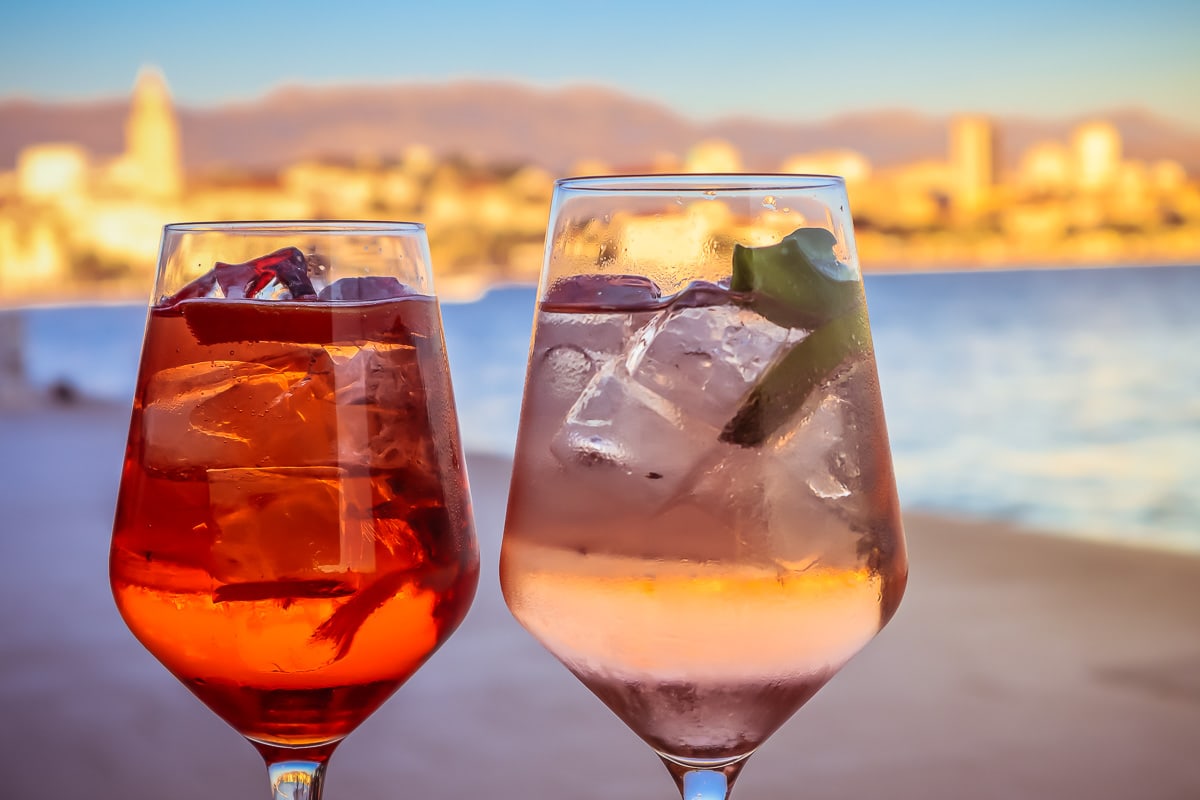
Top tip: Arrive early if you want to claim front row seats during high season! Or if you’re on a budget, grab a drink from a convenience store and sit out on the promenade.
Where To Stay In Split, Croatia
There are plenty of hotels and apartments right in the heart of Split. However, space is at a premium, so forget swimming pools and huge bedrooms!
If you fancy something more luxurious, check out one of Thomas Cook’s own brand hotels, Sentido Bluesun Berulia , a luxurious hotel set on a hillside a little way from Split, with some of the best views you’ll ever wake up to! There are two huge swimming pools, a restaurant, bar and a beach just a few steps away.
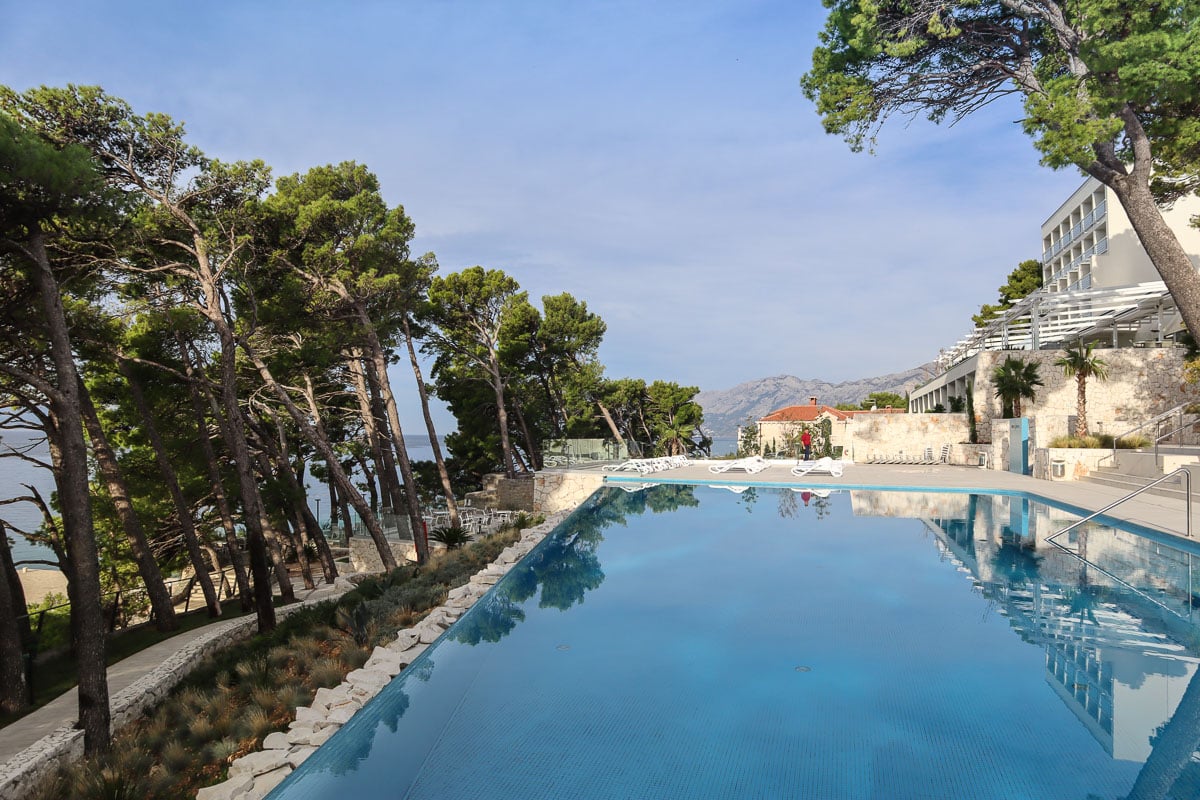
I hope you find my Split travel guide helpful for planning your adventures in Croatia! Let me know if you have any questions in the comments below!
Enjoyed this post? Pin it for later…
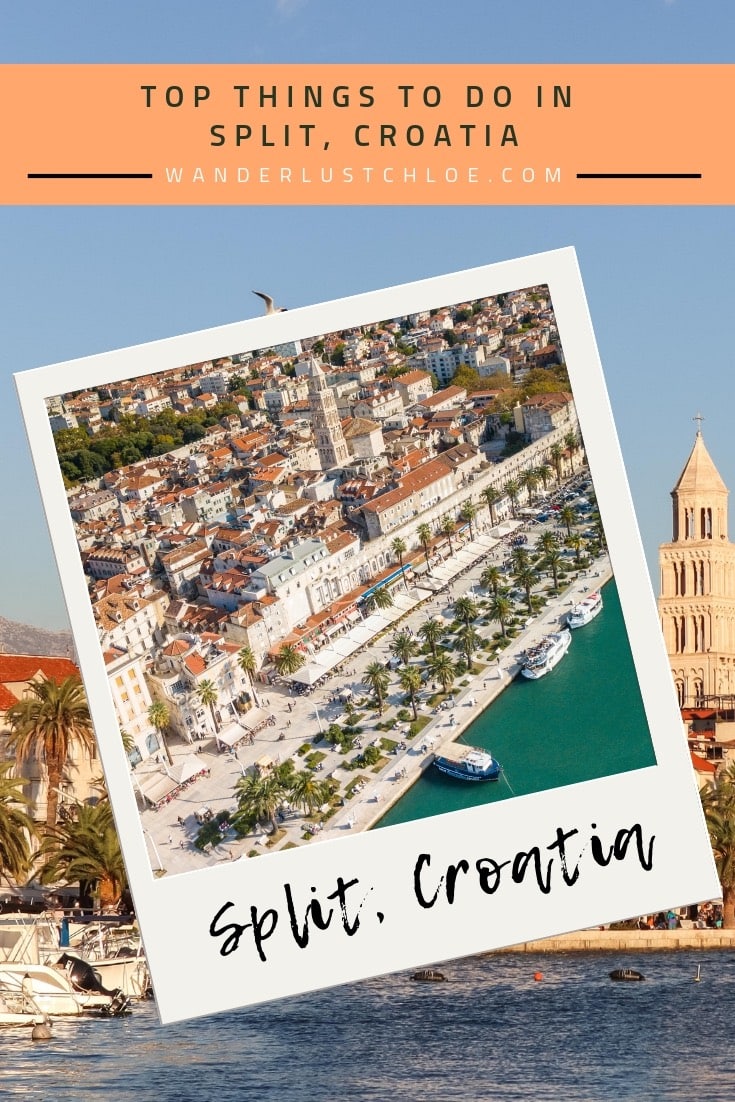
Chloe Gunning
With a passion for food, fun and adventure, Chloe is the content creator behind one of the UK's top travel blogs Wanderlust Chloe. From volcano boarding in Nicaragua, to sailing around Sicily and eating her way around Japan, her travels have taken her to some of the coolest spots on the planet. Named Travel Influencer of the Year in 2022, Chloe regularly works with a number of tourism boards, producing inspirational travel content across multiple platforms. Find out more about Chloe here.
1 thought on “Amazing Things To Do In Split, Croatia (Travel Guide)”
The Bell Tower is absolutely amazing. A tip is to go a bit off-peak. I climbed up when a ton of people (literally) went down. Not super comfortable 😉
Leave a comment Cancel reply

Split Itinerary: How to Spend From 3 to 7 Days in Split, Croatia
Posted on Last updated: February 11, 2023
Need help planning your Split itinerary? You’ve come to the right place!
In this article I have outlined everything you need to know to plan the perfect Split itinerary.
Starting with exactly how many days you need in Split, a day-by-day outline of all the best things to do in and around Split, where to stay, what to pack and much more.
Located on the Dalmatian Coast of the Adriatic Sea, Split is Croatia’s second-largest city, and one of the most popular destinations in Croatia, and it’s easy to see why.
On a trip to Split you can expect to discover a unique medieval old town, to relax on beautiful beaches, go on boat trips to pristine beaches, swim in waterfalls and even adventure in a stunning natural landscape.
It’s a beautiful city, which offers plenty to do for all types of travellers. This article will help you plan the best itinerary, so that you can have an amazing time in Split.
So what are you waiting for? Let’s dive in and start planning your perfect Split itinerary!
- 1.1 How many days in Split?
- 1.2 Where to stay in Split
- 1.3 What to pack for your Split trip
- 1.4 Do you need travel insurance for Split?
- 1.5 How to get around Split
- 2.1 Explore Diocletian’s Palace
- 2.2 Visit the Cathedral of Saint Domnius
- 2.3 Walk along the seaside promenade
- 2.4 Discover Pazar Market
- 3.1 See the view from Park Marjana
- 3.2 Relax at Kasjuni Beach
- 3.3 Go for a sunset SUP tour
- 4.1 Explore Omis Old Town
- 4.2.1 Go zip-lining
- 4.2.2 Or go rafting
- 5 Split itinerary day 4: Day trip to Krka
- 6 Split itinerary day 5: Day trip to Hvar
- 7 Split itinerary day 6: Day trip to Plitvice
- 8 Split itinerary day 7: Relax in Split

Exploring Diocletian’s Palace in Split, Croatia
Logistical tips for your Split itinerary
Before we dive into my detailed day-by-day Split itinerary, I wanted to share with you some useful tips that will help you arrange the logistics of your trip.
How many days in Split?
When planning your Split itinerary, you need to take into account just how much you want to see not only in Split, but also its surroundings.
There’s a long list of amazing sights and adventures to be had on a trip to Split, and working out just how many days to spend there can be difficult.
Thankfully, it’s pretty easy to tailor your trip to the length of time you have to spare for your Croatia itinerary .

View over Omis and the Cetina Canyon from the top of the fort
For example, one day in Split Croatia, will be enough to see the Split Old Town. It’s basically just enough to see the must-see spots of the town centre, but not enough to do everything – just enough for a taste of what the city has to offer.
A weekend in Split is a good length of time to easily see all of the top attractions of the city. But if you want to see some of the amazing sights outside of Split, you will have to consider an even longer trip.
In my opinion, three days is the bare minimum you need for a Split itinerary, to see the highlights within the city of Split and go on one day trip.
That said, one of the great things about Split, is that you can use it as a jumping-off point for discovering lots of the awesome places in the area.
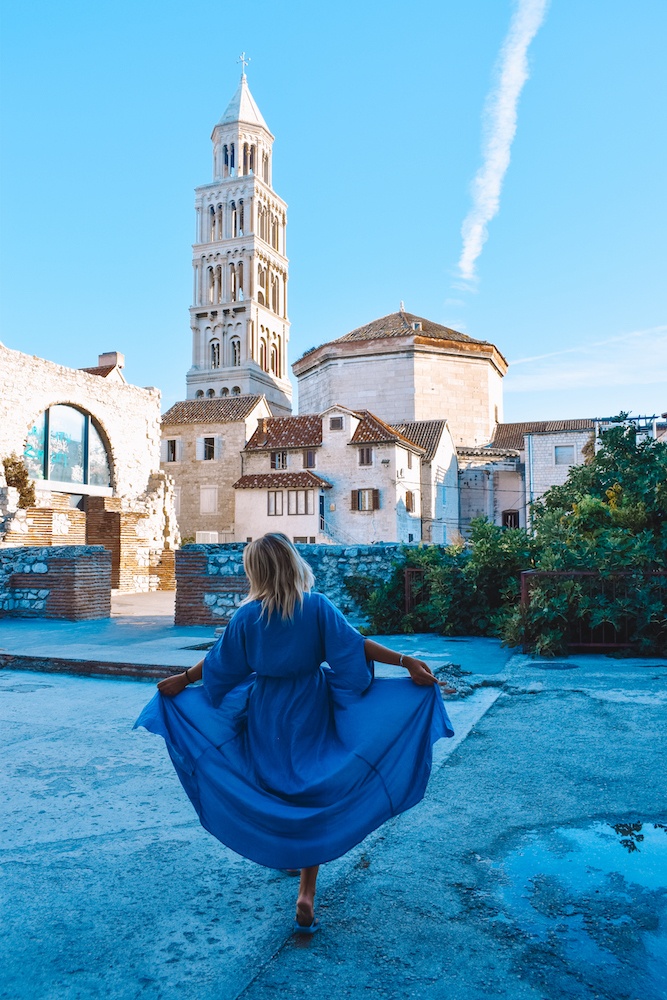
Exploring the Old Town of Split, Croatia
Split is super well positioned to go on day trips, so you could easily stay up to seven days in Split, and from there explore Krka, Plitvice, Omis and Hvar among others.
Since in this Split itinerary you will be sleeping in Split, and coming back every night, you can be flexible with what Split tours or activities you do.
There is a core Split 3-day itinerary, whilst the following days then build on the core 3-day itinerary.
You can shift things around depending on what suits you best, or even take out days if you don’t have up to one week in Split. It’s a flexible itinerary, which you can adapt to fit your interests.

Admiring Skradinski Buk falls in Krka National Park

Enjoying the view over Hvar from the top of the fort
Where to stay in Split
The best places to stay in Split are around Diocletian’s Palace and the Old Town centre. That way you’ll be super central, and within walking distance of all the main attractions.
Here are some great accommodation options for every budget.
Budget: Old Town Hostel – this hostel is right in the centre of Split. Here you can find an affordable stay and friendly sociable environment.
Click here to book your stay at Old Town Hostel!
Mid-range: Hotel Bellevue – located in the heart of Split, this cosy hotel is the perfect place for a relaxing stay.
Click here to book your stay at Hotel Bellevue!
Luxury: Villa Split Heritage Hotel – if you want to treat yourself, this is the place to do so. In the heart of the Old Town this hotel has a very traditional feel, with its exposed brick walls and an outdoors courtyard.
Click here to book your stay at Villa Split Heritage Hotel!
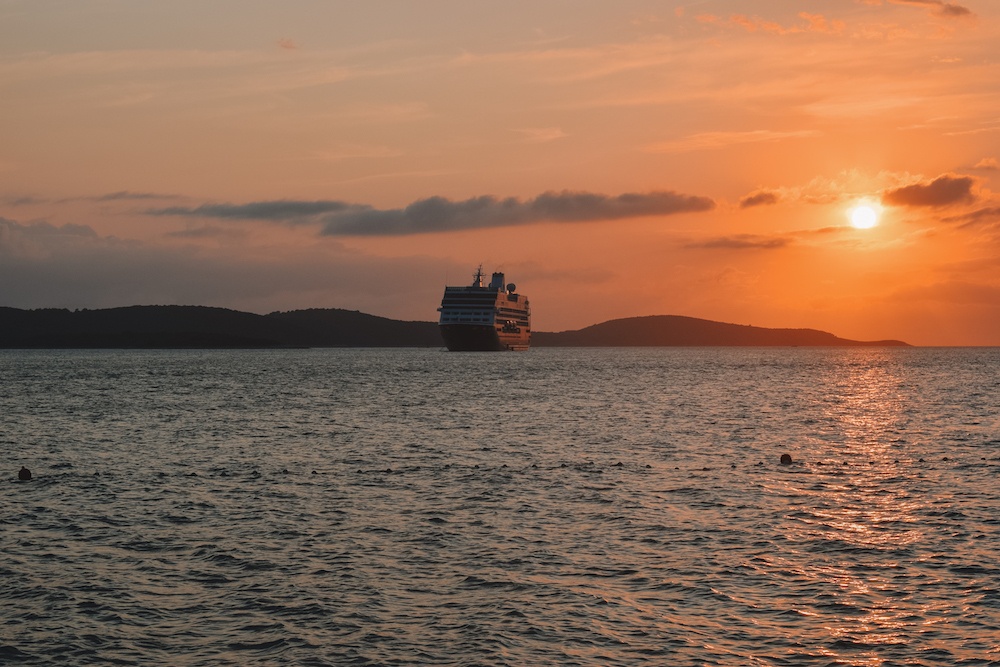
Sunset over the sea in Hvar, Croatia
What to pack for your Split trip
You don’t need much besides the usual travel essentials . However, I’ve listed below some key things you don’t want to forget!
Power bank – Whether it’s to check where you’re going with Google Maps, or to take beautiful travel pictures, you don’t want your phone to run out of battery.
Water bottle – You can drink the tap water in Croatia, so kill two birds with one stone by saving money and using less plastic!
International adapter – Depending on where you’re travelling from, you might need an adapter to charge your electronics.
Fast drying towel – Whether it’s for the shower of your hostel dorm, after a swim in Krka waterfalls or to lie on the beach, you’ll need one of these. I love them because they dry quickly and don’t take up much space.

View over Omis and the Cetina Canyon from the top of the fort, Croatia
Do you need travel insurance for Split?
After my personal experience spending two nights in a private hospital in Tenerife, and having to pay for it out of pocket (it wasn’t cheap), I always recommend getting travel insurance .
You might not end up needing it, but for a small fee you can travel without worries. Personally, I suggest getting your travel insurance with Heymondo .
Heymondo offers tailor made travel insurance, providing the best value for money for your specific trip. You can also buy it once you’re already abroad and have forgotten about it before flying (which, if you’re anything like me, is quite likely).
Besides the usual cancellation, medical expenses, luggage coverage and general travel insurance services, Heymondo also has a 24/7 doctor chat and instant assistance through their app.
Plus, as a Greta’s Travels reader, you get 5% off your Heymondo travel insurance !
Click here to get your 5% off Heymondo travel insurance!

Enjoying the view over Hvar from Fortica
How to get around Split
Getting around Split and its Old Town is easily done on foot. The main part of the town is really walkable and it doesn’t take too long to walk from place to place.
If you want to go a bit beyond the main attractions, but still stay within the city, you can use public transport.
The city has a comprehensive bus system that is modern and simple to use. Or for extra ease, you can hop in a taxi and get where you need to be quickly, for a still relatively affordable price.
For going further afield, on day trips to Omis or Krka for example, organised tours are the easiest option. That way you don’t have to worry about driving, parking and all the hassle that comes with it.
Discover some of the most popular Split tours below!

Driving a rental car in Hvar, Croatia, with the beautiful coastline of Hvar behind us

Me and my friends enjoying the sunset at Hula Hula Beach Bar in Hvar
Split Itinerary day 1 – Explore Split Old Town
We’re starting our Split one-day itinerary by heading straight to the Old Town. This is the centre of the city and where most of the main tourist sights are located.
One day will give you enough time to tick off the most famous locations around the area.
You can start the day exploring the Old Town, perhaps stopping for a morning coffee at a local cafe. After that, here are the main sights you can’t miss.
Explore Diocletian’s Palace
Begin the day early with a visit to Diocletian’s Palace. Built at the start of the fourth century for the Roman emperor Diocletian, the palace now makes up a large part of the historic centre of Split.

The striking Roman architecture is UNESCO listed and is an amazing place to spend time taking pictures and learning about the history of ancient Split.
The main square here is a lively spot (a great place to return to in the evening for a few drinks and live music)
You can also head underground to the Substructures of Diocletian’s Palace; the subterranean area used to open right out onto the water from the Bronze Gates.
Today, it’s a warren of basements, but the main section is busy with souvenir stalls. If you want to enter chambers on either side, tickets cost 42 HRK for an adult.
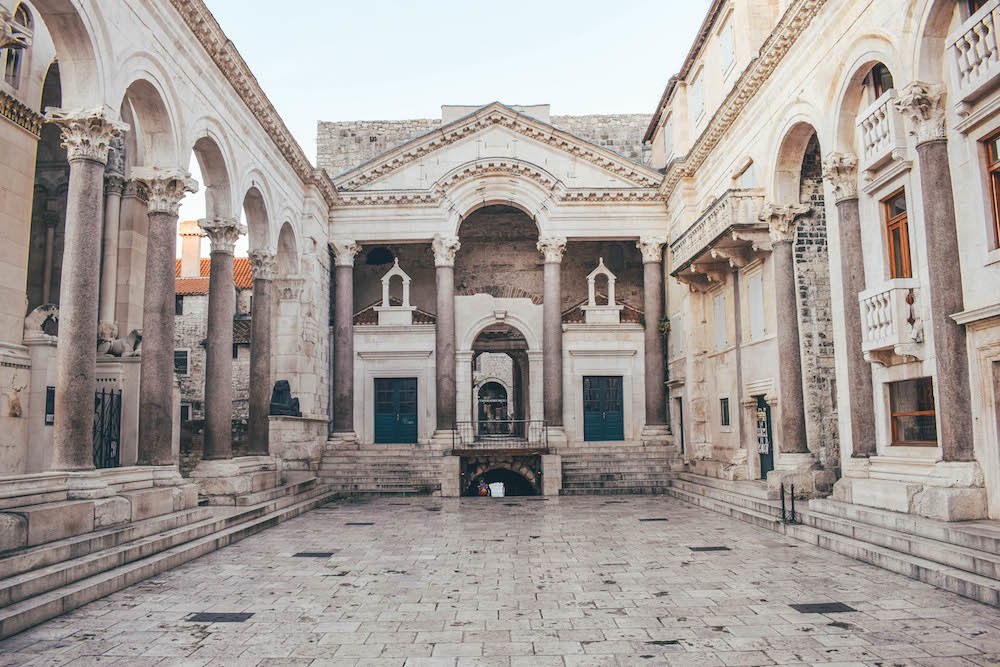
Diocletan’s Palace in Split, Croatia
Visit the Cathedral of Saint Domnius
Nearby, the 4th-century Cathedral of Saint Domnius is another great place to see yet more historic architecture.
There’s also the chance to get a view from the city from atop its 57-metre-tall bell tower. I did this early in the morning to snap pictures of the city from above with fewer crowds.
It’s also a long walk up a narrow, winding staircase to the top which would be less fun with more people coming the other direction.
Tickets to the bell tower cost 15 HRK; entrance to the cathedral is separate and costs another 20 HRK.
To maximise your first day in Split, you can also join a guided tour of the Old Town and Diocletian’s Palace . That way you’ll have a local guide sharing with you interesting facts about the rich history of Split.
Click here to book your Old Town & Diocletian’s Palace tour in Split!
Or click below to see prices & availability!

The view from the top of the Split cathedral bell tower
Walk along the seaside promenade
Next up take a walk over to the seaside promenade, the coastal pedestrianised path is dotted with trees and is busy with people enjoying their day in the sunshine.
This is a good place to find somewhere to eat lunch as there are plenty of little cafes and restaurants with terrace seating.
Discover Pazar Market
After lunch, you’ll have time in the afternoon to soak up some local life at the city’s markets. One great option is the open-air Pazar Market, which runs along Hrvojeva Street by the east wall of Diocletian’s Palace.
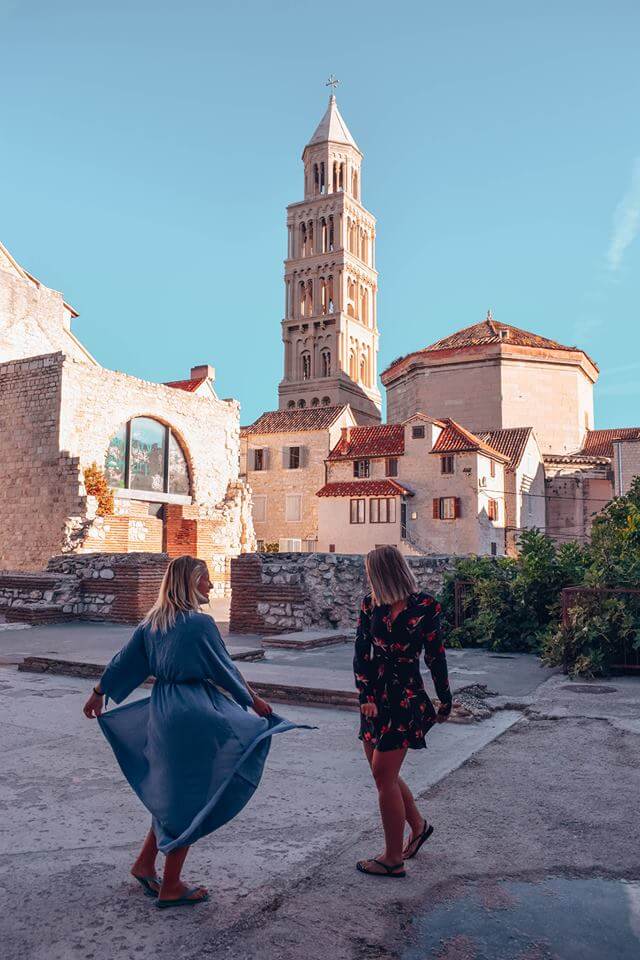
Exploring the side streets of Split in the early morning
Split itinerary day 2: Viewpoints & beaches
If you have the time to spend two days in Split, then you have the chance to slow down the pace a bit. On day one you saw many of the main sights, so today is all about soaking up the atmosphere of the area a little bit more.
See the view from Park Marjana
Start the day by getting a good glimpse of the city from Park Marjana viewpoint.
The walk up to the viewpoint is only around a 15 minutes from Split harbour, and the hike up Marjan Hill is only a few hundred metres of uphill walking, so it’s not too taxing.
Once you get to the top you are rewarded with a fantastic view across the old red rooftops of Split and over the sparkling sea.
There’s also a little bar where you can sit down, have a drink or ice cream and soak up what is one of the best views of Split.
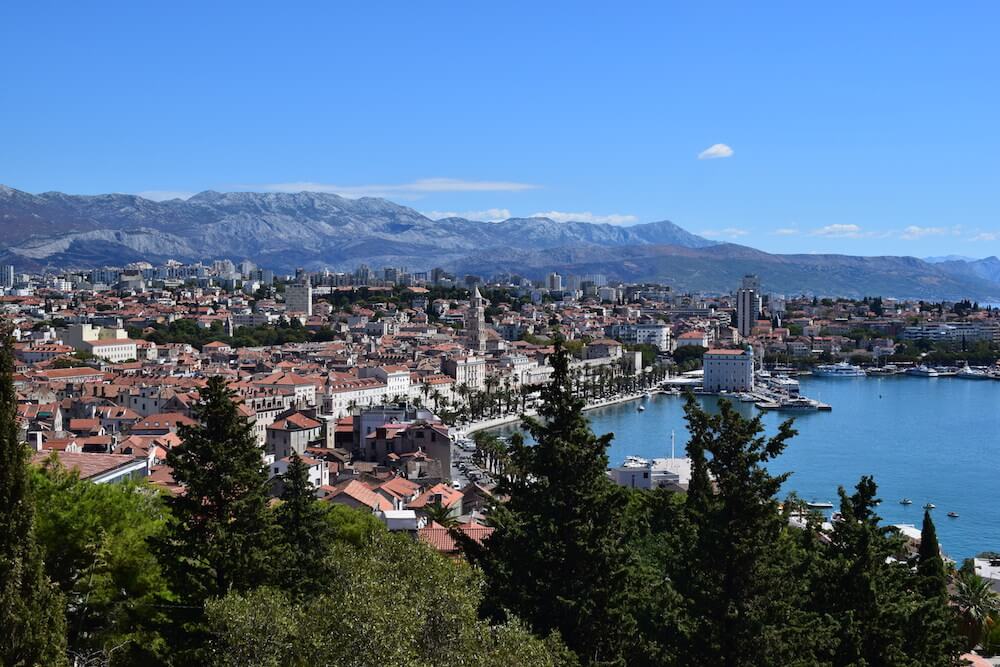
The view of Split from Park Marjan
Relax at Kasjuni Beach
In the afternoon you could cross Marjan Park and make your way down to Kasjuni Beach. Split has two main beaches.
The sandy Bacvice Beach is closer to the Old Town and has many more tourists. Kasjuni beach on the other hand is more local and laid back, and in general is just a lot more of an enjoyable place to unwind for a few hours.
Go for a sunset SUP tour
If you have time to spare, you could end your second day in Split by embarking on a sunset SUP tour.
You get to paddle in the calm waters around the shore, watch the sunset and then turn on LED lights below your board to help light the way!
Click here to book your sunset SUP tour in Split!

We went on a sunset stand up paddling tour while in Split
Split itinerary Day 3: Day trip to Omis
If you’re planning on spending three days in Split, then you have the time to take a day trip beyond Split. This is the perfect chance to spend the day exploring Omis.
This charming Croatian town is up there on any Croatia bucket list , because it is just so beautiful.
Explore Omis Old Town
Located at the mouth of the Cetina River, right where it meets the Adriatic Sea, the town sits right on the sea with the dramatic backdrop of the towering Cetina Canyon.
The town centre has been incredibly well preserved, which makes for a great place to spend an hour or two simply strolling along its stone streets.
Similarly to Split, it has a well preserved medieval town centre, and walking down these picturesque streets will feel like stepping back in time.
Above the town you will find Starigrad Fortress, an ancient castle with stunning views over Omis.

Wandering around the Old Town of Omis, Croatia
Discover the Cetina Canyon
But wandering around the charming town isn’t the only thing to do in Omis. From here you can make the most of the picturesque Croatian landscape by exploring the Cetina Canyon.
The lush 100km-long canyon runs along the Cetina River, and makes for an ideal spot for any adrenaline junkie or nature lover.
Go zip-lining
Ziplining is one of the most fun ways to see the canyon in all of its glory. You can read more about my time zip-lining Omis here .
It’s one of the most iconic zip lines in the world, with eight wires running for a total length of 2,100 metres! I did the Zipline Croatia tour, which costs 400 HRK per person.
It’s not only a thrilling activity, but it’s also a great way to enjoy this unique landscape. Especially from the first wire, where you’ll be zipping high above the Cetina Canyon, the views are simply stunning.
Click here to book your zip-lining experience in Omis, Croatia!

Zip-lining over the Cetina Canyon
Or go rafting
But, if zip-lining isn’t your thing, a lot of people also choose to raft along the Cetina River to really get a feel of the epic canyon from below. Some great hiking routes lead through the canyon of various lengths too.
Or if that all sounds like too much effort for a holiday, why not simply spend the day in Omis?
There’s the striking 15th-century Starigrad Fortress to visit with viewpoints of the region and some local eateries to sample in the town, too.
Click here to book your rafting experience in the Cetina River!
Or click below to see prices & availability for your chosen date!

Zip-lining in the Cetina Canyon

Split itinerary day 4: Day trip to Krka
For those of you who have enough time to spend four days in Split Croatia, then you are in for a treat.
You can spend the fourth day of your trip visiting Krka. This famous national park is like a slice of paradise, and is within easy reach of Split.
You could opt to hire a car and drive to Krka National Park, it’s only about a 1.5-hour drive.
There’s also a bus from Split bus station to Skradin; from here you can catch a ferry to Skradinski Buk and into the main area of Krka National Park.
Click here to book your Krka day tour from Split!
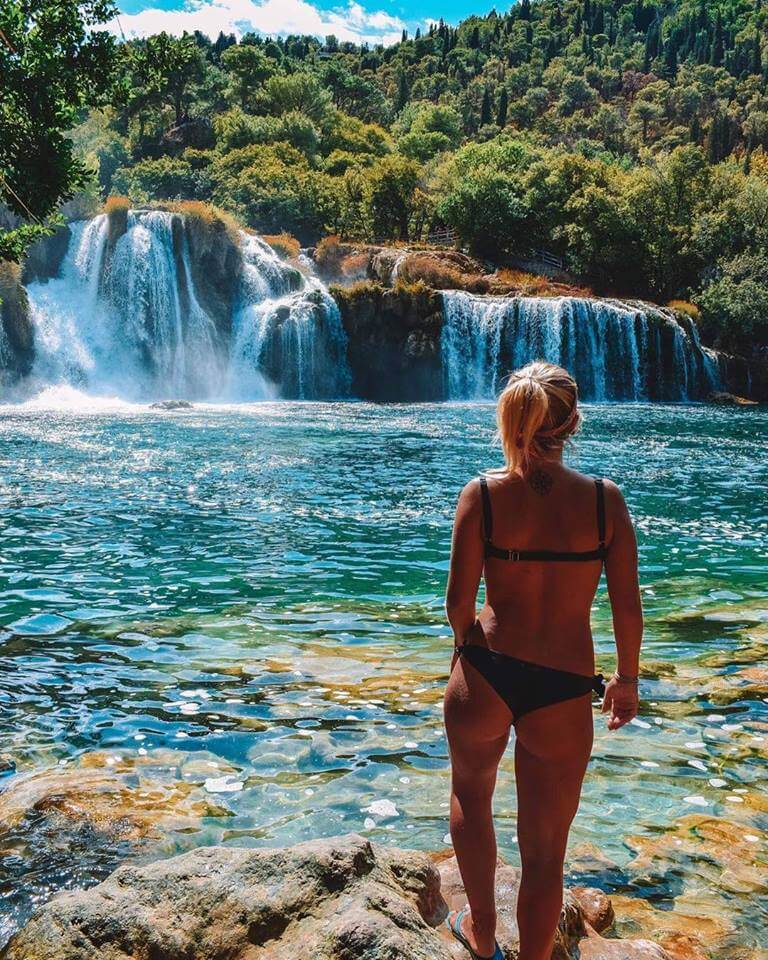
Looking for a corner away from the crowds by Skradinski Buk Falls at Krka National Park
For a completely smooth-sailing day, you can book an organised day tour to Krka from Split .
The tours are only a little bit more expensive than taking public transport, and mean you don’t have to worry about working out bus times, which is a bonus.
I really recommend taking a day trip to this National Park. It’s famous for its waterfalls, and they simply do not disappoint.
Your day will be spent taking a cruise on a boat along the river, from where you can take in the lush green surroundings.

The famous the famous Skradinski Buk Falls at Krka National Park in Croatia
You’ll also be able to see the famous Skradinski Buk Falls up close, where the fresh water gushes down into an emerald pool below. There’s even the chance to enjoy a refreshing swim in the pools themselves.
The park itself is really large (it covers an area of 142 square kilometres), so you won’t be able to see all of it in a day, but you will be able to see a lot of the most iconic spots.
Some scenic trains loop around to viewpoints and offer the opportunity to fully immerse yourself in the natural surroundings.
Tickets cost 30 HRK out of season (November to March) and 200 HRK in the summer months.
Click here to book your Split to Krka day trip!
Or click below to check out prices & availability for your chosen date!

One of the ferries in Krka National Park

Some of the smaller waterfalls in Krka National Park
Split itinerary day 5: Day trip to Hvar
Opting to spend five days in Split is an awesome idea if you have the time. You can really slow down the pace of your previous days, and enjoy immersing yourself in the town and the surrounding area.
Your fifth day in Split is a great opportunity to hop on a boat and head over to Hvar Island.
It takes about an hour to get to Hvar Island via one of the ferries that regularly leave from Split harbour. Once you reach Hvar Island, you can enjoy a day lounging on a choice of beaches.
The island has a whole host of incredible natural spots and a sweet historical town to wander too.

Malo Zarace Beach in Hvar Island
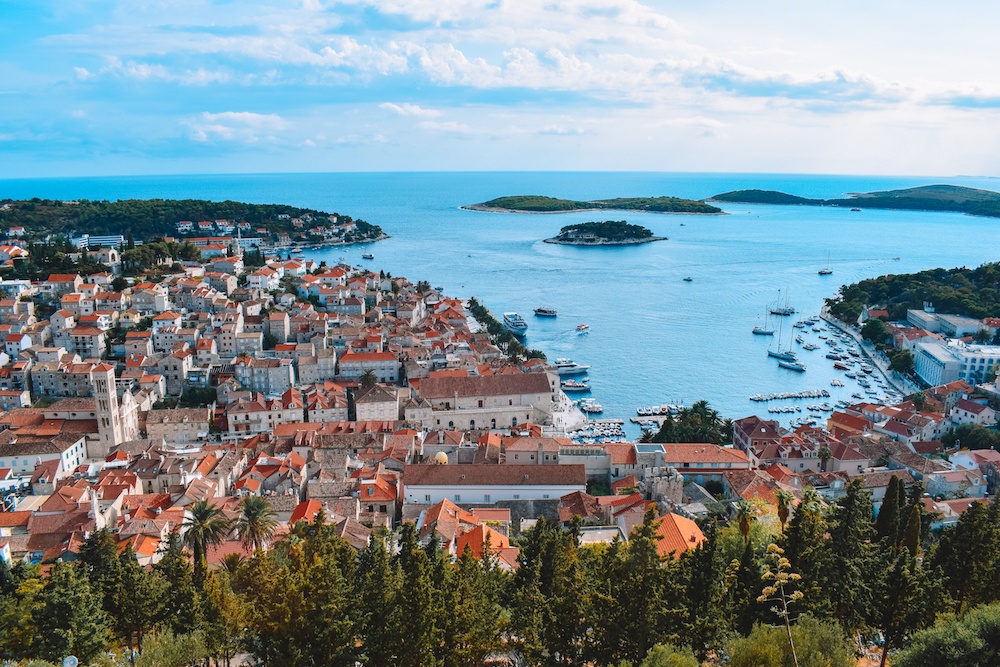
View over the harbour and rooftops of Hvar from the top of the fort
To really get the most out of your day, a Hvar day tour from Split is a good shout. A good tour itinerary will take you to all of the main sights of Hvar Town, as well as the nearby smaller islands.
Most tours will take you to see the stunning Blue Cave, and the picturesque coves around the islands of Vis, Ravnik, Budikovac and Bisevo.
Click here to book your boat tour to Hvar, Blue Cave & Five Islands from Split!
Split itinerary day 6: Day trip to Plitvice
There are yet more things to be added to this Split Croatia itinerary. Six days in Split gives you the perfect amount of time to take a day trip to Plitvice Lakes National Park.
There’s a reason that this UNESCO World Heritage Sight is the most visited tourist attraction in the whole of Croatia.
Located 150 miles (240 km) from Split, you can easily reach this stunner of a National Park in around two to three hours by car.
Covering an area of 295 square kilometres, the forest is famous for its Eden-like terraced lakes, each of them joined by trickling waterfalls that run into a deep limestone canyon.
The park can be explored in a number of different ways; there are easily accessible walkways, more strenuous hiking trails, and the opportunity to board electric boats and cruise a number of the upper and lower lakes.
Entrance costs 80 HRK (May to October) and 300 HRK in the summer season.
Click here to book your Split to Plitvice Lakes tour!
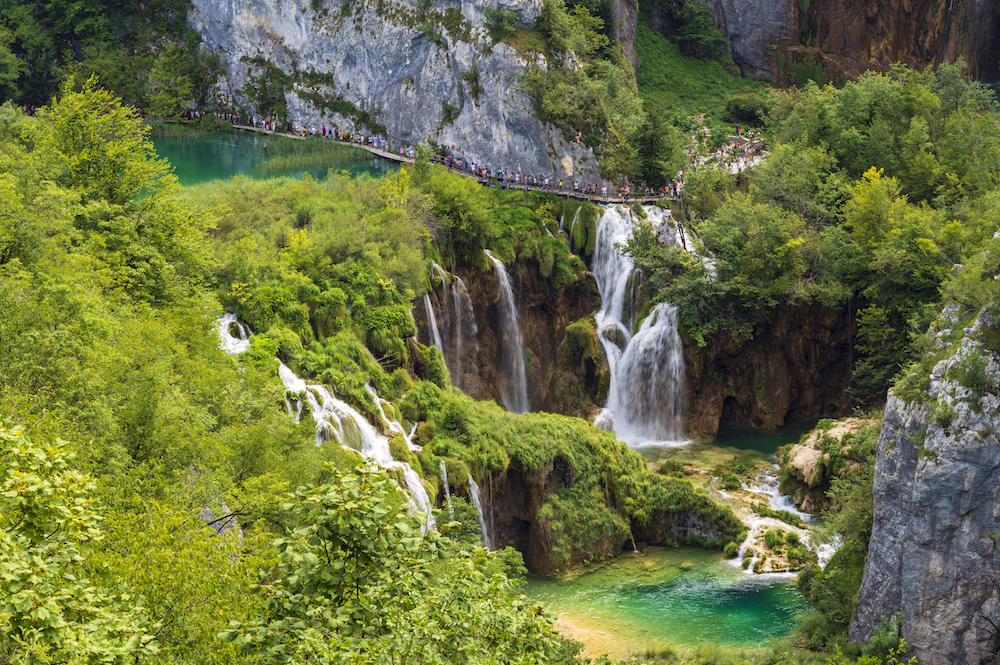
Exploring the waterfalls of Plitvice National Park – Photo by Rohit Ganatra on Scopio
Split itinerary day 7: Relax in Split
We’ve reached the end of the Split itinerary, with seven days being a great amount of time to truly enjoy the town at a leisurely pace, while also seeing the surrounding sights on day trips.
On your final day in Split you can tick off the things you might have overlooked on previous days.
You could spend the morning walking around the Old Town, doing a spot of shopping for souvenirs to take back home with you.
Or maybe you just want to enjoy one more day in the sunshine, which means kicking back at the beach.
But for those of you who really want to max out your time in Split, and Croatia as a whole, then you could opt to go on a day trip to Dubrovnik !
Don’t miss out, book your Dubrovnik day trip from Split here!

View over the iconic red roofs of Dubrovnik
Dubrovnik is another beautiful Croatian city. It has many similar features to Split, but it’s still different enough that they’re both worth visiting and adding to your Europe bucket list .
The Old Town of Dubrovnik is surrounded by tall city walls, its characterised by red roofs and picturesque pedestrian streets.
If you have a bit more time on your Croatia trip, I highly suggest extending your Dubrovnik itinerary and sleeping in Dubrovnik , as there so many awesome things to do there.
If you’re short on time, worry not, as you can still visit on a day trip from Split, thanks to the many organised Dubrovnik tours .

A “hidden” beach cave that you can visit near Dubrovnik

View over the rooftops of Dubrovnik from the Old Town walls
Final thoughts on this Split itinerary
There you have it, the ultimate Split itinerary! Have you visited Split before? How did you find it? Let me know in the comments below!
Split is a gorgeous city, and one of my favourite European weekend getaways. The city is incredibly charming, with its medieval narrow streets and unique architecture.
However, if you have longer to spend in Split, that’s even better! As the surroundings of Split are also stunning, and you can go on epic day trips to cute towns, dramatic waterfalls, pristine islands and gorgeous canyons.
In this article I tried to share with you the most thorough Split itinerary. An itinerary that you can adapt depending on your interests and how much time you have.
I hope you find this useful in creating your own Split itinerary! If you have any questions, just let me know in the comments below!
Enjoyed reading my ultimate Split itinerary? Pin it!

Book your individual trip , stress-free with local travel experts
Select Month
- roughguides.com
- split-south-dalmatian-coast
- Travel guide
- Itineraries
- Local Experts
- Travel Advice
- Accommodation
Plan your tailor-made trip with a local expert
Book securely with money-back guarantee
Travel stress-free with local assistance and 24/7 support
With its seafront cafés and ancient alleyways, shouting stallholders and travellers on the move, bustling, exuberant Split is one of the Mediterranean’s most compelling cities. It has a unique historical heritage too, having grown out of the palace built here by the Roman Emperor Diocletian in 295AD. The palace remains the city’s central ingredient, having been gradually transformed into a warren of houses, tenements, churches and chapels by the various peoples who came to live here after Diocletian’s successors had departed. Lying beyond the Roman/medieval tangle of central Split lie suburban streets full of palms and exotic plants, followed by stately rows of socialist-era housing blocks that look like something out of a modernist architectural stylebook.
Brief history of Split
Diocletian’s palace, narodni trg, the marjan peninsula, beaches in split, around split, split festivals.
As Croatia’s second city, Split is a hotbed of regional pride, and disparagement of Zagreb-dwellers is a frequent, if usually harmless, component of local banter. The city is famous for the vivacious outdoor life that takes over the streets in all but the coldest and wettest months: as long as the sun is shining, the swish cafés of the waterfront Riva are never short of custom.
The traditional Adriatic repertoire of grilled fish, fried squid and seafood stews is central to the cuisine of southern Dalmatia. In addition, Dalmatian pašticada (slabs of beef stewed in prunes and red wine) is particularly good in Split and Makarska, where it features on the lunchtime menus of almost every konoba . The towns inland from the coast and along the Neretva delta are famous for their frogs’ legs – which are either fried in breadcrumbs, grilled with garlic, or wrapped in slivers of pršut . The Neretva is also famous for its tangy, succulent eels, especially when used as the key ingredient of brodet – a spicy red stew that’s often accompanied by a glossy yellow mound of polenta.
Travel ideas for Croatia
Created by local experts

Gorgeous gems of Hungary, Slovenia and Croatia
From the spas of Budapest to Lake Bled with its castle and further on to Croatia - this itinerary takes you across 3 countries, with a special focus on Slovenia's lake area and the Dalmatian coast in Croatia.

Sailing Croatia
If you want to experience the Dalmatian coast from a whole different perspective, then this trip is for you! Hop aboard a beautiful cruiser and sail along some of Croatia's most stunning islands.

Southern Pearls
This ten-day trip will take you around three adjacent countries, Croatia, Bosnia & Herzegovina, and Montenegro. Your tour starts in Split, Croatia, moving south (hence the name "Southern Pearls") over the island of Hvar and Mostar in Bosnia & Herzegovina to end up in Montenegro.
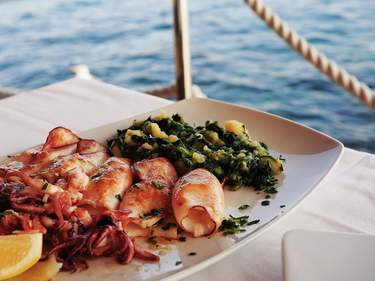
Gourmet Tour
You will visit three different adjacent countries and experience traditional local food and wines. You will visit some of the most intriguing restaurants and wineries in the area taste the delicious contrast between fine restaurants, and more traditional, authentic taverns.

Culinary Secrets of Croatia
This vintage holiday celebrates the wine and olive oil-making traditions of Croatia’s Adriatic coastline, which form the foundations of the country's Mediterranean culinary heritage. Visit world-class wineries, and sample Dalmatian delicacies as you travel south to Dubrovnik.

Balkan Extended
The Balkan Extended tour truly showcases the finest of Balkan’s heritage and natural beauty as you make your way through the 5 countries. Learn about the Serbian Athens, climb the splendid Old Bridge in Mostar, observe Slovenia's water castle and dive into the pearl of Croatia's beauty in Istria.
According to conventional wisdom, Split didn’t exist at all until the Emperor Diocletian decided to build his retirement home here, although recent archaeological finds suggest that a settlement of sorts was founded here by the Greeks, well before Diocletian’s builders arrived. Diocletian’s Palace was begun in 295 AD and finished ten years later, when the emperor came back to his native Illyria to escape the cares of empire, cure his rheumatism and grow cabbages. Even in retirement Diocletian maintained an elaborate court, with luxurious palatial apartments in the south of the complex and a military garrison in the north. The palace as a whole measured some 200m by 240m, with walls 2m thick and almost 25m high, while at each corner there was a fortified keep, and four towers along each of the land walls.
The palace was home to a succession of regional despots after Diocletian’s death, although by the sixth century it had fallen into disuse. In 614, it was repopulated by refugees fleeing nearby Salona, which had just been sacked by the Avars and Slavs. The newcomers salvaged living quarters out of Diocletian’s neglected buildings, improvising a home in what must have been one of the most grandiose squats of all time. The resulting city developed cultural and trading links with the embryonic Croatian state inland, and was absorbed by the Hungaro-Croatian kingdom in the eleventh century.
Venetians, Ottomans and Austrians
By the fourteenth century, Split had grown beyond the confines of the palace, with today’s Narodni trg becoming the new centre of a walled city that stretched as far west as the street now known as Marmontova. Venetian rule, established in 1420, occasioned an upsurge in the city’s economic fortunes, as the city’s port was developed as an entrepôt for Ottoman goods. Turkish power was to be an ever-constant threat, however: Ottoman armies attacked Split on numerous occasions, coming nearest to capturing it in 1657, when they occupied Marjan hill before being driven off by reinforcements hastily shipped in from Venice , Trogir and Hvar .
During the nineteenth century, Austrian rule stimulated trade and helped speed the development of Split’s port.
Twentieth-century Split
Split’s biggest period of growth occurred after World War II, when industrial growth attracted growing numbers of economic migrants from all over the country. Many of these newcomers came from the Zagora, the rural uplands just inland, and ended up working in the enormous shipyards – colloquially known as the Škver – on Split’s northwestern edge, providing the city with a new working-class layer. It was always said that productivity at the Škver was directly related to the on-the-pitch fortunes of Hajduk Split, the football team which more than anything else in Split served to bind traditional inhabitants of the city with recent arrivals. Beginning with the big televised music festivals of the 1960s, Split also became the nation’s unofficial pop music capital, promoted as a kind of Croatian San Remo. Since then generations of balladeering medallion men have emerged from the city to regale the nation with their songs of mandolin-playing fishermen and dark-eyed girls in the moonlight.
Into the present
Split entered the twenty-first century as a transit city in which visitors spent a few hours before boarding their ferries. However the last decade has seen an enormous boost in tourism, with new hostels and hotels (with ever higher prices) catering for independent travellers eager to experience the city’s unique urban buzz. Split's new-found popularity does of course have its downside, with traditional residential areas in the Old Town gradually metamorphosing into tourist zones composed of apartment conversions and holiday homes.
Adapted long ago to serve as Split’s town centre, Diocletian’s Palace is certainly not an archeological “site”. Although set-piece buildings such as Diocletian’s mausoleum (now the cathedral) and the Temple of Jupiter (now a baptistry) still remain, other aspects of the palace have been tinkered with so much by successive generations that it is no longer recognizable as an ancient Roman structure. Little remains of the imperial apartments, although the medieval tenements that took their place were built using stones and columns salvaged from Diocletian’s original buildings. Despite its architectural pedigree, the palace area hasn’t always been the most desirable part of the city in which to live. During the interwar period it was dubbed the get (“ghetto”) and – abandoned to the urban poor, down-at-heel White Russian émigrés and red-light bars – became synonymous with loose morals and shady dealings. Nowadays the palace area is once more the centre of urban life, hosting a daily melee of tourists and shoppers.
Running along the palace’s southern wall, into which shops, cafés and a warren of tiny flats have been built, Split’s seafront Riva (officially the Obala hrvatskog naradnog preporoda) is where the city’s population congregates daily to meet friends, catch up on gossip and slouch over a leisurely coffee. In 2007 the Riva was subjected to an expensive facelift by architecture bureau 3LHD, with pristine Brač-marble flagstones laid beneath the palm trees, and neat new café awnings held up by what look like huge hockey-sticks. Nearly a decade on, it remains uncertain whether the notoriously conservative Splićani will ever get used to it.
The Bronze Gate
The main approach to the palace from the Riva is through the Bronze Gate (Mjedena vrata), a functional and anonymous gateway that originally gave access to the sea, which once came right up to the palace. Inside is a vaulted space which once formed the basement of Diocletian’s central hall, the middle part of his residential complex, now occupied by arts and crafts stalls.
Diocletian (245–312)
Born the son of slaves, Diocletian was a native of Dalmatia – and possibly grew up in Salona, next door to Split. Despite his humble origins he proved himself quickly in the Roman military, becoming emperor in 284 at the age of 39. For 21 years he attempted to provide stability and direction to an empire under pressure – goals he achieved with some measure of success. Believing that the job of running the empire was too big for one man, however, Diocletian divided the role into four, the Tetrarchy, carefully parcelling out responsibility among his partners – a decision which some historians believe led directly to disintegration and civil war. Diocletian was also renowned for his persecution of Christians: those martyred during his reign included the patron saints of Split, Domnius and Anastasius, along with many other leading religious figures – Sebastian, George, Theodore and Vitus among them.
The motives for Diocletian’s early retirement have been the subject of much speculation. It was obviously planned well in advance by a man who feared he was no longer up to the rigours of government. As a highly innovative emperor, Diocletian obviously saw the very concept of retirement – a total novelty among Roman rulers – as a logical adjunct to his other reforms. However, the power-sharing system he left behind soon disintegrated once he was no longer at the helm, leading ultimately to the rise of a new strongman, Constantine the Great (ruled 309–38).
Robert Adam and Diocletian’s Palace
Our knowledge of Diocletian’s Palace owes much to the eighteenth-century Scottish architect Robert Adam, who set out to provide a visual record of what remained of the palace, believing that contemporary European builders had much to learn from Roman construction techniques. Adam arrived in Split in 1757 with a team of draughtsmen; they spent five weeks in the city despite the hostility of the Venetian governor, who almost had them arrested as spies. This didn’t prevent Adam from enjoying the trip: “the people are vastly polite, everything vastly cheap; a most wholesome air and glorious situation” was how he summed the town up. The resulting book of engravings of the palace caused a sensation, offering inspiration to Neoclassical architects all over Britain and Europe. Adam’s work was certainly seminal in the development of the Georgian style in England, and large chunks of London, Bath and Bristol may be claimed to owe something of their space, symmetry and grace to Diocletian’s buildings in Split.

Beautiful palace built for the Roman Emperor Diocletian - Split city, Croatia © Niyazz/Shutterstock
Standing at the heart of medieval Split is Narodni trg (People’s Square, although it’s colloquially known as “Pjaca” or piazza), the public space that stretches just outside the Iron Gate (Željezna vrata), the palace’s western entrance. Narodni trg replaced the Peristyle as the city’s main square in the fourteenth century, and is overlooked to the east by a Romanesque clock tower with the remains of a medieval sundial. The north side of the square is dominated by the fifteenth-century Town Hall (Gradska vijećnica), with a ground-floor loggia of three large pointed arches supported by stumpy pillars – it frequently plays host to major art or history exhibitions in the summer.
West of the square lie the bustling narrow streets and passages of the medieval town. To the south, Marulićeva leads down towards Mihovilova širina, a small square whose café-bars get packed on warm summer evenings, and the adjoining Trg braće Radića, more popularly known as Voćni trg (Fruit Square) because of the market that used to be held here. There’s a large statue of Marko Marulić, supplied by the industrious Meštrović, in the middle, and an octagonal tower that once formed part of the fifteenth-century Venetian castle, or kaštel – most of which has now either disappeared or been incorporated into residential buildings.
Crisscrossed by footpaths and minor roads, the wooded heights of the Marjan peninsula offer the easiest escape from the bustle of central Split. From the Old Town it’s an easy ten-minute walk up Senjska, which ascends westwards through the district of Veli Varoš, arriving after about ten minutes at the Vidilica café on Marjan’s eastern shoulder. There’s a small Jewish graveyard round the back of the café, and to its right a stepped path climbs towards Vrh Marjana, where there’s a wider view of the coast and islands.
About 1km further west, there’s an even better panorama from the peninsula’s highest point, 178-metre-high Telegrin. Keeping to the left of the Vidilica brings you to a path which heads round the south side of the hill, arriving after about five minutes at the thirteenth-century St Nicholas’s Chapel (Sveti Nikola), a simple structure with a sloping belfry tacked on to one side like a buttress. From here, the path continues for 2km, with wooded hillside to the right and the seaside suburbs of Marjan’s south coast on the left, before arriving at St Hieronymous’s Chapel (Sveti Jere), a simple shed-like structure pressed hard against a cliff – medieval hermits used to live in the caves that are still visible in the rock above. From here you can descend towards the road which leads round the base of the peninsula, or cross its rocky spine to reach Marjan’s fragrant, pine-covered northern side. Paths emerge at sea level near Bene bay, where you’ll find a combination of rocky and concreted bathing areas and a couple of cafés.
Orson Welles in Split
Head for the Joker shopping centre on put Brodarice (ten minutes’ walk northeast of the Old Town along Dovominskog rata) and you’ll come face to face with a bolero-hatted bronze sculpture of Hollywood director Orson Welles, unveiled in 2007. The statue was designed by Welles’s long-time companion, Croatian-born actress and sculptor Oja Kodar, who he met while shooting gloomy central European exteriors for his adaptation of Kafka’s The Trial in Zagreb in 1961. Croatia became a second home to Welles, who acted in local-made films (including the partisan war epic Battle on the Neretva in 1969), had a holiday villa at Primošten and – according to local lore – was an eager follower of Hajduk Split.
The main visitor-magnet east of the city centre is Bačvice beach, a few minutes’ walk east of the ferry terminal. A popular destination for Splićani of all ages, Bačvice is the spiritual home of picigin, a game only played in and around Split, which works rather like a netless version of volleyball in the sea, involving a lot of acrobatic leaping around as players try to prevent a small ball from hitting the water. Immediately behind the beach is a chic modern three-tier pavilion, resembling a cross between an Art Deco seaside building and a high-tech metal tent. With several cafés and a couple of swanky eating places inside, it’s a popular venue for after-dark drinking and feasting throughout the year. A coastal path leads east from Bačvice past a couple of smaller bays, passing the tennis club where 2001 Wimbledon champion Goran Ivanišević honed his skills. There are plenty more cafés along the way, and the whole stretch is a popular strolling area all year round.
For a major city Split has quite a variety of beaches offering clean, safe swimming, all within easy reach of the centre. These are just three of the best.
Bačvice is the most popular of Split’s beaches, largely thanks to its central location but also because of its uniquely shallow, sandy floor. Bathers can safely wade out for quite a distance, which makes it popular with paddling families. There is a well-equipped children’s playpark in the square immediately behind the beach, and the cafés and restaurants of the Bačvice pavilion are nearby.
Four kilometres east of the centre (reached from Bačvice via coastal footpath; otherwise catch bus #8 from outside the central market), Žnjan is a part-pebble, part-gravel beach that was laid out relatively recently – this part of Split’s shoreline was where Pope John Paul II held Mass in front of 50,000 people in October 1998. The beach area is still a bit gravelly and rough underfoot, but there is a wealth of facilities including cafés, a playpark, bouncy castles and a karting track.
Four kilometres west of town, on the south side of the Marjan peninsula, Kašjuni is a strip of fine shingle that largely lacks any accompanying facilities, thereby making it the perfect choice for connoisseurs of idyllic bays. Reached by an unmarked side road about 1km beyond the Ivan Meštrović Museum , it faces out towards the green island of Čiovo and feels totally removed from the bustle of the city.
Five kilometres inland from Split, at the foot of the mountains that divide the coastal plain from the Zagora, is the sprawling dormitory suburb of Solin, a characterless modern town which has grown up beside the ruins of Salona, erstwhile capital of Roman Dalmatia and probable birthplace of Diocletian. The town once boasted a population of around sixty thousand and was an important centre of Christianity long before Constantine legalized the religion throughout the empire – prominent leaders of the faith (future saints Domnius and Anastasius among them) were famously put to death here by Diocletian in 304. It was later the seat of a powerful Byzantine bishopric until 614, when the town was comprehensively sacked by a combined force of Slavs and Avars, and the local population moved off to settle in what would subsequently become Split.
The town of Klis grew up around a strategic mountain pass linking the coast with the hinterland of the Zagora. The steep rock pinnacle around which the modern town huddles was first fortified by the Romans before being taken over by the expanding medieval kingdom of the Croats; kings Mislav (835–45) and Trpimir (845–64) both based their courts here. Klis remained in Hungaro-Croatian hands until the sixteenth century, when the Turks, already in command of Bosnia, began pushing towards the coast. Commanded by Captain Petar Kružić, Klis withstood sieges in 1526 and 1536, but finally succumbed to Ottoman attack in 1537, when attempts to relieve the citadel ended in failure. Kružić himself was captured and executed; the sight of his head on a stick was too much for Klis’s remaining defenders, who gave up the fortress in return for safe passage north. The use of Klis Fortress in fantasy series Game of Thrones (in which it doubled as Meereen, the slaver-city conquered by a certain Daenerys Targaryen, if you must know) has provided the site with an additional layer of mystique.
The present-day town straggles up the hillside beneath the fortress and is divided into three parts: Klis-Varoš, on the main road below the fortress; Klis-Grlo, at the top of the hill where the Drniš and Sinj roads part company; and Klis-Megdan, off to one side, where you’ll find the main gate to the site.
The fortress
The fortress (tvrđava) is a remarkably complete structure, with three long, rectangular defensive lines surrounding a central strongpoint, the Položaj maggiore (Grand Position, a mixed Croatian–Italian term dating from the time when Leonardo Foscolo captured the fortress for the Venetians in 1648), at its eastern end. There’s no real museum display and very little labelling, but the fortress interior is immediately impressive, with cobbled walkways zigzagging their way up through a succession of towered gateways. You can peek inside several dusty storehouses, barrack blocks and – near the fortress’s highest point – an ancient stone chapel that briefly served as a mosque during the Ottoman occupation. The views from the walls are truly breathtaking, with the marching tower blocks and busy arterial roads of suburban Split sprawling across the plain below, and the islands of Šolta and Brač in the distance.
Feast of St Domnius
(Sveti Dujam or, more colloquially, Sveti Duje) May 7. The city’s protector is celebrated with processions, Masses and general festivity. Domnius is also the patron saint of woodwork, and you’ll see craftsmen selling chairs, tables, barrels and carvings in Split market on the days surrounding the feast.

Mediterranean Film Festival
( Festival mediteranskih filmova ) Early June. Features and documentaries with a strong regional focus, with showings at open-air cinema Bačvice and Kinoteka Zlatna Vrata, and DJ-led after-parties.
Ultra Europe
Early July. Sixty thousand revellers descend on Poljud stadium for a long weekend, celebrating the best in electronic dance music with live acts and DJs until the early hours. With the city filling up with festival-goers, accommodation prices go through the roof. Website .
Split Summer Festival
( Splitsko ljeto ) Mid-July to mid-August. In the summer Split hosts a spate of cultural events – including top-quality theatre, a lot of classical music and at least one opera – many performances of which take place on outdoor stages in the Peristyle and other Old Town squares. Tickets are available from the HNK box office.
Split Film Festival
September. Independent, radical and subversive features, shorts and documentaries. The main venues are Kino Karaman and Kino Zlatna Vrata. Website .
Top image: Split,Croatia. © novak.elcic/Shutterstock
The Rough Guides to Croatia and related travel guides
In-depth, easy-to-use travel guides filled with expert advice.

Find even more inspiration for Croatia here

Planning your own trip? Prepare for your trip
Use Rough Guides' trusted partners for great rates
written by Rough Guides Editors
updated 26.04.2021
Ready to travel and discover Croatia?
Get support from our local experts for stress-free planning & worry-free travels.
- Where to stay
- Travel advice

Split Croatia Travel Guide
Your guide to Split Croatia
Home » General Info » Is Croatia Safe to Visit? Safety Tips for New Tourists
Is Croatia Safe to Visit? Safety Tips for New Tourists

I’ve seen an increasing amount of questions asking whether Croatia is a safe country to visit. Many popular tourist destinations like Turkey, Greece, France or Egypt just to name a few are undergoing various political or financial troubles, and a lot of travelers are concerned about their safety in these countries.
While Croatia certainly has its share of political and financial troubles, it also has a certain level of security that many other countries will never have.
With the majority of Europe succumbing to an increasing amount of shootings, terrorist threats, religious extremism, freedom of rights violations and other woes which make you think twice about visiting, Croatia rarely made any headlines.
Is Croatia safe to visit?
We certainly have our issues, but in my personal opinion Croatia is possibly the safest European destination you can visit . And it’s not because we have cameras or armed officers at every corner (we don’t, by the way), or because we’re too insignificant to get any press coverage — negative things media reports about are usually limited to our corrupt politicians and conservative views.
I’ll go over some topics below and try to give you my views on some of the frequently asked questions I get, and other things I believe you may want to know before your trip to Croatia. These are mostly my personal opinions, but they should shed some light on why I believe Croatia is safe to visit.
Talking about some of these things may not be appropriate for a tourist blog trying to show you the beauty of my country, but I hope you’ll at least appreciate my honesty.
Is there terrorism in Croatia?
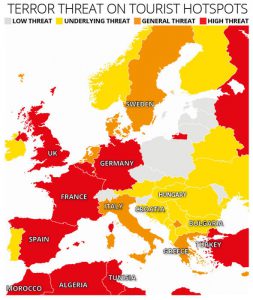
There is no terrorism in Croatia. We never had any significant incident which would be characterized as a terrorist attack, whether it’s religion-based or not.
While there is of course an ongoing terror threat across Europe, Croatia is generally too insignificant on the global political scale to be in any kind of constant alert.
Caution is always advised and I’m sure there’s always the possibility of some kind of terrorist attacks, but so far we’re lucky enough to stay completely off the radar.
Though some media ( see picture ) are putting us into the “Low level” of terrorist threats, in my opinion “Lowest or no threat” would likely be more appropriate, but I’m certainly no security expert.
It’s also worth noting that unlike majority of European countries, we have no confirmed ISIS fighters.
Our biggest terrors are restaurants and bars in tourist places whose prices can blow your mind.
Religion and conservative views
With over 90% of our population declaring themselves Catholic (according to 2011 census; source ), religious extremism is almost non-existent. Our biggest “religious-extremism” related news in the past few years was a dumb old bad who started a referendum against gay marriages.
Sadly she succeeded, but only in making sure it can’t officially be called “marriage”. Other than that, gay couples have the same opportunities and rights as others.
That being said, and being a predominantly Christian country, you can unfortunately expect many Croats to share similar conservative views. That doesn’t in any way imply that you shouldn’t visit my country if you’re gay, it just means you might need to prepare for a few weird looks or remarks if you’re displaying affection in public.
I’m certainly not sharing and even strongly disagree with such conservative views, but I’d still recommend keeping your lifestyle choices private, especially in Split, whose people aren’t known for being open-minded.
Crime and violence
Typically limited to incidents on football matches or domestic and drunken violence, Croatia isn’t a country where you need to be afraid. Many of our people are too busy trying to survive on low salaries to engage in shootings or mindless violence.
We don’t have gangs or a mafia operating on the streets, we don’t have terrorist attacks or bombings. Thankfully neither of these is something any Croat or a tourist needs to worry about, and hopefully it will remain so for a long time.
Feel free to roam the streets at night if you like. Locals won’t give you any trouble, and if some drunk kids are making dumb remarks just smile and walk away. Or have a drink with them. Stay happy and polite, and it’s likely to be reciprocated.
Keep your valuables safe
Sadly I’d be lying if I said we don’t have crime. It’s not widespread nor likely to happen to you, but leaving your car unlocked with valuables inside or leaving your things unattended on a beach is just inviting someone to take advantage of your oversight.
Don’t assume other tourists would never steal anything either, as it’s just as likely. Keep your wallet, phone or iPad with you or in your sights at all times. A bit of common sense can ensure your holiday will go without any frustration.
I’m not entirely unbiased, but I’ll go ahead and say that you can usually trust locals, especially in smaller places. Thieving on beaches is usually done as a crime of opportunity by other tourists, or by “visitors” from bordering countries to the east.
The fact is 99,9% of tourists will never experience theft, but that doesn’t mean you should throw common sense out the window and be reckless with your possessions.
As a tourist, your biggest worry should be our greed. Another fact I’m not proud to write about is that Croatian entrepreneurs can often be douche bags.
Outrageous prices at certain restaurants or bars is not uncommon, especially when located on high-trafficked seafronts or next to popular attractions. Some owners also keep two price lists: one with reasonable prices for locals, and the other for tourists where prices are often tripled.
Bad business practice which certainly leaves a sour taste of our country to anyone who notices it, but unfortunately it’s perfectly legal.
Make sure you check the prices of caffe bars and restaurants before you order. If you’re uncomfortable with their pricing, simply leave the establishment and check the next one. Nobody will blame you, and greedy business owners don’t deserve your money anyway.
That being said keep in mind that if you want to chill with your drink in the very center of old Dubrovnik be prepared to pay even 4-5 euros for a simple coffee. Barely a hundred meters away you can easily find bars with coffee for less than 1.5 €.
Not something you should expect in Croatia. You will almost always get what you paid for, just be sure to understand what you’re paying for beforehand. If you’re negotiating for a private apartment, ask the owner to show it before you agree to anything. Feel free to ask them to lower the price if you want, but don’t get mad if they refuse.
Anyone who has apartments for rent is likely making more than enough money and doesn’t have to resort to scamming tourists in any way. They may exaggerate certain things a bit, but it’s highly unlikely you’ll feel cheated as long as you have reasonable expectations.
When booking private accommodation I’d advise you to use online booking sites, not for safety but because you can often get deals with lowered prices. For cheapest accommodation you can search for hostels on Hostelworld , or private apartments on Agoda or Booking.com , just to name a few.
If the owner is making you pay extra for wifi access, consider the alternatives .
If you don’t use drugs then this topic really won’t concern you at all and you’ll never even notice it happening or give it a second thought.
First things first, you should know using, selling, or buying drugs in Croatia is not legal , and that also includes marijuana. If you need drugs to have a good time that’s your own choice (whether I disagree with it or not), but you should be prepared to face the consequences.
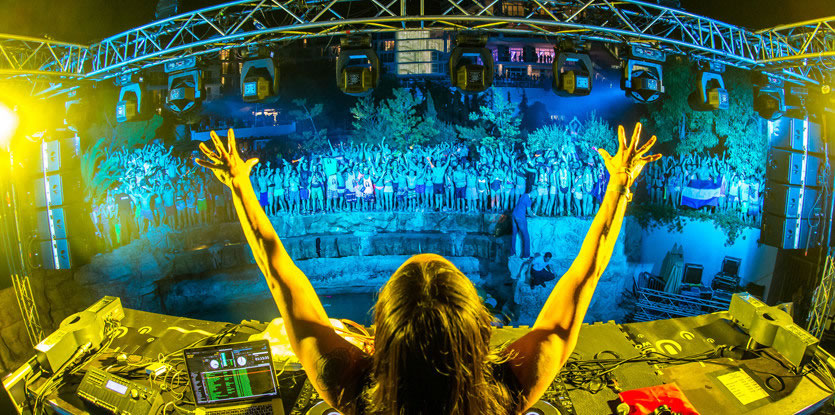
If our police catches you (as a tourist) in possession of illegal substances you can usually expect a €100 – €300 fine (don’t hold me to that exact amount though). Best advice I can give you is to at least try and carry a small amount “for personal use”, as any larger amount which could be considered “for resale” may get you into more trouble.
Simply pay the fine and move on, since trying to fight it will only get you more frustration and waste more of your time, and you’ll end up paying anyway. Trust me when I say a couple hundred euros is worth for avoiding our bureaucracy.
I’m saddened by the fact that Split is considered Croatia’s unofficial drug capital, where drug (ab)use is unfortunately overly common. This fact is further evident in July when about 150,000 additional tourists arrive within a week to visit Ultra Europe festival in Split, many of which are looking to score.
In 2016 (July 15th – 18th) during Ultra Europe there were 296 people taken into custody by the police, 189 of which were foreign citizens. Total fines issued equaled €78,636, which averages to about €265 per person.
Police also confiscated 1100 pills of ecstasy, 73 pills and 92 grams of MDMA, 13 pills and 80 grams of amphetamines, 253 grams of marijuana, 34 grams of cocaine, 12 grams of hashish, and 1.7 grams of ketamine.
8 people had criminal charges brought against them for producing and distributing drugs.
If you’re buying drugs in Split or anywhere else for that matter make sure you do it out of sight, and try to consume it in the privacy of your own accommodation rather than carrying it around. If that’s your lifestyle choice you can be as high as you like, just make sure you’re never using it in public.
If using drugs is your choice of vacation, consider visiting Zrce beach on Pag island where it’s much more commonplace throughout the summer. You can easily book a tour from Split and spend an entire day and night partying there.

Day Trip to Zrce beach from Split
Take a trip to Zrce beach, Croatia's top party destination. Hop on your Mercedes minivan with your group in Split and take a 4-hour drive to Pag island's Zrce beach. Return next day at 5 AM, giving you an opportunity for a wild night out and to catch some Z's on the way back.
See details & availability
At the very least there’s a much higher number of like-minded individuals in Zrce, so your chances of getting caught are significantly lower.
And don’t forget, alcohol is perfectly legal, and if you’re 18 or older you can freely purchase as much as you like.
During our high season period in July and August , not a day goes by without a tourist involved in some kind of an accident. Hikers getting lost on mountains or inexperienced sailors caught in our treacherous bura wind are among the most common, right after car accidents.
With tens of thousands of cars arriving from all parts of the Europe every day, there’s rarely a day without at least one car accident. Sadly it also sometimes ends fatally.
Best advice I can give you is something we often say in our country, when traveling the only thing you need to be armed with is patience . Driving for hours in our summer heat and dealing with traffic jams (often caused by accidents) can be a frustrating experience, but the most important thing is for you and your family to arrive safely.
Make a stop every couple of hours on gas stations and take a breather. Driving while frustrated or tired is never a good idea, and our sea isn’t going anywhere.
Police, ambulance or mountain rescue services can be reached by calling “112”.
Tourists getting lost while hiking in the mountains is now almost a daily occurrence as well. Our rescue services are kept busy 24/7 and doing a remarkable job despite all odds, and you can always count on them for extreme professionalism and experience, but that doesn’t mean you can throw caution to the wind.
When hiking bring plenty of water, some food, proper shoes, preferably your phone with GPS, and warm clothes just in case you get caught in a storm or strong winds. Storms happen even in summer, and temperatures can drop drastically at night. Most importantly you need to be sure you know what you’re doing and where you’re going, especially if you’re hiking alone!
Other than the above, boating accidents, heart attacks, or diving accidents are also fairly frequent. If you’re taking part in some adrenaline adventures like diving or mountain climbing make sure you’re either physically fit or experienced, and preferably both. If you’re not then book a tour with a professional guide to ensure things go smoothly.
Arguing with Croats
We are stubborn and prideful, and arguing with a Croat can never end well. I can assure you it will be a frustrating experience for both sides, and if in any way possible try to avoid it.
This has nothing to do with safety tips of course, I just thought it might be helpful to include it regardless.
Whatever nuance or issue you’re having, whether it’s an expensive lunch or a clogged toilet, just do it politely and with a smile. Don’t be arrogant or hold yourself above us. You may be making more money than we do, you may drive better cars or live in a fancier place, but that doesn’t give you the right to look down on us.
It honestly sounds a bit stupid when I write it down, but there’s countless tourists visiting every year expecting to be treated as royalty simply because they decided to spend money in our country. Our kindness is bought with respect, not money.
If you want to be pampered then book an all-inclusive resort , but don’t expect private accommodation owners to cater to your every whim.
As long as you’re our guest and treating us with respect and some common courtesy, we’ll reciprocate in the same way.
Croatia, Safest Vacation in Europe
There’s really not a country in Europe that I feel is safer to visit than Croatia. Despite our troubles, some of which I described above, I still consider my country a safe place to live in or visit, and since we’re too insignificant to meddle in other countries politics chances are we’ll stay a safe destination for a while longer.
All of this is of course my personal opinion based on, well, living here, but if you need more official info then you can verify some of it on U.S. Department of State website:
- Bureau of Consular Affairs
- Bureau of Diplomatic Security (Croatia Crime and Safety Report)
Global Peace Index ranked Croatia as the 27th safest country in the world in their 2019 report, out of 163 countries. United States and UK ranked our country to the lowest level of travel concerns, meaning travelers should only use regular caution.
Croatia is the kind of place where you can take a stroll at midnight knowing you’re perfectly safe. You can let your kids go to the beach or out at night knowing they’ll be safe, a truly family-friendly destination whose people will show you as much kindness and respect as you give them.
- Stay calm and drive safely on our highways.
- Don’t do anything unnecessarily reckless.
- Learn to say “Dobar dan” (means good day , greeting like “hello”).
- Avoid arguing with stubborn Croats, and don’t be arrogant.
- And be patient and happy.
Some common sense and a few tips above are honestly all you need for a pleasant vacation in Croatia, and I know you’ll have a great time.
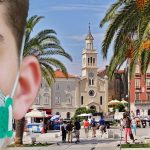
If you like this travel guide about Is Croatia Safe to Visit? Safety Tips for New Tourists and found it useful, consider supporting the author with a coffee or share it with your friends:
Compare deals from multiple websites to find your hotel, hostel, or private apartment for the best price! You can also check for flights and ferries to Croatia, book airport transfers in advance, or find most popular tours and cruises, all thanks to my partners!
- Accommodation
If the form above is not loading you can search directly on DirectFerries .
Below are my recommended sailing trips in Croatia from trusted companies and tour operators. Feel free to check the offers and links to find additional information and more related cruises!
From Split:
- Southern Explorer - explore top places between Split and Dubrovnik!
- Luxury at Sea - relaxing luxury cruise of best destinations near Split
- Southern Pearls - one-way cruise from Split to Dubrovnik
- Split to Dubrovnik One-Way Luxury Cruise - travel in style from Split to Dubrovnik
- Split to Dubrovnik Private Sailing Holiday - your own private yacht and crew
Top rated: Southern Explorer
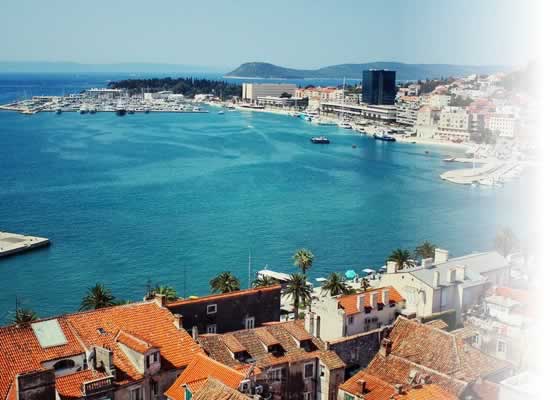
Starting and ending in Split, this cruise will take you to Makarska, Mljet, Dubrovnik, Trstenik, Korcula, Hvar and Brac!
Dates & pricing »
From Dubrovnik:
- Dubrovnik Discovery - discover top destinations near Dubrovnik
- Southern Pearls - one-way cruise from Dubrovnik to Split
- Luxury at Sea - one-way luxury cruise from Dubrovnik to Split
- Dubrovnik to Trogir - charming 8-day sailing trip from Dubrovnik to Trogir
- Adventure Sailing - kayaking, snorkeling, cycling and more in this active sailing adventure
Top rated: Dubrovnik Discovery
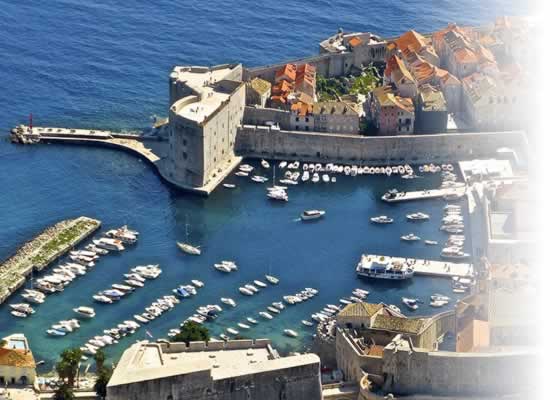
Depart from Dubrovnik on a week long cruise and explore Mljet, Hvar, Korcula, Trstenik, and Sipan.
More departure ports:
One-day sailing trips:.
- From Dubrovnik
- View all Croatia 1-day sailing trips
Organized tours are excellent ways to explore my beautiful country, and I highly recommend taking at least one trip during your visit. There are limitless fascinating places to see, and you can easily book a tour or day trip from my trusted partners below.
Below are five top rated tours from Split!
Discover more trip ideas:
- Top day trips from Split (my article)
- More tours from Split (100+)
- Tours from Dubrovnik (70+)
- See all tours in Croatia »
- Browse more tours on Viator (200+)
Find transfers and compare prices on:
- SoloTransfers (best prices from Split)
- HappyToVisit
- From Split airport
- From Split city
- From Dubrovnik airport
- From Dubrovnik city
From Any Location:
- Select any pickup and dropoff - from and to 200+ destinations in Croatia.
- From Split to Dubrovnik
- From Dubrovnik to Split
- From Split to Dubrovnik (shared transfer, special offer for only €55)
- From Dubrovnik to Split (shared transfer, special offer for only €55)
More options:
- Hire a private chauffeur (from €166/day)
- Rent a car on AutoEurope (from €40/day)
- Rent a car on RentalCars.com (price comparisons)
Cruises are fantastic and inexpensive way to discover multiple destinations in Croatia.
Split to Dubrovnik Cruise
8 days, 9 destinations
From Split to Omis and Makarska, Bol (Brac island), Stari Grad (Hvar island), Vis, Korcula, Mljet, Sipan or Slano, Dubrovnik
€ 480 - 890
(€ 60 - 111 per day)
Dalmatian Islands Experience Cruise
From Split to Omis or Pucisca (Brac island), Korcula, Lastovo, Green cave (Ravnik), Komiza, Blue cave (Bisevo), Stari Grad (Hvar), Bol (Brac island)
€ 615 - 890
(€ 76 - 111 per day)
Young & Fun Party Cruise
8 days, 8 destinations
From Split to Makarska, Korcula, Dubrovnik, Mljet, Hvar, Brac (Bol), Omis
€ 370 - 700
(€ 46 - 87 per day)
- ← Mobile WiFi Internet in Croatia – Options and Comparison
- Krka National Park Hosts Many Cultural Monuments →
Nik is Split.gg's manager and technical contact, who also occasionally writes an article or guide about traveling to Croatia. More about our authors »
You May Also Like
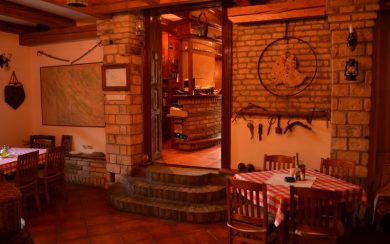
Konoba – Soul of the Dalmatian Cousine

Medical Tourism in Croatia

Useful Croatian Phrases You Must Know
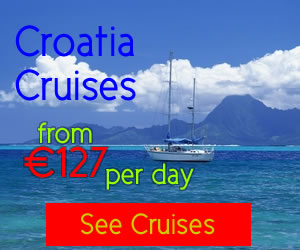
Currency Converter
Try my free currency converter:
HRK = Hrvatska Kuna - Croatian Kuna
From: HRK GBP EUR USD CAD AUD SGD EGP ARS BBD BRL CLP CNY CZK DKK XCD EEK HKD HUF ISK INR IDR ILS JMD JPY LVL LBP LTL MYR MXN NAD NPR NZD NOK OMR PKR PAB PHP PLN QAR RON RUB SAR ZAR KRW LKR SEK CHF THB TRY VEF
To: HRK GBP EUR USD CAD AUD SGD EGP ARS BBD BRL CLP CNY CZK DKK XCD EEK HKD HUF ISK INR IDR ILS JMD JPY LVL LBP LTL MYR MXN NAD NPR NZD NOK OMR PKR PAB PHP PLN QAR RON RUB SAR ZAR KRW LKR SEK CHF THB TRY VEF
- Skip to primary navigation
- Skip to main content
Collective Travel Guides
Inspire to Travel

How To Spend A Perfect Week in Split Croatia
Split is the second largest city in Croatia after the capital Zagreb and one of the most fascinating cities found along Croatia’s Dalmatian Coast. I spent a week with my son Tyrone exploring Split during our three-week incredible road trip around the Dalmatian Coast. We found many exciting things to do in Split Croatia, making our trip memorable. I hope you will be inspired by this guide and plan your epic Split adventure.

To help you out, we’ve compiled a list of the best things to do in Split in Croatia in a week including the most useful tips.
First things first, here are some answers to Split Croatia FAQ .
Where is Split Croatia?
Geographically, Split is located in Croatia, a country in Southeastern Europe, along the coast of the Adriatic Sea and specifically in the centre of Croatia’s historical region known as Dalmatia. Split has its own international airport, it’s well-connected by road, rail and sea to other regions in Croatia and to central Europe.
Is Split Croatia worth visiting?
Split Croatia is worth visiting for its fascinating history which dates back to the era when the city was part of the Roman Empire up to the time of Venice rule and occupation by Italy during World War II. The Old Town in Split is home to one of Europe’s few completed remains of a Roman Palace, the Diocletian Palace.

The city itself is full of life which will excite travellers of all ages. Split’s proximity to the Adriatic Sea, beautiful islands like Brac , Hvar, Vis and many other interesting places in Croatia make it a city you’ll definitely want to explore.
How many days do you need in Split?
My recommendation for a Split stay is two full days. This is enough time to explore Split Old Town, where most of the historical buildings are located, without being rushed. To explore Split and its vicinity to its fullest, consider a longer stay of at least a week.
Is Split nicer than Dubrovnik better?
Both Split and Dubrovnik are fantastic cities. The two cities are home to some of the finest historic buildings in Europe, both are situated along the beautiful Adriatic Coast and are within the vicinity of some of Croatia’s most stunning islands.
I recommend visiting both if you can though personally, I would choose Split for a longer trip as it’s cheaper with a lot more to do and is suited to all tastes. See things to do in Dubrovnik .

What is the best way to get around Split?
We hired a car from Xlrentacar for the whole duration of our trip to Split which was quite convenient and gave us more freedom and time to explore. Local buses in Split are also a great option to reach most of the attractions in this guide.
Car Rental Price: €500 /Week
Where to stay in split.
The best place to stay in Split is the area around the Diocletian Palace, especially if your trip is short. However, if you plan to stay for a longer period consider suburbs and nearby islands with great transport links such as Kastela, Podstrana and Brac Island .
We had an amazing stay at Hotel Split , a beachfront hotel located in Podstrana, about a 20-minute drive away from Split centre. The hotel is very modern, cosy and perfect for combining Split sightseeing with days of relaxation at the beach.
Choose Judita Palace Heritage Hotel , for a luxurious Split stay right in the middle of the Diocletian Palace. It’s a 19-room boutique hotel housed in a charmingly restored 16th-century palace overlooking Split’s central Square.
Let’s dive right in! Here is a list of our favourite things to do in Split Croatia in a week.
Top Things to Do in Split Croatia: Day 1

Join a Walking Tour of Diocletian Palace
Price: €14.00 duration 1.5 hour walking tour.
Start your tour of Split by taking a walking tour of the city’s most famous and remarkable landmark, Diocletian Palace.
The palace was initially built as a retirement home for the Roman emperor, Diocletian, in the fourth century and is now Split city centre. Diocletian, born Diocles in Solin, a town close to Split centre, rose through army ranks and reigned as emperor for two decades. In 305 AD, Diocletian stood down and retired to the palace and interestingly, found great joy in growing vegetables.

Diocletian Palace is an impressive structure that resembles a fortress with defensive walls, fortified towers and gates. Its narrow winding lanes are now Split’s vibrant streets which are home to countless shops, homes, restaurants and bars.
Interestingly, Diocletian Palace was built using the famous white stone from Brac Island which is said to have also been used to build the White House in America, UNESCO World Heritage Sites in Croatia such as the Cathedral of St James in Sibenik and the Cathedral of St Lawrence in Trogir .

A walking tour of the Diocletian Palace is worthwhile as the palace is huge with a lot of interesting sights to discover. The palace is adorned with several medieval fortifications and houses stunning Gothic, Renaissance and Baroque palaces, historical churches, medieval quaint streets and courtyards.
Fans of UNESCO World Heritage Sites will be delighted to know that Split Old Town including the Diocletian Palace is a listed site.

We found the Split Walking Tour to be informative and a pleasant way to tour the palace. Choose to take one of the several gamified sightseeing tours to explore the Diocletian Palace in a fun and interactive way especially if you’ve got kids with you or if games are your kind of thing. See Split’s best outdoor escapes rooms games here.
Tour Saint Domnius Cathedral & Bell Tower
Price: €11 red ticket.
Saint Domnius Cathedral is the second oldest Catholic cathedral in the world. It was built during the 4th century AD initially as a grave for the Roman Emperor Diocletian.

The history of the cathedral is intriguing. As you all know the Romans had a distaste for Christians as a result of this many left Split during Roman rule returning later after the fall of the empire. Diocletian’s persecution failed to eliminate Christianity in the city. Rather, his final resting place became a church dedicated to one of his victims, Saint Domnius.

Although small, the Cathedral of St Domnius is impressively furnished with altars, sculptures and wooden carvings dating from between the 13th and 15th centuries. Roman decorations portraying Diocletian and his wife continue to decorate the walls of the cathedral.

Taking the challenge to climb the 65-meter-high Cathedral of St Domnius’ Bell Tower is rewarded with a stunning panoramic view of Split. The climb up the tower is steep and narrow but landings along the way offer an opportunity to rest.
The best way to explore the Cathedral of St Domnius is to get the Red Ticket which gives you access to the Cathedral, Treasury, Bell Tower, Baptistery (Temple of Jupiter) and Crypt.
Explore Cellars of the Diocletian Palace
The cellars of the Diocletian Palace are quite fascinating and definitely worth checking out especially if you’re keen on learning a little bit more about the palace.
Over the centuries, Diocletian Palace was modified to make room for homes and businesses, but the cellars remained largely untouched until about 50 years ago.

The cellars are said to be a more accurate reflection of what the original upper floors of the Diocletian Palace looked like. Touring the cellars does feel eerie, I was even afraid to explore on my own. They are dark and empty with the exception of a 4th-century sarcophagus and a restored olive oil press which you can get up close to.

Filming of the dragon’s lair for Game of Thrones took place in the Diocletian cellars so if you’re in search of Game of Thrones filming locations in Croatia, definitely you won’t want to miss a visit here. The entrance hall to the cellars is lined with a variety of souvenir stalls which are a treasure trove for locally crafted items.
Take a stroll along the Riva
The Riva or waterfront is one of my favourite places to hang out in Split. This is also one of the most popular public places in Split where city festivities and celebrations are held. It’s a pedestrianised space decorated with palm trees, wide walkways and seats to relax whilst enjoying the lovely view of Split Harbour.

Also lining the Riva are colourful buildings that are home to outdoor-style cafes, restaurants and bars. The atmosphere here is lively with something to suit all tastes.

I recommend you spend some evenings here to immerse yourself with local life whilst enjoying some good food and drinking. Don’t miss trying out delicious Croatian snacks like Fritule in the food trucks you’ll find along the Riva.
Indulge at Gelateria Emiliana
Accepts cash only.
Gelateria Emiliana , located in the Diocletian Palace, is our absolute favourite shop to gorge on ice cream in Split. The shop offers high-quality delicious Italian-style gelato served with freshly baked cones made daily at their store. You can enjoy both classic flavours like pistachio and unique flavour combinations such as peach and rose, ricotta and fig and dark chocolate and sea salt.
Lavender products are sold everywhere in Split including Lavender ice cream. I recently got to try the Lavender and lemon flavour ice cream and surprisingly tasted really good.

Emiliana is a big hit in Split, so there is always a long wait, however, don’t be put off as the line moves pretty quickly. The ice cream is so worth the wait, it is the perfect companion to take whilst exploring Split sights
Things to do in Split Croatia: Day 2
Wander split old town streets.
One of the most enjoyable things to do in Split is to take a stroll in the Old Town’s narrow stone streets and passageways discovering cool courtyards, some beautifully decorated, some desolate and some home to lively bars and restaurants.

One thing you can’t help but notice during a stroll around Split Old Town is the huge amount of palaces. During medieval times, wealthy families often built their palaces close to city cathedrals for spiritual protection and to flaunt their wealth.
Similarly, most palaces worth checking out in Split, like the Gothic Grisogono Palace on Peristyle, are all scattered around the Cathedral of St Domnius and are built to blend with the cathedral’s exterior.

Whilst on your stroll around the Old Town, look out for some of the palaces which are open for public viewing such as the Papalič Palace (home to Split City Museum). These are the ones that are mostly converted into museums, restaurants and bars.

Ordinary people still live in Split Old Town, so you can expect to find laundry hanging outside on strings to dry, giving the Old Town a distinct character.

Explore People’s Square
People’s Square is the central square in Split Old Town popular with locals who traditionally come to meet and socialise as well as tourists who come to soak up the atmosphere. Chic restaurants and bars perfect for people-watching and alfresco dining are some of the entertainment on People’s Square.

People Square is also home to Gothic, Renaissance and Venetian-style buildings which are worth checking out. The 15th-century Old Town Hall which now houses the Ethnographic Museum takes centre stage at the square. Various exhibitions which are mostly free are run at the museum during the summer.

During my recent visit to Split, the museum was showing the works of poet and father of Croatian literature, Marko Marulić.

Other historic buildings to look out for that are around the People’s Square are the Renaissance Karepič Palace , Romanesque City Clock and the Gothic Cambi Palace built during the 15th century.
Visit the Pazar – Green Market
The Pazar (Market) or Green Market in Split is located beside Hrvojeva Street which runs along the eastern wall of the Diocletian’s Palace, around the corner from the Riva. This is the largest market I’ve come across on Croatia’s Dalmatian Coast. The Green Market is a lively place in Split because of the multitude of locals who traditionally shop at the market for most of their food supplies.

A variety of seasonal fresh produce, dried fruits and nuts as well as butchers stocking fresh meat and cured meats is offered in the many stalls and shops on the market. If you’re visiting during the summer you can expect to find stalls filled with gigantic cherries, strawberries, nectarines, figs, chard, all sorts of dried nuts and more.

Some stalls offer an array of locally handmade products which are ideal to bring home such as lavender-infused honey, herb-infused oils, ajvar or relishes and local wines.
The Green Market is a great place to wander, interact with locals and soak up the lively atmosphere.
Popular Split History & Market Food Tour
Visit the Fish Market – Ribarnica
The two main markets in Split, namely the Fish Market or Ribarnica (Fishmonger) and the Green Market (Pazar), are strangely in separate locations. The Fish Market is located in an interesting building architecturally, on Marmont Street, a few steps away from People’s Square.

Similar to the Green Market, the Fish Market is a staple for Split locals who source their daily supply of fresh fish from it. If you are going to be self-catering and enjoy fish, don’t miss giving this market a peek.
You will be interested to know that the Fish Market is said to be the only fish market in the world where you won’t find flies due to a nearby Sulphur Spa which keeps them away.
Both Markets are open: Mon-Sun from 6 am to 2 pm .
Try the coffee at 4coffee soul food.
Visiting 4Coffee Soul Food was quite a fun and unique experience in Split for us. If you love coffee, I highly recommend you give this small and quirky coffee shop a visit. 4Coffee Soul Food is nicely tucked into the eastern walls of the Diocletian Palace, opposite the Green Market.

We really enjoyed the pour-over coffee we sampled at 4Coffee Soul Food. It’s a small place so we took our coffees to go and sat on the sidewalk which was really lovely. You might also get to meet the owner’s beautiful dog.

Unfortunately, 4Coffee Soul Food is closed for summer 2023 but has promised to return next year.
Luckily, there are other really good options:
- D16 Coffee (Diocletian Palace Dominisova 16).
- Meštar o’Kave Speciality Coffee (Diocletian Palace Maruličeva ul. 2).
What to Do in Split Croatia: Day 3
Visit marjan park.
Marjan Park is a huge forested park situated on a hill in the scenic western part of Split Old Town. We drove to Marjan Forest Park, but it’s also possible to get there by bus, bike or on foot through the walking trails found along the western waterfront.

The most popular, but the challenging thing to do on a visit to Marjan Park, is to climb the 314 steps to the peak to enjoy a lovely view of Split Harbour, the city and nearby Kasuni Beach and Bene Beach.

The atmosphere around Marjan Park is really nice, a cool space to retreat from Split’s summer heat and crowds. The park is furnished with numerous walking trails, seats to relax, picnic spots and a small little shop selling refreshments.

Other interesting things to keep an eye out for are the small 13th-century church, Church of St Nicholas, the 15th-century St Jerome Church and the amazing hermitage caves which were built into cliffs by monks who once lived in the park.
Consider renting bikes in the Old Town to make the most of your visit to Marjan Park and the Marjan Peninsula area as a whole.
Popular Marjan Park Bike Tours
Explore the ivan mestrovic gallery, price: adults €7 , family ticket €9.
The Ivan Mestrovic Gallery and Marjan Park are perfect to visit on the same day as they’re close to each other. The gallery is fully dedicated to the works of Ivan Mestrovic, a celebrated Croatian Sculptor. The gallery’s permanent exhibition consists of Mestrovic’s significant works from 1898 to 1961 which include bronze, marble and wood sculptures, drawings and furniture.

The villa in which the gallery is housed and the surrounding gardens are quite impressive and both were built based on Mestrovic’s own designs. It’s a fascinating place and the story of Ivan Mestrovic is interesting to know.
Mestrovic Gallery is one of the top wedding venues in Split. The gardens are the perfect setting for an elegant Split wedding with their beautiful marble and bronze sculptures.

The museum ticket gives you access to Mestrovic’s Church, located about 200 metres away from the gallery, where you can view more of his stunning works; specifically, woodcarvings.
Good to Know
Personally, it’s fair to say that Split Museums are nothing to write home about besides the Ivan Meštrović Gallery. If you very much want to explore the best there is, add:
- Museum of Croatian Archaeological Monuments , located on the same street as Ivan Meštrović Gallery, (to discover archaeological artefacts of medieval Croats).
- Split City Museum (to learn the history of the city).
- Croatian Maritime Museum (to learn about Croatia’s maritime history and heritage).
- Museum of Fine Arts (to see paintings and sculptures by renowned Croatian artists from the 14th century to the present time).
Stop by Bishop Grgur Ninski’s Statue
During your tour of Split Old Town, look out for some of Mestrovic’s masterpieces such as the statue of the famous medieval Croatian priest, Bishop Grgur Ninski (Bishop Gregory of Nin), located outside Diocletian Palace’s Golden Gate. Rubbing the statue’s big toe is said to bring you good luck, so don’t miss it.

Visit a Wine Bar
Another lovely thing to do in Split especially if you’re serious about food and wine is to visit one of the wine bars in Split Old Town for a Split food and wine tasting experience.
Bokeria Kitchen and Wine Bar , Zinfandel Food and Wine Bar and Diocletian’s Wine House are some of the highly reviewed wine bars in Split worth checking out. Bokeria is easily my favourite of them all. They do a little bit of everything from a good selection of Croatian bottles to a really good brunch, dinner and cocktails.

The food at Bokeria is thoroughly traditional Mediterranean with contemporary touches complemented by a beautifully designed interior, excellent service and a lovely atmosphere.

Bokeria’s food menu is interestingly created using fresh and locally sourced ingredients. The food is full of flavour and also looks really good on the plate. I love the rich homemade pasta with truffles, prosciutto and mushroom. It must be so popular as it never leaves the menu.

The servers at Bokeria are very friendly and will assist you with pairing your food with the restaurant’s rich collection of mostly locally produced wines.
Book ahead to avoid disappointment especially if you plan to visit at night.
Popular Split Food & Wine Tour
Try the čevapi at kantun paulina.
Kantun Paulina , located on Matošica Street , is the spot to try a really good čevapi in Split if not in the whole of Croatia. So that you know, čevapi is a popular cheap street food found in the Balkans including Croatia.

There are many iterations of čevapi, however, the small finger-sized skinless sausages are mostly made with a combination of grounded beef, lamb, veal and a variety of herbs and spices.
At Kantun Paulina, the čevapi is served with fresh and the fluffiest pitta-like flatbread loaded with fresh raw onions and punchy flavoured sauces including ajvar.

Kantun Paulina is small and modest with just a handful of outdoor benches. Split summers are always nice, so you’ll mostly get to enjoy your čevapi on the go.
Things to do in Split Croatia: Day 4
Take a day trip to trogir.
Trogir is one of the oldest and most charming towns located on Croatia’s Dalmatian Coast. Trogir Old Town is full of history which is fascinating to explore and is surrounded by the magnificent Adriatic Sea similar to other places on the Dalmatian Coast like Split, Sibenik and Zadar .
If you are a fan of UNESCO World Heritage Sites, you will be interested to know that the whole Old Town of Trogir is a protected site.

Wandering around Trogir Old Town’s medieval streets and exploring pretty squares, cool courtyards and ancient churches is one of the big highlights of a tour of Trogir. See our full guide to Trogir here .

How to get to Trogir from Split
Trogir is less than half an hour away by car and about an hour by local bus from Split. The most affordable way to get to Trogir from Split obviously is to take the local bus (line 37) which starts at Sukoisan Bus Station , located about a 15-minute walk away from the old town.
Popular Trogir Day Trips
Things to do in split croatia: day 5, visit zlatni rat beach on brac island.
Exploring Brac Island and spending time on Zlatni Rat Beach was one of our favourite day trips from Split. Zlatni Rat on Brac Island is considered one of the best Croatia beaches located in Bol, the island’s biggest town. It’s a stunning and uniquely shaped beach with a “Blue Flag” status.
The area around Zlatni Rat is packed with all sorts of entertainment which makes spending time at the beach fun such as food stalls, restaurants and bars as well as children’s playgrounds.

Unsurprisingly, Zlatni Rat attracts a huge crowd. We found it more enjoyable to visit early in the day, have breakfast at the beach and spend the rest of the day exploring the rest of the island. See our full Brac Island Guide .
How to get to Brac Island from Split
Getting to Brac Island from Split is super easy with Jadrolinija , the Croatian ferry company. The company as well as a few private companies run several sailings for both passengers and cars every day from Split Ferry Port to Brac Island during the summer months. Jadrolinija Schedule
Brac Islands Tours
Things to do in Split Croatia: Day 6
Visit klis fortress, price: €8 children €2.50.
Visiting Klis Fortress, a medieval fortress, should definitely be on your list of things to do in Split especially if you’re a Game of Thrones fan. Klis Fortress was the filming location for Meereen . Even if you aren’t a fan of Game of Thrones, you will find a visit to Klis Fortress interesting.

Klis Fortress has a 2000-year-old history of providing defence to the Dalmatian region mostly from the constant attacks it faced from the Ottomans in the 1500s. The fortress is impressive and its location on top of a hill offers panoramic views of the city, the Adriatic Sea and the surrounding islands.

How to get to Klis Fortress from Split
It takes about 30 minutes to drive to Klis Fortress from Split city centre. A local bus ( line 22 ), leaving from the HNK bus stop which is located to the east of the Croatian National Theatre , is the most affordable option to get to Kliss Fortress. Bus tickets are sold by the driver or from the kiosk at the bus stop.
Relax at Bacvice Beach
Bacvice Beach is a public beach located within walking distance from Split Old Town, just at the end of the eastern waterfront. This makes it one of the most convenient beaches to visit if you’re looking forward to spending some time at the beach.
Bacvice is a huge sandy beach with crystal clear shallow waters, complimented with all the entertainment and amenities you can imagine to have fun at the beach.

It’s also a great place to hang out in Split Croatia for young adults during the evenings as the area transforms into a huge entertainment centre. Open-air cinema and concerts are also a regular feature at the beach, especially during the Split Summer Festival. See our guide to Split Beaches.
Things to do in Split Croatia: Day 7
Go rafting on the cetina river, price: €30 adults €20 children.
Rafting the Cetina River is one of our most memorable experiences in Split. River Cetina is a beautiful river with perfectly crystal clear waters surrounded by scenic rocks and a lush forest.

Rafting the Cetina Canyon is exciting because you get to explore incredible waterfalls, swim in caves and discover interesting fauna and flora along the way.

Most rafting tours on the Cetina River start in Omis, a small town located about 25km away from Split. We joined Pirate Rafting half day tour and had a blast rafting down the Cetina River. This was also our last day in Split, which was an excellent way to wrap up our visit.
Boat Tours in Split
Split is a great base for day trips to explore Croatia’s most beautiful parks such as Plitvice Lakes National Park , Krka National Park and stunning islands like Pakleni Islands near Hvar Town, Veli Drvenik to see the Blue Lagoon and Biševo Island for the Blue Cave .
If you’re travelling by public transport, the best way to visit these Split attractions is to join the many available boat tours including a speedboat tour from the Old Town Split.
Related: Things to Do in Zagreb in 2 Days
Split croatia – useful tips, covid testing centres in split.
Covid testing is available at Split Airport and also in Split City Center. Learn more here .
Learn about Split Croatia Travel Restrictions here.
Re-Open EU is another great resource to learn COVID-related travel measures currently in place in all EU and Schengen-associated countries.
Booking your flight to Split Croatia
My favourite flight search engine is Skyscanner . It’s easy to use and shows you many flight options at competitive prices.
Booking your accommodation
Airbnb is my favourite choice to find good value family-friendly self-catering accommodation in Split. We loved staying at this lovely apartment on Brac Islan d .
Booking.com is also a good choice to find lovely and affordable Croatia hotels.
Health insurance
In addition to travel insurance, we don’t visit another EU country without our European Health Insurance Card (EHIC). The EU Health Card allows you to access healthcare across the EU for free, or at a reduced cost. You need one for each member of your family. Learn more here
Money Cards
Revolut is our favourite money card to bring when we travel. It converts local currency at the best possible rates, charges no fees and offers easy tracking of your spending.
Plitvice Lakes Tour
I hope you enjoy your trip to Split Croatia. Let me know if you need help by leaving a comment below. I will be glad to help.
Tip: : Here is a guide with all the Best Places to Visit in Croatia including the most useful tips.
If you liked this Split Croatia guide, please pin to share!

edit – Related Croatia Travel Guide
This post contains affiliate links. We may earn a commission if you buy something using the links in our posts.
Reader Interactions
October 23, 2022 at 9:01 am
Hey guys! I must say that as a Croat from Split this guide is very good! Good work! I would suggest visiting the stadion Poljud, a Prokurative square in Split and the beautiful city of Omiš. When visiting Split there are many possibilities for day trips to nearby cities and islands so when you are in Split don’t miss the opportunity to check them out! I hope you would return one day or go to Dubrovnik, which really has lot to offer. Thank you and goodbye!! 😁🥰
October 23, 2022 at 9:04 pm
Hi Jere! Thank you for your comment. I agree with you, Omis is stunning. We will definitely check Poljud Stadium the next time we visit Split.
January 14, 2023 at 11:40 pm
Thank you for the excellent article and great tips – we’ve just started planning a trip to Croatia from the US in Sept and are super excited.
January 15, 2023 at 7:32 pm
Thanks Friea for your positive feedback! Split is an amazing place and you’ll love it. Have fun!
September 3, 2023 at 8:23 pm
I will be in Split mid september and looking forward to visiting the must see sites..My foody friends were asking where the best local seafood restaurants are in Split, ..in case you’d had a suggestion ? thanks !
September 3, 2023 at 10:26 pm
Hi Nancy, I will give you a few places that are really good. 1st for seafood in Split is Konoba Nikola in Stobrec, located a 12 min Uber ride from Split Old Town, Villa Spiza located in the Diocletian Palace and Konoba Fetivi in the Old Town. Have a great time in Split.
October 24, 2023 at 12:17 pm
Split is a vibrant and historic city with something to offer everyone. I recently had the opportunity to visit, and I was absolutely blown away by its beauty and charm.
One of the highlights of my trip was visiting Diocletian’s Palace, a UNESCO World Heritage Site. This ancient palace is now a bustling city center, and it’s a great place to wander around, explore the shops and restaurants, and soak up the atmosphere.
I also loved climbing to the top of the bell tower of St. Domnius Cathedral for stunning views of the city and the surrounding islands. If you’re looking for a more active adventure, you can take a boat trip to the nearby island of Hvar or go hiking in Marjan Park.
October 26, 2023 at 4:42 pm
Thanks Helia for your comment. I am glad you liked Split, it’s one of my favourite cities in Croatia, incredible beauty and history.
Leave a Reply Cancel reply
Your email address will not be published. Required fields are marked *
Explore more

for Solo Travel Over 50
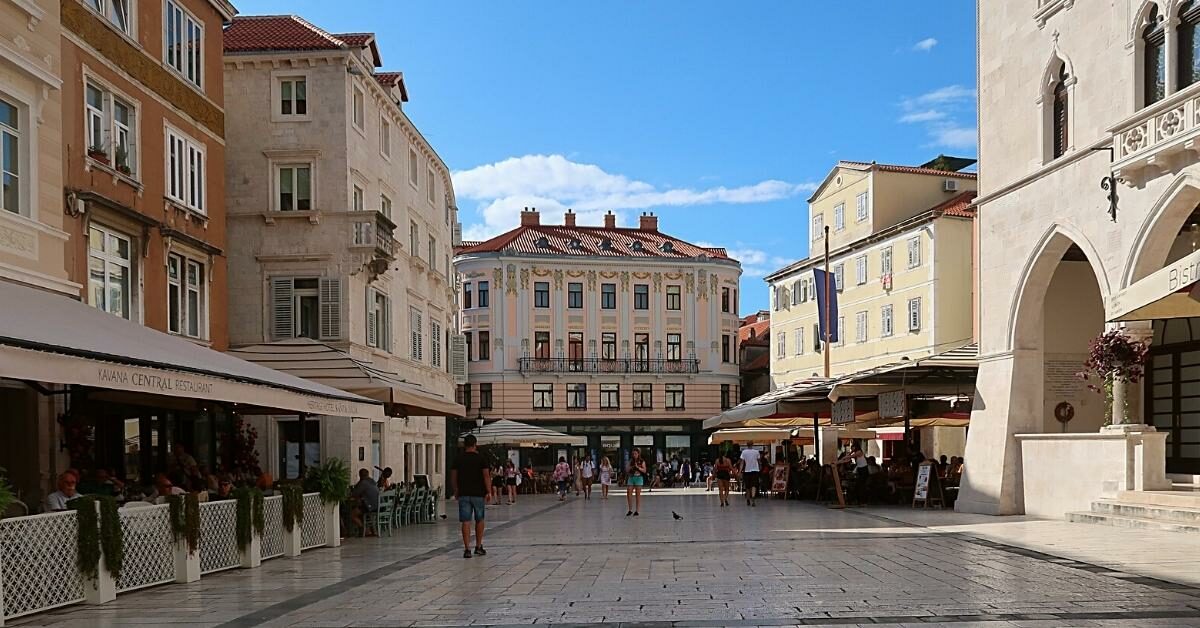
Ultimate Guide to Split Croatia Solo Travel (2024)
Rev. 4/2/24
Are you looking to explore some of the stunning Adriatic coast on your own terms? Then head to Split, Croatia. Compiled from my first-hand Split solo travel, this ultimate Guide to Split Croatia Solo Travel has all things Split travel tips with bonus budget travel tips, eco-travel tips, and more throughout. This is your one-stop-shop to plan an unforgettable solo Croatian vacation in Split.
Whether a single day trip or a full-on solo adventure, Split will wow you. This ancient city has stunning landscapes and beaches, gobs of history, incredible food and wine, and friendly locals. Better yet, Split a great jumping off point to explore surrounding islands like Hvar, Brač and Korčula, to name a few, as well as other Croatian gems like Trogir, Solin, Makarska and more .
Get ready to explore Split, Croatia.
This Split Travel Guide is intentionally written for the solo traveler, the first time Split traveler, and/or older traveler (I am over 50 and have been solo traveling FOREVER) in mind. Yet, anyone can use this travel guide it to plan and book Split Croatia travel.
Like this? Share it with others!
This post may contain affiliate links for your convenience. For products, the goal is to first provide direct links to eco-friendly, ethical, and sustainable companies, and then to those same type (i.e., Climate Pledge Friendly Certification ), of brands that use Amazon, if possible. Therefore, you may see multiple links for one option. Should you make a purchase through any link, I will receive a small commission at no additional cost to you. See my Disclaimers & Disclosures and Privacy Policy for more information.
Ultimate Croatia Solo Travel Guide
What is split croatia known for, best time to visit split croatia, getting to split croatia, getting around split, is split croatia safe to visit alone, split packing essentials, best place to stay for split solo travel, 5 must dos on split croatia video, more best things to do in split, day trips from split, best booking sites for split travel, how to get the best of split croatia in 3 days.
If you need more Croatia travel tips to supplement your solo travel Split Croatia planning, consult this ultimate Croatia Solo Travel Guide full of tips on culture, entry requirements, currency, tipping, using electronics, safety, and a lot more to plan solo travel in Croatia.
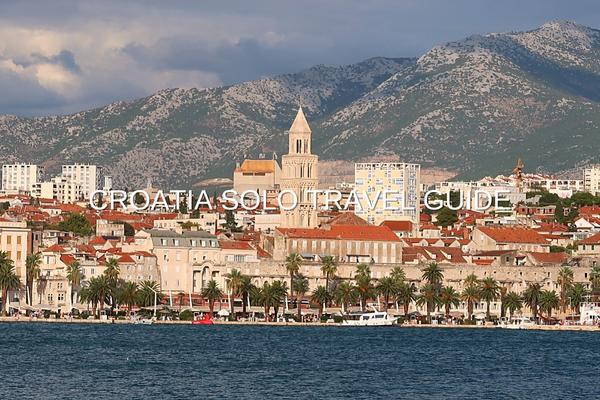
Croatia had been on my travel bucket list for many years. When finally able to go, I couldn’t decide which city to choose first to experience Croatia: Dubrovnik or Split. Choosing Split was one of the best decisions I ever made.
Want to know what an incredible time I had in Split? Don’t just read. Use my Best of Split in 3 Days Itinerary and you, too, will experience the perfect, first-time Split solo travel.
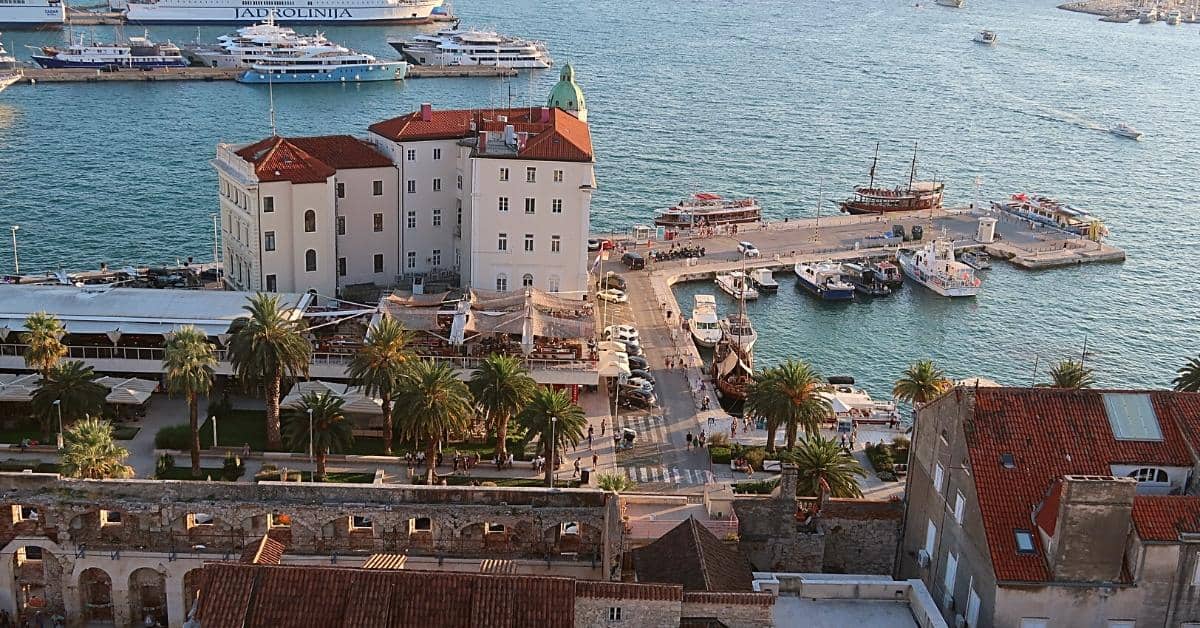
Unforgettable 3 Day Split Solo Travel Itinerary 2024
More europe solo travel guides & itineraries.
- The Ultimate Santorini Greece Solo Travel Guide
- Best of Zakynthos Greece in 3 Days Itinerary
- Ultimate Zakynthos Solo Travel Guide
- How to do a Rome in 3 Days on a Budget
- Best of Italy in 2 Weeks Itinerary (No Car Required)
- 7 Best Europe Beach Destinations for Solo Travelers
Croatia’s second largest city, Split is the largest city in Croatia’s Dalmatia region and situated nicely between mountains and the crystal clear waters of the Adriatic Sea and lovely Dalmatian Coast islands.
Split offers history, colorful architecture and Roman ruins, spectacular wine tasting and cuisine, outdoor land and water activities, and some of the best beaches in Europe , if not the world.
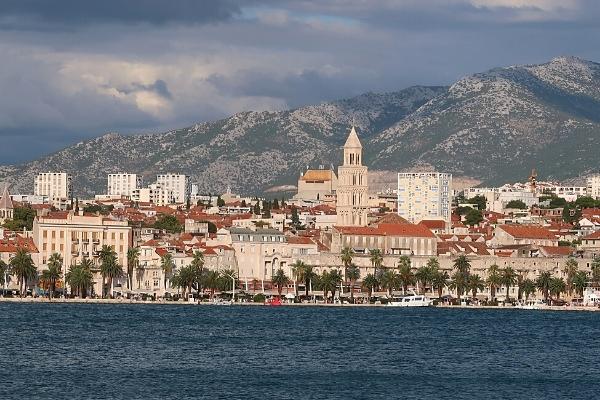
Split is best known for being the home of the Diocletian’s Palace , a UNESCO World Heritage site and a must see in Split. Built for the Roman emperor Diocletian, the palace consumes most of the Old Town. It was built in the fourth century AD, which also marks the establishment of the city of Split itself.
The area of Split is also known for being the origin of the zinfandel grape (no, it’s not from California or Italy), and where the famous Zlatni Rat Beach (Golden Horn) resides on nearby Brac Island .
Is Split Croatia worth visiting?
Considering the history of Split Croatia alone begs visiting Split. Ask any local, young or old, a question about Split, and they will proudly regale you with historical facts and stories, as well as provide recommendations on what to see in Split. Their knowledge and enthusiasm of their hometown and country is infectious.
Croatia had been on my bucket list for many years before I actually had time to carve out 3 days in Croatia . I had wrestled between Dubrovnik and Split for my first Croatia solo trip.
However, I couldn’t escape the lure of the history and thoughts of visiting the surrounding islands for beach time and wine tasting, so Split solo travel it was. The bigger problem was making my solo travel itinerary for just 3 days in Split .
There is much to see and do in Split. Yet, Split is a place in Croatia to take it slow, like lounging on the beach . If you have 4 days in Split, or a week in Split, even better.
The best time to travel to Split, Croatia depends on weather, costs, activities and events offered.
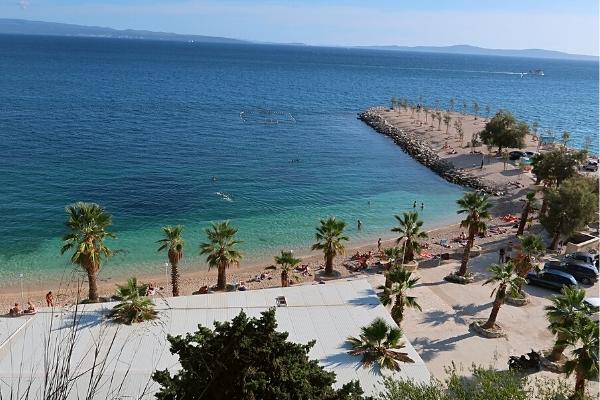
Split Croatia Weather & Costs
Like many European countries, peak tourist season in Croatia is June through August. The weather in Split Croatia is also at its hottest with an average of low 80F degrees and the least amount precipitation. These are, however, the most expensive months to visit Split.
After peak season may be considered the best time to go to Split Croatia. September and October offer warm weather and water, fewer tourists, and slightly lower travel costs.
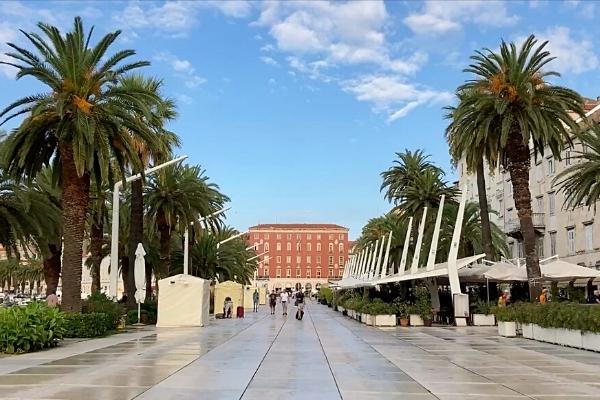
April and May are lovely months to visit Split as well, but the water may be cooler.
November through March, Split’s winter, has an average temperature of 45F degrees but also fewer tourists and lowest costs. Split in winter would be when to solo travel on a budget.
My last solo travel in Split was in September, and it was lovely. To get the best Split solo travel experience, May to October would be when to visit Split.
Festivals in Split Croatia
I always suggest checking the local events calendar when planning solo travel.
There are festivals in Split Croatia year round. Consult them to know how they may impact or enhance your Croatia travel.
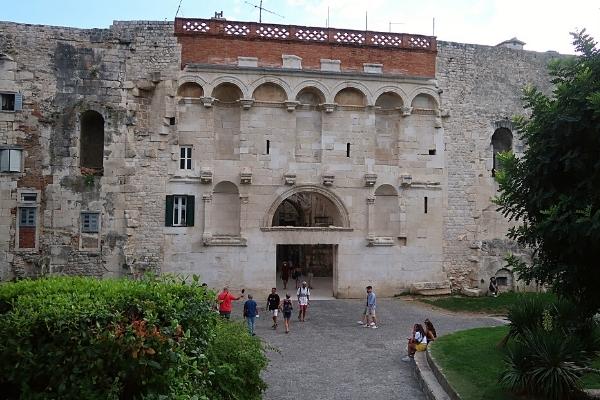
Is Split Croatia Expensive?
Split is not as expensive to travel as some other European cities, like Copenhagen or Paris .
For example, an inexpensive meal in a restaurant could cost 60 kuna, a bottle of import beer 18 kuna, or a cappuccino 12 kuna. Buying food in a store would cost less and make your single travel budget stretch further.
Split has budget city center accommodations and Split activities can be done inexpensively, such as a group boat tour to Blue Lagoon , or even free such as exploring beaches on foot.
Of course, luxury accommodations in Split and high-end activities, like taking a private boat trip to Blue Lagoon and islands , also exist.
The point is, Split can be enjoyed across different budgets.
Croatia Solo Travel Tip s
Croatia’s currency is the Kuna (HRK), not the Euro. Croatia is not yet a part of the European Union (at time of this writing). Manage your currency exchange wisely on your solo trip to Croatia.
There are ATM’s a plenty in Split for you to extract local currency, if need be.
Europe Solo Travel Tips & Ideas
- Top 10 Tips on How to Do a Solo Beach Trip
- How to Choose Your First Solo Trip Destination
- 10 Must Know Planning Tips for First-Time International Travel
- 6 Tips on How to Avoid Airport Lines
- How to Travel Carry-On Only
Flying into Split
Flights to Split Croatia arrive at the Split Airport (SPU) . The Split Airport has one main terminal and there are multiple airlines that fly to Split .
The airport is about 23 kilometers from the Split city center. If your hotel does not offer airport shuttle service, there are several other Split Airport transport options to get from Split Airport to the city centre.
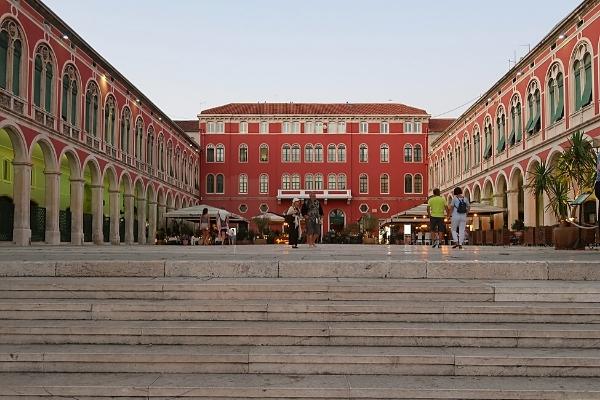
Search for Cheap Flights to Split
Croatia eco travel tip s.
For only 2 to 3 hour flights to Croatia, or within, take the train or the bus to Split instead. It could also save time and money, and the scenery is much prettier.
Split Airport Transportation
Split airport taxis and rideshares.
An easy option is to take a Split Airport taxi or hire an Uber or Bolt rideshare , all available at the Split Airport. My Uber from Split Airport to Old Town cost 258 Kunas with tip (at time of writing), which is about the same cost as a taxi.
Catch your airport rideshare on the main street at the public bus stop. Taxi and rideshares from Split Airport to city center take 20-25 minutes, depending on traffic.
Note, when I take a ride share or taxi, I like to pick the driver’s brain for information on the location, get good activity or dining tips, or tips or what to do or avoid.
Locals are the best source of travel information. In Split, the locals are friendly, a wealth of information, and they love to share.
When hiring a rideshare, choose the Bolt Green or Uber Green options, or use Carpoolworld , to support the use of electric cars and carpooling for cleaner transportation in Croatia.
Split Airport Transfers to Split
A budget friendly, more eco-friendly, and quick option is to hire a transfer from Split Airport to Split . Trips are 45 minutes to Old Town and the cost is very comparable to a taxi or rideshare. Plus, you can book a Split Airport to Split transfer in advance .
Split Airport Transfers to Outside Split
If you are staying on of the islands around Split like Brac or Hvar, or a little further outside of Split, there are more Split Airport transfer options.
Split Airport Transfer to Islands & More
The following are eco-friendly transportation options, however, will save you money if you are traveling Split on a budget.
Split Airport Train and Bus
There are public Split Airport buses available to take you to the Kastel Stari train station in Split where you catch the train to the Split main railway station next to the Port of Split.
The public Split Airport bus ride is about 10 minutes, with the total trip taking about 35 minutes and costing 25 Kunas, a very Split budget friendly method for getting to Split.
Split Airport Bus
Another budget friendly airport transfer is the Split Airport bus . For 40 Kunas, you can catch the #37 bus directly from the main terminal with a ride to the main Split bus station, next to the main railway station, taking about 35-40 minutes. You pay the driver on the bus.
Split Airport Car Rental
I advise against renting a car if staying solo in Split, or close to Split. Why deal with city center parking and additional petrol expenses? Here are better ways to get from the Split Airport.
If your Croatia travel involves off-the-beaten path travel, however, then renting a car at the Split airport may be best for your Croatia solo travel itinerary.
Explore Split Car Rentals
Bus to split.
Buses to Split arrive at the main Split bus station which are quick, inexpensive, and eco-friendly ways to get to Split from other countries or Croatian cities.
Train to Split
Same goes for trains to Split. Check the Split train tickets and schedules to the Split railway station next to the Port of Split.
Trainline Provides Cheap Train and Bus Tickets to Split
Ferry to Split
If you’re already in Croatia or coming from Italy, a Croatia Ferry may be an option for you on your solo travel to Split.
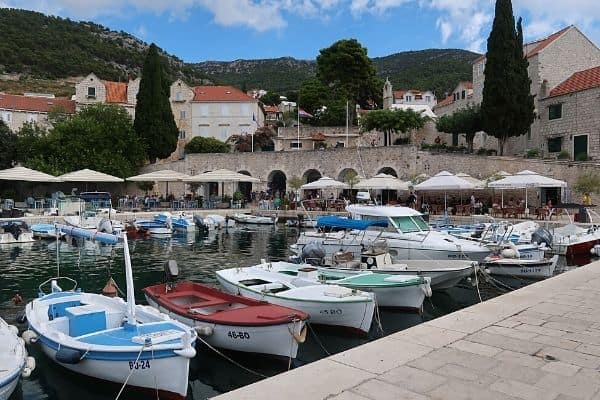
Is Split walkable?
Yes, Split is very walkable. In fact, many of the top things to do in Split are accessible by foot.
Old Town and the palace are only comprised of narrow, stone pedestrian streets packed with restaurants and cafes, hotels, boutique shopping, and never ending history.
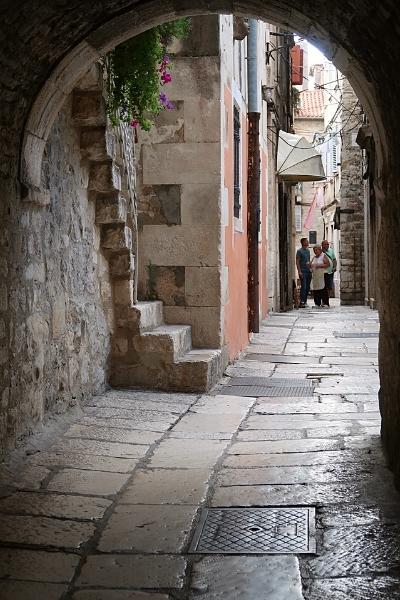
If you want to learn more about Split or its incredible food and wine, consider a historic walking tour or Split food walking tour . There are private and group tours available. Again, group tours do provide that additional chance to meet others when traveling Split alone.
Best Split Group Walking Tours
Best split private walking tours, tour split by bike or scooter.
Looking for exercise while seeing more of Split? A large portion of Split is flat, but also surrounded by picturesque beaches and the Marjan Park, ideal for biking and/or scootering. Consider renting a bike in Split or scooter.
Save Time and Book Your Split Bike or Scooter in Advance
Want company riding around to enhance your Split, Crotia solo travel? Split has group bike tours . These tours are eco-friendly and a great way for solo travelers of all ages to to learn more about Split while meeting new people.
Best Split Bike Tours
More eco travel tips & ideas.
- 25 Must-Have & Eco-Friendly Solo Beach Trip Essentials
- 15 Eco Long-haul Flight Essentials for Solo Travel
- Top 10 Eco-Friendly Carry On Luggage
- 10 Best Eco-Friendly Personal Item Bags for Flying
- 10 Amazing Eco-Friendly and Sustainable Swimwear Brands
- 10 Easy Ways to Be an Eco-Friendly Traveler
Tour Split by Water
Considering Split sits on the crystal clear waters of the Adriatic, and flanked by multiple islands just begging you to explore, how could you even consider missing the chance to tour around Split by boat, kayak or other?
On my last solo trip to Split, I did boating to an Brac and swam at the Golden Horn Beach. I also did a morning kayak from Bene beach with cliff jumping while also swimming off Kasjuni beach. The group and tour was so much fun. I was the oldest person in the small group kayak tour and had a blast .
Day or night, Split boating and water adventures are a must on Croatia solo travel.
Best Split Boat Tours and Cruises
Best split water activities, split public transport.
The Split bus is another way to explore Split beyond Old Town.
The main Split bus terminal is a convenient 10 minute walk from Old Town. Split public bus tickets are inexpensive, bus lines run daily from 5am to midnight, and the Split public bus network is extensive opening up more possibilities for fun on budget Croatia solo travel.
Crime in Split is very low. Split is also considered very safe to walk alone day or night, so you don’t need to worry about safety in Split as solo female traveler. I never felt unsafe walking alone in Split on my over 50 single travel.
As always, practice general safety measures, such as walking on well-lit streets and keeping your belongings on you at all times, especially in crowded or touristy areas.
Other than that, you should consider Split one of the best places to go by yourself.
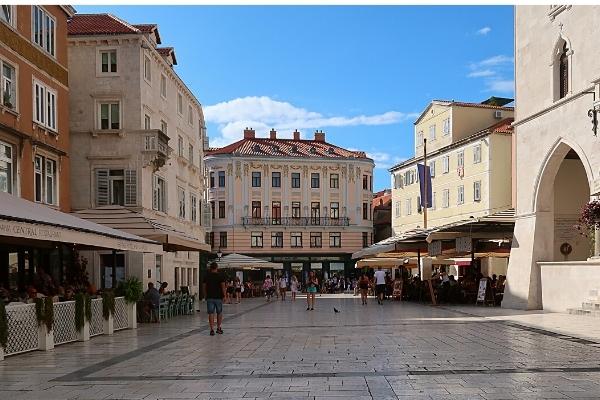
I’m not one to tell someone else how to pack, but there definitely some solo travel essentials I would recommend taking on your solo travel to Croatia, like the following.
This list of travel essentials combined can make your Split, Croatia solo travel easier and more memorable while being friendlier to the environment.
The Split city center, including the Old Town, is where it’s at for first time solo travel to Split, as indicated on the map below.
Many of the must do Split activities and attractions, including access to Split nightlife, are within minutes of walking or a quick bus ride away from the bus stops close by.
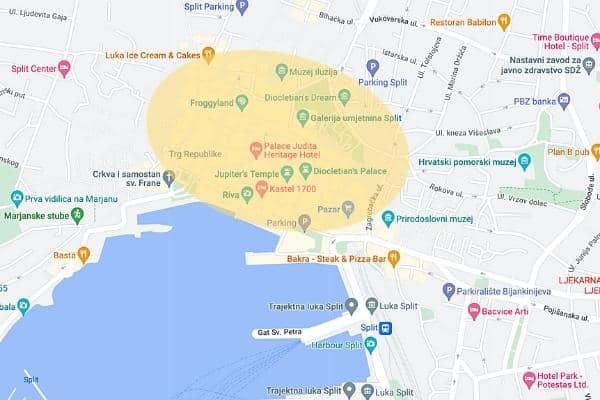
Of course, you can stay outside this section of the Split city center, but it may just add a little time to this Split, Croatia solo travel itinerary, depending on what you ultimately decide to see and do in Split.
Split Solo Travel Tip s
Have WhatsApp on your mobile device(s). Many smaller establishments and activities offices use this as a method of communication making it easier to make inquiries or booking and learn, or notify, of any scheduling changes.
Get the T-Mobile International Plan or something similar in price and features. I no longer work on WiFi only on international travel. I’ll use it when it’s there, but having access to roaming when needed for GPS and Google Maps is a game changer.
Split Hotels and More
There are many accommodations in Split city center across all budget types to choose from. Going in the off season, or booking well in advance, will get you the best Split prices.
Book a Travel Sustainable-rated property , or at least employs these methods into their business to reduce your travel carbon footprint.
Split Hotels
Hotels in Split range from budget to luxury.
For location, price, breakfast, amenities (including free-cancellation), eco-friendly and sustainable operations, and customer reviews and ratings, here are my best hotels in Split recommendations in or around Split Old Town ideal for over 50 solo travel on a Split 3 day itinerary (i.e., where I would stay):
- Cornaro Hotel
- Jupiter Luxury Hotel
- Heritage hotel Santa Lucia
- Hotel Slavija
- Starlight Luxury Rooms
I last stayed at Starlight Luxury Rooms conveniently located around the corner from Diocletian’s Palace . My room and bed were large and comfortable, the breakfast was incredible, and the hotel staff friendly and helpful.
In fact, ask for Mario. He was the bomb . He had such great information, helped me with activities, and was accessible by a quick WhatsApp message.
2023 update: Starlight Luxury Rooms is now Travel Sustainable rated through Booking.com. I knew it was a matter of time considering their sustainable initiatives (below).
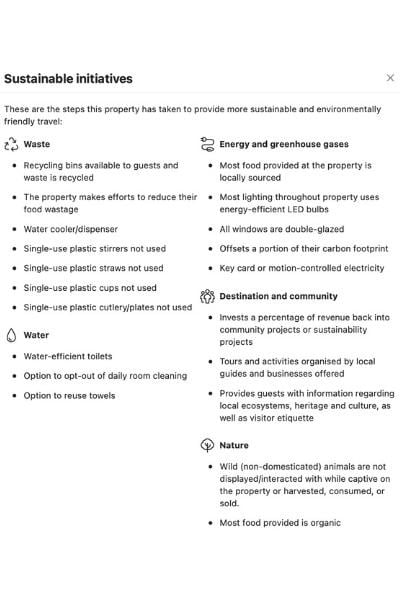
Reserve Split Accommodations Early for the Best Price
Split eco travel tip s.
In addition to Booking.com’s Split’s Travel Sustainable properties , Green Globe and Green Key Global also have eco-friendly certified lodging options.
Split Hostels
Hostels in Split city center can be a budget accommodation for over 50 single travel. Using the same conditions above, with the ability to get a private room, my Split hostel for solo travel recommendation is Hostel Dvor .
It is in a good location and also employs some sustainability initiatives.
Split Budget Travel Tip s
Hostels in Split Croatia could start from around €20-30/night, depending on what amenities and location you want. Note, these are usually for a bed in a dorm room. A private room in a Split city center hostel could cost the same, if not more, than a budget hotel.
Reserve Split Hostel Early for the Best Private Room
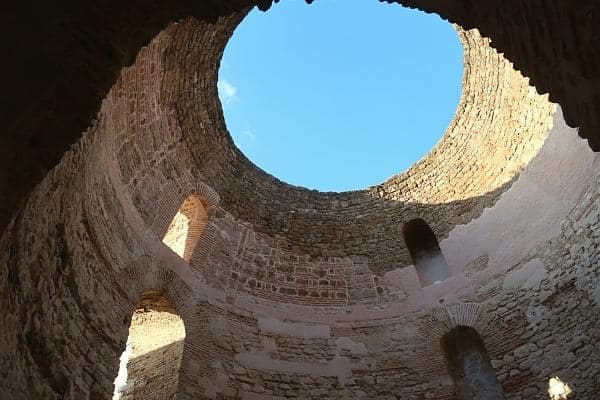
So, what are the best things to do in Split as a solo traveler?
Start with these 5 Split must do’s in this video. After this glimpse of Split solo travel, you’ll be dying to book your flight to Split .
Ways to Do Split MUST DOs
You have to keep in mind Split’s ideal location, beaches and proximity to parks and islands that can keep you hopping, pardon the pun.
Here are more must see Split attractions for your Split itinerary perfect for a single traveler. If you want to know how to see most of them on your first time Split travel, use my Best of Split in 3 Days Itinerary . It’s all in there. Easy peasy.
Churches & Cathedrals
- Saint Duje’s Cathedral (St. Domnius Cathedral)
- Crkva Gospe od Prizidnice
- Katedrala sv. Lovre (St. Lawrence Cathedral)
- Katedrala sv. Stjepana I. (St. Stephen’s Cathedral)
- Zupna Crkva Gospe Od Karmela , Bol
- Katedrala sv. Marko (St. Mark’s Cathedral)
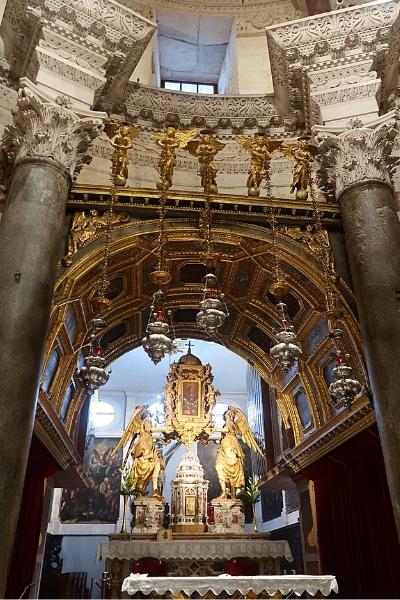
Architectural Buildings & Historic Sites
- Diocletian’s Palace
- Peristil Square
- Jupiter’s Temple
- Saint Domnius Bell Tower
- Porta Caesarea , Salona
- Roman Ruins of Salona
- Tvrđava Fortica (Spanish Fortress), Hvar
- Klis Fortress , Klis
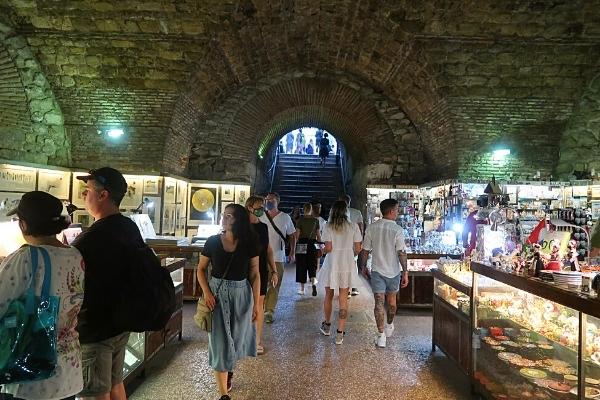
Split Landmarks, Points of Interest & Monuments
- Narodni trg (Pjaca Square)
- Trg Brace Radic (Fruit’s Square)
- Marmontova ulica (Marmont Street)
- Riva Harbor
- Statue of Grgur Ninski (Gregory of Nin)

Museums & Aquariums
- Ivan Meštrović Gallery
- Archaeological Museum of Split
- Split City Museum
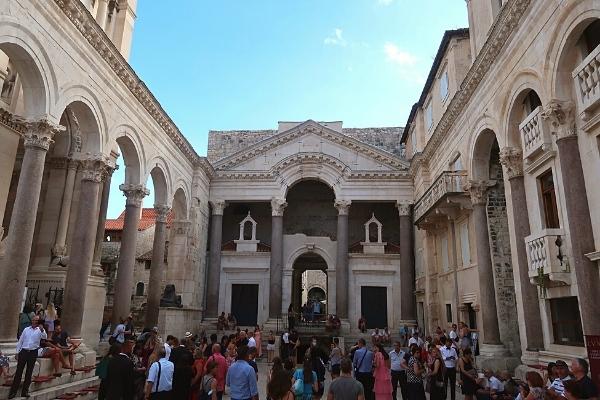
Parks and Gardens
Get out and enjoy some incredible nature and hiking around Split.
- Marjan Hill
- Park Šuma Marjan (Marjan Park)
- Mali Kozjak
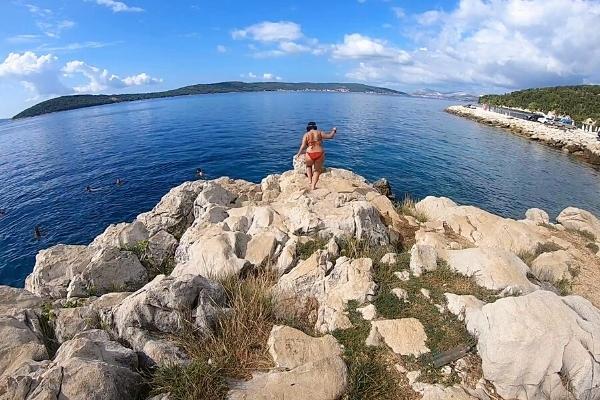
Split Beaches
Split is not short of spectacular beaches. Here are but some of the best Europe beaches you can find in Split accessible by foot, Split public transportation or a ferry.
Relax and sunbathe, or swim, snorkel, dive, kayak, parasail, paddle board, cliff jump or more.
Split Travel Tips
It can get hot in Split. Make sure you stay hydrated and wear your good marine and reef safe sunscreen all day.
For the best beach experience on your Split solo travel over 50, check out the 25 solo travel essentials for going to the beach alone and the top tips on how to do a solo beach trip .
Many beaches have lounge bars with lounge chairs and umbrellas. Some are even nude beaches. Heads up.
- Bačvice
- Kašjuni
- Kaštelet
- Ježinac
- Zlatni Rat (Golden Horn), Brač
- Nugal , Makarska
More Solo Beach Travel
- 25 Must-Have Solo Beach Trip Essentials
- Top Tips on How to Do a Solo Beach Trip
- Best of San Sebastian Spain in 2 Days (or 3) Itinerary
A must do in Split is taking a ride out to one of the following islands from Split. Here are some that are available to see:
- Hvar Island
- Brač Island
- Korčula Island
- Biševo
- Šolta Island
- Mljet Island
- Čiovo Island
Hvar, Brac and Korcula are ideal for a day trip from Split. There are daily, high speed ferries from Split to Hvar , Split to Brac , and Split to Korcula .
Each island offers its own charm, special beaches and activities. It may be hard to decide on just one. If you want to go to more than one island, there are island hopping tours from Split.
I suggest going to as many islands off Split as you can. Definitely go to at least one.
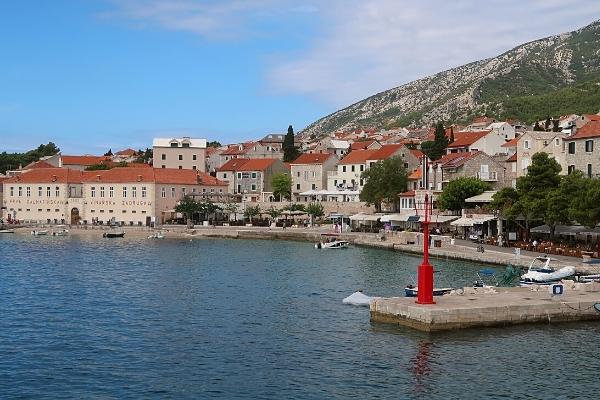
Best Island Tours from Split
Split croatia dining & entertainment, split restaurants.
Dining in Split can be hard only because of trying to choose from one of the kanobas (restaurants) and bars galore in Old Town and on the Riva. Wander the streets to find one or get a recommendation from a local.
Here is a list of restaurants in Split to get you started. For good meals that won’t break your bank, I recommend checking out Corto Maltese , Restoran Skalinada , or Konoba Varoš .
Definitely have the gelato at Gelateria Emiliana . Don’t be surprised if there is a line. It’s worth the wait.
What to eat in Split? Croatia’s long history is truly reflected in its cuisine that has Italian, Turkish, Hungarian and other influences.
Situated on the Adriatic, the Italian influence is heavy in Split’s cuisine. Popular are dishes of cheeses, prosciutto, bread with olive oil, and olives.
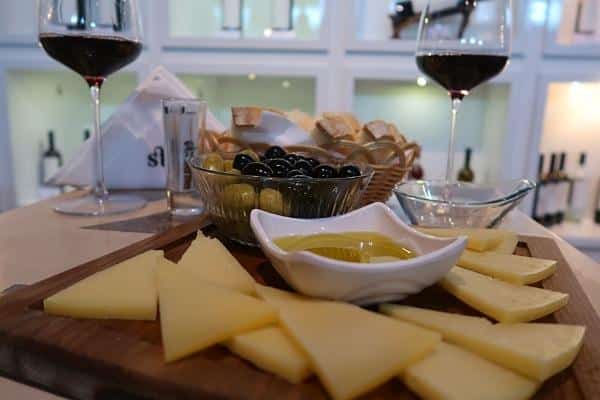
Seafood is also a large staple in Split dining, such as skampi, mussels, crabs, octopus, and the like. Dishes may be served with sides of spaghetti, njoki (gnocchi), or risotto. Beef and fish stews are also popular.
For dessert, try a fritula (traditional pastry like a powdered sugar donut) or rozata (pudding with caramel sauce).
By all means, do not lose out on tasting the local wines, like whites made from the Pošip white wine grape native to Korčula or luscious zinfandels. Croatia has amazing wines, and wine tasting, or taking a wine tasting tour from Split , is another Split must do.
Eco Travel Tips
Avoid using single-use plastics when dining, shopping and on food tours in Split to reduce plastic waste and your carbon footprint by bringing your own reusable collapsible shopping bags , collapsible water bottle , recycled plastic water bottle carry sling , and bamboo travel utensils so you’re prepared to travel with the planet in mind.
I always travel with the above items. Light weight and taking up very little space in my carry-on bags , I love the convenience and peace of mind these inexpensive, eco-friendly products provide.
Best Food and Wine Tours in Split
Best food and wine day trips from split, split nightlife.
Old Town, Marmont Street and the Riva is where it is at for bars and restaurants. Split nightclubs can also be found on the Riva and port area.
It’s safe to walk Split at night, even as a female traveler, so feel free to wander to find the right place.
More Wine Travel Ideas
- Best 3 Days in Split Croatia Itinerary
- Belize Solo Travel: 7 Things to Know Before You Go
Once on the Adriatic, you’re going to want see more of Croatia. Trust me.
For ease, I suggest taking a day trip from Split, or two, while keeping Split as home base. Start with any of the multiple islands around Split.
There are also top Croatia cities and parks, like Krka National Par k and Plitvice Lakes National Park, a UNESCO World Heritage Site , doable in a day trip from Split.
I highly recommend working at least one day trip from Split into your Croatia solo travel.
Taking one of the following group tours from Split, or more, is a very convenient way to see more of Croatia without a car.
More Top Split Day Trip Tours
Here is a summary of the best booking sites I recommend you use to successfully book your Split solo travel. I use just about all of these for most travel locations. I even gave you my suggested Split hotel.
These booking sites give you multiple travel options and awesome travel deals for all travel budgets. They will certainly help get a jump on your Split, Croatia solo travel.
For the best travel deals, always book early . Bundling airline and hotel reservations may provide additional deals.
- Cheap Flights to Split
- Cheap Ferries to Split
- Best Split City Center Hotels
- My Suggested Split Hotels
- Best Split City Center Hostels
- Split Train Tickets
- Split Bus Tickets
Don’t forget to use the ultimate Croatia Solo Travel Guide and Split ecotourism ideas to complete your Split, Croatia solo travel planning and booking.
You’re all set to get your Split solo travel on, right? Need some ideas on how to plan your days?
My 3 days in Split solo travel itinerary will definitely please. It even has suggestions on how stay longer on your first-time solo travel in Croatia.
Let Me Hear From You
I would love to hear if my ultimate Guid to Split Croatia Solo Travel was helpful to you. Post me your thoughts or questions in the Comments section below. Thank you!
More Travel Guides You’ll Like
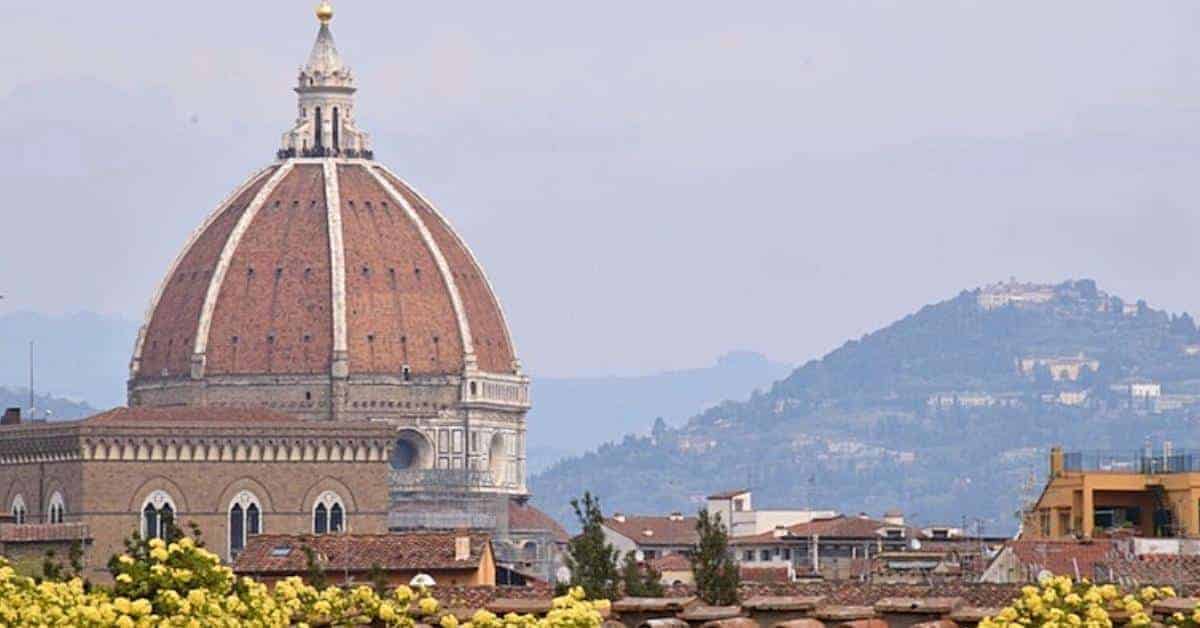
BEST OF Italy in 2 Weeks Itinerary (2023)
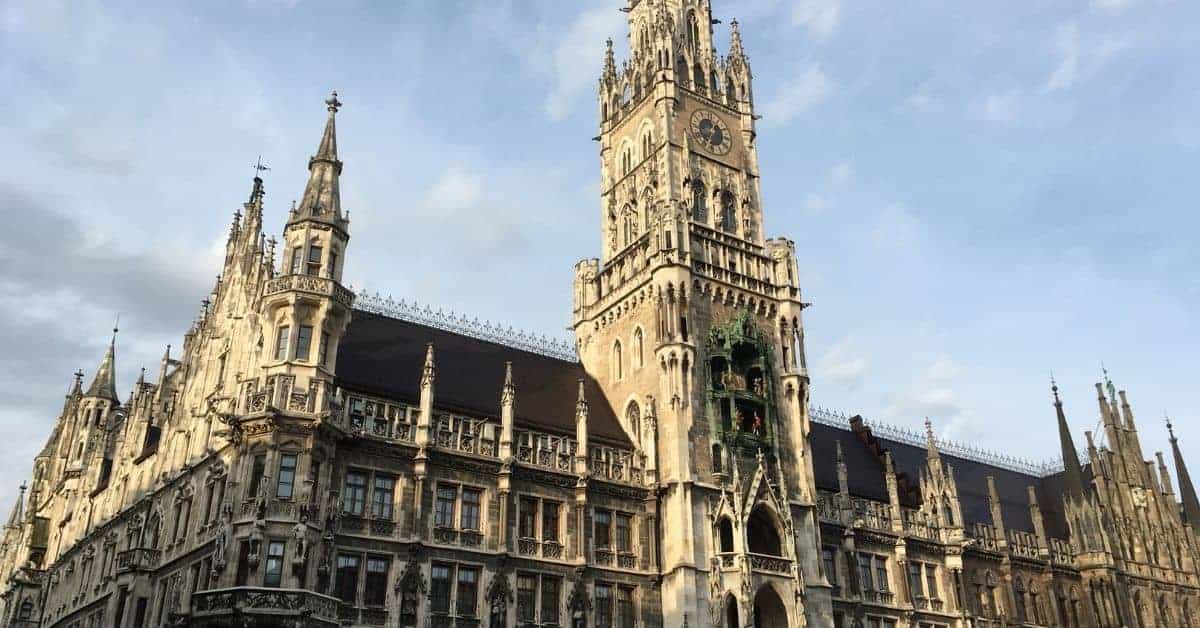
4 Days in Munich Solo Travel Itinerary & Guide (2023)
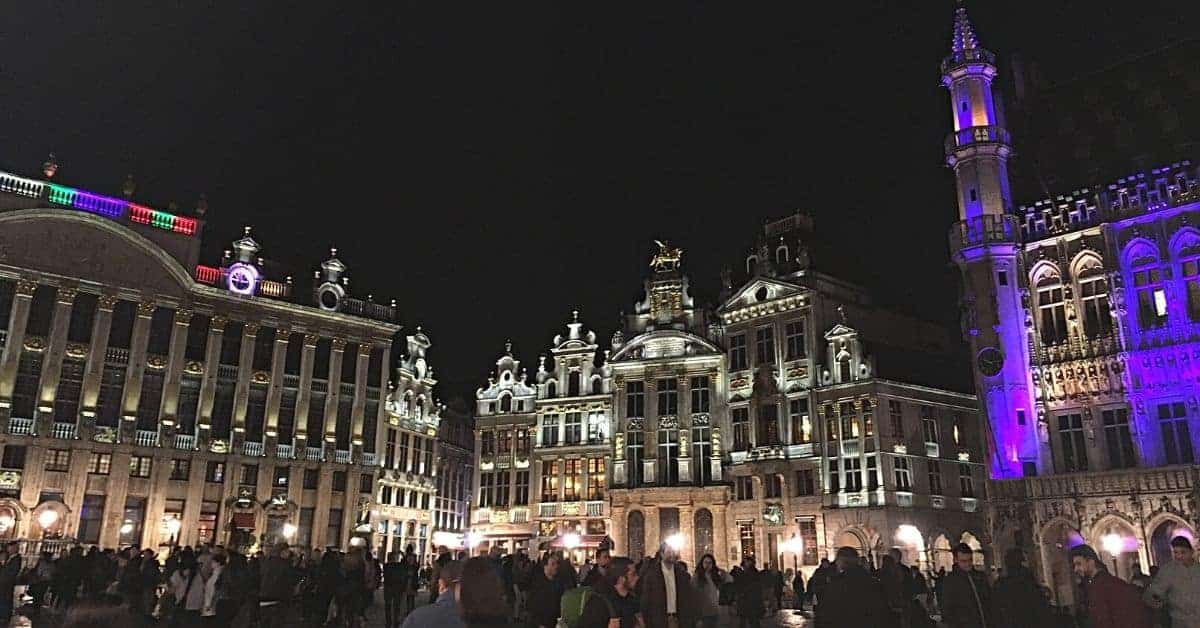
Spend 3 Days in Brussels Itinerary & Guide 2023
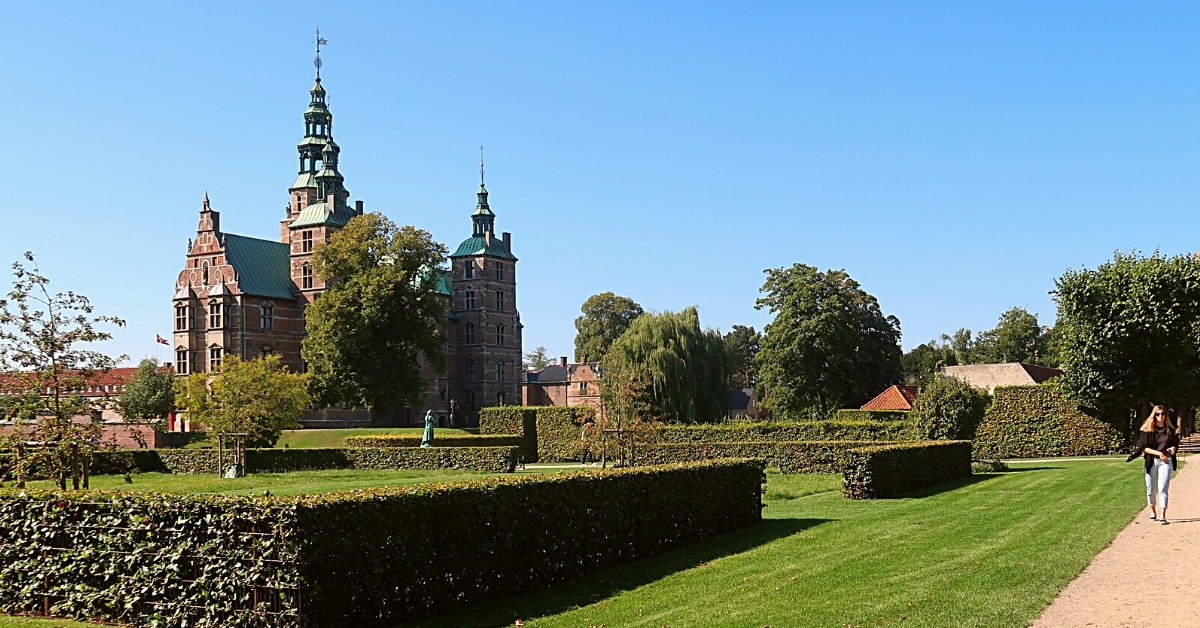
Best 3 Days in Copenhagen Itinerary 2024
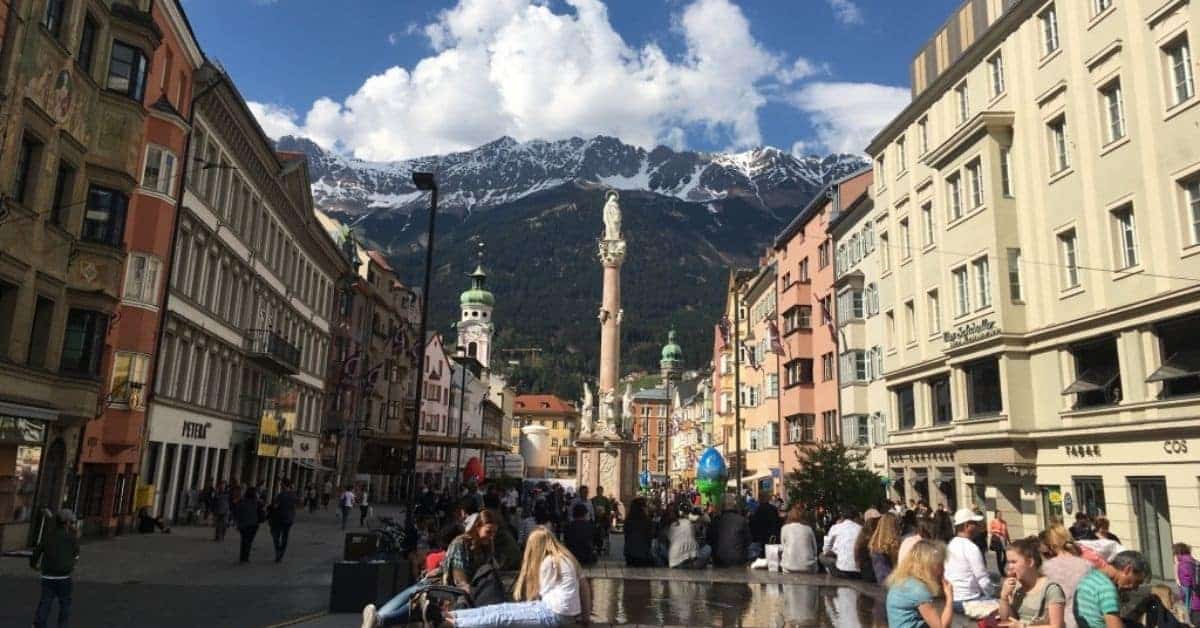
Best 1 Day in Innsbruck Itinerary and Guide 2024

10 TOP Things to Do in Barcelona First Time
10 MUST Things to Do on Barcelona First Time Travel Welcome to Barcelona, a city…
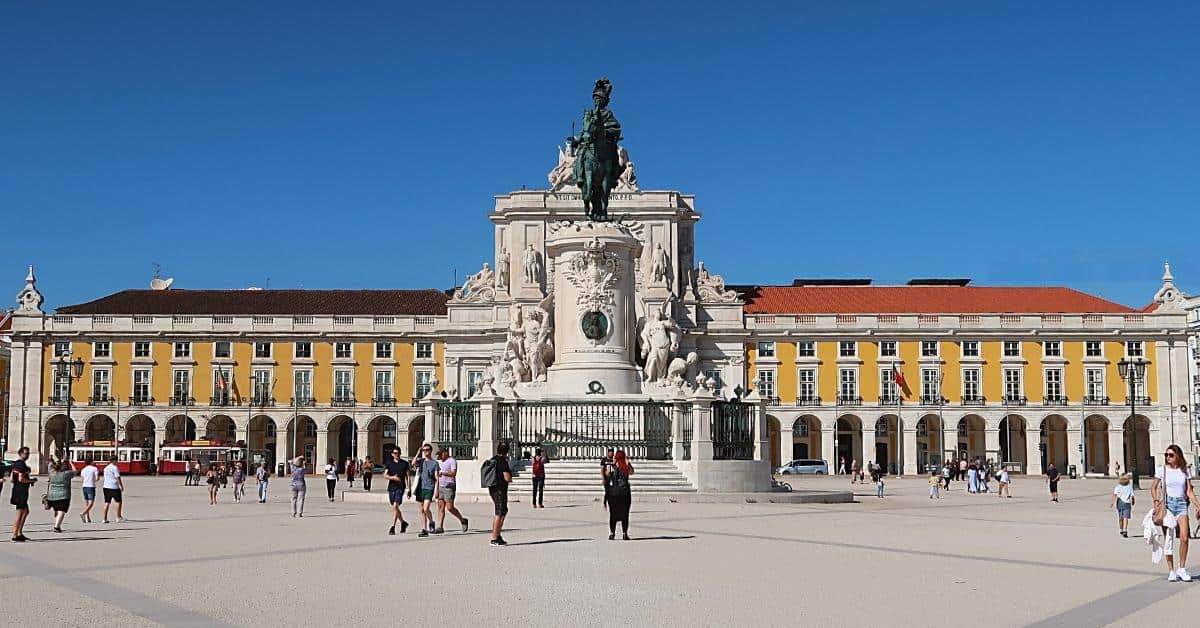
The Ultimate Lisbon Solo Travel Guide 2024
Leave a comment cancel reply.
Your email address will not be published. Required fields are marked *
Save my name, email, and website in this browser for the next time I comment.
Insiders Travel Guide to Split, Croatia
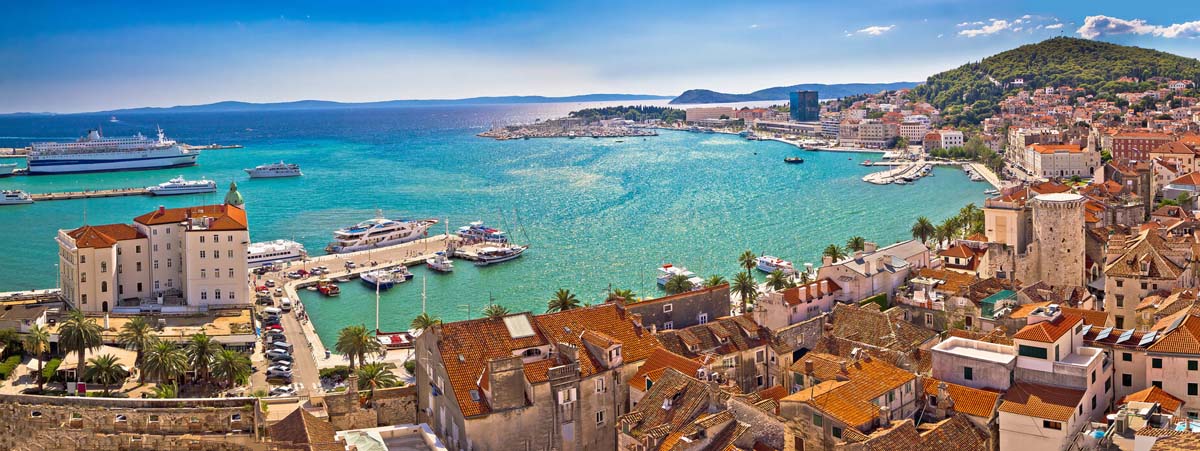
Planning a trip to Croatia and looking for insiders travel tips for Split?
In this article we'll share simple yet important local insiders tips for visiting Split for the first time. From how to arrive to where to go and when to go, to what to see and when to see, to where to eat and where to sleep, to how long to stay and where to go on a trip while visiting Split. Who can better explain and address this topic rather than a local who has been living here for the last 35 years and working in the travel industry for the last 10 years. We'll share all our insider tips on how to get the most out of your trip to Split.
Split has become an European high-season must. It's no wonder Split is getting huge recognition among travel lovers and travel enthusiasts around the globe. For us locals, the expression : 'Split is the most beautiful city in the world', is widely familiar. We truly believe so.
Split has an interesting and storyful 1700 years old history, it inherited the impressive and inspirational Roman palace, built by the emperor Diocletian; Diocletian 's palace, the most most famous part of the city that gained worldwide fame after filming of the Game of Thrones serial took place between the walls and inside the basements of the Palace. The Diocletian palace and the big part of the Old town are protected by Unesco as an important World Heritage site. Old town is packed with interesting architecture, museums, ancient palaces, beautiful squares, charming pebble-stoned streets, artisan shops, boutiques and galleries.
With sunny and mild weather, many beaches, beautiful nature and perfect position between 2 mountains, in a close proximity of many islands, with frequent ferry connections, close to the main airport, it is a very attractive tourist destination and also a great base point to explore the entire Dalmatia.
Arrival and important information for easier get around
How to get to split from the split airport.
If you landed at Split Airport and are looking for transportation to the City of Split, you can take the Airport Shuttle bus or Private transfer or Uber to Split.
The bus trip takes around 30 minutes. One-way ticket costs 30 Kuna and a daily ticket costs 40 Kuna. Tickets can be purchased on the bus.
Transfer to the apartment in Split costs 150,00 HRK for 2 people.
The Airport shuttle bus will take you to Split main bus station in 30 minutes. Just head all the way to the end of the journey and get out on the last stop. Split main bus station is located in the ferry port, in a short walking distance from the Diocletian palace and the Old town.
How to get to your accommodation from the main bus station and the ferry port ?
If you are staying inside the Old town, like most of the visitors, you can take an easy 10 to 15 minutes walk to get there. You also have the option to use the local taxi service at the site, Uber or Bolt, but please mind the big part of the Old Town is a no driving area so there is a chance you'll still have to walk for a few hundreds of meters.
If you are carrying a lot of luggage but prefer to walk to the apartment the easiest option would be to use the non expensive luggage trolley service guy who can take the luggage directly to your Old town accommodation.
If you are staying outside of the Old town, you can take a taxi to the apartment. Split is not a huge city, so this service will cost from 15,00 to 40,00 HRK.
Where to park your car if you are staying in the Old Town of Split:
If you are arriving with the car and staying inside the Unesco protected area, please note you will have to park your car and walk from 200 to 500 m to your accommodation as the big part of the Old town is a no driving area.
Some hotels offer parking for their guests, but ones still outside of the pedestrian zones.
To get the information about the availability of the parking spots on the parking lots of the City of Split, you can use the existing Split Parking app https://play.google.com/store/apps/details?id=profico.splitparking&hl=en&gl=US
Where to park your car if you are staying inside the Diocletian’s palace
If you are staying inside the Diocletian's palace, the closest parking lot (7 HRK per hour) is 300 meters from the apartment, right at the border of the UNESCO area. Here is a link to Google maps for the parking lot: https://goo.gl/maps/MeDkcFXHBksXieB4A
You can also park your car in the streets near the UNESCO border (Tolstojeva street, Drziceva street, Kneza Viseslava street). Some parts of these streets are free to park, but for other parts you need to pay 4 HRK per hour, with free nights and weekends.Parking in Glagoljaska street and Kneza Mislava streets is free of charge. These are narrow streets, so not attended for inexperienced drivers.
There is also a parking lot at the ferry port, with higher price, 10 HRK per hour. https://goo.gl/maps/vyG1voKRGr3XcDR36
The most expensive central parking lot is located in front of St. Francis cathedral, at the beginning of the Promenade, with a price of 20,00 HRK per hour. https://goo.gl/maps/vyG1voKRGr3XcDR36
If you are staying nearby Marmontova street or the National Theatre, you can use these 2 central parking lots ( 7,00 HRK per hour ):
https://goo.gl/maps/pUUjZZ4m6Pn9QKPdA
https://goo.gl/maps/WpATXUbRt8Asu9vA7
Where to park your car if you are staying in Varoš district
If you are staying in Varos district, at the slopes of Marjan hill, you can park your car at the parking lot in Plinarska street ( 7,00 HRK per hour ); https://goo.gl/maps/oPTsjBMuJ7CN9qcY7 , or in the nearby streets for free; Prilaz Vladimira Nazora street, Ljudevita Gaja street or Vatroslava Lisinskog street.
You can also use the parking on the street at the west side of the Promenade, which costs 5,00 HRK per hour, with free nights and weekends.
Where to park your car if you are staying in Radunica district:
If you are staying in Radunica district, you can use the parking lot next to the Police station: https://goo.gl/maps/JxCMa83tUWEYM6dV8
You can also park in narrow nearby streets; Glagoljaska street and Kneza Mislava street for free.
Important information :
Ferry port : https://goo.gl/maps/CwDeHy7ZKxpYma169
Bus and Train station: https://goo.gl/maps/GVzhR4KcEWB797kdA
24/7 pharmacy : https://goo.gl/maps/MEwjZk7CeiSVgKvD8
Split City Hospital and Emergency : https://goo.gl/maps/K8Zy8eebENn15ovh7
Split bus line timetables : https://www.ak-split.hr/
Split ferry line timetables : https://www.jadrolinija.hr/en/ferry-croatia
Split Tourist INFO center : https://goo.gl/maps/47tJi2StHk5GMHpq5
Tourist board of Split official website: https://visitsplit.com/en/1/welcome-to-split
How to get the most out of your time in Split
Some travellers have just a few days in Split and want to see as much as possible in the short period of time before transferring to the other destination of their travel. We'll discuss here what is the best way to explore Split if you are staying here for a short period of time.
Some travellers stay in Split for a week or longer, they choose Split for the base of their travel, rent the affordable accommodation and frequently join a huge number of offered daily trips and adventures. We'll explain what are the best trips you can take if you have a couple of days extra in Split. Read on.
Short time visit of Split
You decided to visit Split for just a couple of days or even less and want to get the most out of your stay? You want to know what places you shouldn't miss while visiting Split for a short period of time?
The simple fact that Split is not a huge city and you can walk almost everywhere is a huge advantage. Especially if you have just a few days in Split.
From walking and cycling around Split's major sights and attractions to taking a hop-on hop-off sightseeing bus, bike tour, segway tour, choose one or combine several of them to make the most of your time in this dalmatian pearl.
If you are travelling without a car, no worries at all, you are at the right place. Split Old town is perfectly located, in a short walking distance from the ferry port, museums, shops, restaurants, main bus station, train station, the beaches and Marjan Nature park, you can walk almost everywhere in just 10 to 20 minutes.
To get the most out of your stay, we suggest renting accommodation inside the city centre. It's the best way to soak up the atmosphere of the ancient Old town in the limited period of time. You will wake up in your own apartment, inside hundreds of years old buildings, or inside a charming boutique hotel, preferably have a vibrant view on the old town squares and streets, and just pop into the colorful and vivid everyday local life. Wander the narrow streets of the Palace, grab a coffee at one of the lively Old Town squares, soak up the sun and feel just like a local.
We definitely recommend taking one of the guided walking tours as you can get the most content and information in the shortest amount of time, learn a lot of interesting facts and stories about the history but also learn to orient yourself in the narrow streets of the old town that feels like a maze for first time visitors. You can choose between a wide offer of daily walking tours, group or private, with or without included entrance fee, depending on your interest, budget and the time frame.
Here are a few hotspots you shouldn’t miss if you plan to wander the streets of Split this year for just a couple of days :
Diocletian's palace
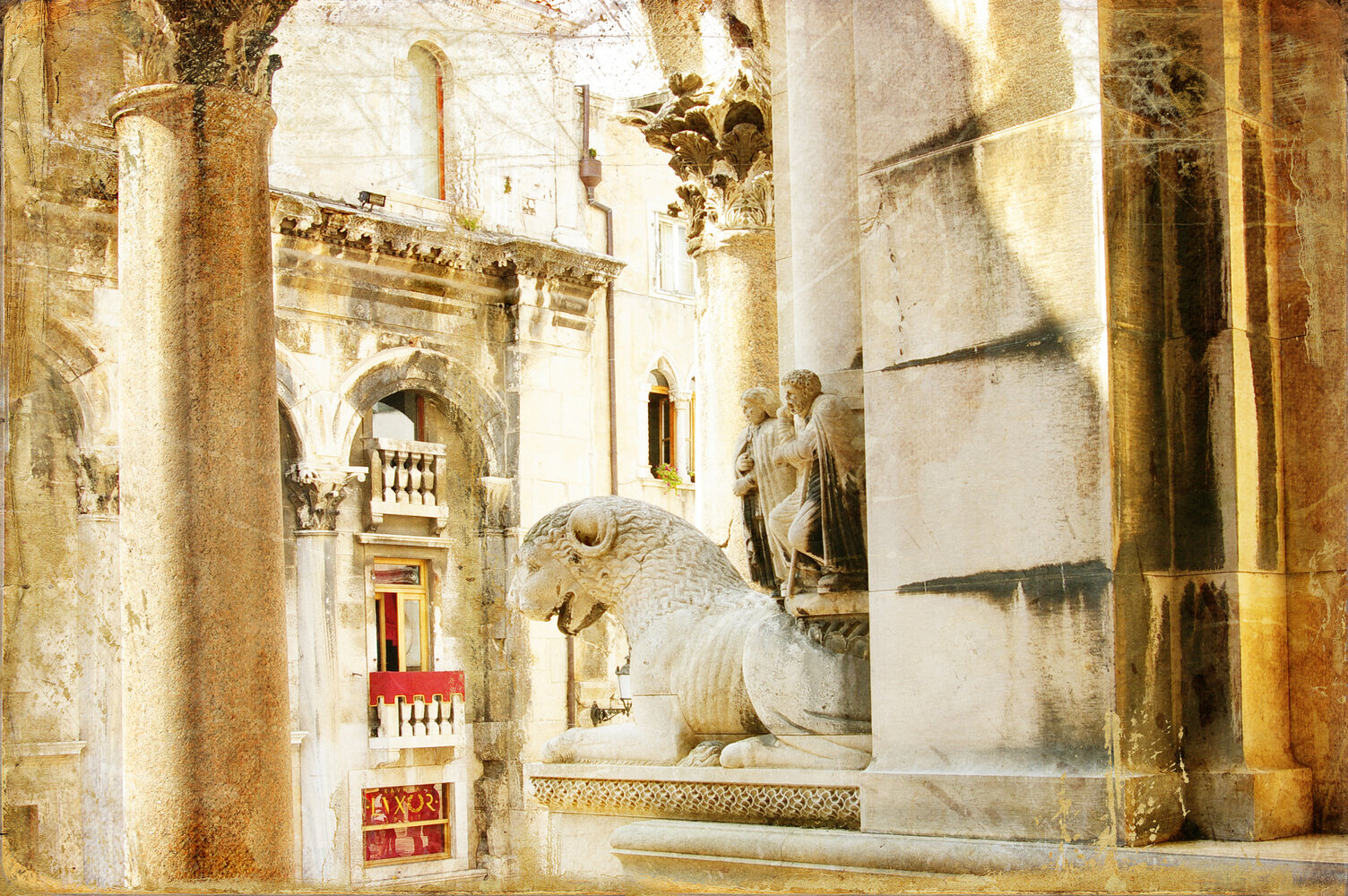
A must see Diocletian's Palace, UNESCO’s World Heritage Site, intended and built for the Roman Emperor Diocletian at the end of the 4th century AD, today is a living monument, one among just few in the world, so what is interesting you can immerse yourself completely in its everyday life. What's also interesting you can get inside and explore most of its parts without paying any entrance fee.
The most important parts of Diocletian palace, not to be missed while wandering around are ancient walls with impressively built entrance gates on 4 sides of the world, known as Golden Gates, Silver Gates, Bronze gates and Iron gates, the substructions of the Palace, known as the Basements, Peristil square with Vestibule and Jupiter's temple.
Learn about Diocletian palace and hear interesting stories and facts from the history during one of the Split Diocletian palace walking tours .
Special hint; don't miss out to walk around the Diocletian's palace and the Old Town during evening, the evening lights make it even more spectacular.
Peristil square
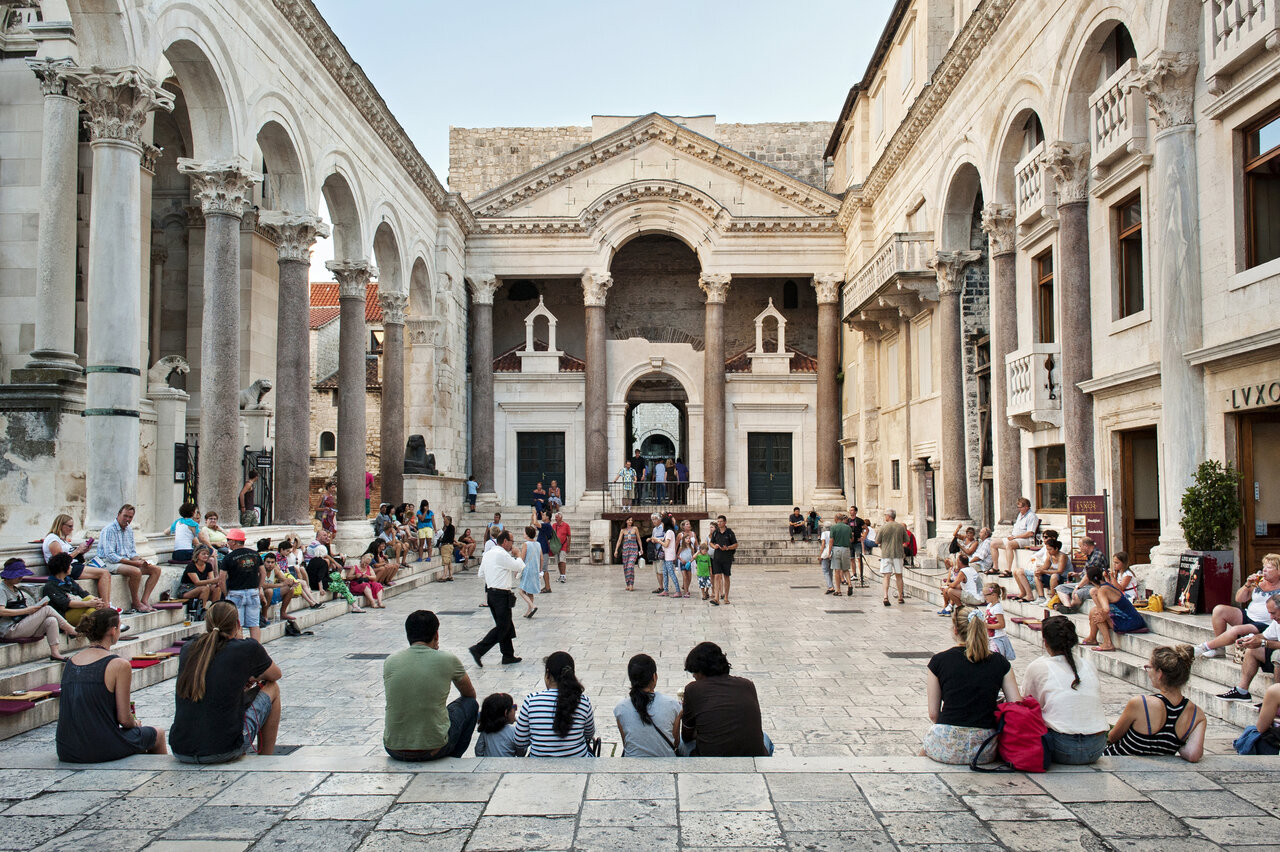
The central square of the Palace, deliberately made to evoke the divine nature of the emperor, who was at that time glorified as the son of Jupiter.
It's red colour granite columns emphasise its ceremonial function. During the past, Split's noble families built their palaces with walls leaning on its authentic columns and arches and with their Renaissance and Gothic architecture they themselves became monuments.
Owing to its unique beauty and unusual acoustics, Peristyle became the ideal theatre scenery but also the stage where abundant urban life continues. Having your coffee on the steps circling Peristyle being closely watched over by a 3500 old and perfectly preserved sphinx is a unique experience. Grab a coffee and cake from a cafe Luxor, named after the Egyptian city of Luxor, where the sphinxes originate from and placed by the Peristyle square inside the glamorous renaissance palace. Visit Peristil in the evening, when you can enjoy its unique atmosfere, live music and performances of the enthusiastic local salsa dancers.
Special hints: During the Day’s of Diocletian , the special annual performance of local actors ( 17.05 – 27.09 every year ), you can experience how the Emperor, his wife and his guard looked and behaved.
At 12.00 every day on the Peristil square you can also witness the shift of the Emperor's guard.
During the end of July Peristil becomes the special stage for the annual festival and manifestation Splitsko Ljeto . If you find yourself in Split during that time and you are a culture and art lover make sure to buy the tickets on time and attend some of the theater plays or ballets. It's a special experience to watch an artistic performance staged at this unique place of history.
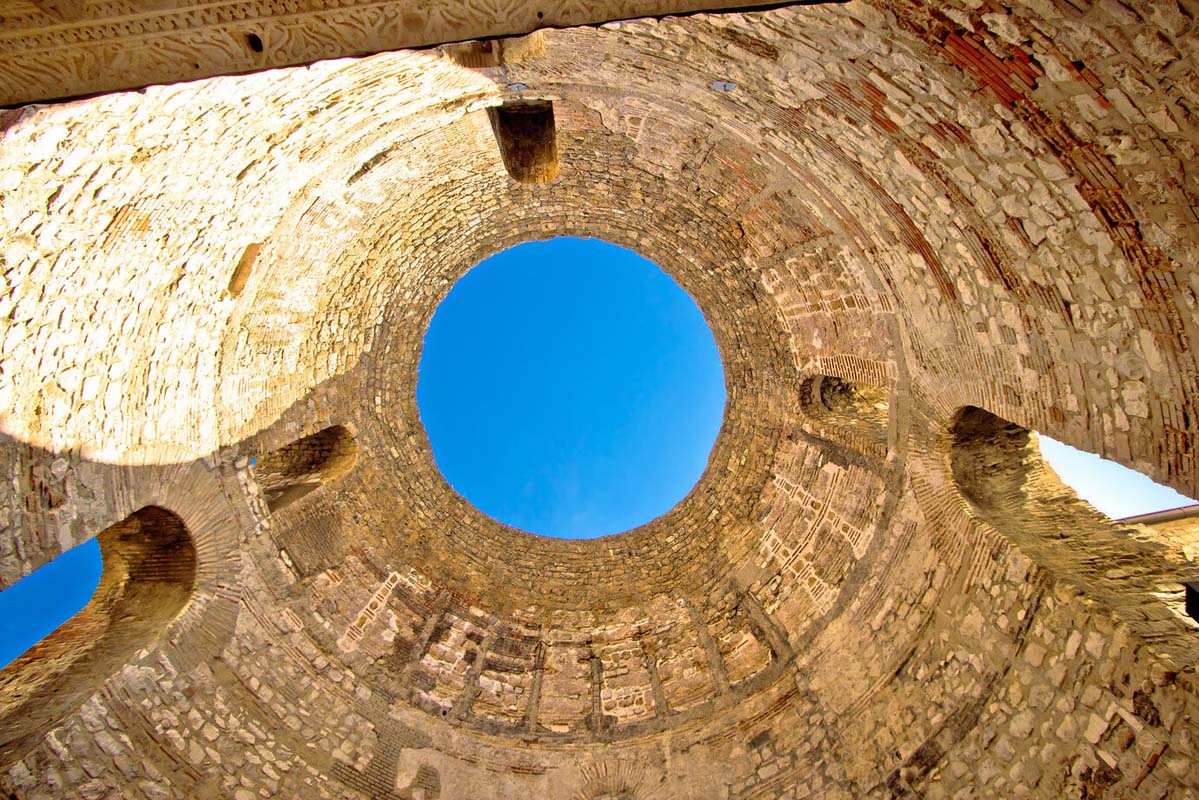
A circular grand meeting hall was once the formal entrance to the imperial apartments. The monumental and impressive hall is topped with a dome, 17 meters in height and 12 meters in diameter which creates one of a kind royal and sacred atmosphere. The entrance was adorned with a large door dimension of 2.56 x 3.96 m with an abundance of relief decorations.
During the summer the space is used by local a cappella groups which perform popular folk songs, taking advantage of the acoustics of this area.
Southeast of the vestibule is the Medieval quarter with buildings dating from the 10th century. On the opposite there is the church of St. Andrija which is now part of the Ethnographic museum.
Hint: the performances of the local singers are free to watch, you can buy their CD if you like it. You can make memorable photos from the inside of the Vestibule building. Sometimes you can even see the moon throughout the dome.
The substructions of the Diocletian's palace
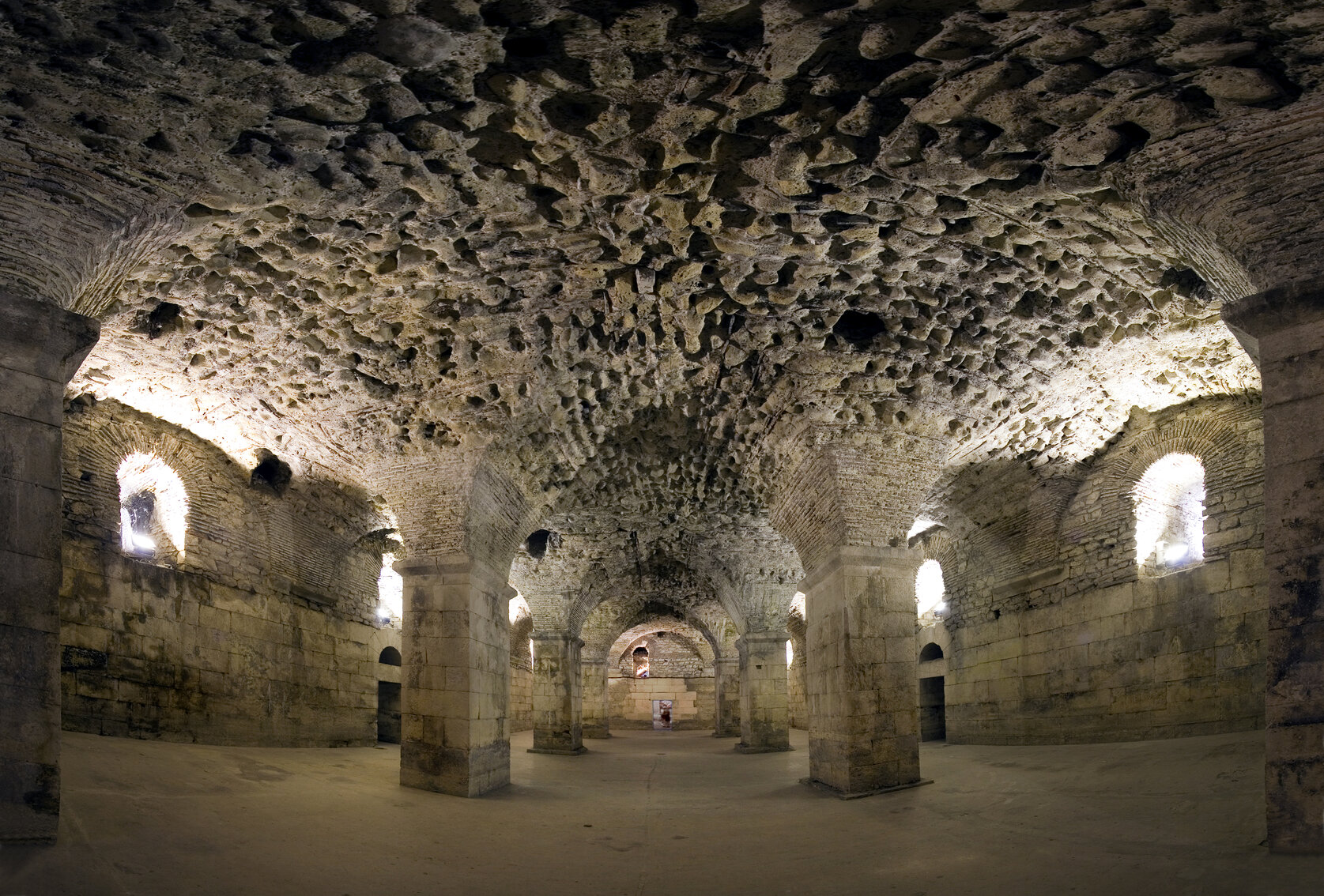
The substructions of the Diocletian's palace represent one of the best preserved ancient complexes of their kind in the world. In the Roman times, their function was to elevate the Emperor's chambers on the floor above, but they were also the storage area for the Palace. You can pass through one small part of the Basements for free to get the idea about it an to buy local souvenirs, but If you want to take a closer look, and if you have few hours extra, we recommend to buy the entrance ticket and explore all of it's monumental hallways and spacious halls.
Special hint for all Game of Thrones lovers: The basements of the Diocletian's palace served as a filming set for Game of Thrones seria. They were the impressive halls where Daenerys kept her dragons locked. There are a few other GOT filming sites around. Join the Split Game of Thrones Tour to explore them all.
Golden Gate

Golden Gate, the biggest and grandest of all 4 city gates originally was the main gate from which the emperor entered the complex the first time he arrived in his new home, and everytime he was on the way to the palace from the nearby settlement Salona, once the capital city of the Roman Province Dalmatia. At that time these doors could only be used by the emperor and the members of his family. Impressively built doors are topped and decorated with a rasteret arch of 19 stone blocks with a height of 3.02 m.
The facade was decorated with niches containing figure sculptures of the four tetrarchs (Diocletian, Maximian, Galerius and Constantius Chlorus)
Hint: Look for the carved heads high up on the outside wall.
The entire north wall of the Diocletian's palace and the area around the Golden Gates are a story for itself. Together with St. Martin's church from the 6th century, the oldest church in the city built within the small place inside the wall, nearby church and the chapel of St. Arnir from the 10th century, the monumental Gregory of Nin statue and beautiful park with a fountain in this area today forms one of the favourite tourist spots.
Hint: Take a photo with the local actors dressed like the Roman soldiers.
The Cathedral of St. Domnius
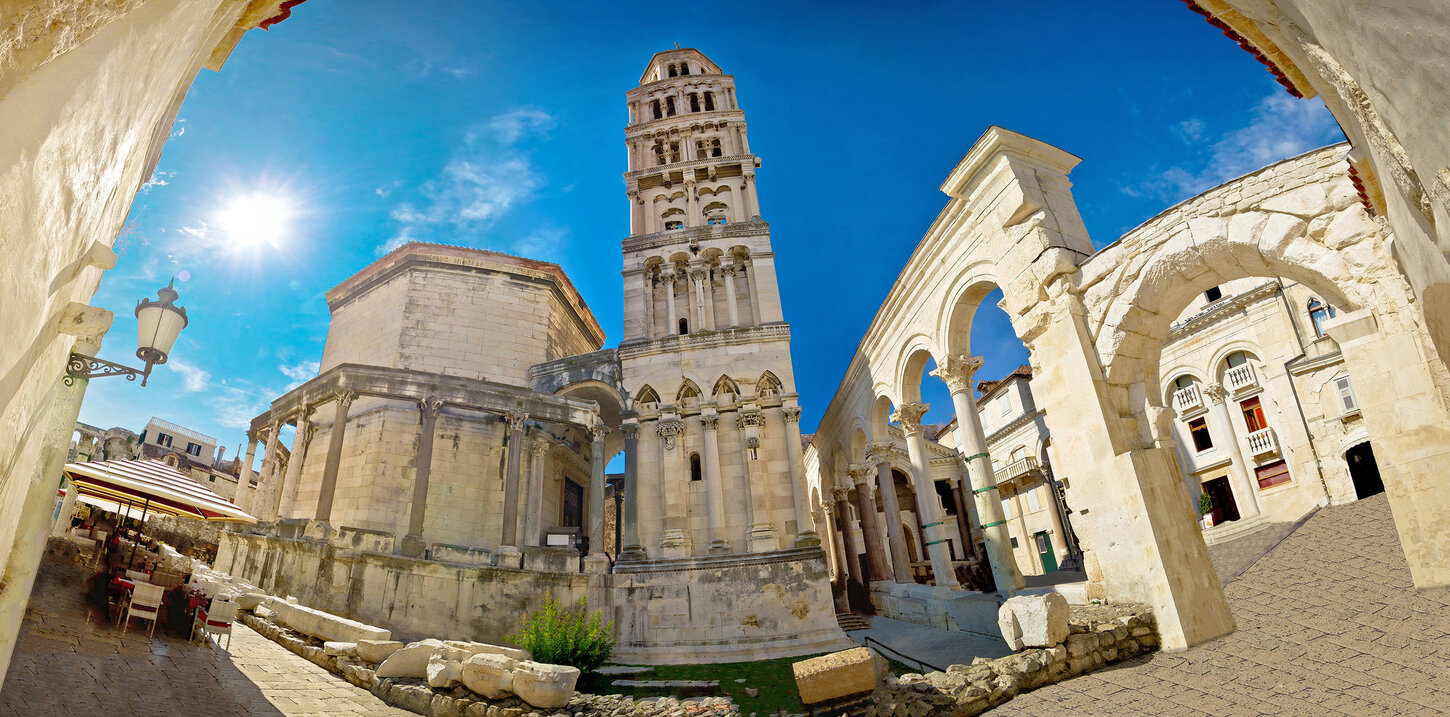
A complex of a church with a bell tower, formed from an Imperial Roman mausoleum. The church is dedicated to the Virgin Mary, and the bell tower to Saint Domnius. The Cathedral of Saint Domnius from 7th century AD is regarded as the oldest Catholic cathedral in the world that remains in use in its original structure. The structure itself, the Mausoleum of Diocletian, built in AD 305 is the second oldest structure used by any Christian. The impressive bell tower offers superb views on the Old town and the sea. Climbing the narrow stairs is demanding but definitely worth it.
To visit and explore the entire complex of the Cathedral of St.Domnius including the bell tower you have to pay the entrance fee.
Hint: It will not take a lot of time to climb up to the top of the tower and the view from here is one of the kind. Don't miss it!
Grgur Ninski
8,5 meters tall statue placed just outside the Golden Gate is one of 3 statues of a Croatian medieval bishop of Nin made by the respectable Croatian sculptor and artist Ivan Mestrovic. Bishop Gregory of Nin was highly important for Croatian history as he first introduced the Croatian language in the religious services. Rubbing the statue's toe is said to bring good luck.
Hint : Don't forget to make a wish while rubbing it's golden lucky toe.
Pjaca or People's Square
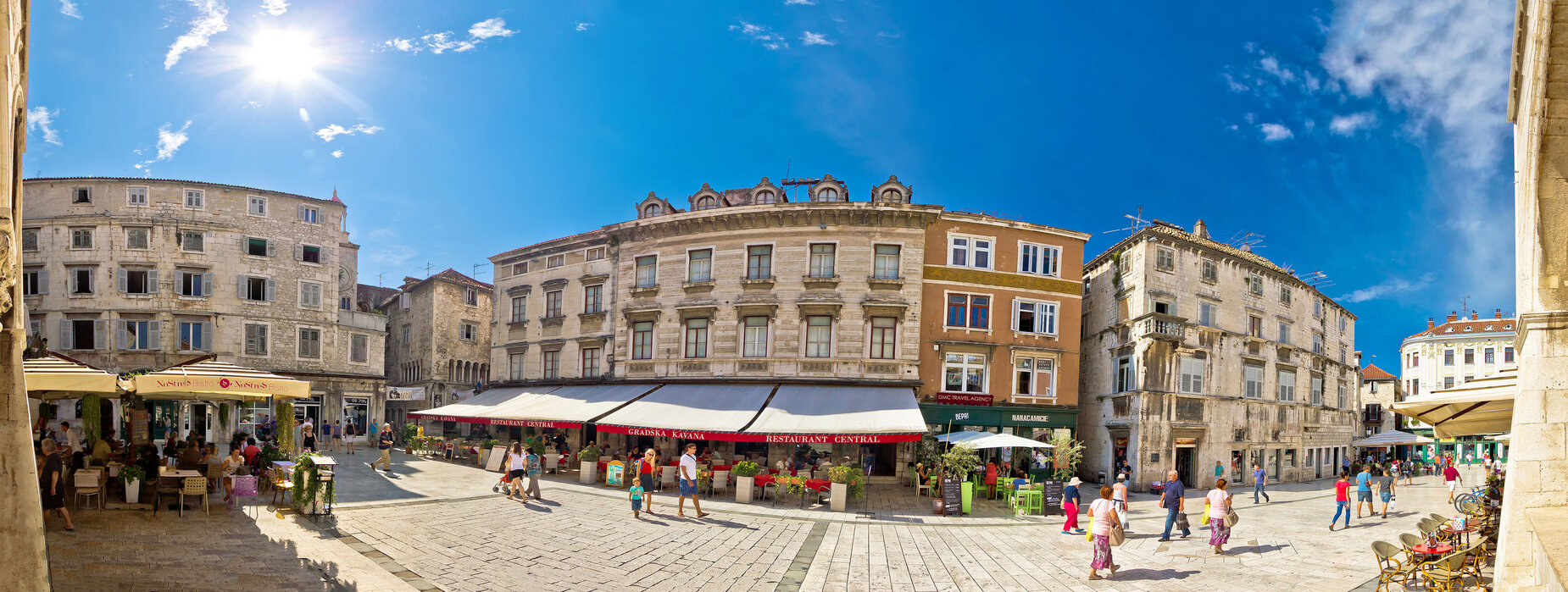
Pjaca or People's Square is one of the most beautiful squares in the city. It was the first inhabited part of Split outside the Diocletian Palace, leaning on it's western wall. For centuries it was and still is the central stage of city life. There you can see the beautiful Gothic building of the Old Town Hall, today an exhibition centre, classic and preserved Palaces of the noble Split's families, the oldest bookshop in the world; Morpurgo, and the old Cafe Central inside the former hotel Troccoli where the tourism of Split started.
There is also the old city clock that has been ticking there for centuries, plenty of cafes, restaurants and bars, where you can find the place to relax, enjoy and witness the history and the spirit of the city.
Special hint: Diocletian's palace and Pjaca square are full of restaurants and cafes. For budget travellers it might be important to know that the drinks are not more expensive compared to the other areas, but the food is slightly overpriced at most of the places.
Vocni trg ( Fruit's square )
Vocni trg ( Fruit's square ) officially is known as the Square of Brace Radic, but it is much more familiar under its unofficial name. It was once a place where women from the surrounding villages came to sell their fruit, and that is how it got its familiar name.
There are several landmarks decorating this beautiful square. The octagonal Venetian tower, the leftover of the former fortress, built in the 15th century, catches the eye first.
Opposite of the tower is a magnificent Palace of the old family Milesi from the 17th century with a spectacular Baroque facade. Just in the middle of the square is the statue dedicated to the father of the Croatian literature, the citizen of Split, Marko Marulić, made by Ivan Meštrović.
Fruit square was also the central location for the filming of one of the most popular Croatian TV series', saga's of Split "Velo Misto".
Prokurative

Officially called the Republic Square was unofficially named after the arches on the neo-Renaissance buildings surrounding the square on three sides. It is located west of Riva and open only on the south side, providing a beautiful view of the waterfront, St. Francis cathedral and a bell tower and the main city fountain. The colonnades on the square resemble Venetian style and reliefs above the windows evoke the Renaissance influences.
Prokurative square was initiated by one of the most renowned mayors in the history of the city Antonio Bajamonti in the mid 19th century.
The square has been established as an excellent stage for cultural events, especially the annual pop music festival.
Hint: Grab a coffee and cake or a breakfast in a famous cafe Bajamonti, placed at the top of the square, with great views and charming classic atmosphere and interior.
Vidilica Marjan park

If you are staying in Split for just a short amount of time, you won't have time to explore Marjan park entirely, but you can take a quick walk to the first view point on Marjan hill, the closest one to the Old Town to enjoy panoramic views on the city and the port and take few photos to remember. Walk up the Senjska street in Varos district, or take the stairs to Vidilica View point behind Matejuska port and you can reach the viewpoint in 15 minutes.
Here is the interactive map of Marjan for you to use.

The sunniest promenade in Europe, Riva, everyone's favorite place in the city.Placed under the Southern wall of the Diocletian's palace, overlooking the facades of beautiful buildings and palaces and islands Brac and Solta in the distance. It's full of restaurants, bars, clubs, of which some of them have impressive ancient interior design.
The mediterarranean atmosphere is enhanced with numerous palms and mediteranean herbs.
Riva spreads all the way to the west end of the natural bay. Take a relaxing walk to the west end of Riva and enjoy spectacular views of the Old Town and Marina all along the way.
Bacvice beach
Natural sandy beach, located only 15 minutes walk away from the Old town is the closest city beach, but also the most popular one. The beach is full of content, there are bars, restaurants, playground, renting facilities, storage locker, plenty of space.
Due to the cleanliness of the sea and the beach it deservedly has a blue flag.
Longer stays in Split
This is the best way to visit Split and Dalmatia especially for budget travelers. This way you can use the common week discounts for the accommodation and get the discount for the excursion packages.
Also, because of the close proximity of the beautiful islands, national parks, charming towns and historical landmarks, you can experience almost the entire central Dalmatia in one week, all within the limited budget.
You can stay flexible whether you want to stay in the city centre or outside the city centre to avoid crowds, parking issues and noise. If you are looking for a peaceful area, suitable for the long stays in Split, outside of the city centre, but still attractive, we are suggesting to check out the accommodation around Marjan park, in Meje district and Varos district.
You will have time to explore all major touristic locations in Split, and include even more.
Take one whole day to explore Marjan Nature park, it’s beaches, viewpoints, churches and trails, either on foot, with a bike, or as you prefer. You can also take a bus to Bene, nice beach with restaurant and tennis playgrounds, in the middle of Marjan hill, and explore further from there.
Stop at the impressive Mestrovic Gallery, a gallery of the artist who in many ways indebted Split, and especially with his unique artistic legacy.
Make a plan how to use your time best.
We recommend to leave at least 2 or 3 days to enjoy and explore Split, and rest of your time you can use for daily trips to the islands, national parks and other historical cities nearby.
Best day trips from Split
The most popular day trips from Split are :
- Blue Cave and Hvar 5 islands tour
- NP Krka waterfalls
- Hvar and Pakleni islands
- Plitvice lakes
You can visit these locations on your own, with your own car or with a ferry, but since the offer of daily tours in Split is so big, and there are a lot of tour operators, prices of daily tours are really affordable, quality and the service is high, we can surely say it would be easier and cheaper to go there organizedly.
Or choose a private day trip , tailored just for you.
Daily trips to the islands from Split
It is easy to visit and explore many islands from Split. With organised boat trips from Split you can visit Vis, Bisevo, Hvar, Pakleni islands, Brac, Solta and Drvenik island in one day.
You can choose for some of the most popular island day tours :
- Blue Lagoon and Trogir day trip
- Golden Horn and the island of Brac
Or choose a private boat trip, tailored just for you.
How to visit the islands from Split on your own
Since Split has great ferry connections with the islands, you can do daily visit to some of them on your own,
The closest island is Brac island. Ferry connections to Brac island are frequent, you can go there early in the morning and come back late in the night. The ferry takes you to Supetar town in 45 minutes. Once you get there, you can enjoy the picturesque island life, enjoy the beach, or you can continue to explore the island further. We suggest taking a taxi to Bol, where you can see the popular and unique Golden horn beach.
It is also easy to go to the island of Solta on your own with a ferry. a 45 minutes long ride will take you to Rogac town. You can enjoy the sparkling clean sea, great and fresh local food, or explore the island further with a taxi or bikes. Maslinica town is an interesting place to check out on Solta island.
Hvar island and Vis island are further away, and the ferry ride to get there will take more time, it is still possible to visit the island and come back in the same day, but take into consideration you will stay longer on the ferry and shorter on the island. Catamaran can take you there faster, but they are not so frequent, they can get really busy and have much higher prices.
Check the ferries and catamaran timetable s.
Historical cities and landmarks nearby Split
You can visit other beautiful cities as a one day trip from Split.
We recommend to visit:
- Salona ruins and Klis fortress
- Trogir Old town
- Town of Omis
- Town of Sibenik
- City of Dubrovnik
- Mostar and Herzegovina
If you plan to visit Dubrovnik from Split, make sure to bring your passports and Visas on your day tour, as we have to cross the border with Bosnia and Herzegovina to get there.
Best Day Nature trips from Split :
Escape the city bust and enjoy the beautiful nature trips from Split.
Most popular are :
- Biokovo Skywalk Nature Park
- Vis Island Unesco Geopark boat trip
- Diving trip from Split
- National Park Krka day trip
- Plitvice Lakes day trip
- Hiking and safari day trip
Best Day Adventures from Split:
If you are into active holiday you came to the right place.
There is so much to choose from :
- Rafting on Cetina River
- Zip Line on Cetina Canyon
- Jet ski safari
- Split Skydiving
- Extreme Canyoning on Cetina river
- Split Rock climbing
- Split Kayaking and snorkeling
Visit the best museums in Split :
There are many museums in Split worth visiting if you are a fan of art, history, archeology or even Game of thrones fan.
Some of the best museums in Split are :
- Galerija Mestrovic
- Split Gallery of Fine arts
- Galerija Emanuel Vidovic
- Game of Thrones museum
- Diocletian’s dream virtual experience
- Croatian Maritime Museum
- Split Ethnographic museum
- Archeological museum Split
- City Museum of Split
Hint : During the Night of the museums , a special annual manifestation, guests can explore all the museums and galleries in Split for free.
Visit the best beaches in Split

Split has many beautiful beaches for you to dive into the sparkling clean waters and relax in the shade or the tamarix or pine tree or soak up the hot mediterranean sun.
There are sandy beaches, pebble stone beaches, rocky beaches and even a nudist beach.
During the peak season beaches are packed with visitors. During these days the best time to visit is the early morning or late afternoon.
Some of the most popular beaches are:
- Bacvice sandy Beach
- Kasuni beach
- Obojena beach
- Znjan beach
- Firule sandy beach
- Jadran beach
- Prve vode beach
If you want to explore the entire Marjan park forest surrounded with a lot of beaches, including 3 from this list, and enjoy swimming, swimming, snorkeling and kayaking, we suggest trying Kayaking and snorkeling tour around Marjan hill.
Where to eat in Split

Split has a huge offer of restaurants, taverns, bars and pubs. There are fancy restaurants, traditional taverns, restaurants with modern twists, vegetarian restaurants, superfood bars, vegan restaurants, wine and cheese bars, burger bars, pizzeria’s, sushi bars and many more.
Split is a perfect destination for every enthusiastic food lover, eager to taste the wide offer of fresh, local and healthy mediteranean food and quality local wines.
Some of the best restaurants in Split are :
- Konoba Matejuska
- Bota sushi bar
- Ciri biri bela restaurant
- Portofino restaurant
- Kat’s kitchen
- Pandora green box
- Dvor restaurant
- Sug restaurant
- Monika Wine bar
- Brutal Bar and Kitchen
If you want to try the best choice of meals, taste the most quality wines and like to talk about the food and learn about the history of Split, we suggest checking the Gastro and history tours.
Jetsetting Fools
Travel Far. Discover More. Spend Less.
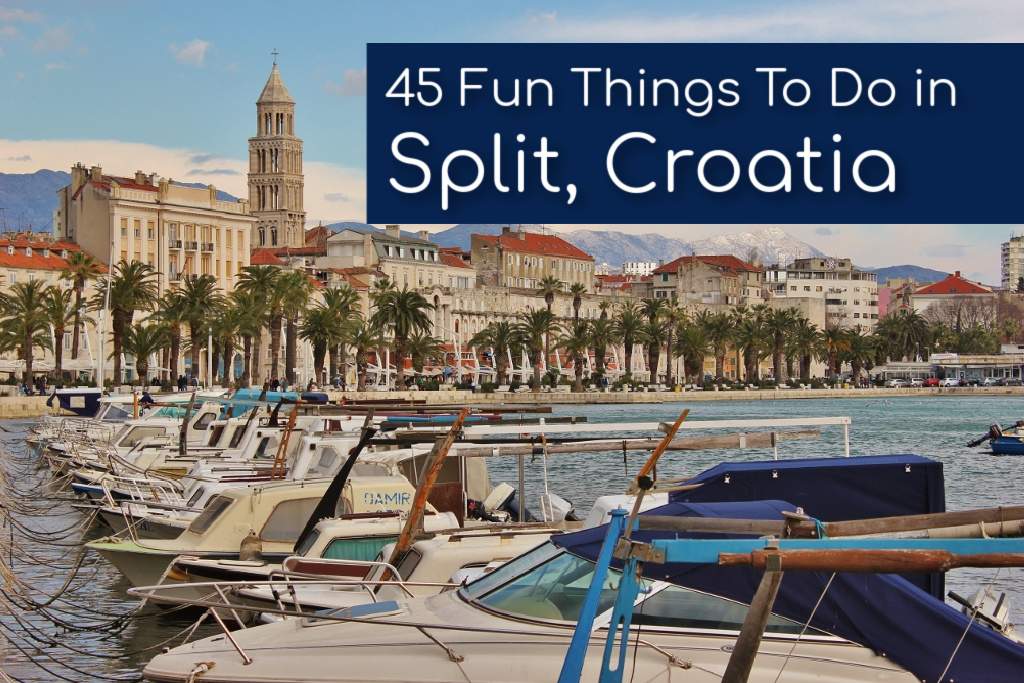
41 Fun Things To Do in Split, Croatia
Welcome to JetSetting Fools, here you will find our best travel tips for destinations worldwide. Some of the links on this site are Affiliate Links and if you use them to make a purchase, we may earn a commission. For more information, read our Disclosure Policy .
Rich in history and surrounded by stunning mountains and turquoise water, there are an astounding number of Fun Things To Do in Split!
In fact, Split is one of the Top Croatia Destinations – and one of our favorite places to go sightseeing in the world. On multiple trips over the past decade we’ve spent nearly a year in this city. So we truly know the absolute Best Things To Do in Split, Croatia!
Top Things To Do in Split, Croatia
The premier attraction is Diocletian’s Palace – and it should certainly be on every Split sightseeing list. It has defined the city, even as the palace itself has been reshaped in its 1700-year history. That said, there are many more sights to see in Split, Croatia!
Vibrant markets, lively squares, and the pedestrian-only waterfront Riva are all Split must-see places. The best viewpoints, top beaches, stunning nature trails and quaint neighborhoods are also just a short walk from the city center of Split.
Our List of the Best Split, Croatia Things To Do

On our first trip to Split, we used the city as a transfer point – simply breezing through before island-hopping to other exciting destinations in Croatia. With just a few hours, we were not necessarily looking for things to do in Split…and we ended up missing just about everything.
That trip was in 2011 – and we immediately regretted not doing more sightseeing in Split. With just a little planning, we could have easily experienced some of the top Split things to do.
However, we have revisited the Dalmatian capital multiple times (and for much longer stays) and corrected our missteps. Not being rushed and having an organized plan, we have discovered a plethora of sights to see in Split, Croatia!
Planning Your Trip to Split, Croatia
Whether you are wondering what to see Split in one day or are planning 2 Weeks in Croatia , you can use our Split Sightseeing Guide. We also share our picks for the Best Beaches in Split as well as the Top Split Restaurants .
To help you with your day-by-day adventures, we created a 3-Day Split Itinerary that features the all the must-see sights as well as a 7 Day Croatia Itinerary to capture more of the country. Travelers can also find invaluable tips in our Guide to a Great Croatia Vacation .
We know it is not always easy Planning a Trip to Europe – and organization is key. Use our Printable Travel Planner to keep track of all the details for your perfect trip to Croatia!

We are covering the full range of the absolute best things to do in Split, Croatia. In addition to our top tips on the best Split activities, we also offer advice for day trips, where to stay and how to get there. Whether you are a first-time visitor to Croatia or a repeat traveler, our list of sights to see in Split is for you!
Save, Pin or Bookmark our Split Travel Guide to plan your trip to Croatia!
#1 Embark on our Self Guided Walking Tour

For anyone wondering what to do in Split, Croatia, it’s a fabulous place to start. The attractions are arranged in order – with walking directions and maps – so that you can easily go from one sight to the next. We also include an interactive map to make your Split sightseeing simple.
#2 Discover Diocletian’s Palace

The UNESCO World Heritage Diocletian’s Palace is the top sight to see in Split, Croatia. Built for the Roman Emperor Diocletian in 305 AD, it stands today as one of the best-preserved palaces of its time.
Although not totally restored, remains from the 4th century structure are completely fascinating. With just a bit of imagination, it is easy to visualize what Diocletian’s Palace looked like in all its splendor.
Must-See Sights in Diocletian’s Palace

To better understand the history, visitors can use our Guide to Diocletian’s Palace for another free walking tour. There are a few ticketed sights within Diocletian’s Palace that you might want to visit – and we are outlining the one’s we recommend.
Saint Dominus Cathedral, Treasury and Bell Tower
The Cathedral of St Dominus is housed in the mausoleum that Diocletian built for himself. The building was converted to a church in 641 AD and is considered the oldest Catholic cathedral in its original structure. Visitors can also see the church treasury and climb to the top of the bell tower for amazing views. Tickets can be purchased for the cathedral in the peristyle.
Jupiter Temple and Baptistery
The Temple of Jupiter is another Diocletian Palace highlight. It was converted to a church in the 6th century and houses a baptistery. Tickets are available in the peristyle and can be combined with cathedral tickets.
Palace Basement
The basement is a fascinating place to visit – as it is how archaeologists pieced together the history of the palace. Tickets are available at the door.
Ethnographic Museum
The small Ethnographic Museum offers interesting displays on Split and the region. However, the highlight of a visit is climbing to the top of the Vestibule. Tickets to the Split Ethnographic Museum can be purchased at the door. A separate Top of Vestibule Only ticket can be purchased just outside.
#3 Explore the Split Old Town

Split’s Old Town encompasses the adjoining labyrinth of streets and squares that were built outside the palace walls. Exiting through the western Iron Gate of Diocletian’s Palace leads into People’s Square, the center of historic Split. One of our favorite Split activities is winding through the maze of lanes and narrow alleyways.
#4 Walk the Split Riva

The Split Riva is the long and wide pedestrian walkway that faces the sea and is lined with outdoor cafes. When the sun is shining, both locals and tourists flock to the waterfront promenade.
The Riva is the perfect place to take a break from sightseeing in Split. Linger over a coffee, local wine or beer while people watching. It is simply one of the best things to do in Split, Croatia!
For those not wanting to sip on coffee at a café, there are a plethora of benches for sitting, relaxing, chatting with friends or just enjoying the view of the Split Marina and Harbor.
#5 Soak Up the Sun at Split, Croatia Beaches

With it’s prime location on the Adriatic Sea, the Best Split Beaches are within walking distance from the Old Town. Spending time on the shoreline is – without a doubt – one of the prime things to do in Split.
To the east of the city center is Bacvice, the most popular Split beach. The shallow bay has a small sandy section where you can ease into the cool sea water. Along the edge, there are plenty of places to catch some rays. Further east along the coast are more Split beaches – some with pebbles, some with sand.

West of the Split city center, the coastline provides a more rustic beach experience. Here you can sunbathe on the rocks and slip into the water below to cool off.
#6 Wander through the Varos Neighborhood

The historic Varos Neighborhood of Split dates to the 15th century – although there are churches in the district that are much older.
Varos, which crawls up the slopes of Marjan Hill, was originally the fisherman’s district. Today, it’s an atmospheric place to wander. Stone houses stand close together and narrow streets weave through the area.
Family-run restaurants are found along the lanes closest to the fisherman’s port of Matejuska. Many of the family homes in Varos have been converted to vacation rentals, but locals still reside in the here, too. That makes it feel more like an authentic neighborhood compared to the center of the Split Old Town.
#7 Hike Up Marjan Hill to the Best Split Viewpoint

Whether you are wondering what to do in Split, Croatia for exercise or are just looking for an epic view, Marjan Forest Park is the answer!
Visitors can follow the one of several paths through the Varos neighborhood to start Hiking up Marjan Hill . At the top of the neighborhood is a café and Split city lookout point. The Split viewpoint offers a sweeping vista over the orange-tiled rooftops and turquoise sea.

However, for a fun Split adventure, continue hiking up. Follow the paths into the forested area, seek out the ancient cliffside dwellings, and take in the best Split city and Adriatic Sea views.
Hiking Marjan Hill is always one of our Split highlights! Active travelers can go rock climbing and tourists content to sunbath or swim in the sea can find some great Split beaches around the coastline of Marjan Peninsula.
#8 Rub the Big Toe of the Grgur Ninski Statue

Grgur Ninski – or Gregory of Nin – was a famous Croatian bishop of the 10th century. He fought to have mass spoken in Croatian – rather than Latin. A 28-foot-tall statue of Grgur Ninski stands just outside the Golden Gate (north gate) of Diocletian’s Palace – and it’s a Split must see sight!
Often called The Wizard, the piece was created by local artist Ivan Mestrovic in 1929. When the statue was first unveiled, it stood in the Peristyle. Rubbing Grgur Ninski’s big toe is said to bring good luck. In fact, so many people have rubbed Grgur Ninski’s toe that it now is shiny and bright!
#9 Visit the Ivan Mestrovic Gallery and Estate

Ivan Mestrovic is Croatia’s most famous artist. Visiting the Ivan Mestrovic Museum and Chapel, two of the best cultural attractions in Split, is a top activity for tourist. His works – like the Grgur Ninski Statue – are displayed in cities throughout Croatia. The life-size sculptures emulate human emotions of sorrow, despair and tranquility.
In the 1930s, he built a sprawling estate on the Marjan Peninsula – as well as a chapel along the southern shoreline. While the estate hosts some of his most famous sculptures, the chapel displays his etched wood reliefs of bible stories.
Both properties have been transformed into viewing galleries for his artwork. Additionally, Sunday services are occasionally held at the Mestrovic Crikvine Kastilac chapel.
#10 Peruse the Goods at Split Markets

The Green Market and the Fish Market are two bustling places in Split, Croatia. While both are Split attractions, they are also where locals go shopping for fresh produce and the catch of the day.
Vendors at the Green Market outside the east gate sell produce, flowers, clothing and souvenirs. There are also permanent meat and cheese shops, so it’s nearly a one-stop shopping experience. One of the top things to do in Split, Croatia is to go shopping at the Green Market to assemble items for a picnic meal.
The Fish Market on the west side of the old town is brought to life each morning when the day’s fresh catch arrives. The smell is pungent, the crowd is exuberant and the floor is slippery. Although some might argue with the smelly fish being a tourist attraction, we think it is one of the top Split things to see!
#11 Take in the View from Matejuska
The west end of the Riva is marked by Matejuska. It’s a popular hangout spot for fisherman (both young and old) and lazy, day-drinking crowds of all types. Matejuska is one of the places to visit in Split, Croatia if you want a glimpse of local life. You can also grab a cold drink from Little Beer Shop and find your own sunny spot on the pier!
While drinking a beer at Matejuska is one of the fun things to do in Split, the views are the real reason to go. Looking back at Split from the end of the port, where fishing boats bob on the water, is one of the most beautiful in the whole city. Another great spot for photos is on the tip of the pier, where there’s a super view of Split landmarks with the water in the foreground.
#12 Lounge on the Split West Coast

The wide path along the western Split Harbor waterfront connects Matejuska to the city’s main marina (ACI Split). Along the way to the marina – which is typically occupied by luxury yachts and sleek sailboats – are a few buzzing cafes facing the Split Harbor.
While the cafes are inviting, the best place to lounge along the west coast is on the over-sized wooden loungers. They are ideal for resting your legs and soaking in some sun. Plus, the views across the water are phenomenal – it’s one of the Split, Croatia sights not to miss!
#13 Stroll around Sustipan Park

Sustipan Park is a less-visited Split, Croatia tourist attraction and one of our absolute favorites! Just beyond the marina, the elevated seaside park on the Sustipan Peninsula offers fantastic views under the shade of large trees.
The park was once a cemetery, but destroyed in World War II. What remains today are a small chapel and gazebo – both of which are popular places in Split to get married.
Sustipan Park is a perfect perch for panoramic views over the Adriatic Sea (especially for viewing a spectacular Split sunset). Find a spot to enjoy the scenery (keep an eye out for dolphins) and the fresh sea air!
#14 See the Frogs at Froggyland
Perhaps the most quirky and unusual thing to do in Split, Froggyland is a creative taxidermists dream (yep, it’s that weird). There are more than 20 exhibits of stuffed frogs doing ‘human things.’ Find out more and buy your ticket in advance .
#15 Go to the Top of Golden Gate
Arranged through the Split City Museum, visitors can now ascend to the top of Golden Gate to walk the Medieval military patrol path along the northern wall. The experience offers a unique vantage point of Diocletian’s Palace and the Split Old Town.
#16 Peek in on Wild Peacocks
One of the little-known facts about Split, Croatia is that there is a flock of wild peacocks living in the city. We didn’t believe it at first, but it’s true! Seeking them out is one of the oddly cool things to do in Split.
Vidilica Park – which is just a short walk from the center – is where to go in Split to see the peacocks. Just keep in mind that it is best to give them some space…and please don’t feed them!
#17 Search for Hidden Churches

There are many churches in Split – standing in squares or along quiet lanes. However, there are two that are completely hidden from plain sight. Finding them is one of the unique things to do in Split, Croatia.
St. Martin’s Church is a tiny chapel tucked into walls of Diocletian’s Palace near the Golden Gate. The narrow church was once a Roman soldier guardhouse.
The Temple of Saint Sava is another hidden church in Split, and it’s a project that was never completed. The half-built church stands in ruins and is completely encircled by shops and restaurants. The Chapel of Saint Sava – an Orthodox church – can be found up the stairs on the right side of the entry hallway to the unfinished church.
Two other interesting and somewhat hidden religious complexes in the city are the synagogue and the mosque. Both are featured on our Split Walking Tour !
#18 Test Your Skills at the Illusion Museum
An interactive space for adults, kids and groups of friends, the Museum of Illusions is one of the fun Split things to do. Visitors can easily spend a couple of hours deciphering mind tricks and testing their senses. The top-rated museum features puzzling games, challenging tasks and fantastic photo ops!
#19 Get On Set at the Game of Thrones Museum
A Split must see for GOT fans, the Game of Thrones Museum features props and information from the series’ filming in Croatia. While small, visitors can get an up-close view of some of the recognizable items from scenes in the show.
In the adjacent Game of Thrones Gift Shop, visitors can sit on the (replica) Iron Throne. GOT enthusiasts can also go on a guided Game of Thrones Tour .
#20 Slip into an Alternate Reality at Diocletian’s Dream
Like never seen before, Diocletian’s Dream invites guests to view the palace in 3D virtual reality. Participants step into the year 305 AD to witness the palace as it appeared when it was first built.
#21 See Artifacts at the Archaeological Museum
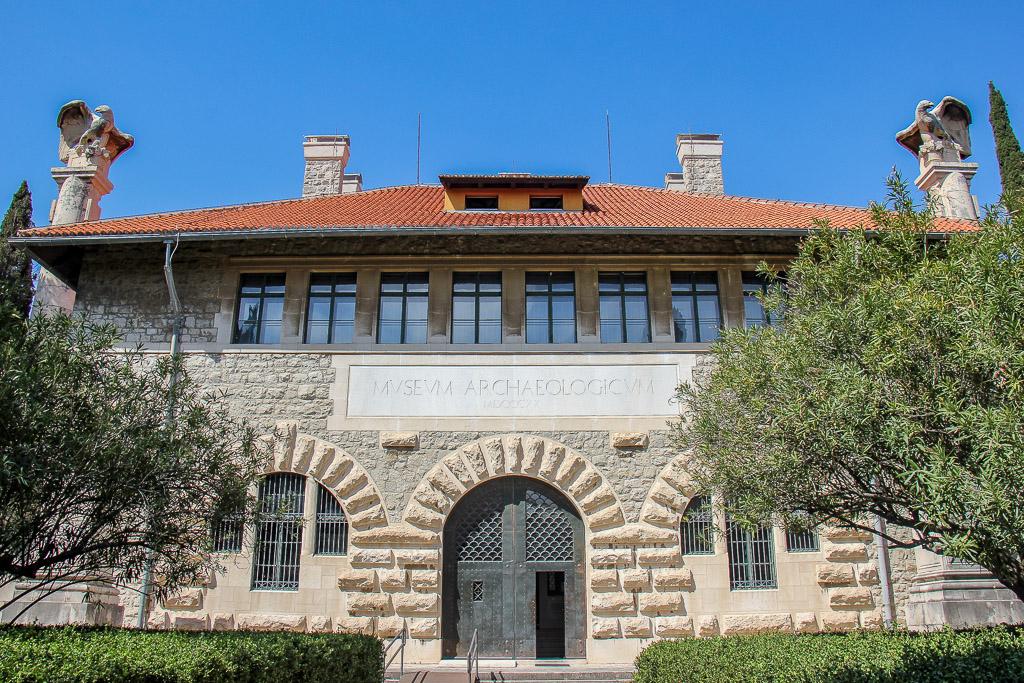
The Archaeological Museum in Split located just a short walk north of the Old Town is an interesting place to see ancient artifacts. The space features special indoor exhibits and a permanent outdoor collection – such as stone engravings, sculptures, sarcophagi and mosaics. The sphinx sculpture near the entrance dates to 1400 BC.
Note : The Split Archaeological Museum should not to be confused with the Museum of Croatian Archaeological Monuments in the Marjan Peninsula neighborhood of Meje.
#22 Learn History at the Split City Museum

Housed in a former residence within the palace, the Split City Museum details the city from its origins until modern times. Situated over multiple floors – starting with information about Diocletian and the building of the palace on the ground floor – the museum offers insight into the lengthy history of Split.
#23 Ponder Paintings at the Emanual Vidovic Gallery
Dedicated to the works of Croatian painter Emanual Vidovic, the gallery features his works of art in a contemporary space. The paintings are presented in chronological order so that visitors can appreciate and understand Vidovic’s evolution as an artist.
#24 Contemplate Works at the Fine Art Museum
Displaying a range of pieces, from ancient times to modern creations, the Split Museum of Fine Art is a highly rated cultural institution. Housed in a former hospital, the museum exhibits a permanent and rotating collection of art.
#25 Catch a Free Ride to the Mall of Split
When it’s raining or just too hot, catching a ride to the Mall of Split is one of the best free things to do. The 4-level mall hosts a variety of shops – from international brand fashion stores to a Croatian craft beer shop. The free Mall of Split bus departs from the east end of the Riva several times daily.
#26 Enjoy a Coffee on the Riva

The coffee culture in Croatia is outstanding – and the busy cafes along the beautiful Riva is just the place to enjoy it. Buzzing cafes also ring People’s Square and are tucked down the narrow lanes of Diocletian’s Palace. When you need a rest from sightseeing in Split, find an open table at one of the outdoor venues and rest your feet while watching the passersby!
#27 Eat at the Best Split Restaurants

Eating in Split covers a range of delectable fare. From street food specialties to epic dining affairs and everything in between.
Burek – a seasoned meat pie that is popular throughout the region – is our favorite thing to eat in Split when we are on the go, and ST Burek is the best place to get it. That said, it’s difficult to resist sitting down at one of the excellent seafood restaurants in Split. If you want to know where to find all the top spots, read our list of Recommended Restaurants in Split .
#28 Drink Local Craft Beer

The craft beer scene in Croatia is booming! Many restaurants, cafes and bars in Split are now serving amazing craft beer from Croatia and around the world. Getting a taste of locally produced brew is one of our favorite things to do in Split.
For more tips, our list of Where To Find Craft Beer in Split will point you in the right direction – or you can join a combo History and Craft Beer Walking Tour .
#29 Partake in a Split Wine Tasting

From north to south, inland to the islands – Croatia has a long history in wine production. One of the fun Split, Croatia things to do is sample the different kinds of wine produced in the country. Dedicated wine bars, like Zinfandel, MoNIKa’s and Bokeria are excellent places to partake in a wine tasting.
#30 Join a Guided Split Walking Tour

Guided walking tours in Split are a great way to learn about the history of Diocletian’s Palace and how the city grew around it. Local guides lead participants to the top Split places to visit. Travelers can book this highly rated tour in advance.
#31 Sample Local Cuisine on a Food Tour

Those who want to sample some of the best eats in Split can join a food tour. The excursion begins at the Green Market, where you will learn about local goods and produce. Next, guests will visit a traditional konoba to feast on an array of regional cuisine. Get the details!
#32 Take a Day Trip from Split to Krka Waterfalls

Krka National Park is one of the top places to visit from Split! One a tour from Split, visitors can see the waterfalls at Krka as well as other nearby destinations, like Sibenik and Skradin . Use our guide for What To See at Krka NP to plan the trip on your own. Or get a local experience on a tour with Adiona Travel .
#33 Travel to Plitvice Lakes

Visiting Plitvice Lakes National Park is one of the iconic things to do in Croatia. Unfortunately, it is quite a long day trip from Split . We prefer Visiting Plitvice Lakes with an overnight stay. However, if you only have time for a day trip to Plitvice Lakes , it’s better than missing it all together! Take a look at this popular tour .
#34 Set Sail on a Blue Cave Tour

In the summertime, the top Split day trips are out to sea! Visitors can set sail on catamaran or speedboat to tour nearby Dalmatian islands. The most popular Split tour aims for the iconic Blue Cave – but visits multiple islands along the way. Find out more about the Blue Cave Trip !
#35 Snorkel in the Blue Lagoon

A day trip from Split to the Blue Lagoon is fun way to spend a hot day away from the city. The tour stops at three locations – and participants can snorkel in the beautifully blue water. Book it!
#36 Go on a Hvar Day Tour

Hvar Island – and specifically Hvar Town – is one of the places near Split that is easily accessible by scheduled fast-ferry or tour boat.
On organized excursions to Hvar , visitors travel by catamaran with a group of fellow tourists to the island. Then there is free time to explore the town before sailing through the Pakleni Islands. Those who make the trip on their own should read our guide to the Best Things To Do in Hvar .
#37 Elevate your View at Klis Fortress

Klis Fortress is a top Split day trip destination! The castle was used as a filming location for Game of Thrones, but it has stood for centuries and has served as a home to royalty. The super view from Klis Castle is another top reason to add it to your list of things to do in Split.
#38 Spend a Day in Omis

Omis is an adventurer’s paradise. Hiking, rafting, canyoning and ziplining are top activities for thrill-seekers. However, those just looking for relaxation will find it on the long stretch of sandy beach. Check out all of our tips for the Top Things To Do in Omis .
#39 Visit Trogir

Taking a day trip from Split to Trogir is easy and fun! The picturesque, UNESCO protected town of Trogir is just 15 miles west of Split. The historic village blankets a small island that is just a stone’s throw from the mainland and accessible via a short bridge. Bus #37 runs frequently from Split to Trogir, making it an affordable adventure as well!
#40 Make the Journey to Dubrovnik

Traveling from Split to Dubrovnik is a long day trip, but it is worth it for those who want to see the Pearl of the Adriatic. Top Dubrovnik attractions are the city walls, historic old town , beautiful beaches and Mount Srd . Use our guide to the Popular Things To Do in Dubrovnik for more info and sightseeing tips – or book a guided tour .
#41 Go on a Day Trip Mostar

Another long day trip – but a fascinating journey across the border into Bosnia-Herzegovina – is a trip from Split to Mostar . The city, which is centered on the famed Mostar Old Bridge, is a meeting point of multiple cultures. This full day tour also includes a stop at Kravica Waterfall!

Split Tourist Map
Use this Google Map for an interactive version of our map of Split below.

Split, Croatia Travel Tips

Now that you know the best things to do in Split, Croatia, we have a few more tips for your trip!
Split Tourist Card
The Split Tourism Office offers a free Split City Card to guests staying for 5 days or longer in the peak season or a minimum of 3 days in the off season. The card is good for 72 hours and allows free or discounted entry into many of the Split museums and other top sights.
Local Split Tourist Agency
Want a tourist agency to help plan your trip to Split? We fully recommend Adiona Travel ! Locally-run, the crew at Adiona can organize tours, accommodations and transfers – all with excellent customer service! Don’t believe us? Check our their TripAdvisor Reviews ! If you use Adiona Travel on your trip, be sure to tell Iva and Emanuel that the JetSettingFools say hi!
Where To Stay in Split, Croatia
When it comes to places to stay in Split, visitors have ample options in a range of prices. We typically like to stay in Airbnb Apartments – as they usually offer more comfort than hotels with the added benefit of a kitchen where we can make simple meals. That said, for shorter stays in Split, a hotel could be a better option.
Top-Rated Hotels in Split, Croatia
We recommend visitors start their search on Booking.com for the best Split hotels – but these hotels get high ratings from fellow travelers.
- Palace Judita Heritage Hotel
- Piazza Heritage Split Hotel
- Heritage Hotel 19
Before booking, read our tips for finding the Best Rates on Hotels !
Getting to Split, Croatia

Split is an excellent transportation hub for a vacation in Croatia; as it can be reached by plane, ferry, train, bus or car.
Flights to Split
Travelers flying to Split will find year-round and seasonal flights from top European hubs (such as London , Munich , Frankfurt and Amsterdam ). Unfortunately, there are no direct flights to Split from the United States.
We recommend using a site like Skyscanner to find deals on airline tickets – but first, read our guide to Finding the Best Cheap Flights .
Travel to Split by Ferry
Travelers can arrive to Split via ferry from other Croatian Destinations or from Ancona, Italy. The two main ferry companies in Split are Jadrolinija and Krilo .
Train to Split, Croatia
There is a train from Zagreb to Split, but it is not the most convenient way to travel in the country. Routes are both infrequent and time-consuming.
Bus to Split
Most cities in Croatia are well-connected by bus. It’s an affordable and fairly easy way to travel to Split. Our preferred bus company is FlixBus – as it is economical, clean and comfortable. However, Bus Croatia can be used to find routes serviced by Croatian bus companies.
Driving to Split
We aren’t keen on driving abroad, but renting a car can often save time and sometimes money. Having a car rental also allows for greater discovery of the region. However, once in the city, a car is not necessary. Almost everything can be reached on foot – and parking in Split is notoriously difficult.
What Else Do I Need to Visit Split, Croatia?

Before you set off sightseeing Split attractions, you will want to make sure you pack a few necessary items . You can find all of our hacks and advice on our Travel Packing page.
Comfortable Shoes
One of the best things to do in Split, Croatia is walk through the UNESCO-listed Palace and Old Town. Although mostly flat (unlike Dubrovnik ), some stones are uneven and slick.
Wearing a pair of good travel shoes will help in navigating your way to the top attractions in Split. I wear my favorite trainers and Kris prefers Merrell shoes.
Travel Camera
If you are anything like us, we are certain you will be snapping pictures of beautiful Split, Croatia! Rather than relying on your phone, we recommend upgrading to an actual camera so that you can truly capture the sights.
We use a Canon Rebel with a versatile lens ( 18-135mm ). This Canon is a great beginner budget camera for travelers because it is easy to use, takes quality photos and comes with loads of accessories!
Sun Protection and Weather Gear
Most of our recommended places to visit in Split are outdoors, which means you will be exposed to the elements. The sun is strong in Croatia – make sure to apply sunscreen before you set off. A wide-brimmed travel hat can also be useful…and don’t forget your sunglasses !
If your trip to Split coincides with foul weather, don’t let a little rain ruin your time. Be ready with a raincoat and travel umbrella .
Of course, you will want to carry a good day bag to stow all of your valuables and other everyday items . We carry these backpacks when exploring – but you read our reviews to help find the Best Day Bag for You .
Croatia Travel Insurance
Trip insurance may be helpful with inconveniences. This includes lost luggage or delayed flights – as well as getting injured or ill while abroad . Learn more about coverage and affordable rates at World Nomads .
Start planning your trip to Croatia ! Search for the lowest airfares , the best accommodations and fun things to do …then start packing ! Want more advice? Head over to our Travel Planning Page for more tips on traveling – and for country-specific information, take a look at our Travel Guides Page !

Pin it! See all of our travel pins on our JetSetting Fools Pinterest Board .

Share This Story!
- Click to share on Pinterest (Opens in new window)
- Click to share on Facebook (Opens in new window)
- Click to share on Twitter (Opens in new window)
- Click to share on LinkedIn (Opens in new window)
3 thoughts on “ 41 Fun Things To Do in Split, Croatia ”
Comments are closed.

IMAGES
VIDEO
COMMENTS
A complete travel guide to Split, Croatia. January 14, 2024 by Frank G. Split, Croatia is the largest town in Dalmatia and the second-largest in Croatia. Split is a coastal city, with a small-town vibe, noisy streets, and easy-going locals. Once a stopover place for tourists catching a ferry to nearby islands, or a bus to other more exciting ...
FCDO travel advice for Croatia. Includes safety and security, insurance, entry requirements and legal differences.
Most are marked with FKK - the German phrase "Frei-Körper-Kultur," meaning free body culture - which isn't surprising as Germans make up some of the biggest numbers of tourists in Croatia. Away from the FKK beaches, topless bathing is quite common. 8. Dodge the crowds in Dubrovnik by timing your visit carefully.
Travel Advisory. August 15, 2024. Croatia - Level 1: Exercise Normal Precautions. Reissued after periodic review without changes. Exercise normal precautions in Croatia. Read the country information page for additional information on travel to Croatia. If you decide to travel to Croatia: Enroll in the Smart Traveler Enrollment Program (STEP) to ...
Split Travel Guide. Last Updated: August 8, 2024. Everyone who visits Croatia seems to gravitate to Split. This stunning UNESCO World Heritage Site is a major launching pad for boat tours off the coast and a ferry hub for island-hopping. It's also home to the gigantic Diocletian's Palace.
Check out tours on Viator here and book ferries with Jadrolinija, the official ferry company here. 6. The best times to visit Split are in June and September. July and August are very hot but often bring crowds of tourists and higher prices. April and May are also good, however expect lower temperatures.
Croatia follows Schengen area rules. Your passport must: have a 'date of issue' less than 10 years before the date you arrive - if you renewed your passport before 1 October 2018, it may ...
3. Climb the Bell Tower of Split Cathedral. For unbeatable city views, head to the beautiful Split Cathedral and climb to the top of the Romanesque bell tower. Standing at a grand height of 187 feet, it's a bit of a walk to the top — up 200+ steep steps (quite scary if you're afraid of heights).
1. Split in Croatia: Overview of Info & Initial Travel Tips What can I expect on holiday in Split? Taking a wander through Split is like travelling back in time. You can feel the eventful, century old history of the city on every corner. The inner city of Split is a labyrinth of alleyways that is second to none. Getting lost in it (and getting ...
Krka falls is one of 8 picturesque National Parks in Croatia and the closest to Split. It's made up of clear turquoise waterfalls, lakes with boat excursions and easy walking paths. You can also combine Krka with a visit to Sibenik. A historic stone walled coastal city and take part in traditional Croatian wine tasting.
Split in Croatia: The Only Travel Guide You'll Need. Updated: Dec 6, 2022. Split is located in western Croatia along the Dalmatian coast. As Croatia's second largest city, it's always buzzing with life and has been for thousands of years. Split was put on the map by the emperor Diocletian, who had his palace built here between 295 and 305.
If you're planning a trip to Croatia's Dalmatian Coast, we've rounded up all the best things to do in Split, including where to eat and where to stay. Plus some helpful tips for traveling to this Croatian coastal hotspot. Quick Note: As of January 1, 2023, Croatia joined the Eurozone and adopted the Euro as their currency.
7 top day trips from Split to see more of Croatia. Apr 26, 2022 • 10 min read. Split is one of Croatia's most charming cities, and there's more to see beyond the city limits. Try these day trips to castles, medieval towns and islands. History. 5 city walking tours you can take right now on Google Maps.
It's best to contact the owner, Ivan at +385 (0)97 7762 407 to inquire about tastings and tours. 19. Tour Diocletian's Cellars. The underground of the Diocletian's Palace is open for public tours, and it's one of the top attractions in Split, especially on hot summer days.
For me, this is easily one of the best things to do in Split! Enjoying views from Split's Bell Tower. Incredible views from Split's Bell Tower. Split's Bell Tower. Top tips: You'll need to pay in cash to climb the bell tower in Split, but it's a total bargain at 20 kn (approx. £2.40) a ticket!
3.2 Relax at Kasjuni Beach. 3.3 Go for a sunset SUP tour. 4 Split itinerary Day 3: Day trip to Omis. 4.1 Explore Omis Old Town. 4.2 Discover the Cetina Canyon. 4.2.1 Go zip-lining. 4.2.2 Or go rafting. 5 Split itinerary day 4: Day trip to Krka. 6 Split itinerary day 5: Day trip to Hvar.
Plan your visit to Split, Croatia: find out where to go and what to do in Split with Rough Guides. Read about itineraries, activities, places to stay and travel essentials and get inspiration from the blog in the best guide to Split ... In-depth, easy-to-use travel guides filled with expert advice. Find even more inspiration for Croatia here ...
Bureau of Diplomatic Security (Croatia Crime and Safety Report) Global Peace Index ranked Croatia as the 27th safest country in the world in their 2019 report, out of 163 countries. United States and UK ranked our country to the lowest level of travel concerns, meaning travelers should only use regular caution.
Split is the second largest city in Croatia after the capital Zagreb and one of the most fascinating cities found along Croatia's Dalmatian Coast. I spent a week with my son Tyrone exploring Split during our three-week incredible road trip around the Dalmatian Coast. We found many exciting things to do in Split Croatia, making our trip memorable. Best Things to Do in Split Croatia in One ...
Compiled from my first-hand Split solo travel, this ultimate Guide to Split Croatia Solo Travel has all things Split travel tips with bonus budget travel tips, eco-travel tips, and more throughout. This is your one-stop-shop to plan an unforgettable solo Croatian vacation in Split. Whether a single day trip or a full-on solo adventure, Split ...
The bus trip takes around 30 minutes. One-way ticket costs 30 Kuna and a daily ticket costs 40 Kuna. Tickets can be purchased on the bus. Transfer to the apartment in Split costs 150,00 HRK for 2 people. The Airport shuttle bus will take you to Split main bus station in 30 minutes.
Split, Croatia Travel Tips. Now that you know the best things to do in Split, Croatia, we have a few more tips for your trip! Split Tourist Card. The Split Tourism Office offers a free Split City Card to guests staying for 5 days or longer in the peak season or a minimum of 3 days in the off season. The card is good for 72 hours and allows free ...
Croatia. With thousands of miles of seafront and more than a thousand islands, Croatia's coastline is the Riviera of Slavic Europe. Holiday makers love its pebbly beaches, balmy summer weather, and dramatic mountains. But there's history here as well: From ruined Roman arenas and Byzantine mosaics to Venetian bell towers, Habsburg villas, and ...